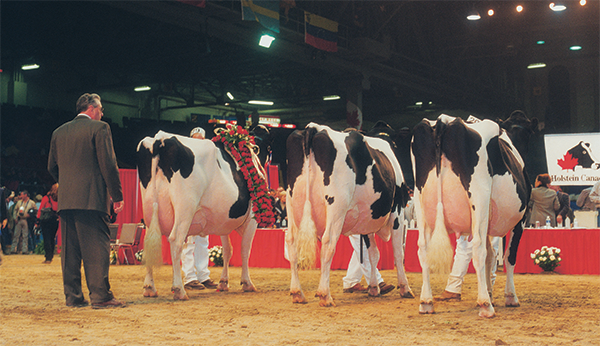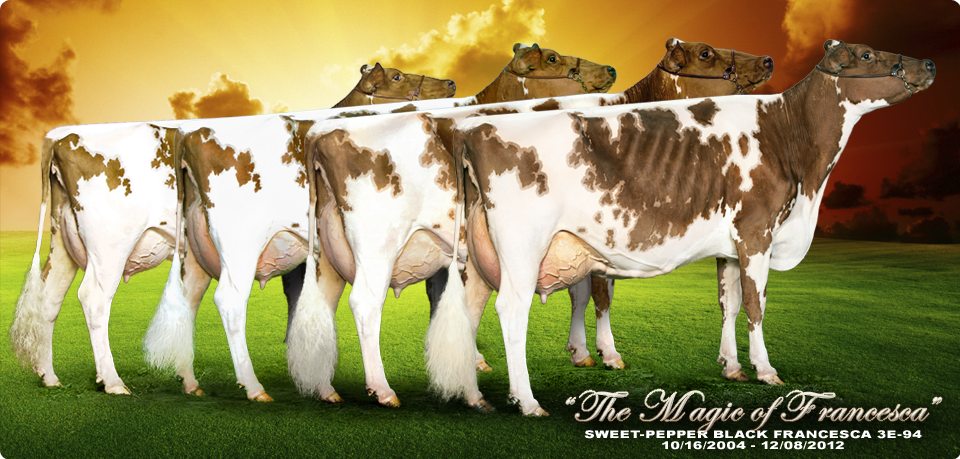The Bullvine sat down with Donny Donnan of Donnanview Holsteins to discuss his journey in developing this amazing herd that will be offered for sale next week. Donny and his wife Bev have spent their lifetime breeding great dairy cattle. Opportunities to invest in herds like Donnanview are few and far between. Not only a Master Breeder Herd, home of the 2014 Canadian Cow of the year, sires in AI, but they are also 90% VG and EX cows. These achievements have been built over years of intuitive, selective breeding choices. Not since the likes of Hanoverhill’s complete dispersal have we seen a herd of this size and quality, sell all at once in a public auction. Join us in watching this video as Donny explains how they have achieved this success and who has helped them along the way.
Archive for Breeder Profiles – Page 3
In a rare opportunity the Bullvine sits down with Mario Comtois of Gen-Com Holsteins to discuss their success, their team, and the two great cows they work with RF GOLDWYN HAILEY and CHARWILL ATTIC MARCY.
Watch this video and find out, what makes Hailey and Marcy so special and the members of the team that do just a great job keeping these and all the cows at Gen-Com looking so great.
Get original “Bullvine” content sent straight to your email inbox for free.
The McDonald family recently invested in a new housing facility for an additional 330 cows at Kelloe Mains Farm, near Berwick-upon-Tweed. Bruce Jobson reports from the Scottish Borders.
The McDonald family milk 720 Holstein cows at Kelloe Mains Farm, Duns, Scotland, 10 miles west of Berwick-upon-Tweed. The farmland totals 2,500 acres (1,000ha) stretching over a distance of 10 miles and incorporates two farms.
Robert McDonald and his son, also named Robert, are the driving force behind the family farming business with 27-year old Robert, managing the day to day management of the dairy herd. His father continues his role at the forefront of the business and also manages the arable side of the enterprise.
Kelloe Mains has undergone a continued expansion programme and recently added a new 330 high-spec free-stall housing facility, which was completed in January 2014. The housing unit cost approximately £2,500 per cow ($c4300) (£825,000 in total: $c 1,450,000) and includes automatic scrapers and rubber matting as well as incorporating “green bedding.”
The building is high, with lots of light and ventilation and cow comfort has been a strong feature of the design according to Robert Jnr. “Animal health and welfare is a priority at Kelloe Mains and we continue to focus on management and cow comfort.
“We are currently milking over 700 cows and place strong emphasis on best management practise from the day a calf is born, through to milking. We have incorporated the Alta Advantage Programme into our management structure and this provides essential data and benchmarking of the business,” he said.
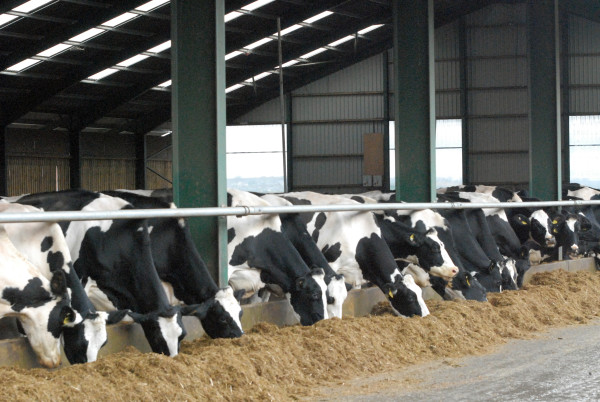
An new housing unit for an additional 330 cows cost approximately £2,500 per cow ($c4300) (£825,000 in total: $c 1,450,000)
Imports from Holland
The McDonalds increased their herd numbers in 2014 by purchasing 138 in-milk heifers and 140 in-calf heifers from Holland. The imported animals have now settled into their new environment and Robert is pleased with their performance.
Robert said. “The herd has been averaging around 10,500 – 10,700 litres at 3.8% fat and 3.3% protein, however, with the additional influx, the herd currently containing 65% heifers, and this year, we expect the yield average will be lower.
“It takes time for new animals to adjust but overall, we are pleased with the performance of the herd. We use the Alta Advantage programme as part of our overall herd management system in order to benchmark our performance data. The herd is running at 23% pregnancy rate with 45% of the cows currently pregnant at 75 days.
“Calving interval, which is based on the milking cows, rather than the latest influx, is around the 377 days with days open at 99 days. The herd is averaging 24 months at age of first-calving and in due course, we are aiming to reduce the figure to 23 months. The cows are milked through a 40-point Alfa-Laval rotary parlour on a three times per-day milking routine, averaging 34litres per day with a through-put of 125 cows-per-hour.”
The herd is fed a TMR ration using a Keenan mixer-wagon, with a separate ration to the in-calf heifers and dry cows. The milking herd ration contains 20kg of DM of forage; 2kg of whole crop; 6.5kgs grass silage, 0.5kg straw and a protein blend. The herd receives its first feed at 5.30am and is supplemented at around 10am.
Dry cows receive a close-up and far-off ration and bedding is kept clean and dry due to the availability of straw. The new 340 cow free-stall facility and older unit for 368 cows, link into a 1.9million gallon slurry tower and 2.8million lagoon incorporating an umbilical system.
Kelloe Mains Open Day
Alta Genetics recently hosted an open day at Kelloe Mains, and the event included presentations from several Alta staff as well as Robert McDonald Jnr. Over 200 visitors attended the event including 60 farmers from Holland and 16 from Italy.
Farmers seeking to breed the next generation of profitable, animal welfare friendly cattle were treated to a demonstration line-up of milking Holstein heifers using the Alta Advantage programme. Visitors could inspect the animals and were provided with milk recording details and yield projections.
Alta programme manager Drew Wilson used hand held technology to assess the type characteristics of an animal and the programme provides a list of suitable matings; based upon the type and production criteria for each individual herd requirement. The line-up of animals on display demonstrated the success of the Alta Advantage Programme Mr Wilson stated.
Mutual Benefits
Paul De Goojier, global marketing manager for Alta Genetics, led a group of 60 plus farmers from The Netherlands, as part of a UK tour and emphasised an open business philosophy. He explained: “Farmers are looking for ways to improve and learn from each other. The openday will bring value to UK farmers, the Dutch as well as Italian group, who have also attended the event.
“Everyone can discuss their needs on a full strategy basis and breeders are able to apply the genetic tools in order to select the right bulls. We have a focus on the progressive farmer in order to help with the direction of their business goals. Our programmes add value and help bring better results, breed better animals and increase genetic results,” he concluded.
Calf Rearing Trial
Calf rearing is an essential part of the Kelloe Mains philosophy based upon management and animal health and welfare aspects. New born calves are given four litres of colostrum within the first few hours of birth, followed by an additional two litres, two hours after the initial feed. After the first week, the calves receive 5 litres per day increasing to 6 litres per day after the 10th day.
Robert Jnr commented that milking cow performance starts with good heifer rearing practise. He said: “Calves can be easily overlooked but good milking herd performance and animal health and welfare issues start with quality calf management.
“We aim to wean calves at 60 days and by that time, they are receiving adlib feeding, taking onboard approximately 3kgs of 18% protein pellet and straw. Pellet feed and fresh water is introduced early in order to increase growth rates. We aim for heifers to calve-down at 24 months of age and we manage their inputs accordingly in order to achieve the required weight and growth-rates, prior to insemination.”
The farm operates a strict system with one person feeding the calves 12 out of every 14 days in order to maintain consistency of feeding, hygiene, observation and overall management. The calves are fed on waste milk, which is pasteurised on-farm after each milking, and calves are fed at 8 hourly intervals.
Kelloe Mains has traditionally reared calves in crates and the McDonald family recently purchased calf hutches as an alternative method. Calves are currently undergoing a trial to see if there are any benefits by switching to 100% rearing in calf hutches. Both sets of heifers are being weighed at 60 days, and the early results indicate a 10 – 11kg increase in weight using a calf-hutch.
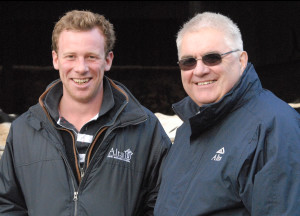
Robert McDonald (left) and Alta Genetics’ Regional Manager Billy Campbell
Kelloe Mains is now using 100% genomic sires across the board according to Alta Genetics Regional Manager Billy Campbell, who has worked closely with the McDonalds for the past 25 years. “Kelloe Mains operates on a commercial-basis and animals are mated to provide profitable, long-lasting, healthy and animal welfare friendly cattle.
“The first group of genomic heifers demonstrated the reliability of the programme and the latest group of 18 heifers by 10 young genomic bulls is averaging 34 litres per day and are currently 118 days in-milk. The group is predicted to yield over 11,500kgs with two heifers projected to produce over 14,000kgs.”
All the cows are bred to Holstein bulls and in the past; sexed-semen has been used to help increase replacement heifer numbers. According to Mr Campbell, the Kelloe Mains herd demonstrates the benefits of using a large number of genomic young sires across the herd and by using a professional evaluator, has achieved positive results on type, production, herd health and animal welfare.
This article first appear in the December 2014-February 2015 Edition of Crazy Cow in Print. Click here to check out there Facebook group and watch for their new website soon.
Legendary Holstein breeder Roy Ormiston celebrates his 100th Birthday in a few weeks hence. Bruce Jobson and Roy recount the legacy of Roybrook in an exclusive interview. In this unique conversation, Bruce included some additional datelines for reader clarity and understanding.

Roy Ormiston, of Robrook fame, will celebrate his 100th Birthday in February. Photo Patty Jones
There are very few cattle breeders held in the same esteem as Roy Ormiston. He is one of an elite group globally known by a single name; “Roy” (Roybrook) “Wally” (Linskoog: Arlinda) “Pete” (Heffering: Hanoverhill) and in the UK “Moff” (John Moffitt: Hunday) As time has marched forward; only Roy remains with us from what is considered the halcyon era of cattle breeding.
The story really began 70 years ago; when Roy, a young Holstein breeder, joined the Canadian Holstein Association as an Ontario fieldman in 1944; where he worked for seven years as extension officer, including some classifying duties. He had already started farming at 21, taking over his father’s farm (Ormsdale) at Brooklin, Ontario and owning five cows. He later farmed with his brother before establishing his own Roybrook prefix.
BJ “Roy, you purchased a cow bred by Ben Brown, of Bowmanville, Ontario; Balsam Brae Pluto Sovereign Ex. This animal became universally known as “the white cow. How did you find her?
Roy: “I heard about this “white cow” and decided to visit Ben and first saw her as a Very Good five-year-old in 1956. I really liked the look of this cow, despite her being dry; and her age. Ben had turned down $700 that morning from a US dealer; I made an offer of $700, but she had not been on “test” recording and we did not known what her butterfat percent would be – so I offered another $50 bonus – provided she tested at 3.6% or higher.
“The offer was accepted and after she calved-out, Sovereign, known as “the white cow” was judged winner of the All Aged Cow Class at the Royal Winter Fair in Toronto and also Best Uddered Cow. She had come from nowhere to win the most prestigious of shows. Albert Seiling of Seiling Holsteins offered $10,000 – a large sum of money at the time – but I refused to sell.”
BJ “There are many people who consider you as the greatest exponent of “line-breeding” owing to the success of the Roybrook bloodlines. Some consider line-breeding; when it does not work is, “inbreeding.” You are the man – what is your take on the subject?”
Roy: “It was line-breeding – not inbreeding. We never inbred. But I owned a remarkable cow family and wanted to capitalise on these immense qualities. It’s a case of wanting to increase or intensify the best traits or qualities such as size and strength. Inbreeding can result in lack of size and strength and vigour. The white cow was strong, more than the average cow – she was dominant and “controlled” the matings.
“Two of her daughters were Roybrook Model Lady and Royal Delight, and both scored Excellent. The latter cow produced the most famous daughter; Roybrook Model Lass Ex, she was bred from Roybrook Ace, a son of the white cow, from a mating to Lakefield Fond Hope.
“We therefore had the white cow as the bull dam on the top side, and the third dam on the bottom line. The resulting bull calf was Telstar, (born December 1963) Telstar was sold at the National Holstein Sale in the following May to the Telstar Syndicate for $25,000. A few weeks later, having sold the bull, I bought into the syndicate.”
BJ “The bull was named after the world’s first satellite, Telstar; which was launched on July 10th, 1962; the date is recognised as the day that “information went global.” Roybrook Telstar arguably did the same in the bovine world; as the first global Holstein superstar?”
Roy “He certainly had an impact in Canada and Japan. Cattle photographer, Jim Rose, suggested the name. The syndicate sold Telstar to Japan in June 1967; his Canadian progeny were outstanding and all the talk was about Telstar. His daughters were show winners, became brood cows and outstanding bullmothers. Due to widespread AI, and export of progeny, his proofs and influence became global.
“Telstar was designated as a Class Extra sire (in 1971, Canada’s highest accolade on the basis of simultaneous improvements in type and production) In Japan, he was equally admired and in 1978, I was privileged to unveil a bronze statue of Telstar at the All-Hokkaido Show; at the opening of the Dairy Shrine.”
BJ “OK, Telstar paved the way for another bull that arguably had an even greater global impact; Roybrook Starlite. As you stated, the bull was line-bred and only carried 0.93 inbreeding levels. Roy, what was the thinking on that mating?”
Roy “Seiling Rockman was known as the “Genetic Giant” and his daughters had prolific milk production. Starlite was a mating that truly encompassed the best traits of his sire and his dam. For many years the Canadian production Honour List was dominated by Rockman, his son, Starlite and Starlite’s maternal brother, Telstar. Therefore, Rockman was a very powerful mating.
BJ “I will just mention; the University of Guelph Top Transmitter List contained the top 600 cows throughout Canada. When Starlite died (in 1981) 376 cows ranked on this list were from Ontario – and 103 were Starlite daughters; almost 30% of the top cows in Ontario were related to Starlite.
“Starlite semen was exported all over the world. In 1982, three Starlite daughters at Mowry Farms, Pennsylvania, were rated in the top three positions in the USDA Cow Index. At that time, the chances of one daughter being the No.1 cow USDA milk and butterfat producer were rated above 8 million: 1. In fact, Starlite had the top three USDA cows – all bred in one herd.
“The bull came to prominence in the UK when 25 Starlite heifers were imported into the UK by the late Harold Nicholson, herd manager for Sam Noble, owner of the Deehaven Herd in Cheshire. The Starlite daughters were an outstanding success. His global influence was immense as well as, through his sons. Roy, I now want to move on to the next era and will you explain the mating of the third Roybrook superstar; Tempo?”
Roy “I judged the Ontario Show and first two-year-old was Briarwood Melissa. She was an immense Telstar daughter; almost twice the size of others, she had such power and strength. After the show, I went to the barn and asked if she was for sale and they wanted $25,000. I said I wanted to buy the cow; not the farm.
“She was subsequently shown and won at Toronto; and I purchased her at The Sale of The Stars for $14,000. The next day, I went to the bank to borrow the money. Melissa was bred to Starlite; therefore “the white cow” influence was close-up on both sides of pedigree. Tempo had a type proof with the qualities of both bulls.”
BJ “Roy, I will interject, Tempo was born in 1973 and like Telstar and Starlite, he was awarded Class Extra Sire status. Tempo had over 15,000 Canadian scored daughters (29,000 in total) and averaged 70% Good Plus and Better on classification. His sire, Starlite had over 8,000 scored daughters (13,000) that averaged 55%.
“His maternal-sire, Telstar, had 611 Canadian daughters (863) that averaged 86% Good Plus. Tempo came out with an identical average of 70% Good Plus and Better; the exact “mean average” figure between the proofs of both Starlite and Telstar. Tempo – bred “true.” The legacy was a remarkable achievement, all line-bred from a single cow family, housed in a traditional 30 stall Canadian barn. So, which of the three bulls is your favourite?”
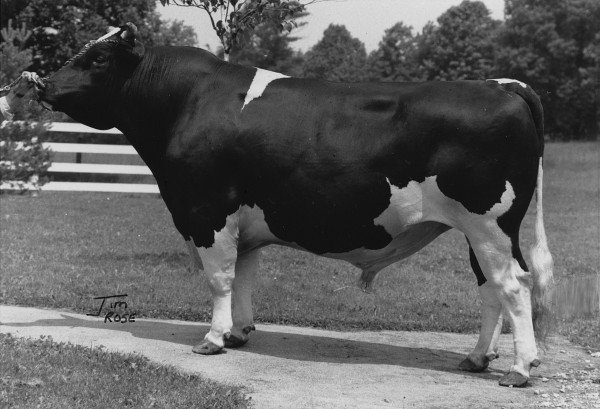
Roybrook Telster
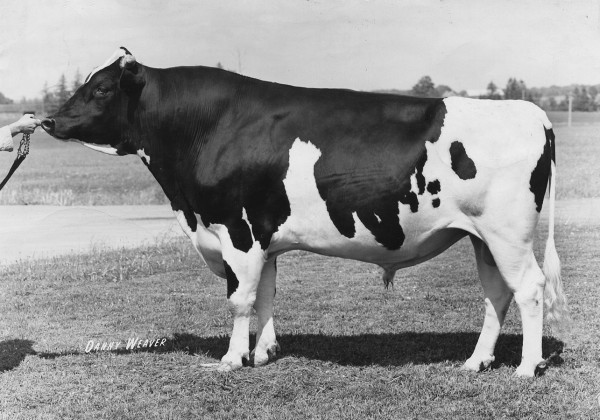
Roybrook Starlite
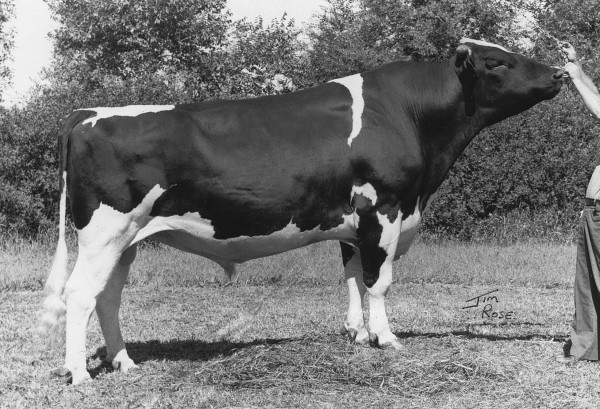
Roy brook Tempo
Roy “I do not have a favourite. All three bulls achieved Class Extra status and all three were different and each bull transmitted different things. Starlite daughters transmitted higher levels of production and were slower to mature as two-year olds – and therefore did not classify as high.
BJ “Roy, 40 years ago you said “Life is too short to start with poor stock.” You are now approaching 100 years old, what advice would you give to someone starting out today?”
Roy “That is still true. Start with the best you can afford. But it is extremely hard for any young person to get involved in farming today. It is even harder in Canada owing to having to buy milk quota, the farm and cows. Everything is bigger and unless your parents are involved or are extremely wealthy, it is almost impossible to get started in dairying.
“Today, many farms have 200, 400 cows or more. That takes a lot of funding with Canadian milk quota at around $25,000 per cow. We kicked the trend even back in the 70s and 80s, we were a small 30-odd cow dairy and the farm was 100 acres; yet I sold cattle to every continent on the globe.
“Things were rapidly changing in the late 80s, with bigger commercial herds and several high profile pedigree breeder herds; (Comstar, Dupasquier, Gillette) these were exciting times; great days, and I remember sitting next to your wife, Helen, at the 1987 Hanoverhill Sale. I sold the Roybrook herd in 1990 – I was getting on in years although, I had a few cows around the farm for another 12 months.
BJ “With all the indices, sexed semen, ET and genomic information available, is it easier to be a breeder in 2014, than in 1944?”
Roy “Bruce, there is more information available today – and maybe there is too much information. It was easier in the past; and breeding goals have changed. We now have genomics and this has changed the bull breeding game and the industry. I have concerns about the level of inbreeding and the possibility of losing, size, capacity, vigour and strength.
“We are also asking two-year-old heifers to produce 120lbs of milk or 50litres per day; and I wonder how long these young cows will last? I still believe in the value of cow families, longevity and a common-sense approach to cattle breeding. Today, everything is faster; everything is bigger.”
BJ “Roy, besides your influence within the global cattle breeding industry, you have, and will continue to have, a strong influence within the local community. How did that happen?”
Roy “Well, I believe in putting back into the local community and since the sale, have done that. I sold land for development and have made donations to local charities. Brooklin has now expanded over the farm and the barn has made way for a new highway. The streets are named in our honour such as Roybrook Avenue, Telstar Avenue, Tempo and Delight.
“I still live on my own, in a bungalow built on the farm – and keep myself busy and active. I have donated 25 acres of land and $2million in order to build a new hospital. It’s something I want to do for the local community; one that I was brought up amongst, and where I have lived my whole life. That will be a true and lasting, Roybrook legacy.”
This article first appear in the December 2014-February 2015 Edition of Crazy Cow in Print. Click here to check out there Facebook group and watch for their new website soon.
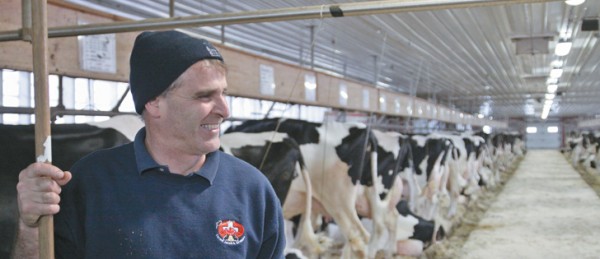
Thierry Jaton’s family looked for the cheapest land possible to buy when they moved from Switzerland to Quebec 34 years ago.
What they found was a dairy farm with an old barn, fields full of stones, old machinery, no artificial insemination or dairy testing program and a barn full of grade cows.
They bought it.
“It was a way to have something,” Jaton said during a tour of his award winning Holstein farm organized by the Canadian Forage and Grasslands Association.
“The only way to have something is to work hard, and we work hard,” he said.
The owners included Jaton’s wife, parents and aunt and uncle. His parents are retired, but his uncle, 66, is still milking cows every day.
The hallway into the barn sports rows of awards, certificates, banners and photographs of the farm’s purebred Holstein herd.
“We love the cows.”
The Jatons milk 110 of their 290 cows. Of those, 17 are rated excellent, 74 very good and 34 good plus. The classification system is based on the animals’ physical conformation compared to breed ideals. The classification program helps producers make breeding and marketing decisions.
Jaton juggles good milking and breed characteristics in his cow herd with cows that do well on the show circuit. Cattle are shown at local and provincial fairs, and a strong contender will travel to the Royal Agricultural Winter Fair in Toronto to show off the Holstein herd.
“We like a show-type cow,” he said.
The cows’ tails are washed and trimmed weekly to help reduce man-ure buildup and keep them ready for show or the continual stream of buyers and visitors to the farm. They are washed and clipped once a month.
Jaton always has a curry comb on hand for brushing and scratching the cows.
“We like to keep them clean.”
The cows are tied in a long line of tie stalls. It takes slightly less than two hours to milk the cows twice a day using eight milking units at a time. The workers kneel beside each cow to hook up the machines to the cows and then plug the hoses into a pipeline beside the cows’ heads.
The family does the milking with the help of one employee, but without a massive investment to upgrade equipment, they don’t know what will happen in the future.
“I don’t know what will be the next step, but at the moment everyone is healthy.”
The cows are fed one-third corn silage and two-thirds alfalfa.
The hay is fed in the morning, and a machine dumps the rest of the feed in front of the cows four times a day. The machine can adjust the amount of ration each cow receives.
Heifer and cow sales are key to the farm’s profitability. Jaton will sell 40 to 55 cows to other dairy producers this year, mainly in Quebec.
“We have too many heifers,” he said.
Most of the heifers are sold just after their first or second calf.
Good cows sell for about $3,000 with top-end cows fetching $10,000 to $15,000 each.
Jaton tries to avoid selling embryos because of the quickly changing trends in embryo selection. He flushes embryos from his top performing cows and implants them in the bottom 40 percent of his cow herd.
He is increasingly using genomics as a tool but doesn’t rely only on the genetic selection of traits for breeding or picking his cattle.
“It’s a good tool. For the moment, if you want to be in the market you have to use genomics,” he said.
Producing good quality hay is important for the farm, which uses hay as a large portion of its dairy ration. The 1,000-acre farm grows wheat, corn and soybeans, plus corn for silage.
Excess hay is sold into the lucrative U.S. horse market.
Source: The Western Producer
There isn’t anything much better than being recognized by your peers for being outstanding in your chosen field. Just this past June at the Holstein Association USA’s Annual Convention, Greg Andersen was awarded the 2014 Distinguished Young Holstein Breeder Award. Greg, manager and one of the owners of Seagull Bay Dairy, American Falls, Idaho, would be the first to acknowledge the tremendous support he receives from his family as he carries on the family tradition of breeding outstanding Holsteins. (For more on Seagull Bay Dairy and the Andersen Family read Charting the Right Course at Seagull Bay Dairy AMMON-PEACHEY SHAUNA – 2012 Golden Dam Finalist and JOHN ANDERSEN – COMMERCIAL and PEDIGREE – Building a Field of Dreams) The Bullvine decided to dig deeper and find out more about how Greg sees breeding Holsteins in the future. We are confident that you will find Greg’s thoughts interesting.
A Strong Base – Holstein and Family
Seagull Bay Dairy, established in 1980 by Greg’s parents Alan and Norma, has a reputation for using genetics and management to grow their herd and breeding stock sales. Seagull Bay (Read more Charting the Right Course at Seagull Bay Dairy) has been awarded both Progressive Breeders Registry and Progressive Genetic Herd awards on numerous occasions. College educated, Brigham Young in Animal Science and Business, Greg became the manager at Seagull Bay in 2006 and has moved the herd ahead rapidly to the point that only very highly rate bulls are used and breed leading heifers are the focus for producing embryos for sale and the herd’s next generations.
The first family for Greg is his wife Gwen and their five children Lydia, Wyatt, Amy, Dallin and Corbin all showing great interest in their education, community (church, 4H and service groups), farm and Holsteins. Greg has three brothers involved in the dairy industry. Ben operates the 1600 cow commercial milking herd which includes both crossbreeding and females used as ET recipients. John manages Double A Dairy and with his family, owns Triple Crown Genetics (Read more: JOHN ANDERSEN – COMMERCIAL and PEDIGREE – Building a Field of Dreams). And Brandon, manager for the Double A Dairy calf ranch, also breeds Holsteins under the Andercrest prefix. No doubt when Alan and Norma’s family hold a celebration, discussion on how to return the most profit from dairying could be lively.
“Efficient production from a healthy herd” is the Seagull Bay Slogan
Greg expands upon the above slogan as follows “I believe that cows with moderate stature but adequate width and strength and the ability to produce high total pounds of protein will be desirable and profitable for dairy businesses throughout the world for many generations. Calving ability, udder quality and fertility will, of course, also be imperative. The modern Holstein, as well as the cow of the future, will need to be able to produce large quantities of milk solids while still maintaining healthy body condition.” Seagull Bay, like many many other herds, sells their milk for cheese processing and so their farm gate price is very dependent upon the pounds of protein shipped. As a result, PTA’s for protein is important for the males and females they include in their breeding program.
Seagull Bay’s slogan and emphasis on fitness traits comes from experience. Popular A.I. plus proven sires used 10+ years ago left them very disappointed. Greg describes is as follows – “Those kind of sires perpetuated a long list of health and utility issues that have taken several generations to begin to correct.” Greg expands on Seagull Bay’s success on breeding for fitness and utility – “through breeding and selection we now have a core group of elite Holsteins that possess the traits that we highly value.” The July 2014 herd production average at Seagull Bay and Andersen Dairy was 85 pounds of 3.9% fat and 3.2% protein milk. That is 6 pounds of fat + protein per cow per day. The goal is to do that every day of the year. For Bullvine articles on breeders that share Greg’s approach read about North Florida Holsteins (Read more: NORTH FLORIDA HOLSTEINS. Aggressive, Progressive and Profitable!!) and Rosy-Lane Holsteins (Read more: ROSY-LANE HOLSTEINS – “Don’t Follow the Herd!”)
Seagull Bay Works to High Genomic Standards
Simply stated the history of Seagull Bay has been to purchase high genetic females and develop families around them. Two cows that come quickly to mind are Lynmead Celsius Minnow and Ammon-Peachy Shauna. Both families have produced outstanding daughters and sons. Combining both these families resulted in the popular and highly ranked sire, Seagull Bay Supersire.

Shauna in the front pasture at Seagullbay this past spring. 5 years old. Due again this winter.
Over the past six months Greg has used seventeen sires, all genomic rated, in his ET program. Three are Seagull Bay bred – Supersire, Silver and Secretariat. Six are Mogul and five of his sons. One is the breed leading gTPI polled sire, Powerball-P, and the remainder are leading sons of other high genomic sires. The averages for these seventeen sires are very high and are sure to help keep Seagull Bay as a prominent name in Holsteins. Note the very high CM$ average. Seagull-Bay Silver tops the group with 2621 gTPI and 3.28 PTAT. Uecker Supersire Jospuer is highest for fat + protein at 211 pounds. And MR Mogul Delta 1427 is highest for CM$ at 1115.
Table 1 – Recent Seagull Bay Service Sires
| gTPI | NM$ | CM$ | PTAF | PTAP | PTAT | |
| Averages (17x) | 2490 | 895 | 967 | 90 | 70 | 2.57 |
At the present time, all the Seagull Bay donors are heifers. Their impressive averages are listed below. The leading lady of this group EDG Hallie Uno Heather with CM$ 935, 7.2 PL, 2.64 SCS and 2.4 DPR. Two of the eight are from the Shauna Family, and one is from Pine-Tree Dorcy Alexa II. So donors used in the past continue to contribute to the current Seagull Bay breeding program. Three of the current eight donors are sired by Uno, two by Supersire, two by Jacey and one by Mogul.
Table 2 – Seagull Bay’s Current Donors (all heifers)
| NM$ | CM$ | PL | SCS | DPR | |
| Average (8x) | 815 | 884 | 5.7 | 2.65 | 1.6 |
Tall Cows Not a Requirement
Greg sums up his sire selection as follows. “I mostly select high NM$ and gTPI sires. However, sires that have similar gTPI and NM$ values can, of course, get to those values in very different ways. In general, I choose sires over 60 pounds PTAP, above 0 for DPR and below 8 SCE. I will often not use a sire that is over 2.5 STA with preference given to sires less than 2.0 STA. The McCutchen sons are often high for STA, so I haven’t used them as mating sires with the exception of using Kingboy one time on one donor.”
Helpful Tools
Like all progressive breeders, Greg is always searching for new information. He shares useful advice: “Accelgen.com is the most user-friendly site available to look up sire information from my experience. The new Enlight program from Holstein USA and Zoetis could also be a helpful tool for analyzing genetic trends in our herd in the future.”
Leading to the Future
It is clear to see why Greg was selected as the 2014 Distinguished Young Holstein Breeder when he provides thoughts such as the ones that follow.
“We hope to continue to be a supplier of good bulls into the AI market for many years to some. We’d like to sell or lease at least 30 young bulls to various AI companies annually. We have four young bulls right now in our hutches with NM$ values between 900 and 1148. Long term I hope that there are many Seagull Bay sires with very good and highly reliable proofs with thousands of daughters throughout the world. I hope that at least one Seagull Bay sire will reach the Millionaire milestone.”
Greg expands on the future. “Genomic and IVF technologies will continue to help accelerate the genetic advancement of dairy breeds. It is true that many of the genomic values are over-estimated, however by-and-large we have seen that genomic predictions are pretty good at identifying which heifers ought to be donors and which heifers ought to be bred AI or used as a recipient. The same is true for males. The high number of males and females tested each month with gTPIs over 2500 does not surprise me nor does it bother me.”
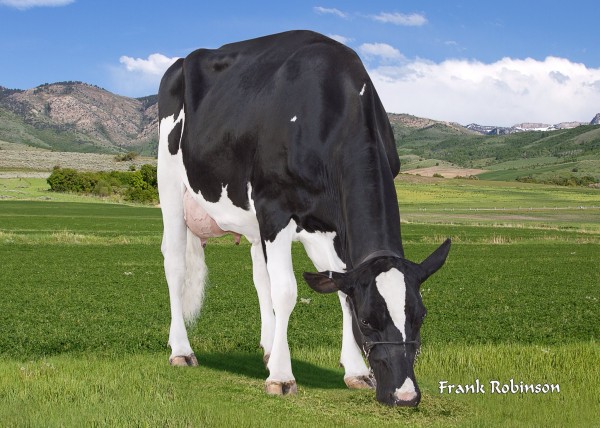
Seagull-bay Shauna Saturn VG-85 VG MS
At Seagull-Bay, Greg sees great promise for two heifers. “Soon to enter our donor group will be Seagull-Bay Somthngroyal-ET. For me, she is the most exciting heifer we’ve ever had on our farm. Somthngroyal is a Jacey x VG86 Seagull-Bay Shauna Saturn x Shauna with 926 NM$, 1060 CM$, 75 PTAP, 96 PTAF, 2.62 SCS, 2.0 DPR, 5.0 PL, 6.9CE and 2.22 PTAT. Noteworthy as well is a polled Ohare-P daughter from a VG86 Observer x VG Shottle x EX Seagull-Bay Manat Mirage (Granddam of Robust) with gTPI 2306 and 63 PTAP.’
In talking about the future, Greg is a big picture thinker. He provides the following global perspective. “We live in a growing world and we will continue to need to produce more animal protein from a resource base that will grow at a slower pace than the growing demand. There will likely be 9 billion people on this planet by the year 2050. Genetics, biotechnology, animal nutrition, etc. must continue to advance in a way that improves both the quality of our products and the efficiency in which they are produced.”
The Bullvine Bottom Line
Greg Andersen takes a global approach to breeding and all aspects of dairying and how they will impact feeding our world’s growing population. Without a doubt, it can be said that Greg is a man on a mission to make this a better dairy world. The Bullvine considers Greg to be the type of leader our industry needs.
Get original “Bullvine” content sent straight to your email inbox for free.
One of our favorite Bullvine things to do is to compare the incredible success stories of people in the dairy industry. From show ring legends to dairy breeding icons, we are inspired by their tenacity, hard work and passion. When we meet dairy breeders who have managed to excel in breeding for both type and production, it is especially inspiring. Such is the story of Bob and Denise Behnke and Bur-Wall Holsteins of Brooklyn, Wisconsin.
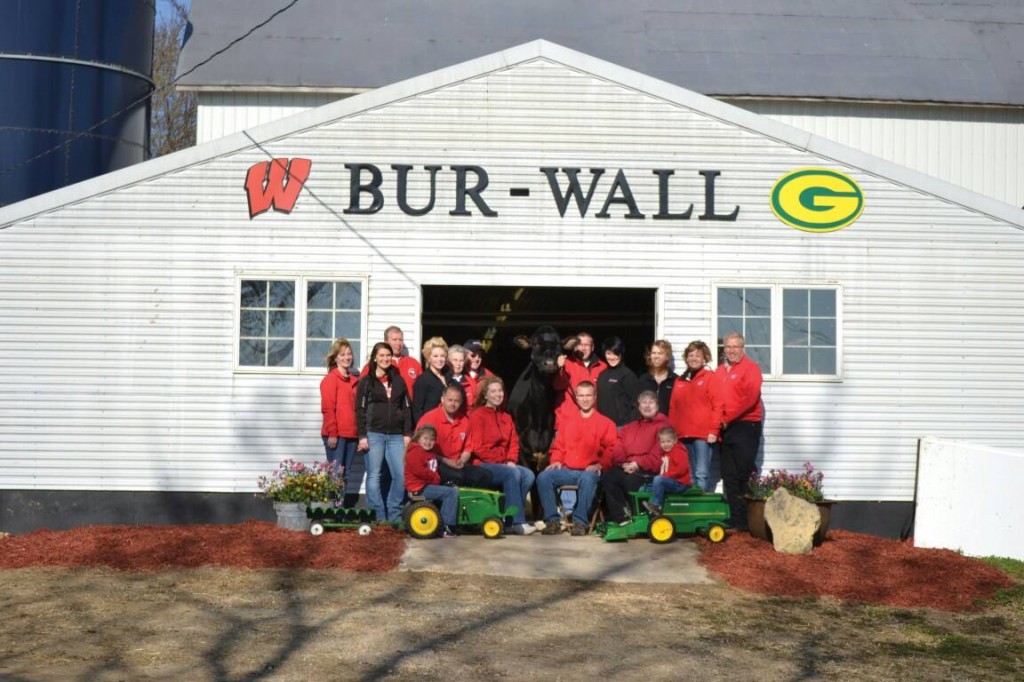
The members of Bur-Wall Holsteins pose with Bur-Wall Buckeye Gigi who was named the 2013 Star of the Breed. The crew is pictured (back row, from left) Lisa Behnke, Taylor Behnke, Roger Behnke, Morgan Behnke, Donna Behnke, Bob Behnke, Denise Behnke, Tori Evert, Tami Behnke, Brian Behnke; (front row, from left) Rebecca Murphy, Al Murphy, Brenda Murphy, Sterling Evert, Keri Evert, Carter Murphy.
PHOTO BY RACHEL POMEROY
“We Were Inspired After Entering the Show Ring.”
Bob, the youngest of five children of Donna and Wally Behnke looks back on the beginnings of their Holstein story. “My grandparents had grade Holsteins, but when my oldest brother was old enough to start showing cattle at the local fair, my dad purchased our first registered Holsteins.” That was a defining moment for the Behnke’s “From that point forward, all of us had a tremendous interest in growing our herd.”
“We Focus Primarily on Proven Performance”
Today Bob and his wife Denise have done the practical hard work and careful management that has built Bur-Wall Holsteins’ success. “We milk 60 head of registered Holsteins in a tie-stall barn and also raise 70 head of young stock. We crop 265 acres of corn, soybeans and alfalfa.” This modest summary doesn’t yet highlight the dairy operation achievements that this dairy has benchmarked. Bob points out the philosophy that has been their foundation. “We focus on making sound, productive cows from good cow families. We show and classify, so type is certainly important to us, but it’s more important that our cows be balanced with good front end strength, deep rib, a wide rump, good feet and legs and strong udder attachments. Cows like this will last for many years. We also have learned that good cows from good pedigrees will always have interest in the marketplace, so while we do contract and breed to some high-ranking genomic sires, we focus primarily on proven sires with proven performance.” And performance has been outstanding for this hard working committed family.
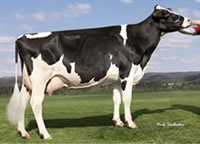
ROSE-LYN DURHAM CAMILLE
“Camille is the Definition of What We Are Looking For.”
The Behnke’s, like many passionate dairy breeders, have worked with many favorites, but they point with pride to Rose-Lyn Durham Camille, EX-93 3E. “Camille just fit what we were looking for: she classified VG-88 as a 2 year old, grew into a hard-working cow with all records over 30,000 lbs. of milk, and was a cow that would undoubtedly catch visitors’ eyes with her wide front end, walk-uphill frame and wide rear udder.” That beauty would set her apart alright, but Bob then explains what made her truly outstanding. “Perhaps the best thing about Camille was her ability to transmit. She has Excellent daughters from Shottle, Goldwyn and Jasper, and numerous high-VG daughters from Shottle, Goldwyn, and Stormatic.” Again rising above the crowd but then, even the daughters excel. “Virtually all her daughters have posted records over 30,000 lbs., with some over 40,000, and we are excited to see this type and production being passed along to her granddaughters.”
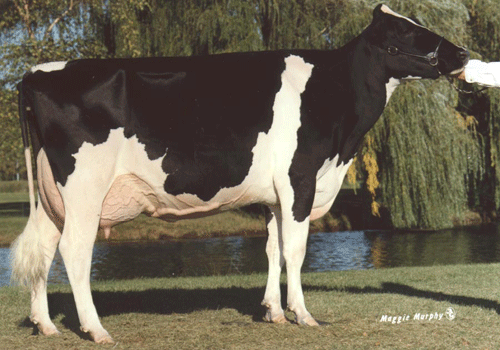
WILCOXVIEW BC CAMI EX-93 DOM 9*
All-American Sr. 3Yr Old 1999
1St Sr 3Yr Old Madison 1999
Next Dams: EX-94 2E DOM GMD, VG-88 DOM GMD, VG 87 DOM GMD, VG-86, VG-88, VG-87
Choosing Camille’s Sire was Key for Behnke
“Camille’s dam was an EX-93 2E Rudolph from Wilcoxview BC Cami that was a very powerful cow in her own right, but needed a little more youthfulness of udder. With the Rudolph’s overall strength and width, we felt Durham would be a great mating.”
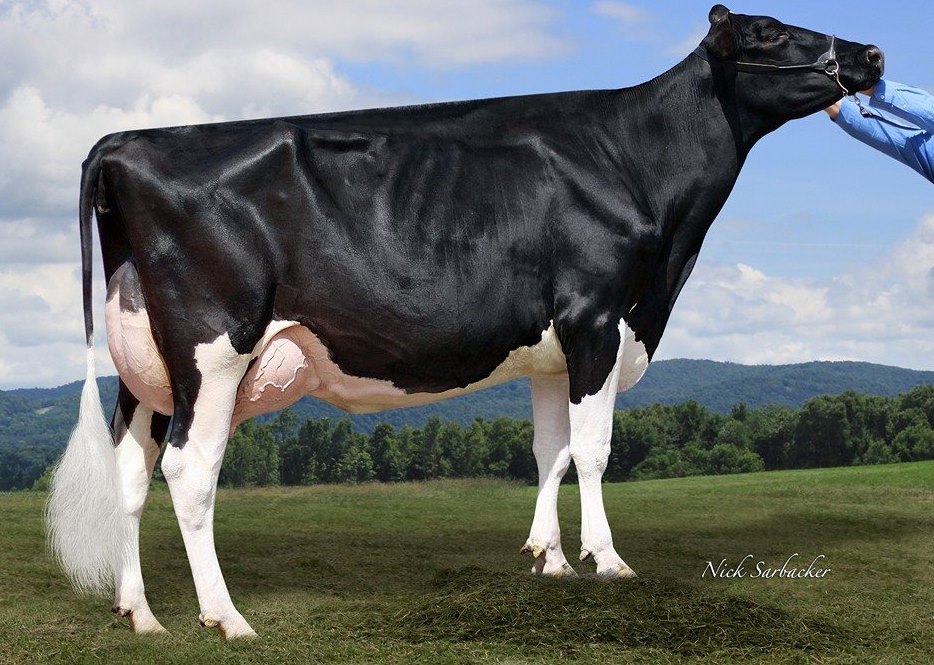
Rose-Lyn Jasper Corvette EX-90 (2nd calf)
Jasper x EX-93 2E Durham x EX-93 2E Rudolph EX-93 Wilcoxview BC Cami x EX-94 2E Roylane Mark Carmen
Bur-Wall is Always Preparing for the Spotlight
When your plans come to fruition, it can be great in many ways. Bob talks about how the future is shaping up. “Rose-Lyn Jasper Corvette EX-90 is the Jasper daughter of Durham Camille and is showing as a 4-year-old this year. Corvette was Res. Senior and Res. Grand Champion of the Junior Show at this year’s Midwest National Spring Show. She is a silky black cow with a great leg, fantastic udder quality and a high, wide rear udder. She classified 90 points (2nd calf) just 10 days fresh and is looking to exceed 40,000 lbs. of milk this lactation.” Wow! Seems appropriate here. And then Bob summarizes in understated fashion. “So we are really excited to see what else is in store for this young cow.”
Corvette will have plenty of help in carrying Camille’s legacy. “Two full sisters by Pellerat Moon from an EX-93 2E Shottle from Durham Camille are due to calve early this fall for the first time and are looking exceedingly promising. These heifers are a result of a contract mating, and both are incredibly balanced and stylish.”
In much the same way that they have excelled at bringing show ring beauty and milk house parlor production together in their own breeding, the Behnke’s seek it out when purchasing cattle as well. “Another young cow we are particularly excited about is a Jr. 2-Year-Old Braxton from a VG Marconi out of an Excellent Goldwyn we purchased from the Hagen family of Milton, WI several years ago. She’s a bit immature to hit the shavings this year, but the Braxton has tremendous promise, and we plan to breed her back right away to hopefully bring out for next year.”
Finding the Right Bulls for Beauty and Production
“Sires we are using are Armani, Gold Chip, Brokaw, Chipper-P (on our red and red carrier cows) and Shottle. As I mentioned earlier, we focus are making balanced cows with good type, and these bulls have all the potential to get us the kind of cows we are looking for. We have also seen numerous calves from each of these sires at local and state shows and they have been particularly impressive. We are continuing to use Shottle, although he is an “aging” bull because, with the amount of Durham and Goldwyn in our herd, he makes for an excellent cross.”
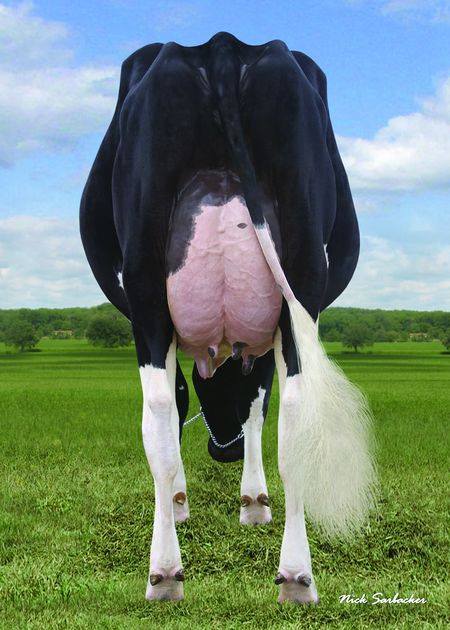
Bur-Wall Buckeye Gigi EX-94 2E
2013 Star of the Breed
Star of the Breed Award Spotlights Bur-Wall Holsteins
Receiving the 2013 Star of the Breed Award has been a pretty neat experience. “It came completely out of the blue, and we were absolutely surprised and honored. We knew Gigi was a special cow, since she has had a successful show campaign over the last few years, but we never anticipated how special she would become!”
Continuing to Raise the Bur-Wall Profile
“My father, Wallace, has been by far my biggest influencer. He always demanded the very best from us, something which has helped shape our farm and our family. His passion for the Holstein cow and his extensive involvement in the industry has also been instilled in myself and the rest of my siblings, and we plan to pass on this passion to the next generation.
“Just this year, we started a farm Facebook page to provide instant updates on the day to day activities, show happenings, classifications, etc. It’s also an excellent way to connect with other breeders and to create awareness of what we have on the farm.” Bob and Denise are happy to see that awareness paying off and they are continuing to grow. “With the success of our cows at Spring Show and the Wisconsin State Show and having been honored to receive the Star of the Breed Award for Bur-Wall Buckeye Gigi EX-94 2E, we will be doing a bit more advertising at the national and international level to promote our genetics.”
Always Moving Ahead
The Behnkes are looking forward to seeing how dairy farming will change with the use of more and more technology whether it’s on the breeding side of things or in terms of equipment, software, etc.
The use of genomics has probably been the biggest change I’ve seen in my lifetime” reports Bob. “Its great information to have on both male and female animals, and it’s exciting to see how breeding animals will evolve as we learn more about genomics. I think we will certainly see more and more from genomics to the point where genomics may be able to approach the reliability of daughter-proven information. That would give us, the breeders, a way to better our herds at a faster interval.” As he specifically looks at genomics and Bur-Wall, he says “It has affected us to the extent that I now know more about the bulls I am using in my herd. I also may be a little more apt to use a “young sire” if he has genomic information available. However, my personal opinion is that the “gold standard” is still daughter-proven sires. Genomics are a great tool, and that tool needs to be used wisely.”
The Bur-Wall Action Plan
So often we admire the successful examples we see in the dairy business, but overlook that one thing that they do so well. They take action. All kinds from the biggest to the smallest. But they are always in motion. Bob says it best. ““Know what you want and go for it, whether it’s in the show ring, in merchandising, in the milk cooler or all of the above. And never be afraid to ask for advice or help…that’s often the best way to build connections in the dairy industry, connections that will help you succeed as your business grows.” Following in and enlarging the footsteps of the family they have learned from and enjoy working with, Bob and Denise are an exceptional team. They will undoubtedly leave clear signposts not only for their own young family but for others who are passionate about dairying.
The Bullvine Bottom Line
Bur-Wall Holsteins demonstrates the exceptional management, breeding, selection and understanding of the hard work and detail that is required to achieve goals. This is what sets them apart among those unique dairy operations that target and achieve both type and production. We wish Bob and Denise well as they continue to pursue their passion at Bur-Wall Holsteins.
Get original “Bullvine” content sent straight to your email inbox for free.
Matt Zabel says, “Genomics has had a huge impact on our breeding program at Zahbulls Holsteins” He acknowledges that he may have had a more open mind than some who experienced the dramatic impact of this new tool. “With my commercial herd background, genomics may have been easier for me to adjust to.” Matt farms with his wife, Emily, and his parents, Tim and Tammie in Plainview, Minnesota. He sums up his viewpoint, “Genomics has changed the industry tremendously!” Dairy people worldwide would agree with that assessment, as many AI organizations now report well over half their semen sales are from genomic bulls.
![ry400[1]](https://www.thebullvine.com/wp-content/uploads/2014/09/ry4001.jpg)
Matt and Emily Zabel with their children, Ruby and Heston.
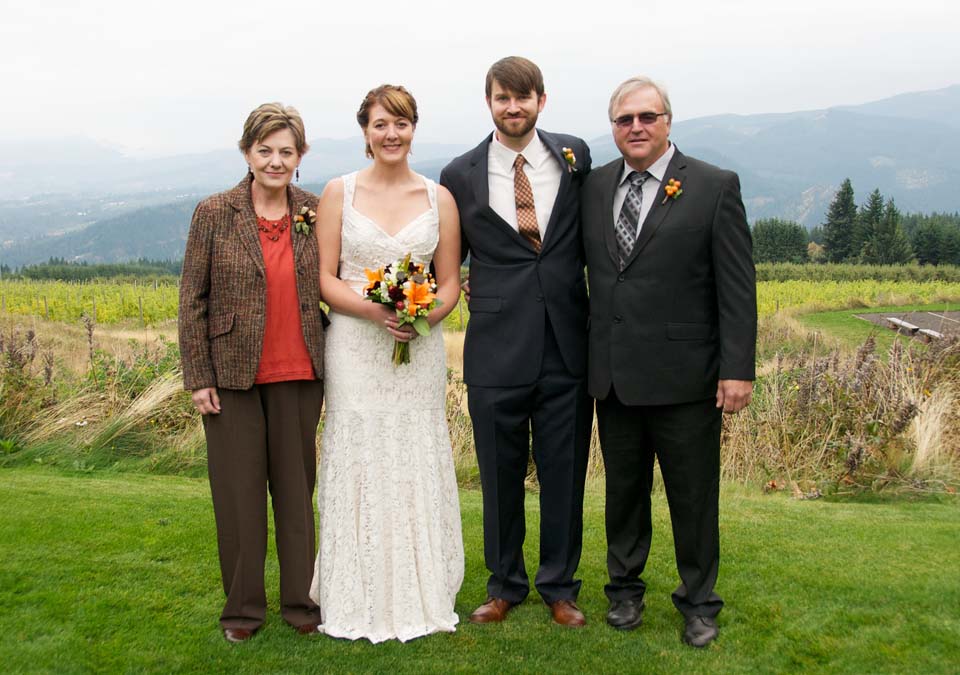
Megan Zabel Holmes, Dan Holmes, and Tim Zabel
The Genomics Debate is Ongoing but Zahbull Holsteins are About Growing
After attending UW-Madison Farm and Industry Short Course, Matt became interested in Registered Holsteins. He describes where the family farm is today. “We milk 195 cows 3 times a day in a double 5 parabone parlor. The cows are housed in sand bedded freestalls. We have 180 youngstock and farm 530 acres of corn and alfalfa.” Tim is the crop manager, while Matt manages the dairy operation. Emily is responsible for calves, social media and website.
Zabel has a “Get Real” Breeding Philosophy
You never find a successful farmer who doesn’t have a clearly defined breeding philosophy. For Matt Zabel that means “Practical, breeding for medium sized cows, functional type with the will to milk.” He has a very clear goal in mind. “I strive for real cows competing in real environments.”
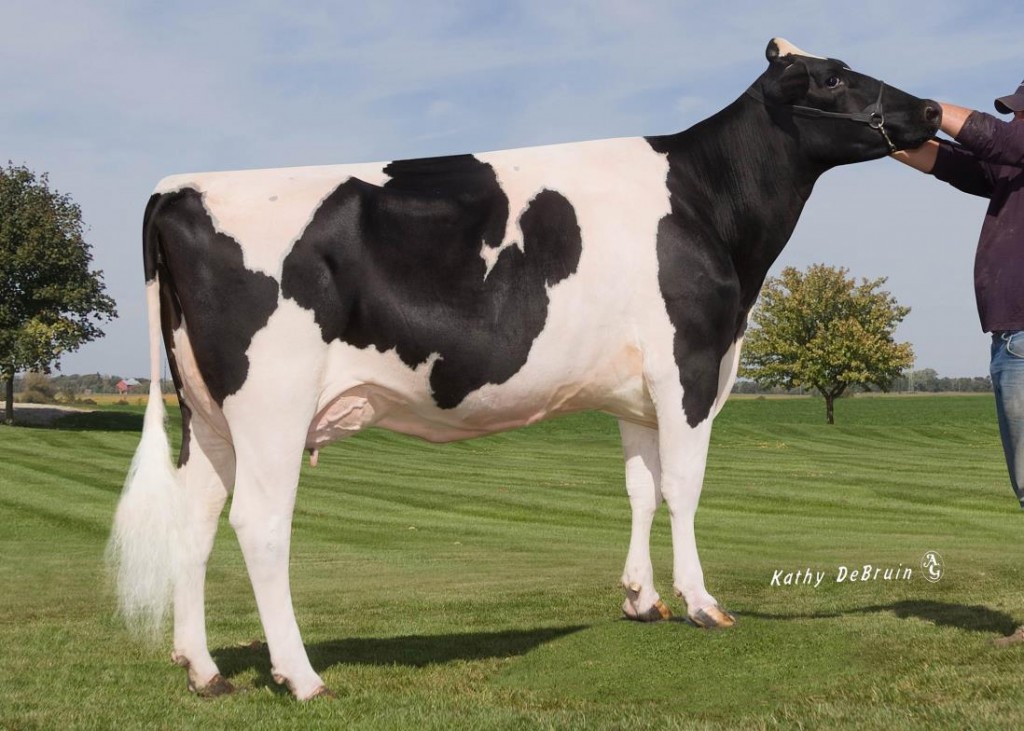
Zahbulls Dorcy Glamour GP-83
Dam of Zahbulls Alta 1st Class GTPI 2611
Dam of Zahbulls Halogen Giant GTPI 2574
Daughters:
Zahbulls SS Genova-ET GTPI 2322
Zahbulls SS Gentry-ET GTPI 2230
Zahbulls Lexor Glad-ET GTPI 2301
All that Glitters is Genomics
When it comes to breeding success, Matt enthusiastically relates the story of his favorite achievement – Johnan Toystory Glitter. “I always had an interest in her dam Johcar Rudolph Ginger. At the time, Toystory was a mating sire that I was using and had interest in. Genomics were gaining popularity and I heard a few members of her family were genomically testing well. We tested Glitter and she went up over 300 TPI points. Her offspring went on to produce some of the highest genomically tested bulls in the world, including Alta 1st Class.”
![ho000053457311[1]](https://www.thebullvine.com/wp-content/uploads/2014/09/ho0000534573111-1024x731.jpg)
Johnan Toystory Glitter EX-90
2-04 2 305 23400 95 4.1 956 3.0 711 95
4-00 2 305 29220 95 3.5 1025 3.0 887 95
2nd dam of Alta1stClass
In a (1st) Class By Himself
Alta 1st Class (Uno x Dorcy x Toystory) not only has a rather unique name but he excels in many important categories. He debuted at #3 gTPI (2597) genomic sire of August 2013’ with high values for Udder Composite, pTAT, PL, SCS, DPR, and CM$ and now stands at +2598 gTPI. Seldom do breeders see a bull that has at or near +5.00 for udder attachments and udder depth.
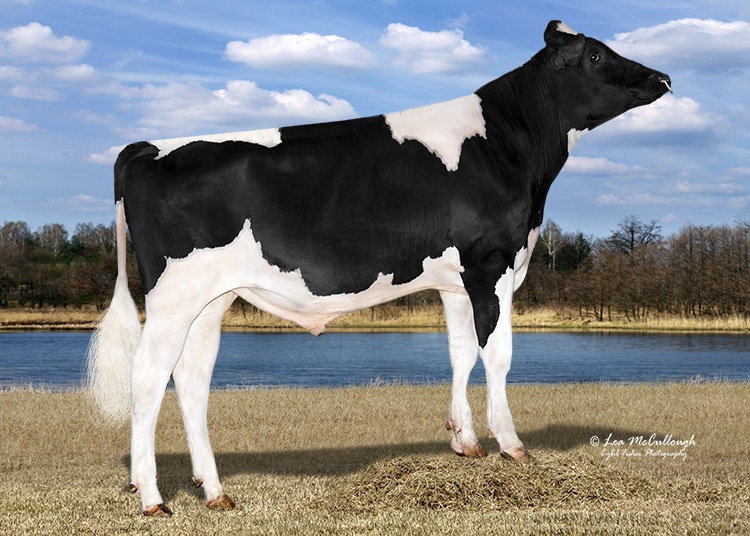
Zahbulls Alta1stCLASS-ET
Numero Uno x Dorcy BY x Toystory
And the Zahbull List Goes On
Building on their success, the bulls bred by Zahbull Holsteins continues to grow:
- Zahbulls Flame Gogebic (gTPI +2625, Vieuxsaule Flame x Zahbulls Ss Genova x Zahbulls Dorcy Glamour-ET GP-83)
- Zahbulls Halogen Giant (gTPI +2570, Cookiecutter Petron Halogen x Zahbulls Dorcy Glamour-ET GP-83)
- Zahbulls Greenway Gump (gTPI +2484, De-Su Mgl Greenway 11396-ET x Zahbulls Ss Genova x Zahbulls Dorcy Glamour-ET GP-83)
- Zahbulls Mccutchen Gil-ET (gTPI +2419, De-Su Bkm Mccutchen 1174 x Zahbulls Dorcy Glamour-ET GP-83)
- Zahbulls Racer Gibson (gTPI +2415, Clear-Echo Lexor Racer-ET x Zahbulls Dorcy Glamour-ET GP-83)
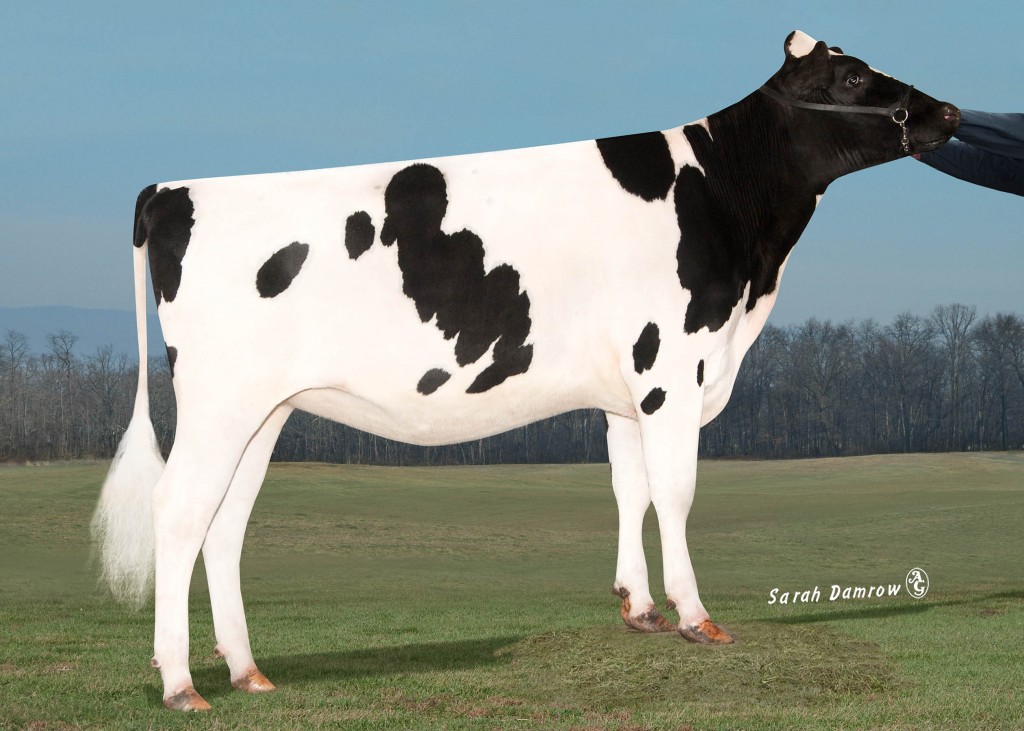
Zahbulls SS Genova-ET
Dam of #1 bull in the world! Zahbulls Flame Gogebic GTPI 2654
Zahbulls Holsteins Welcomes Variety
Matt keeps the options open when developing his breeding lines. His current list includes:
Zahbulls Uno Emily, Zahbulls O-Style Chilli, No-Fla Paradise 33729, Zahbulls Lexor Glad, Zahbulls SuperSire Genova and Zahbulls Ransom Edina. He explains the reasoning behind these choices. “I’ve been working with these because they all have something different to bring to the table.” On the bull side Matt names nine of his sire picks: “Alta 1st Class, Yoder, Pure, Delta, Mega Sire, JoSuper, Tango, Mr. Mud and Impression”. The unifying ingredient to all these animals is that they have high gTPI indexes even though they are from a number of different bloodlines, each with unique breed topping indexes.
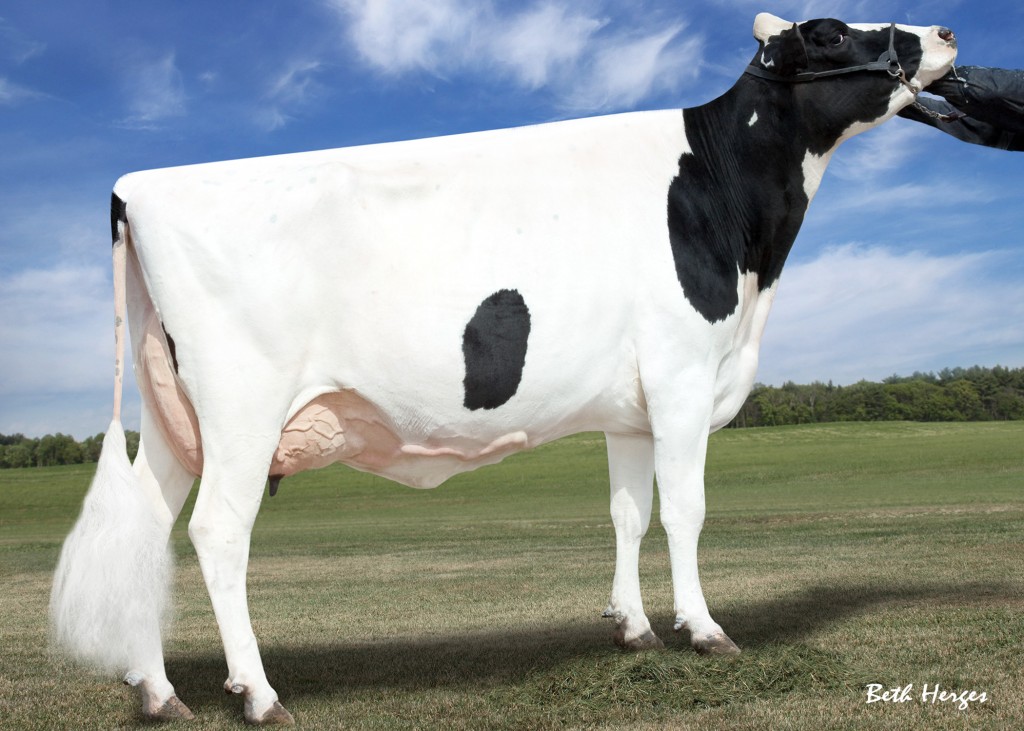
Sapa Ska Toystory Courtney EX 92
Dam of Zahbulls O-Style Chili +2222 GTPI
and A Iota son Zahbulls Iota Cashew
Keeping Up With Zahbulls Means All the Right Moves
It isn’t enough to have the right strategy, the right genetics and the right records. Matt knows it doesn’t work unless the message gets out. To maintain a steady flow of information, Zabels have a multi-point strategy here too. “We keep potential buyers and other people interested in our genetics and up-to-date on what we’re doing by using our website, zahbulls.com , social media , advertising , participating in various consignment sales and taking part in interviews.”
“Never let genetics take a back seat”
Matt is proud of the mentorship provided by his father. “I admire my Dad because he never let genetics take a back seat.” Matt reiterates that family breeding philosophy over and over. “Dad bestowed in me the importance of always using quality genetics in a commercial herd.” Ultimately that shared vision contributed to changes at Zahbulls Holsteins. “He supported me 100% in my interest for pursuing registered Holsteins.” Zahbulls Holsteins has excelled in operating a commercial herd and have also achieved outstanding results in breeding registered Holsteins. This means a lot to Matt. “Breeding Alta 1st Class has been my greatest accomplishment so far. I am so proud that my research, dedication and hard work produced one of the highest genomic bulls in the world.”

Johcar Rudolph Ginger-ET EX-94 3E GMD DOM
3rd dam of Alta1stClass
A Positive Outlook on the Future
Matt is proud of the family farming tradition that goes back to his great grandfather Reuben and is enjoyed by his family today. He has a positive attitude. “I see that there will be constant new technologies introduced that will make it possible to be efficient and keep your margins from thinning.” For those just starting out to build success in the registered Holstein business, he urges them to be proactive. “Accept that you will make mistakes. Don’t be afraid. If you have a question ask it. Call people you know that have done well. Make sure that you do your research before buying into a cow family.” That’s sound advice from Matt who looks forward to whatever challenges may arise in the dairy breeding industry and has confidence that they will be met and overcome.
The Bullvine Bottom Line
Congratulations to Matt Zabel and Zahbulls Holsteins for achieving a distinctive place among their dairy breeding peers! They are setting the bar high with dairy breeding that covers the full spectrum from ‘Commercial Excellence to Genomic Giants!’
Get original “Bullvine” content sent straight to your email inbox for free.
We all know the old saying, “East is east and West is west and never the twain shall meet”. The dairy business has traditionally seen irreconcilable differences in the areas of commercial dairy vs. registered dairy; corporate farms vs. family farms; genomics vs. proven; corporate owners vs. family ownership; employee goals vs. owner strategies. Of course, it’s the exceptions to the rule that show us how to push the envelope and create new successes in an industry that is under constant pressure to be profitable and sustainable. John Andersen brings many of these disparities together in his passion for dairying and in doing so is building a playing field most dairy breeders can only dream of.
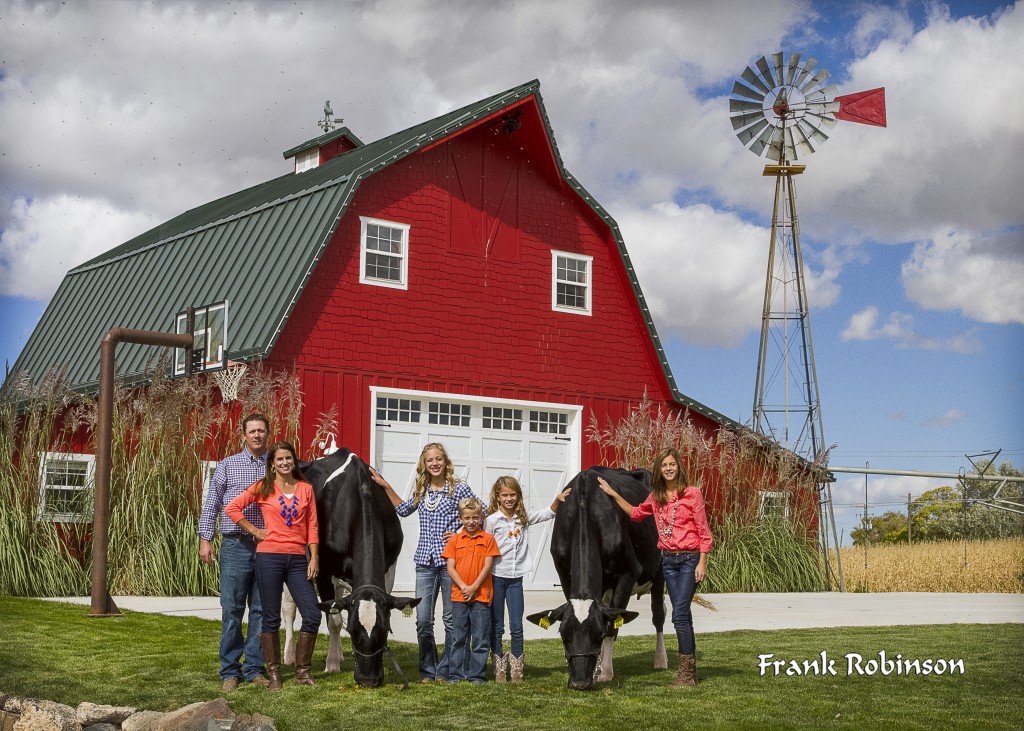
John & Caroline Andersen Family
Taking Care of Business
Some might see it as trying to keep too many balls in the air at once or a tricky balancing act but for John it is neither. He sees running a thriving commercial herd and breeding elite genetics as two sides of the same dairy business coin. As Manager at Double A Dairy in Jerome, Idaho he is more than comfortable with a two pronged approach. “I do believe that it is possible to have the best of both worlds and this is what we are trying to accomplish.” John feels the key to success for both visions is still built on the same firm foundation. “Have a passion for whatever it is that you choose to do. Do something that you look forward to getting up in the morning and going to work.”

Double A Dairy
Genomics Is the Game Changer
The Double A Dairy in Jerome Idaho is owned by the Aardema family, and John Andersen is the manager. The 13000 cow Double A Dairy is recognized as one of the largest users of genomic tests on a commercial scale “Genomics has changed the game and whether you like it or not, I believe it is here to stay and will continue to become more reliable.” says John Andersen who, with his team runs genomic tests to sort out high and lower end genetics. “It is not the end all say all, but it is an important tool that gives us additional information to make decisions in our day to day business.”
Lifelong Learning and Earning In the Dairy Industry
Although the ready acceptance of genomics as a tool for a commercial dairy may seem somewhat unexpected, it’s not out of line with John’s dairy background. “I grew up on Seagull Bay Dairy (500 cows), our family dairy operation located in American Falls, Idaho. I went to college at BYU (Brigham Young University) in Provo where I got my degree in Ag Business and a minor in Business. While at college, I worked as a herdsman at the University’s 600 cow dairy where I helped manage the breeding and Embryo Transfer program. We worked with a good number of high index cows and sold a fair number of bulls to stud from the University herd. After my Junior year of college, I spent a full summer in the central valley of California working as an intern with Monsanto. It gave me the opportunity to spend time on a number of different large dairies. After graduation, I returned home to manage Seagull Bay beginning in January of 2000.” It was an enjoyable way to develop a career and John was evidently gathering invaluable experience. (Read more: Charting the Right Course at Seagull Bay Dairy)
DOUBLE A DAIRY. Specialized and Organized
John explains how things changed in 2005. “After spending five years at Seagull Bay, I took the opportunity to work with the Aardema Group in Jerome, Idaho. We milk a total of 26,000 cows on six different facilities. More than half of the cows are milked at Double A dairy (14,000 Holsteins) and the remainder of the dairies milk Jerseys. 70% of the cows at Double A are housed in freestall barns while the other 30% are housed in open lots with shades. Double A has four Double 50 parallel milk parlors. We also have a centralized calving facility dedicated to caring for dry and close-up cows and heifers. All heifer calves are kept and raised at our calf ranch up to six months of age and then sent to our heifer feed lot where they are housed up to a month before calving when they are send back to the calving facility.”

Seagull-Bay Manat Mirage-ET EX-90 EX 93 MS GMD DOM
Mirage has 1 EX and 26 VG daughters
Granddam of Roylane Socra Robust #2 NM proven sire
MIRAGE and MIRROR. Reflections on Building Breeding Success
Over time, breeding cattle provides its own reward system since your successes meet you (or not) in the milkhouse every day. John Andersen looks at two who rose to the top of his list. “After returning home from college to manage Seagull Bay, I had the opportunity to breed Seagull-Bay Manat Mirage-ET and her daughter Seagull-Bay Oman Mirror-ET. Mirage was flushed to Oman as a two yr old. She was a medium sized cow with an excellent mammary and great feet and legs. High production was a strength of the Minnow family. Oman brought many of the health traits and calving ease that the breed was desperate for at the time and so it seemed like a logical mating. Mirror was purchased by Roylane in our 2005 sale and went on to have as big an impact in the genomic era as any cow I can think of through daughters, granddaughters, and great granddaughters that have topped the CTPI cow lists and GTPI heifers lists.” And John sees that this family will make more contributions in the future. “Mirror’s son Robust and grandson SuperSire will continue to influence the breed for years to come. Last year, I had the opportunity to purchase Mirror back from Roylane, and she is now housed at Double A. Even at nearly ten Yrs old, she continues to make high testing offspring. She recently had a Deductive bull go to Semex who is +2403 GTPI, and she just had a daughter, Triplecrown Alright 756, sired by Alright come back at +2537 GTPI +868 NM 80F 64P. Mirror also has a granddaughter in the Double A herd sired by Niagra and out of the EX full sister to Robust that is EX-92 as a 3 yr old and was the 1st place Sr. 3 at the Utah State show and 3rd place Sr. 3 at the Western Spring National.”
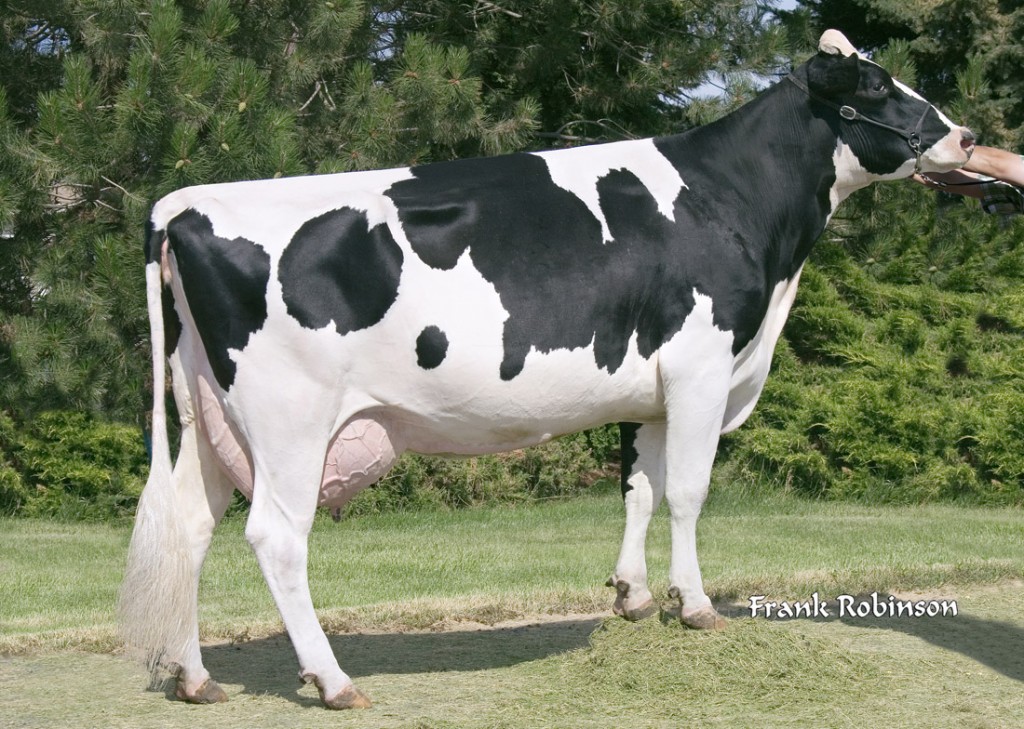
Seagull-Bay Oman Mirror VG-86 DOM
Dam of Roylane Socra Robust
TRIPLE CROWN GENETICS. Launched in 2005
It is obvious that John Andersen enjoys the challenges inherent in running a large commercial operation and encourages others to take the same opportunity. “There is plenty of demand in the dairy industry for leaders with good work ethics and common sense.” The triple talents of ethics, common sense and passion have served John Andersen well for several decades to this day and in 2005 he further rounded out his dairy breeding vision. “Triple Crown Genetics came about when I left Seagull Bay in 2005, I wanted to stay involved in the registered cattle and genetics side of the business and continue to work with elite genetics. Triple Crown Genetics was formed in September of 2005 as a partnership between myself, Seagull Bay, and Jordan Leak. In 2010, I took over 100% ownership of Triple Crown and all cattle that I own are registered under the Triplecrown prefix.”
COWS AND BULLS. The Highlights.
There have been special cows to highlight John’s breeding journey.
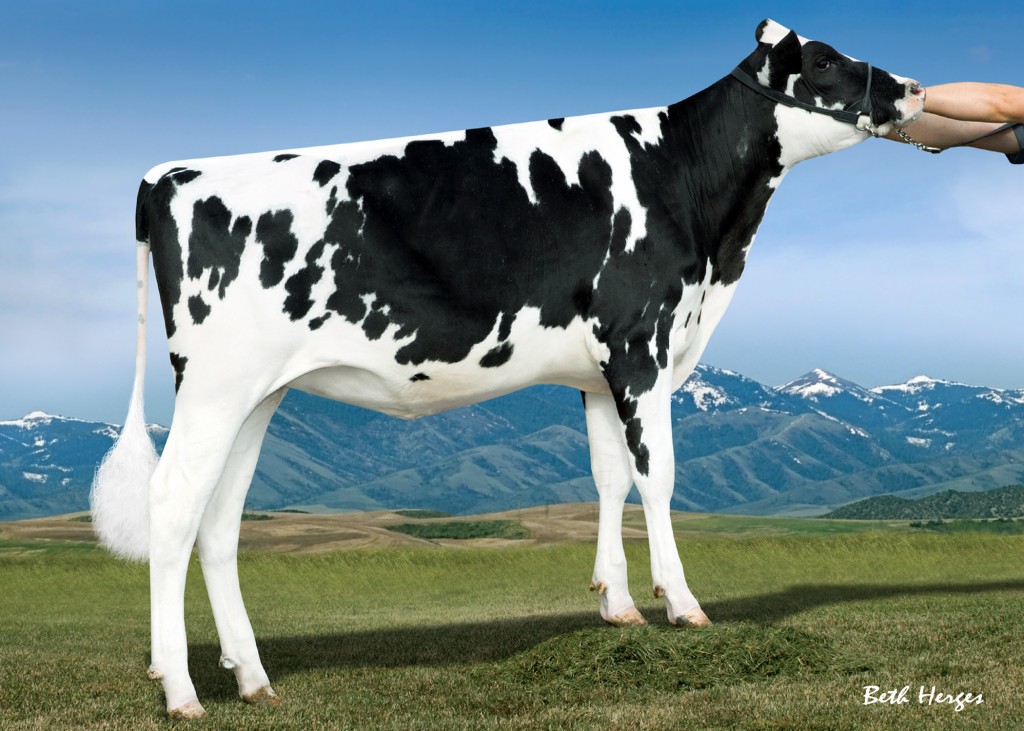
Triplecrown Uno 602-ET
Numero Uno x T-C-G Jeeves Milley-ET EX-90 x Seagull-Bay Lauden Megan-ET VG-87
+2428 GTPI, +88 Fat +32 Protein +2.53 PTAT
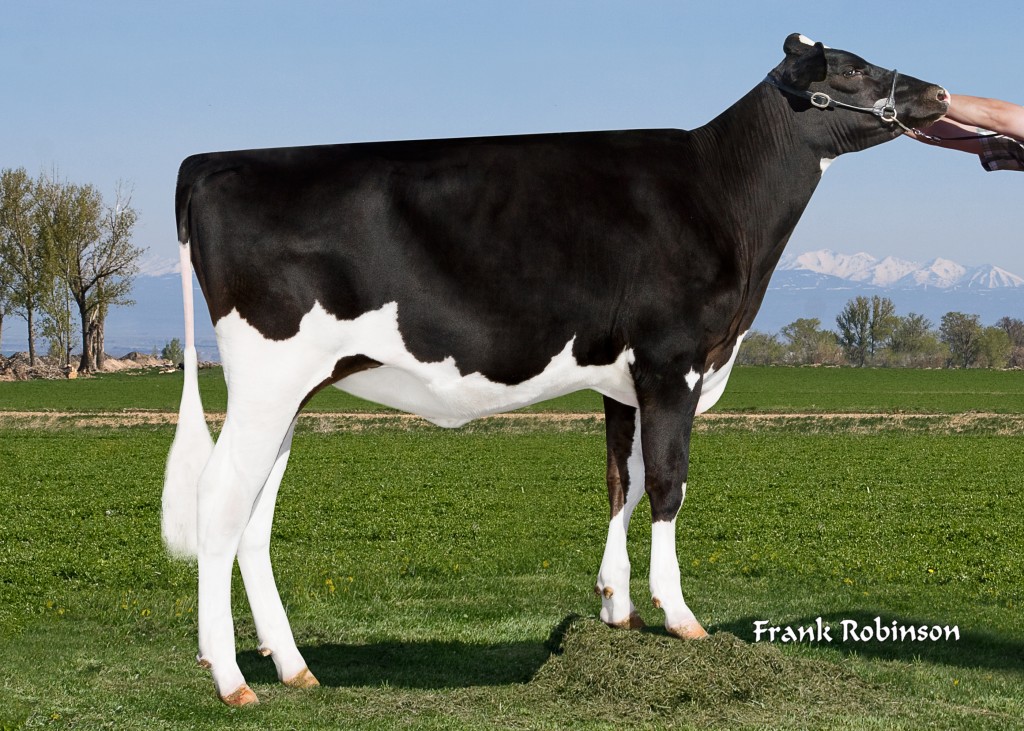
SEAGULL-BAY SH MAUREEN-ET
Numero Uno x Ammon-Peachey Shauna-ET VG-87
+2390 GPTI +1187 Milk +3.08 PTAT
- TRIPLECROWN JACEY 556-ET (Jacey x Jeeves x Laudan back to Minnow family)
- SEAGULL-BAY MOGUL 1723-ET (Mogul x Observer x Shottle x Toystory x Oman Mirna)
- AARDEMA FREDDIE 1994-ET (#1 Freddie in the breed at +2414 GTPI)
The Genomic Bull Story at Double A
“I started using high genomic bulls at about 40-50% of our usage as soon as they were made available and was at 99% within about two years.” I will occasionally go back and use a proven bull that I missed as a genomic bull if I really like him. Massey was an example of this. Freddie has been one of my favorite bulls that I have used in the past five years and am excited about the Robusts that we are now milking as well as the Moguls that are starting to freshen now. We currently genomic test the top 25% of our heifers each month based on parent average (about 150 head/month).
We then select a few elite females each month that will enter our IVF and flush program based on genomic results. We do OPU on farm every Monday with 10-12 Holstein and Jersey donors. All collection and transfers are done in-house, and we ship Oocytes to a lab for fertilization. We are considering to start genomic testing all new females in the next couple months.
“I feel that we will make faster genetic improvement by using groups of high genomic bulls than we would by using only high proven sires, although if someone isn’t comfortable using the genomic bulls, there is nothing wrong with using good proven sires.” There is not any one trait that will keep a bull off of the list if he is good enough in other areas. Traits I look at closely that I am trying to maintain or improve in the herd: Milk, # Protein, PL, DPR, SCS, CE, UDC, FLC and Stature. I try to have different sire stacks among the group of bulls we are using.”
Sires being used on the herd currently: Troy, Stoic, Emerald, Speaker, Pure, El Bombero, SuperSire, Yoder, Jacey, Tango, Deductive. Current IVF mating sires: Troy, Pure, Yoder, Silver, Delta, JoSuper, Desired, Powerball, AltaSpring. John takes a look further back in the breeding program. “A few of the bulls that have had a big impact on our herd pre-genomic era were Oman, Die Hard, Boliver, and Shottle to name a few.”
GREEN LIGHTS and ONE RED FLAG
I like the fact that the breed is putting more emphasis on production in the TPI formula, but would prefer that some of the emphasis were taken away from PTAT rather than some of the health traits. The main problem I have with PTAT is that I feel it is too heavily correlated with stature. Stature is a trait that continues to increase at an increasing rate within the Holstein breed, and I think it is a must that we slow it down considerably.
“My concern is that too many of the top gTPI bulls right now are over 3 pts on stature and to me this is a red flag.”
“I have always said that there is no right or wrong way to breed cows, but you need to have an end goal in mind.”
Quite often you get the best understanding of what motivates a particular dairy breeder, by tuning in on the advice they give others. John Andersen has a well-thought out guidance to share. “If you want to market bulls, heifers, or embryos, it is important to remember what the market is demanding. My opinion is that the bull market is what drives the registered genetics market, and the producers that are purchasing the majority of the semen are driving the bull market.” Further emphasizing the need for keeping the end goal in mind, John refers to his passion for the show ring. “We like to show as a family”, so on occasion I will make a mating with the goal of making a show winner. Some of those sires that I use with the show mating in mind are bulls that I would never use in my commercial herd.”
The Bullvine Bottom Line
“Technology has continued to advance at a rapid rate and it has changed the way we dairy and breed cattle.” Having said that, John doesn’t feel that it is time for anyone to rest on their dairy laurels. “We need to continue to help make improvements to the Holstein cow so that she is the cow that dairymen feel is the most profitable to milk.” Thank you John Andersen and congratulations to Double A Dairy and Triple Crown Genetics for the fine examples of doing exactly that!
Get original “Bullvine” content sent straight to your email inbox for free.
Brian and Carrie Preston of Quincy, Mich., were selected as the state winning 2014 Michigan Milk Producers Association (MMPA) Outstanding Young Dairy Cooperators (OYDC). They represented MMPA’s District 1 and the Hillsdale-Litchfield Local at the annual OYDC Conference held August 14-15. The Prestons were selected to participate in the program earlier this year by fellow dairy farmers in their district.
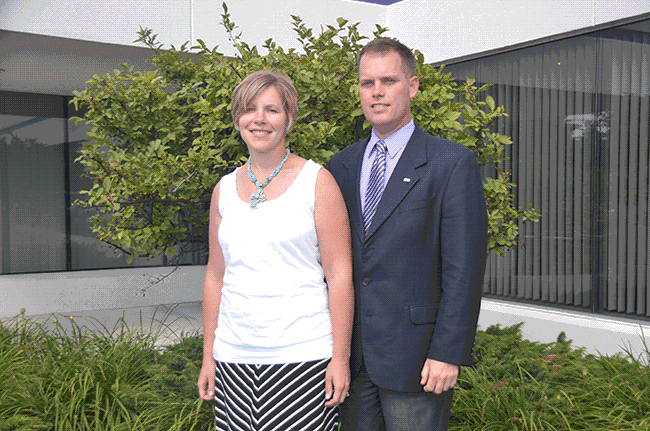
Brian and Carrie farm with Brian’s father, uncles and cousin. They manage a herd of 700 cows and farm 920 acres. Brian has served as chair and vice-chair of MMPA District 1 and has been a MMPA delegate for five years. He’s a member of the Michigan Dairy Market Program Committee, a church deacon and is active in Farm Bureau. Carrie is FFA advisor for the Branch Area Career Center, serves as co-coordinator for Branch County Project RED and sits on the Michigan Draft Horse Breeders Association Scholarship Committee.
As the state winning cooperators, Brian and Carrie will represent MMPA at various industry and association activities. Ken and Kristen Sparks or Cassopolis, Mich., were selected as the runner-up cooperators. Selection of the OYDC is based on the applicant’s farming operations, farm-related and community activities and demonstrated leadership abilities.
The state OYDC Conference, held at MMPA headquarters in Novi, Mich., provides participants with information about milk marketing activities, cooperatives, milk testing procedures and other current events within the dairy industry. The program has been held annually the past 64 years.
“The OYDC program identifies outstanding young leaders in our organization and provides an opportunity for them to gain a greater understanding of milk marketing activities and MMPA,” says Ken Nobis, MMPA president.
All the MMPA District OYDCs will be officially recognized at MMPA’s 2015 Annual Meeting to be held next March in Lansing.
MMPA is a member-owned and operated cooperative serving approximately 2,000 dairy farmers throughout Michigan, Wisconsin, Ohio and Indiana.
We have all heard the buzzwords that claim to be the answer to moving the dairy industry forward: cow sense; walk-the-talk; strategic marketer; team player. There is nothing inherently wrong with any of these descriptions. In fact, Holstein Canada President Mario Perreault embodies all of these, but he goes beyond labels to another level altogether. Mario recognizes that dairy industry growth is not simply the external label that we give Holstein breeders … or even Holstein cattle … it goes much deeper than that.
Holstein Breeders with a Common Goal
Although his experience with cows brought him to this role, it is his passion for the people of dairy breeding that excites this dairy industry leader. “I made a clear statement in my first editorial of the Info Holstein: I will focus on teamwork – with our Board members, with our very qualified staff and with our industry partners. The reason is simple: the more goals we have in common, the more benefits our members will receive.” Mario believes passionately in Canadian Holsteins.
Holstein Canada’s Ambassador Walks the Talk
As is often seen in the dairy industry, passion is the foundation for successful dairy operations. This is certainly the case for the current President of Holstein Canada who is a successful dairy farmer from Quebec (Read more: Vieux Saule Holstein: Rooted in family Values). It has been seven years since Mario was elected to the Board of Holstein Canada. With the support of his wife Linda, he has not only become fluently bi-lingual but he also speaks the language of passionate dairymen everywhere and is an enthusiastic and approachable ambassador for Canadian Holsteins. This owner operator of Ferme du Vieux Saule in the Lanaudiere region enjoys sharing his personal experience of the potential of the Canadian dairy breeding industry and is always excited to attend shows, visit farms and work with people who share his enthusiasm for Holstein cattle.
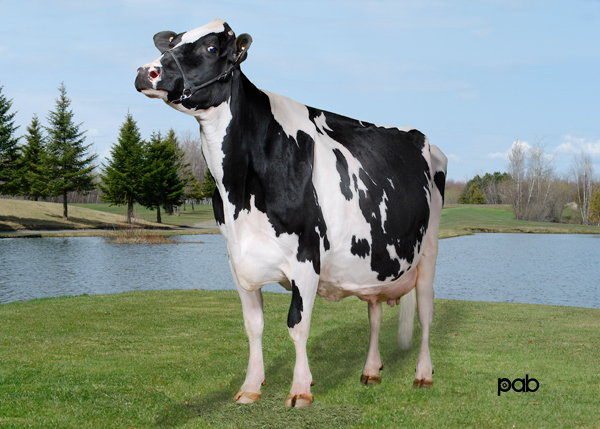
Vieux Saule Allen Dragonfly Ex 94 2E
14* NOM. ALL-CANADIAN 4-H JR.1-YR 2003
2 Superior Lactations
Nominated Holstein Canada Cow of the Year 2013
Supporting and Listening to the Next Generation of Holstein Leadership
There are many challenges in attracting the next generation into the dairy business and doing so is high on Mario’s and Holstein Canada’s priority list. “The younger generation is very important to Holstein Canada – after all, they are our future!” He outlines how Holstein Canada is taking action to support that priority. “Our Young Leaders program has been enhanced to support, motivate and train tomorrow’s leaders, in collaboration with our Industry Partners. Our activities range from scholarships, domestic and foreign exchanges (6 young Canadians will represent us the European Breeding School this fall), to a Young Leader program at our annual convention, and supporting youth in our Branches and at the Royal.” Mario and the Holstein Board are always looking for new and creative ways to support the next generation. “We are working on other new things such as a Leadership Convention similar to the Young Dairy Leaders Institute (YDLI) held in the United States.” Holstein Canada is committed to bringing finding new opportunities that build on experience and enthusiasm. “Projects are endless as we get our ideas directly from our youth.” The entire association benefits from that kind of commitment to and connection with the next generation.
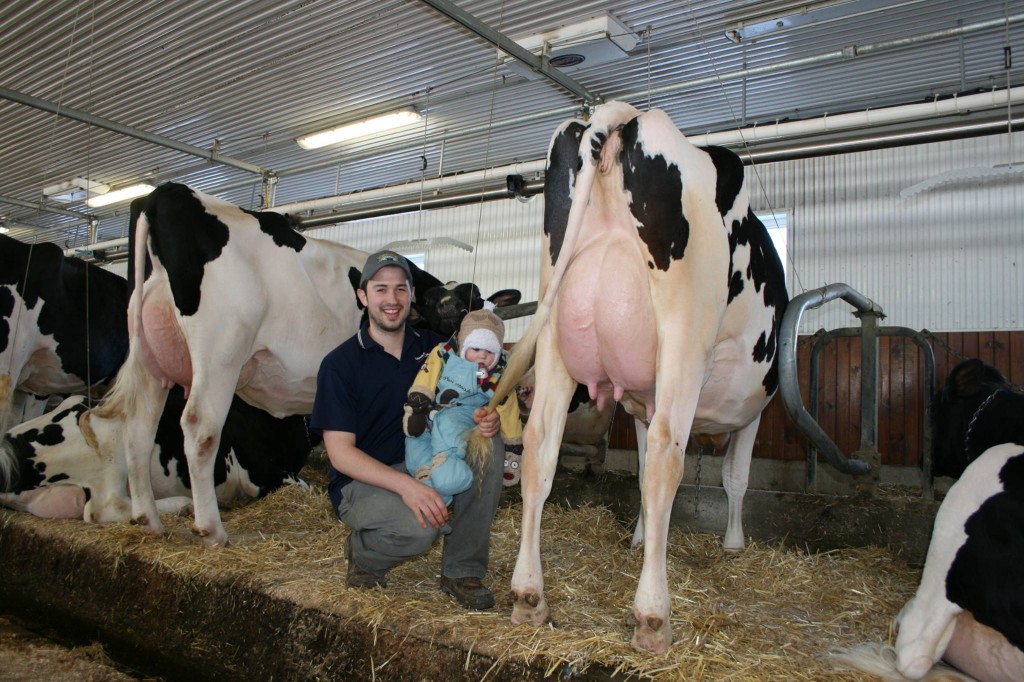
Mario and wife Lynda as well as son Jimmy Perreault operate a 200 acre family farm in Saint-Esprit, in the Lanaudière region of Quebec. Pictured here is son Jimmy as well as Mario’s grandson.
Holstein Canada is Pulling down Barriers and Losing the Labels
Less focus on internal differences and more focus on profitability for the breed.Squabbling is counterproductive agrees President Perreault,who is happy to see changes in how breeders see their peers. “Labels such as ‘commercial’ and ‘breeder’ are not used by Holstein Canada – all producers strive for increased profitability, and the source of income is first and foremost the milk cheque! Each farm is diverse and takes a different road to reach this goal but the goal remains the same!”
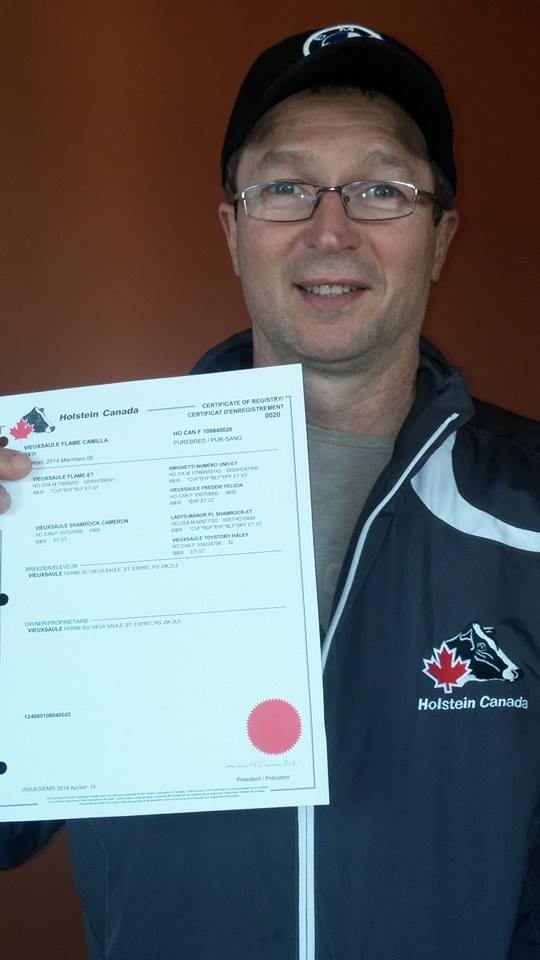
Mario Perreault with his first official signed registration as Holstein Canada President.
HOLSTEIN CANADA VISION: Creating a Competitive Advantage Beyond Registration
Mario appreciates that interesting ideas come from many sources, including those who occasionally ruffle feathers. He embraces the fact that in our common goal is a sustainable industry. “To this end, Holstein Canada’s services are tools to support increased profitability. We are talking more in terms of economics and added value – for example genotyping heifers is to decide which ones to breed, while classification is an indispensable herd management tool: cows with good conformation last longer, etc.” With characteristic enthusiasm, he looks forward to great things. “Holstein Canada will soon unveil the results of a study completed by a third party, revealing the financial benefits of our services – expect great things this fall.”
Educate the Breeder. Elevate the Breed. “Registration. Education. Elevation”
President Perreault is committed to making sure that Holstein Canada Members are up to date on advances in the dairy breeding industry. “We know we must better inform and educate our members – it is always the key to success when introducing something new on the market. We must especially deal with misinformation or misinterpretation.” In particular Mario is gratified regarding the uptake of genomics. “The use of genomics increases each year – we had 20% more genomic tests in the first six months of 2014, as compared to last year.” He reports on steps taken to keep this trend growing. “Holstein Canada has hired Extension and Education staff, to better inform our members on the value of using this new tool in the future. I believe the percentage will gradually climb each year, so my forecast for 2016 would be approximately a 20 – 25 % increase. The more we learn about properly using genomics, the more important this tool will become for all milk producers.” Mario balances his optimism with a definitive statement that genomics is not the only answer to advancing the Holstein breed. “We cannot repeat it enough – Genomics is a tool to be used in conjunction with other important factors: classification and cow families.”
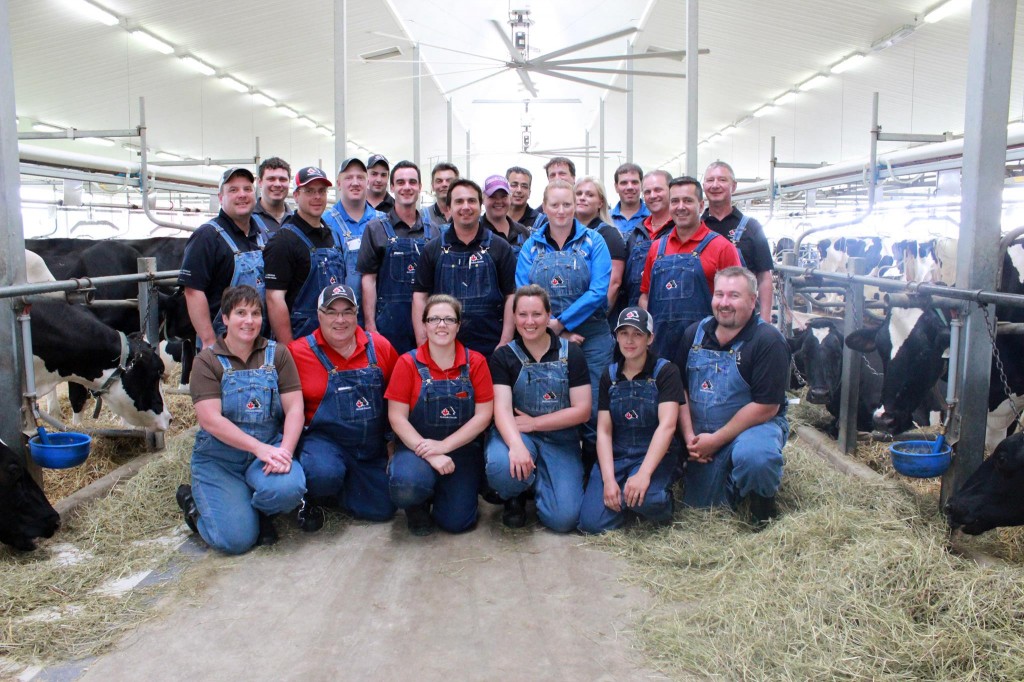
Holstein Canada Classification and Field Service Team
Classification Provides Added Value
Change is the only constant in the dairy industry marketplace. Holstein Canada has to adapt to new goals of Holstein members and the dairy marketplace. “We have changed our approach in these changing times. People no longer just want to talk about four generations of VG or EX – they want to see the added value of our functional Holstein cow.” Mario acknowledges that other industry partners are also addressing these changes. “Our AI Partners still support their clients (beyond paying for bull daughter classifications) and some are simply doing it in other ways, such as price discounts.” He sees an important role for the breed association. “It is up to Holstein Canada to promote the economic value and return on investment of classification – it is a Herd Management tool, first and foremost.” He is proud of ongoing and future plans in this area. “The goal remains the same: to promote a well-balanced Canadian Holstein cow that produces a lot of milk for many years, all while improving its health traits. Our very devoted classification team is doing this every day – and stay tuned this fall for more on this level.”
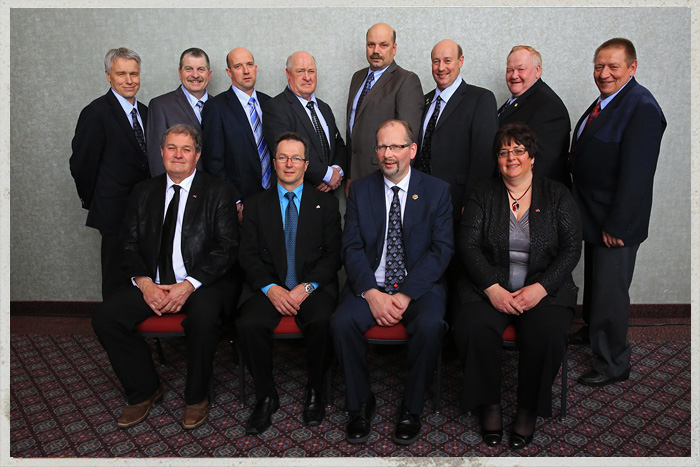
Holstein Canada Board of Directors
(back row, l-r): Robert Chabot (QC); Doug Peart (ON); Gilles Côté (QC), Ron Sleeth (ON); Gerald Schipper (ON); Harry Van Der Linden (Atlantic provinces); Ron Boerchers (SK & MB); and Orville Schmidt (AB).
(front row, l-r): John Buckley (ON)- Vice President; Mario Perreault (QC)- President, Richard Bosma (BC); and Elyse Gendron (QC).
The Future of Holstein Cattle Data Capture Changing with the Times
The Canadian dairy cattle improvement industry has a very progressive approach to making animal information universally available. With automated animal data capture increasing at a rapid rate and less third party verification, The Bullvine put forth this idea to the Holstein Canada President. “Do you see it possible that information from automated systems will be used by the Association and made available on the Association website?” Mario responded with characteristic passion regarding the potential in this area. “This is an excellent question! I also have the opportunity of sitting on the CDN Board, and we have formed a committee to study this issue. Other partners, as well as a few producers using automated systems, also sit on this committee.” Mario sums up that this area of research is a given. “Of course Holstein Canada is there. We must change with the times!”

Holstein Canada’s CEO Ann Louise Carson attending the World Holstein Friesian Federation (WHFF) Council meeting in Berlin, Germany.
Collaboration -At Home and Abroad – Expands the Holstein Marketplace
When it comes to marketing Canadian Holsteins Mario is especially enthusiastic. “This comes back to my strong feelings about teamwork! Yes, we want to help our member’s market Canadian genetics, and our way of helping is to work closely with The Canadian Livestock Genetics Association. In fact, our CEO sits on the CLGA Board.” He elaborates how working with CLGA is part of an ongoing Holstein Canada strategy. “Our goal is to work with exporters, to contribute in lobbying Government and to promote the quality of our Canadian Holsteins around the world. There are some things a generic and neutral association can do to help international marketing. This will be a priority in the coming years.” As well, Mario eagerly points out that collaboration within Canada is also a high priority for Holstein Canada. “Another very important issue for me is to put even more emphasis on the work accomplished with Dairy Farmers of Canada in the last couple of years.” His reasoning is not only based on “protecting our system of supply management” but also goes back once again to a basic commitment to all Holstein members that is best realized through teamwork. “Together we are stronger in promoting Holstein Canada’s profitable tools to all Canadian milk producers.”
The Bullvine Bottom Line
We must never underestimate how the world looks in on our national dairy associations. It is so easy (from the outside) to see where the other national association has cracks, negativity or blind spots. Getting to know Mario Perreault is a positive experience. He speaks with pride, enthusiasm and passion about the Canadian dairy industry and especially about Holstein people.
All the best to Holstein Canada President Mario Perreault from the Bullvine and our readers. Congratulations for helping our industry to succeed not only on the balance sheet but from the heart as well.
Get original “Bullvine” content sent straight to your email inbox for free.
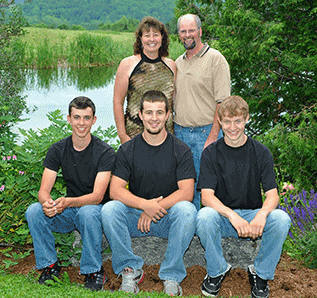
Scott and Laurie Langmaid, along with their three sons, pictured from left to right, Bradley, Ross and Trevor, continue to breed outstanding females at Vermont Pond View Farm.
Scott and Laurie Langmaid of Danville, Vt., have been selected by the Klussendorf Association as the sixth recipient of the Robert “Whitey” McKown Master Breeder Award. This award recognizes a well-managed breeder herd that has been successful at showing and judging and emphasizes all qualities of the Klussendorf Award, including ability, character, endeavor and sportsmanship. The award will formally be presented on Friday, October 3 during the 48th World Dairy Expo in Madison, Wis.
Scott and Laurie, along with their sons Ross, Brad and Trevor, operate Vermont Pond View Farm. Scott grew up at Vermont Pond View Farm helping his father, Hugh, build a genetic base that has produced 170 Excellent cows. They have bred four Excellent 95-point cows and six Excellent 94-point cows.
The farm has been in Scott’s family for six generations and more than 200 years. Hugh and his wife, Ann, began working with registered Holsteins in 1964. In 2001, Scott and Laurie took over the dairy and have continued to grow the recognition of the herd.
The tradition of excellence runs deep in the cow families that the Langmaids develop. Several of the more prominent cows that wear the VT-Pond-View prefix (short for Vermont Pond View) come from lines that date back to cow families purchased by Hugh. This includes VT-Pond-View Round Oak Sue EX-94, whose line produced two Excellent 95-point cows, and VT-Pond-View Charisma-ET EX-95, whose line produced three Excellent 94-point cows. The Swampy Hollow Elevation Sweet EX-92 3E cow family also has played a large role in the herd.
Another of the more prominent lines on the farm had its beginning with Twin-Wind TC Broker Lass EX-95. The cow was purchased by the dairy in 1990 and has left her mark producing nine Excellent daughters and several Excellent granddaughters. One of her daughters, VT-Pond-View Rubens Lilyana, also scored EX-95 points and produced many high-scoring offspring.
In 2011, VT-Pond-View Goldwyn Libby-ET, the granddaughter of Lass, was recognized as the Unanimous All American and All Canadian Spring Yearling winning the spring yearling class and junior champion honors at the Royal Winter Fair, New York State Fair and Maryland State Fair. The family has also earned All American Best Three Females in 1991. That same year they earned Reserve All American Produce of Dam, an honor they repeated in 1994.
The family stays busy on the farm and has been unable to do much showing in the last several years, but they have a strong history at the Northeast Fall National Show recording five premier breeder awards and two premier exhibitor titles. The farm has also exhibited many years at the Vermont State show winning premier breeder six times and premier exhibitor five times. They have also laid claim to premier breeder or exhibitor titles at the All American Dairy Show, Mideast Fall National and New York State Fair.
A dedication to breeding and developing good cow families alongside the pond in northeastern Vermont has earned the Langmaids the honor of being named the 2014 McKown Master Breeder.
The Robert “Whitey” McKown Memorial Breeder Award was made possible by the family and friends of the 1997 Honorary Klussendorf honoree after his passing in 2009. Whitey joined the Holstein World staff in 1956 and became widely respected as he traveled nationally and internationally, reporting on shows, sales, meetings, and other Holstein events. The 1987 National Dairy Shrine president also developed MooKown Holsteins at Belleville, N.Y. Whitey had great admiration for the farmer breeder.
The Klussendorf Memorial Association, considered by many as the Hall of Fame for Dairy Cattle Exhibitors, began in 1937 in memory of Arthur B. Klussendorf, considered the outstanding dairy cattle showman of his time. Each year, the Klussendorf Association votes to add a new dairy cattle exhibitor to its roles with lifetime membership for their cumulative works including ability, character, endeavor, and sportsmanship.

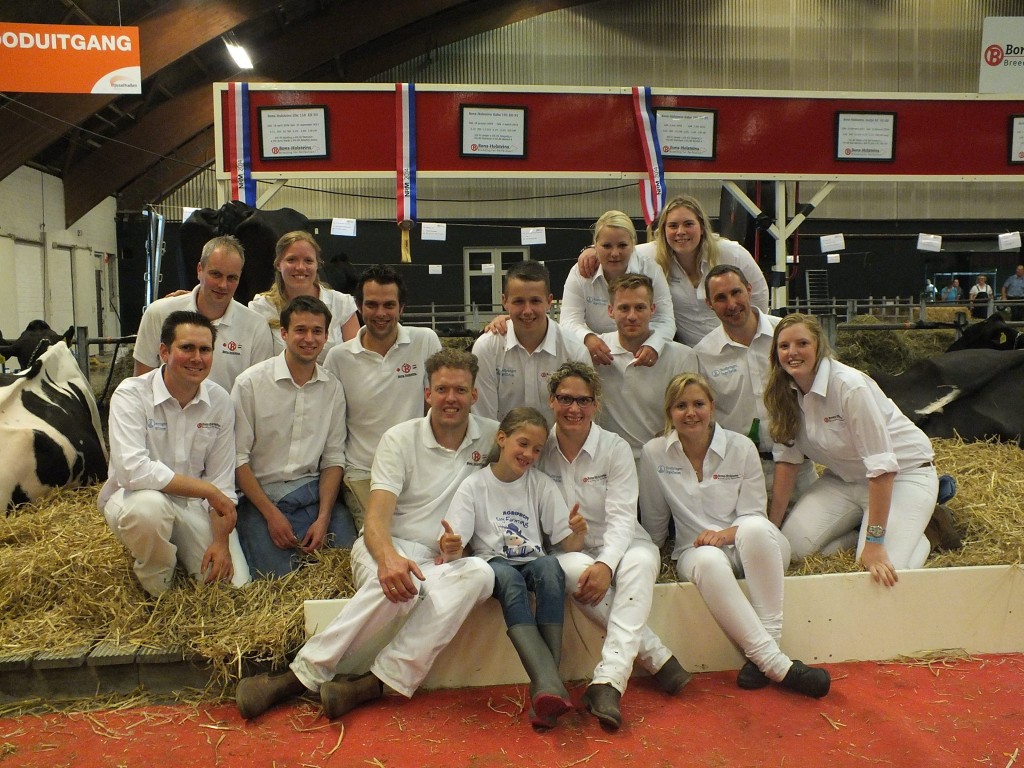
The Bons-Holsteins team from the 2014 NRM Show
“Bons-Holsteins is a home bred farm. In the last 60 years, we never bought a cow, heifer or embryo.”
Nico Bons of Ottoland in the Netherlands proudly benchmarks that he and his wife Lianne are the fourth generation to farm Bons-Holsteins. As the youngest of the Bon family siblings, Nico has already faced the challenges of his dad passing away in 1999 and an accident that kept his brother from taking over the farm. Today with his mother Dikkie Bons the couple milk 65 cows and have 75 young stock on the 40 hectare farm. Undoubtedly, their young daughters Tessa and Anouk and son Ruben.
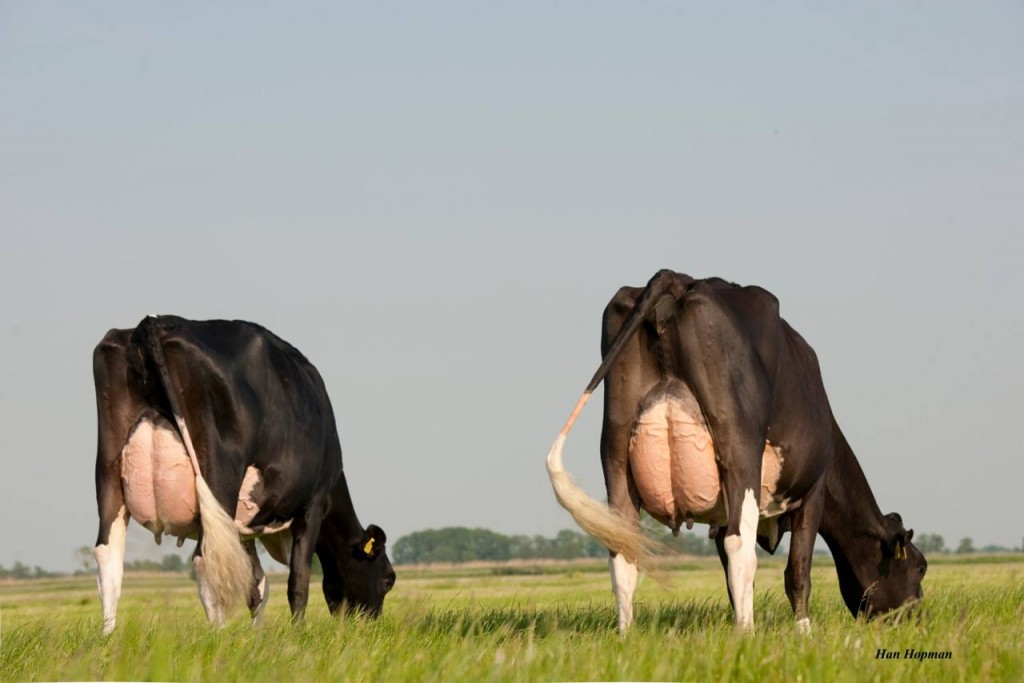
Left: Bons-Holsteins Koba 191 EX-94 – Int. Champion Int. Show Libramont 2013 & Sr. Champion in 2014!!!
Right: Bons-Holsteins Koba 175 EX-90 – 2nd Calf Jasper dtr from the great home bred Koba cow family
100% Homebred – Scoring better all the time.
Every generation of the Bons family has moved the dairy operation forward while remaining committed to the homebred philosophy. 65 cows 29x EX and the rest is VG or better. Average score VG89. All bull calfs stayed on the farm and are sold to other farms as jumping bulls, and a few of them go to A.I. There are six cow families we are working with: Bons-Holsteins Aaltje, Bons-Holsteins Dikkie, Bons-holsteins Ella, Bons-Holsteins Koba, Bons-Holsteins Hannie and Bons-Holsteins Roza.
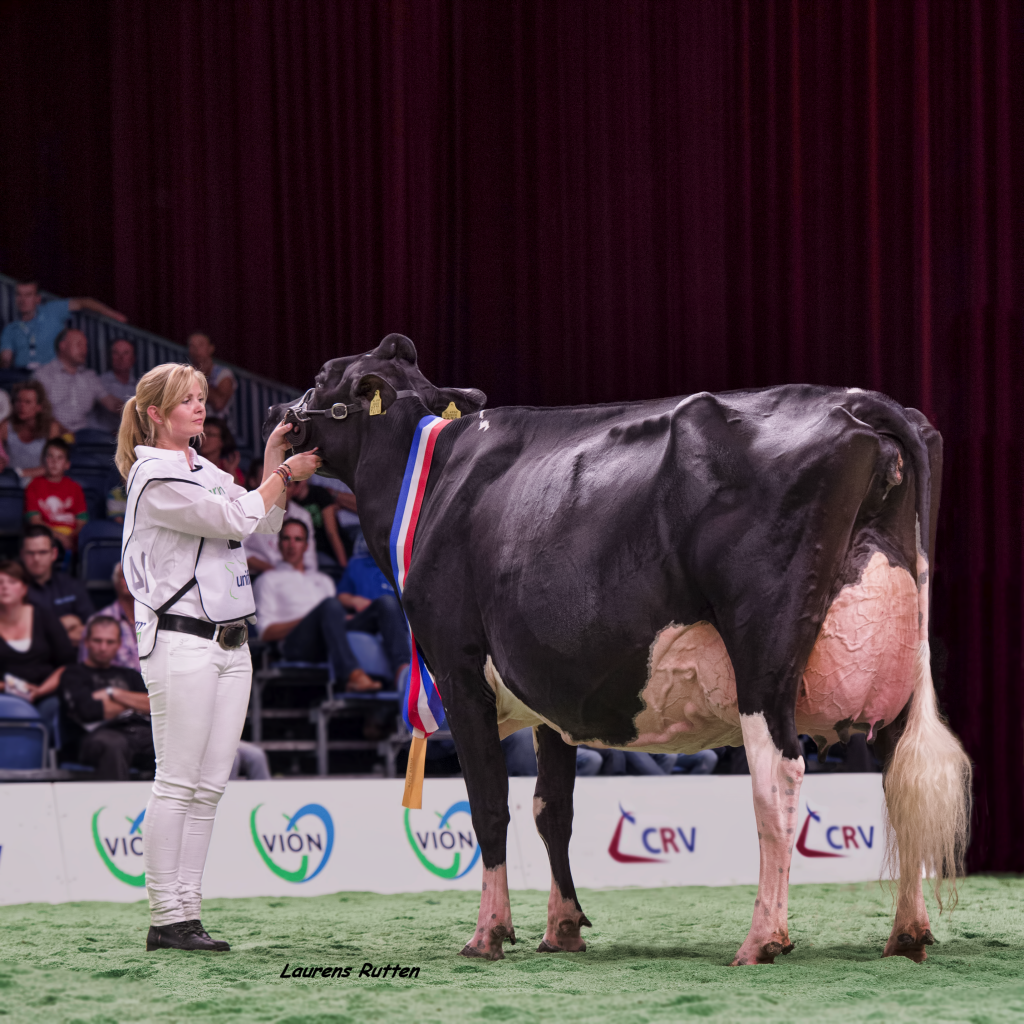
Bons-Holsteins Koba 191 (EX-94)
Grand Champion NRM 2014
Res. Int. Champion Holland Holstein Show 2013
One Goal Above All “To Breed a European Grand Champion”
When Nico took over the farm in 1999, the average type score was GP 80.3. What remarkable progress to be averaging VG89 in 15 years! Nico had been to Canada in 1994 and worked on Bosdale Farms in Ontario. “What I saw there were really nice balanced cows.” He reports that the experience had a big impact on him. “I knew right then what my goal would be. I wanted to breed the European Champion cow and lead her by myself in the showring!”
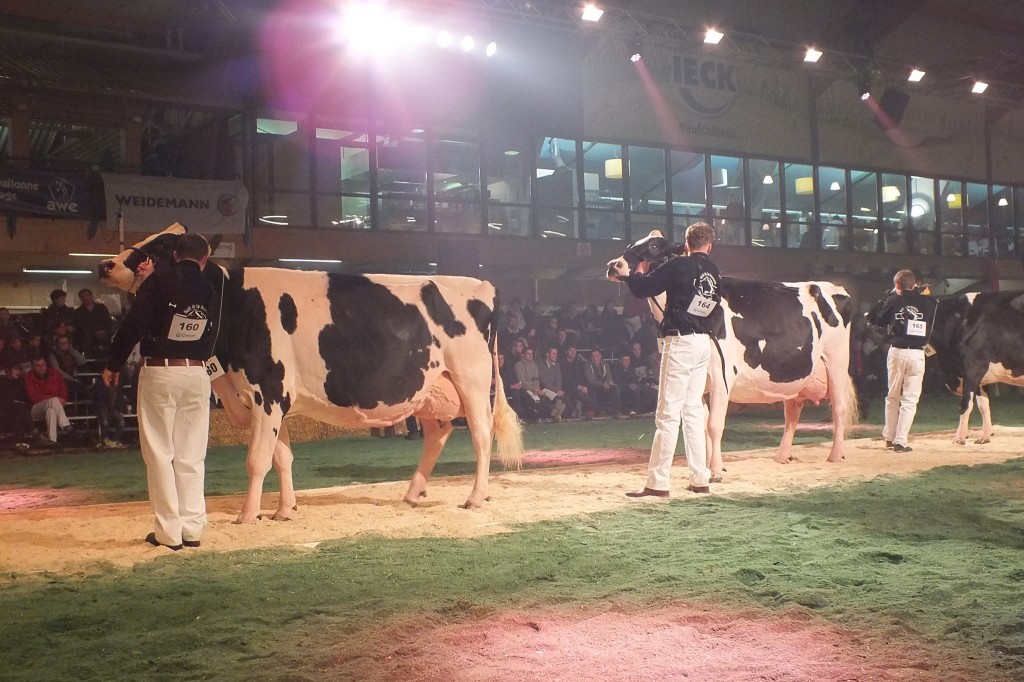
Nuit de la Holstein Libramont 2013
Sr Champion Bons-Holsteins Ella 158 EX-93 (Mailing) & Reserve Sr Champion Bons-Holsteins Ella 153 EX-91 (Allen)
“Showing cattle is a lot of work.”
Nothing really worth achieving is easy and Nico Bons is emphatic about the hard work involved in showing dairy cattle. He advises anyone interested in focusing on show cows to realize that fact and “to try to get people around you who really want to help you and listen to their advice.” He gives examples of mentors that have positively influenced him. “The cowfitters I have worked with in the last few years have sent me in the right direction. Three that I have learned the most from are Michael Halliwel, Joel Phoenix and Paul Petriffer.” Along with the hard work, Nico advises that you have to be prepared for ups and downs. “I had my luck to start from the bottom. I know what it is like to stand in last place in the showring” But this successful showman concludes. “Sometimes you win sometimes you lose. Never give up.”
Top Advice, “Don’t be mad at the Judge. Breed a better cow. Win next time.”
Nico cherishes his family traditions and also learns from key mentors that have crossed his path as he seeks to achieve his goals. “Its difficult to say exactly who had the biggest influence on me. I think Ed Bos (From Bosdale farms) had a significant impact on me becoming the dairy breeder I am now. My training period at Bosdale showed me that you have to work really hard to get results in the show ring.My father added the one thing that I always remember. “If you are disappointed on show day about your placings, don`t be mad at the Judge but breed a better cow so that he has to make you Champion next time.” Hard work and taking responsibility are what have put Bons-Holsteins at the front of winning lineups.
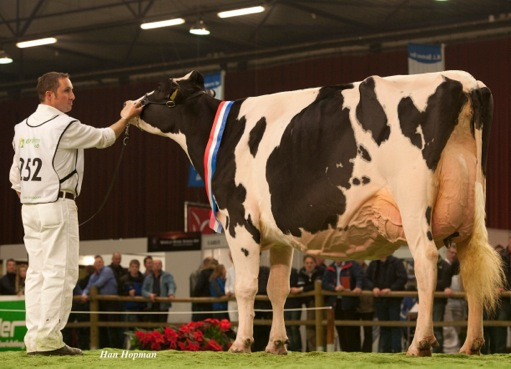
Bons-Holsteins Ella 158 EX-93 (Mailing)
Res Champion Mature Cow NRM 2014
1st place Sr. Cow Holland Holstein Herd Show 2012
Trophy Shelf Chronicles Rising Showring Success
Nico Bons started working toward his ultimate showring goal first with successes at local shows and then by showing at a national show in 2003. In 2007 international success was achieved in Paris and later in Libramont Belgium 2013 which Nico describes as “one I liked the most.” when Bons-Holsteins Ella 158 (EX-93 Mailing) was named Grand Champion. Nico describes the cows that are winners for him.”I think there are two cows I am most proud to have bred: * Bons-Holsteins Koba 167 (EX-91 Stormatic). She was a really tall cow (1.76 Cm.) and was made for the show ring. She was not only big but had balance in her frame and an udder that was close to perfect.” He explains that others found her special too. “ I loved to lead that cow into the showring. Whenever she entered the ring, you would hear spectators talking about her!” It isn’t surprising in this homebred herd to find that Nico’s second choice for breeding success is related to his first choice. “The second cow is the recent Grand Champion from the Dutch National Show (June 2014) Bons-Holsteins Koba 191 (EX94 Jasper). (Read more: Bons-Holsteins Koba 191 Grand Champion at NRM 2014) The funny thing is these two cows are half sisters.. they are both descendants of Bons-Holsteins Koba 152 (EX-92 Integrity). She is not as tall as her half-sister, but she is a cow with almost no faults! She is extremely balanced… and is a real Queen in the ring. I feel quite strongly that she can do a great job at the European Confrontation. That’s the goal for this cow in the future!”
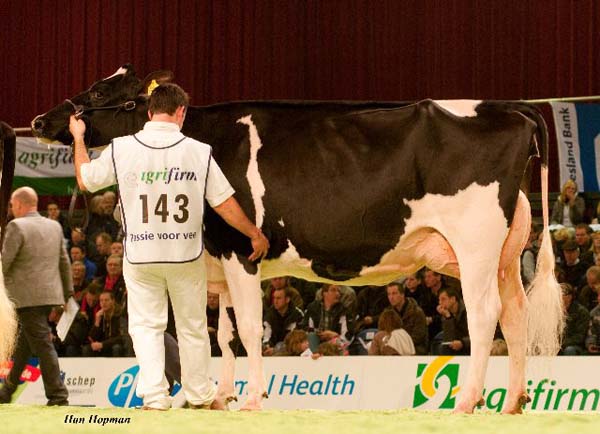
Bons Holsteins Ella 167 VG-89 2yr.
1st Intermediate Class Libramont 2012
1st Intermediate Class National HHH-Show 2011
Champion Jr. 2yr. Old HHH Show 2010
Champion Jr. 2yr. Old & Best Udder Libramont ’11
Bons-Holsteins has Three Show Toppers at 2014 Dutch National Show
The Bons are building their show ring success. “We go to eight shows a year.” Reports Nico adding that showing is a strategic marketing plan, along with their website and Facebook. Nico feels that showing “ is an excellent tool to let the world know what you are doing.” Bons-Holsteins average 1500 visitors a year and each visitor receives a herd flyer. This marketing plan earned positive reinforcement in June at the Dutch National Holstein Show in Zwolle. Bons Holsteins won an amazing three championships! Bons-Holsteins Koba 191 (EX04 Kas[er_ was the Grand Champion. Reserve Senior Champion went to Bons Holsteins Mailing Ella 158. Koba 195, a full sister to Koba 191, was named the Intermediate Champion.
Nico Bons has favorite “Winning” Bulls
With such a strong focus on type, there has to be a strong emphasis on bull selection. Nico lists his favorites: “At the moment we use a lot of Atwood and Lauthority, a little less from Shadow, Talent, Goldwyn, Jasper, Chelios, Seaver and sid. Referring to Jasper and Stormatic, Nico explains why they were chosen. “The reason to use these two bulls is because the Integrity was a little heavy boned. As a result, we were looking for the bulls who could give us the bone quality. The Integrity cows’ strongest points were rear udder and rump so the choice of Jasper was easy. That’s where you have to protect this bull for.” Nico moves on to Lauthority. “I like my young Lauthroity heifer calfs. I think he can make some show winners.” His has only one hesitation. “ I am a little afraid about the rear legs… sometimes they are a little hocked in.” As well he likes Seaver. “Seaver is one of the bulls we just used recently and I see a lot of good 2 yr.olds in Belgium with great udders. You have to use him on refined boned cows.. I use him on my Stormatic and Talent daughters.”
 Here comes the Judge
Here comes the Judge
With his passion for breeding show cows, it was only a matter of time until Nico entered the show ring as a Judge. In 2013, his name was added to the European Judges Panel by the EHRC. He finds it both a rewarding experience as well as a source of continued learning. “Atwood is the bull who surprised me every time I judge show. We know you have to watch his rumps but if they are ok you get some special ones!”
Not blinded by numbers Nico still builds on the Canadian Kind
One of the biggest differences Nico has observed over his breeding career is in the way breeders choose bulls. “In the past, we used our eyes and followed our heart to make the right pairing. Then came indexes.” Nico feels that indexes meant “breeding by numbers” as he calls it. He goes on. “After a few years we realised that the cows we created were ok as milk producing cows but had no strength and power anymore. And then came genomics.” Once again, Nico feels “we are losing our eye for good cow families.“ Nico feels that too much is being sacrificed for speed. “In my opinion that makes it a crazy system, if the goal is all about getting the highest absolute number!”
“Trusting their eyes keeps people coming back”
Bons-Holsteins knows how important it is to have the confidence of buyers in the dairy marketplace. Change can be threatening as Nico explains. “ At first I was afraid that, if I was not involved in genomics, I would not sell embryos or good cattle anymore.” However, he happily reports that hasn’t happened. “I get more and more requests for embryos and good cattle.” He sums up his reasoning for the cause of this continued success “The people who buy here are looking for something they can have confidence in and they buy what their eyes can see. Not being disappointed si what brings people back to buy again.”
The Bullvine Bottom Line
The emphasis on show type has been a winning formula for Bons-Holsteins and Nico agrees. “I think the biggest accomplishment is the total herd of homebred cows that we now have! From when we started in 1999 until now they have changed a lot.” He is proud of the Bon family teamwork that focuses on getting better all the time. “ I did not do all this work alone but my wife and mother helped me every day!” Today with daughters Tessa and Anouk the Bons family are proud to meet the challenges of their shared vision and take their place in Holstein dairy breeding for years to come. They are definitely the type that wins!
Get original “Bullvine” content sent straight to your email inbox for free.
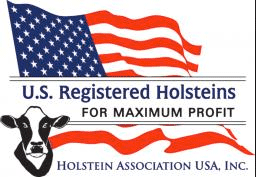
To be named a Herd of Excellence, herds must be 25 percent above breed average Mature Equivalent (ME) for milk, fat and protein; have classified within the last year and have an actual average classification score of 83 points or higher; have at least 70 percent of the herd homebred; and be enrolled in the Association’s TriStar production records program.
This year’s honorees include: Jeffrey & Kate Hendrickson, Jeffrey-Way Holsteins, Belleville, Wis.; Thomas J. Kestell, Ever-Green-View Farms, Waldo, Wis.; Steve & Amanda Killian, Dirt-Road Holsteins, Blair, Wis.; Larry Lexvold, Lexvold Holsteins, Goodhue, Minn.; and Scott & Doug Long, Long-Haven Farms, Clayton, Mich.
Read more about these outstanding breeder herds in the Spring 2014 issue of the Holstein Pulse. Select pages of the Pulse are available online at www.holsteinusa.com under latest news, then click on The Holstein Pulse.
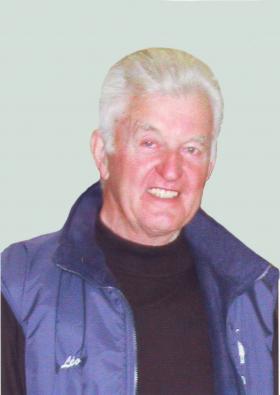
The family will receive condolences at the funeral home Roger Benoit & Fils Ltée, 7, Church Square, Cap-Santé, Wednesday, June 4, 2014 18 am to 22 pm and Thursday from 10 h. The funeral will be held Thursday, June 5, 2014 at 13 am in the Holy Family Church in Cap-Santé, and thence to the crematorium. Mr. Jacobs is survived besides his girlfriend heart, his children: Jean (Marian Ghielen) Martin, Dorothy (Georges Cyr), Ella (Claude Lépine), François (Céline Petitclerc), Pierre (Sandra Fillion), Marian (Jacques Leclerc); his grandchildren: Yan (Véronique Premont) Ysabel (Tyler Doiron), Kevin (Stephanie Benoit) and Laurie (Mathieu Jalbert); Jonathan Jacobs and Jean-Philippe (Marie-Eve Sauvé); Louis (Audrey Mottard) and Philippe Bertrand (Marie-Sophie Arseneault) Catherine Langevin and Alexander Devault; Karen, Andrea Jacobs and Emmy; Matis-Leclerc and Catherine Jacobs and his 14 great-grandchildren, the children of Jeanne François (Cyndie Julien), Stephen (Melissa Dussault) and Mathieu Christmas (Jessica Won), his sister Leen (Harnol Kurvers) and Wiel brother, his brother. Joosten Jean (late Anna Jacobs), several nieces, nephews, cousins and friend (s)
Those who wish may make a donation to the Foundation for health and social services Portneuf, 700, rue Saint-Cyrille, PO Box 850, Saint-Raymond, G3L 1W1 or online at www.fsssp.ca
For information: 418-285-2211, Fax:. 418-285-2077, email: salonbenoit @ globetrotter.net website www.salonfunerairebenoit.ca
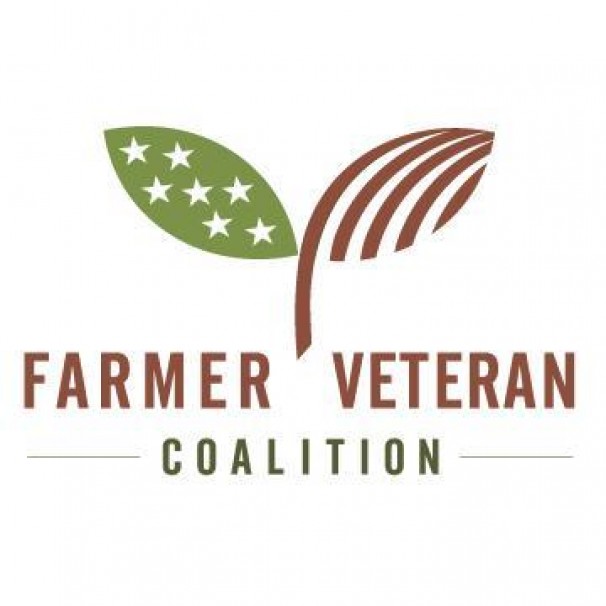
“The military is not for the faint of heart, and farming isn’t either,” said Michael O’Gorman, an organic farmer who founded the nonprofit Farmer-Veteran Coalition, which supports sustainable-agriculture training. “There are eight times as many farmers over age 65 as under. There is a tremendous need for young farmers, and a big wave of young people inspired to go into the service who are coming home.”
The Farmer Veteran Coalition works with veterans in the food and farming community in all 50 states, to provide farming education, and veteran assistance to those in need. Farmer Veterans produce a wide range of food and fiber products, all of which are an integral part of America’s food system.
“Basically we have two simultaneous missions,” comments O’Gorman. “One mission is to help the young men and women that are coming out of military service and the other mission is to help involve more farmers in an industry that is in need of younger people now more than ever.”
More than just dedication and commitment to their country can connect a farmer to a veteran. Both occupations bring with them ethics to work hard and do things right; the fearlessness to sweat and the grit to never give up. O’Gorman says one of the misconceptions is that farming is seen as a way for veterans to heal as if it were an easy, no-stress line of work.
“The real healing for our vets when it comes to farming is that it’s difficult, challenging and gives a true sense of purpose,” O’Gorman explains. “These men and women went into the military with the highest calling and sense of purpose that they could find and after their time in fatigues is through, agriculture fills that void for them to do something for the greater good and our entire country.”
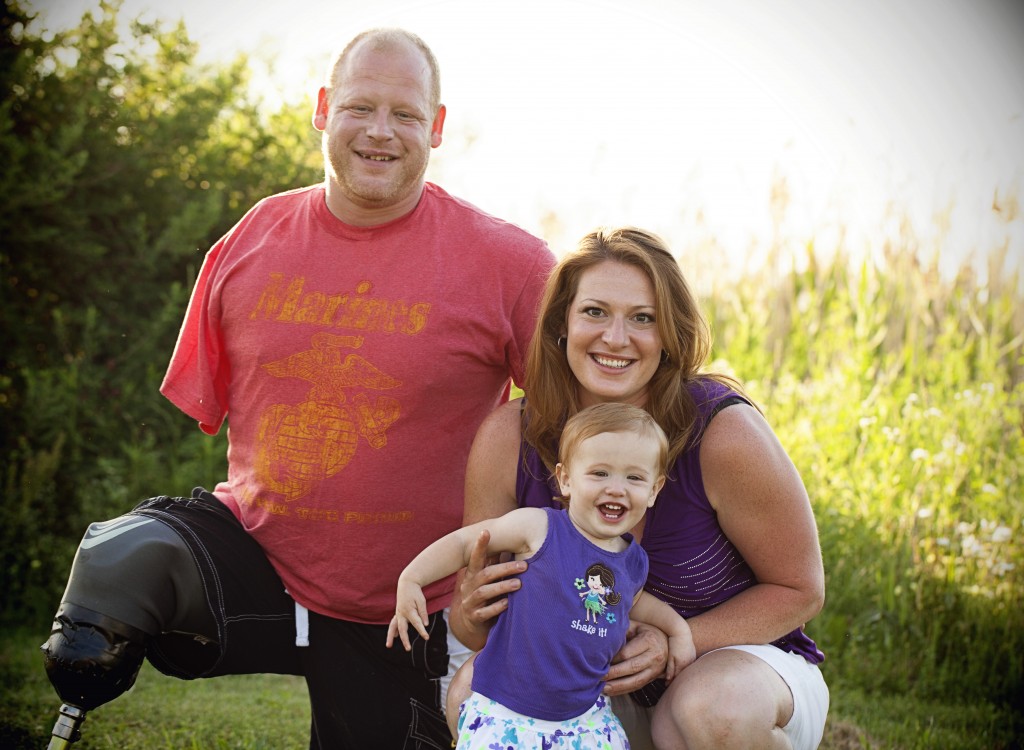
Mark & Denise Beyers
One of the farmers that have found great support through the Farmer Veteran Coalition is Mark Beyers. In 2005, while deployed in Iraq, Mark’s team hit an IED, which has left him with extensive injuries. After Mark’s recovery, along with his wife Denise, who served stateside as a Unit Diary Clerk for 8 years, Mark decided to start producing maple syrup on their 15-acre property in Upstate New York. Soon the demand for their product far outweighed the couple’s capacity to produce. Mark and Denise have continued to grow their business with the assistance from the Farmer Veteran Fellowship Fund.
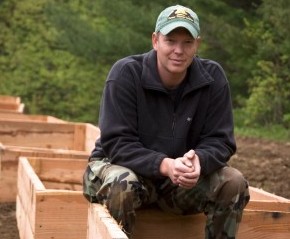
Jeremiah Butler
Also benefiting from the Farmer Veteran Coalition is Jeremiah Butler. Jeremiah served five years in the Marine Corps before enlisting in the Army to pursue a career in the Special Forces. As a Green Beret, Jeremiah deployed to Afghanistan where he sustained physical wounds. After Jeremiah’s service, he decided to pursue a career in agriculture. “I believe in the American small farm, and think it has a crucial part to play in the local economy and the community. I consider myself a patriot of this country and believe this is the best way I can continue to support and help her grow.” Jeremiah currently raises organic vegetables and berries in raised beds on his family’s property. As a Bob Woodruff Farming Fellow, through the Farmer Veteran Fellowship Fund Jeremiah was able to purchase a large greenhouse, which has enhanced his growing capabilities.
The Farmer Veteran Coalition (FVC) recently announced the national launch of the Homegrown By Heroes initiative. This product-labeling program will allow farmers, ranchers, fishermen, and the like from all 50 states and U.S. territories who have served or are still serving in any branch of the U.S. military the ability to use the logo on their agricultural products. Consumers and businesses purchasing agricultural products will begin to see this logo at the point-of-purchase and on business signage, enabling them to select products that support farmer veterans.
The Bullvine Bottom Line
Former President Eisenhower once said “Our adequate food supply played as important a role in winning the war as did our supply of ammunition. Thanks to the American farmer.” However, even after their military service, there are still many battles these veteran’s face. With one of the highest un-employment rates in the nation, these veterans need support. That is why its great to see programs like the Farmer Veteran Coalition helping these heroes find opportunities in agriculture, an industry we all know is very rewarding and needs an influx of young producers.
To find out more about Farmer Veteran Coalition, visit their website www.FarmVetCo.org or call their offices at (530) 756-1395. Share with them the opportunities you may have to help these dedicated individuals. Click here to download the Veteran Careers in Agriculture: A Resource Guide now.

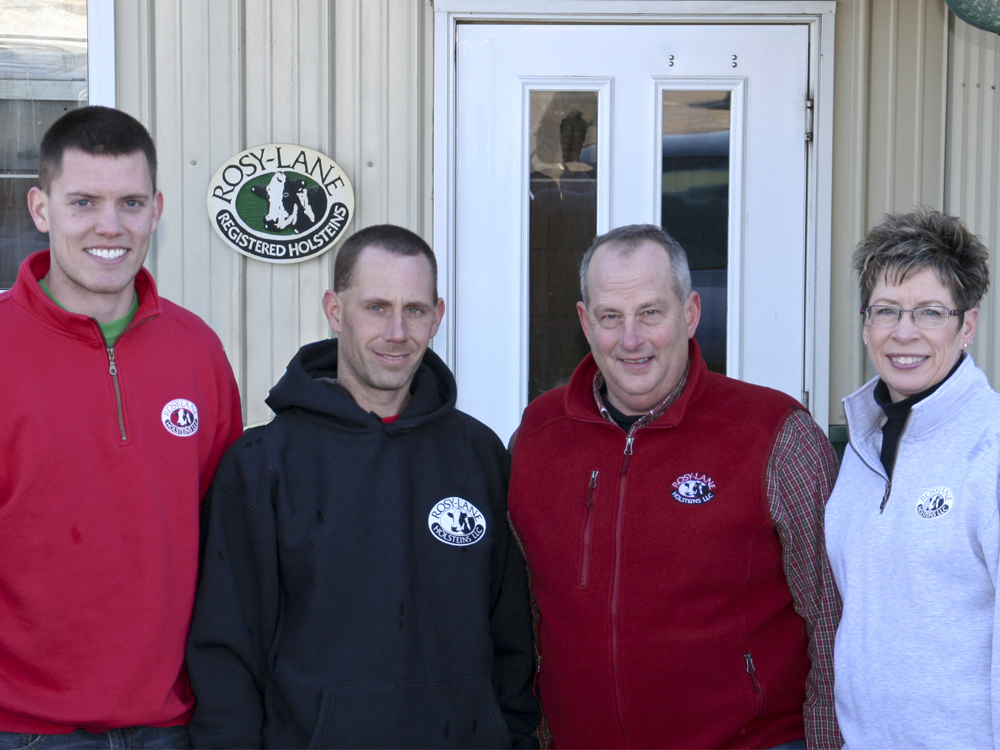
Four partners at Rosy-Lane Holsteins: Jordan Matthews, Tim Strobel, Lloyd Holterman, Daphne Holterman
The Milky Way to Rosy-Lane
Lloyd Holterman looks back to growing up on a 50-cow registered Holstein farm. “My parents Lloyd A. and Rosemarie Holterman focused on high production. I graduated from the University of Wisconsin – Madison in 1980 in Dairy Science and was a member of the Dairy Cattle Judging Team there.” explains Lloyd. “I married Daphne in 1981 and we partnered with my parents for 6 years, went on our own for 2 years, then returned to the home farm to take over and purchase the herd in 1989.” He brings the story to the present day. “We currently have 920 total cows and 870 youngstock. We grow 1,600 acres of forage and do some custom harvesting. Genetic sales account for 1-5% of gross revenue, depending on the year.” That simple summing up barely skims the surface of this well-run dairy operation that hosts classes, seminars and visitors from within the dairy industry and from the broader consuming public. The Holterman’s are dedicated dairy Agvocates as well as very successful dairy farmers. All tasks at Rosy-Lane are thoughtfully considered and thoroughly implemented.
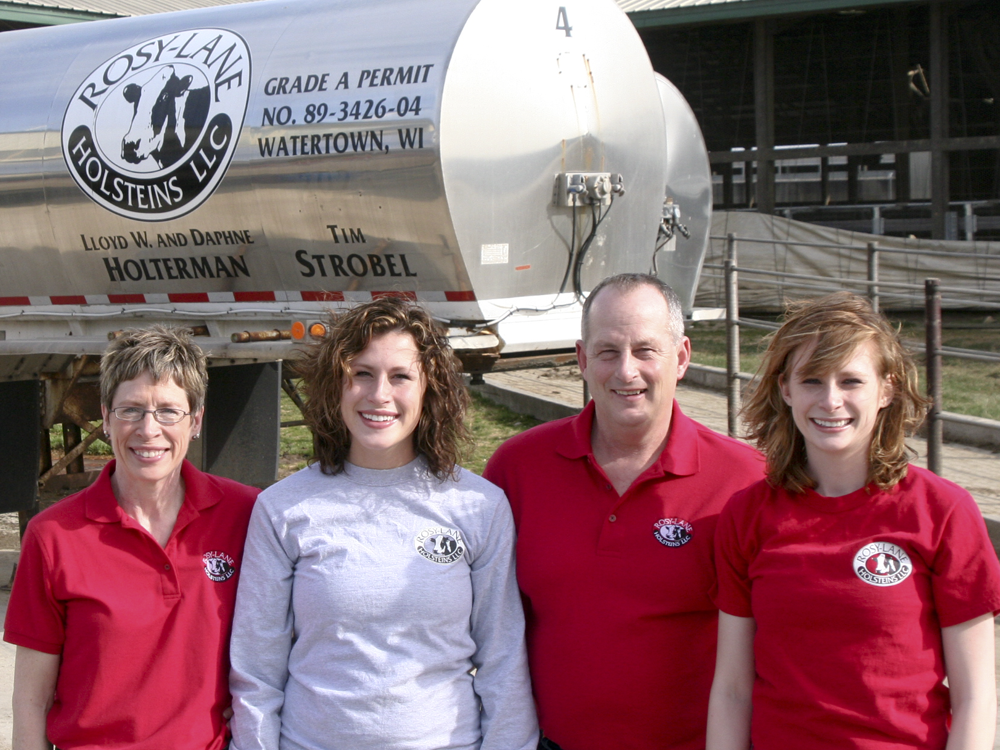
Holterman Family (L to R; Daphne Lauren Lloyd Taylor)
At Rosy-Lane They Minimize AND Maximize to Avoid Tall, Pretty and Infertile
Lloyd states the first step in Rosy Lane Holstein’s operating strategy. “Profit comes first as farming is a business.” Far from the negative connotations such a goal sometimes earns, Lloyd points out that efficiency is key. “While it’s great to sell one animal for big dollars, the genetic program should be an investment in growing future earnings and genetic selection must maximize: feed efficiency (through high producing healthy cows); Labor efficiency (through high producing healthy cows) and Capital efficiency (through high producing healthy cows).
The link between efficient dairy management and health productive cows is one that Rosy Lane gives the highest priority.
At the opposite management extreme, at least from the size viewpoint, is the goal that genetic selection must also minimize key parameters: Herd health cost per cwt.; death loss across ALL ages; calves born DOA and days open.”
With this clear vision of desired outcomes, Lloyd outlines how the strategy is carried out at Rosy Lane. “The best tool to do this (minimize and maximize) is NM$ or CM$ (Cheese Merit). Living in Wisconsin, our income is highly dependent on component pricing (Class III).” He briefly considers an alternative. “TPI also has it strengths but if you aren’t careful, you can end up with Tall, Pretty and Infertile.”
Three Decades of Distinguished Rosy-Lane Dairying
Such a clearly stated perspective on dairying has been achieved over many years reports Lloyd. “Daphne and I started farming with zero dollars and two college degrees. In 33 years, we have built a sound business that we are now transitioning to two young men that both started working with us before they were 16 years old. It’s interesting to note that neither of them grew up on dairy farms. One of the key points in our farm mission statement is to: Maintain an economically-viable business unit with future potential. We are well on our way to accomplishing this.” While they put extreme emphasis on the daily details they are always building for the future.
There Must Always be Time to Grow, Connect and Learn
At Rosy-Lane they feel there is always something to learn from mentors who, both near and far, have been many and well-valued. Lloyd points out the ones that he found to be the most influential. “Pete Blodgett called it as he saw it and was one of the first to realize cows were too tall-narrow-thin-lame. Another is George Shook, University of Wisconsin-Madison genetics professor, whose Dairy Cattle Breeding – Genetics 460 class still sticks with me every day. His class was a good background to understand genomics.” Lloyd appreciates other successful dairymen. “Don Bennink, North Florida Holsteins, was an early proponent and visionary on health traits, as well as breeding cows for a profit.” Sometimes the mentors are of a very practical nature. “Gustav Wilke, Osnabruck OHG in Germany, pointed out that Ramos would be a good compliment to our program that emphasized Oman. He also brought the European perspective.” Other consultants earn praise as well. “Susie Martin, ABS Global Sire Analyst, always brings balanced recommendations to our program and points out bulls we might otherwise overlook.” Others have influenced the very strategy Rosy-Lane has developed. “Denny Funk, University of Wisconsin-Madison Dairy Science Dept., started us on NM$ and productive life.” Of course, the valued advice from family is well-appreciated by Lloyd and Daphne, says Lloyd. “My brothers Bob Holterman, Gary Holterman, my father Lloyd A. (Sr.) and father-in-law Ray W. Johnson (Angus breeder) also have influenced our outlook and have given us the opportunity to meet and interact with leaders and visionaries of the cattle industry.” These mentors are a who’s who of dairy advice and wisdom and yet Rosy Lane is not a typical farm by any means!
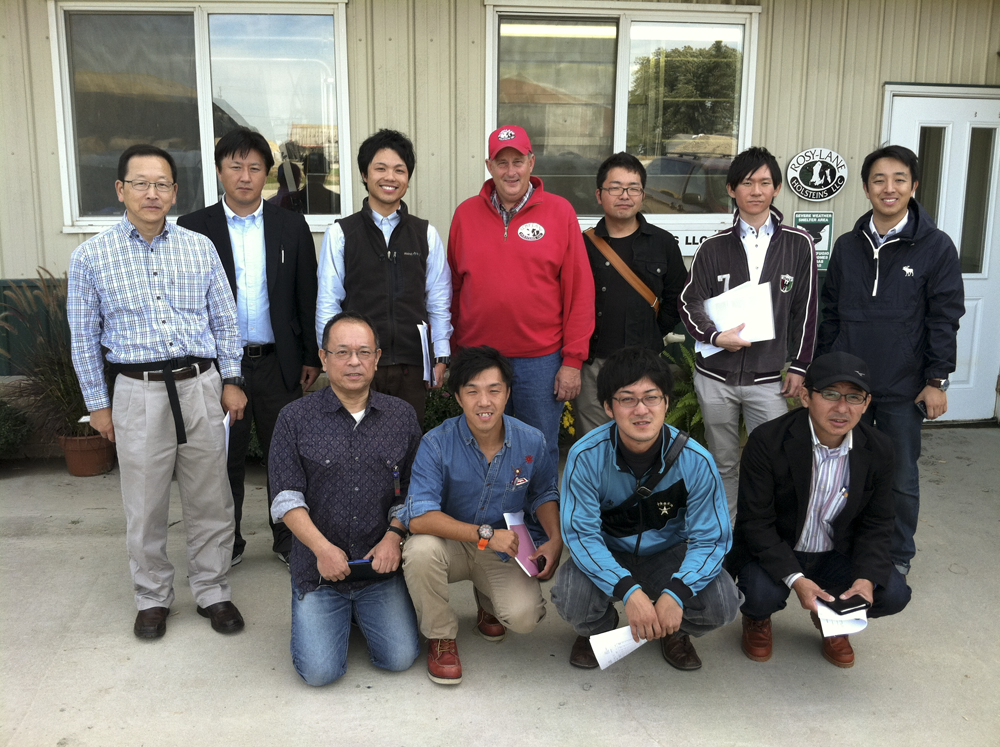
Strong Agvocates, Rosy-Lane Holsteins is frequently hosts tours from local schools to producers from around the world.
Rosy-Lane Holsteins. Unqualified Success! Unclassified Too!
When you first learn that Rosy Lane does not classify their herd, it seems counter-intuitive to what many traditional dairy breeders would consider necessary. Lloyd, as expected, has a well-reasoned explanation of their choice. “We participated in Holstein’s classification program for many years but it became increasingly clear that the program’s return on investment was negative. Cows that are tall, narrow and refined are generally scored higher than shorter, wider, heavier cows. Worse yet, the “shorter” cows are penalized on dairy form and udder depth because they are short and carry some condition. We had a majority of these “shorter” cows, and we found they far outlived their higher-scoring herd-mates while having less foot problems and better fertility. The classification program definitely punished Oman (we had about 550 of his daughters in our herd at any one time).” Returning to the businesslike approach that is the backbone of their success, Lloyd gives supporting examples. “Our farm runs on economics, and Oman was a bull that helped make our business profitable: 3 on calving ease, more live calves and fewer problems at 1st calving. Number 1 NM$ for several years. High DPR. Great foot health and Low SCC.” Rosy Lane made the logical, for them, choice. “It became obvious to us that scoring our “shorter” cows was as a waste of money. Looking back, that decision to stop classifying should have been made much sooner because a business should only consider long-term profit and viability, not how high individual cow scores are. Functional cows with good health, good feet and legs, balanced udders and high milk production make money.” Always able to clearly explain the decisions that have built Rosy Lane, Lloyd is well-prepared in explaining what is needed for successful cattle breeding. “To maximize profits in the future, modern cows will need to:
- Produce more MARKETABLE milk (less cows dumped)
- Breed back in 1 or 2 services
- Resist mastitis
- Hold components at peak production
- Produce more live calves and
- Calve younger to reduce rearing costs
In 2013, we marketed 1.69 lbs. milk for each 1 lb. dry matter TMR fed. This can’t be achieved if there are problems at calving such as mastitis, DA’s, ketosis, and rampant lameness. From Jan. 1, 2014 to May 8, 2014 (128 days) we had 75 days when no cow was treated or dumped so 100% of the milk harvested was marketed. While this may be common on small herds, we milk 800-830 through our double-12 parlor 3X a day, achieving 94 to 100 lbs. milk average per cow per day.” With no apologies, Lloyd sums up their success, “We feel our genetic program is a central part of achieving these numbers.”
Breed Cows for Profitability
There are always clear goals for the future. “Daughters of Dean, Monarch, Supersire and Cabriolet will be flushed soon from the home herd. They were selected because they are high NM$ with the balance of traits we are looking for: Fat, Protein, DPR, SCC, CE and moderate stature with good strength.” He is enthusiastic about impending successes. “With our daughter Lauren, we purchased a Mogul x Freddie over 900 NM$ from Don Bennink and transferred 15 JoSupers recently. She is a very balanced heifer. We didn’t use Mogul ourselves and she had good CE and DPR.” (Rosy-Lane recently had the #2 high seller, Rosylane-Llc Oak 7276 the #23 gTPI female in the breed,who sold for $176,000 at the Day at the Derby Sale)
Over and Under: “Use ALL the Tools. Set your Benchmarks.”
| ROSYLANE GENERAL BREEDING STRATEGY | |
| We sort by Net Merit FIRST | |
| Then Discriminate Against Bulls Over | Discriminate Against Bulls Under |
| +2.0 Stature | 850 NM$ |
| 8.0 Calving Ease | 50# P |
| 2.8 SCC | 60# F |
| +1 DPR | |
| +5 PL | |
Lloyd continues. “Then we try to find unrelated bulls for our female population. This is the general strategy and exceptions to the above are made. ABS helps us from time to time with their computer inbreeding program.” He outlines bulls that Rosy Lane has used. “Manfred, Oman, Ramos, Shottle, Freddie, and Jeeves have been most successful for us. And now Bookem & Gonzo on 2-year olds. By increasing accuracy, we are able to select flush animals and recipients. We are now able to correctively mate for health traits, along with production traits, and correct any shortcomings on individuals more aggressively, such as those with low DPR or high calving ease.”
“We Use Genomics For Impact”
Genomics has greatly increased selection accuracy and given the industry the chance to find both health trait genes and, on the other side, avoid detrimental haplotypes. We can also find badly-needed outcross bulls more quickly. The timing coincides with consumers who are demanding less drugs/hormones be used, so we now have better tools to produce the kind of cattle that have lower “health care” costs. In our herd, genomics gives us more options to reduce inbreeding and select for superior health traits earlier.”
Lloyd reports on sire usage. “Genomic sire usage: Supersire, Cabriolet, Rodgers, JoSuper, Dean and Halogen. Why? They meet our sire criteria and can be used across the herd. We didn’t use Robust; we use his sons and grandsons. Planets are not holding up for us in the long run so we are trying to reduce his influence to some degree. Proven sire usage: Freddie. Why? Our best young cows are Freddies. They calve easily, have great F&L, low SCC and high components. Overall, they are very trouble-free. “
At Rosy-Lane, they are also well aware of the success being achieved by other dairy breeders and are careful observers of what they term influencers from afar. Lloyd reports that they closely watch the programs through genomic lists for the following herds/prefixes:
- De Su
- Cookie Cutter
- Welcome Stock Farm
- Spruce Haven
- Coyne
- Bush Bros.
- Hendel
“Imagine The Perfect Rosy-Lane Cow!”
Far from being afraid of the future, Lloyd welcomes the challenges. “The trend toward larger operations will continue, driven by higher tax rates. Our capitalistic system is increasingly becoming a ‘winner take all’ (not necessarily a bad thing). Genetics will become more important because in the end it is the most cost effective long-term solution to reduce costs.”
Never one to wait for the future, Lloyd already has imagined the perfect cow. “Imagine a cow that calves easily like an Oman, has a disposition like a Shottle, breeds back like a Ramos, milks like a Planet and has the immune system of a Duster. In our herd, feed efficiency would improve quickly from 1.69 to 1.78 and we would make tremendous genetic progress with the ability to PICK our culls. This concept has been nearly lost on the Holstein genetic ‘community’. And then people wonder why commercial dairymen crossbreed or switch to Jerseys. If we don’t get with it now, Jerseys’ market share will soon be 50% and North American Holsteins (yes, Canadian Holsteins too!) will have to compete on cost only and may go the way of the Guernsey. Is this where we want to go?”
“Follow your Passion. Don’t Follow the Herd.”
Regardless of the area of dairying that is giving you challenges, you can learn a lot about solving problems from Rosy-Lane Holsteins. Despite the ‘rosy’ farm prefix this operation never chooses to wear rose-colored glasses. Of course, the day may come when everyone unites with a common vision for a sustainable and profitable dairy industry. “When that happens” you might suggest, “perhaps even Rosy-Lane will follow the herd. Wrong!” Lloyd Holterman points out, “That sheep-like mentality only works if it meets your profitability goals. Dairying is a business.”
The Bullvine Bottom Line
Lloyd Holterman gives heartfelt advice to young dairy hopefuls. “Do what you have a passion to do, if you haven’t found it yet – keep looking!” Trying to imitate someone else’s passion is a sure way to be unsuccessful. However, he cautions those who have encountered hurdles “Don’t blame others if you fail.” Whiners and complainers are rarely at the forefront of innovation and success. It’s your life. Your future. Seek out the positive. Rosy-Lane Holsteins has excelled at dealing with negative circumstances and people. “Listen to the naysayers and do just the opposite!”
Get original “Bullvine” content sent straight to your email inbox for free.
![qs[1]](https://www.thebullvine.com/wp-content/uploads/2014/04/qs1.jpg)
Beginning in Barcelona
Quim and his brother Jaume were raised on the family farm Mas Comas Novas, La Guixa in Barcelona. Their father, Ramon, was a cattle dealer who enjoyed the buying and selling but wasn’t interested in breeding animals. When the boys were only 12 and 14 they made a decision that would eventually bring them to where they are today says Quim. “In 1984 Jaume and I decided to keep the best cows and breed our own herd.” They give credit to their mom and dad. “From our parents we learned the love of farming, good cows and cow competitions. This was a tremendous opportunity and we owe a lot to them for allowing us to take this responsibility at such an early age.”
 Trying a New Angle
Trying a New Angle
Twenty years later it was time for another new beginning. “In 2004 I started my own company Triangle Holstein.” Quim highlights how the name corresponds to the business. “There are three different business areas: the livestock business, the semen business and the show business.” For each specialty area Triangle Holsteins provides customized service. Like other visionary business men he feels that one-sided expectations of yourself and others could hold them back from reaching their individual breeding goals. “We work closely with the farmer to give professional and personal service tailored to their specific needs.” Quim values his early business experiences. “Many years ago, I had the opportunity to work for a big company and it was great. I always had the goal of forming my own company.” He points out how it has been. “Working for myself gives me a lot of freedom and satisfaction. I am responsible for my own decisions. Sometimes good. Sometimes wrong.” But undoubtedly, he has learned from all sides of the story.
A Three-Way Perspective
The Triangle Holstein breeding philosophy is one that starts with genetics but is carried out through careful management. “Triangle Holsteins is focused on the best North American cow families and conformation traits are the number one priority. Nevertheless, I never forget production and health. The management of these key priorities is the key to making an animal be successful.” Quim knows that in cow terms there are three important areas. “Nutrition, exercise and comfort make all the difference.” These three combined with kindness are what he calls his “silent” partners. If those are the three main steps to caring for the animals there are also three characteristics that Quim feels all breeders must have in their personality. “This process requires breeders to be stubborn, patient and enthusiastic all at the same time.”
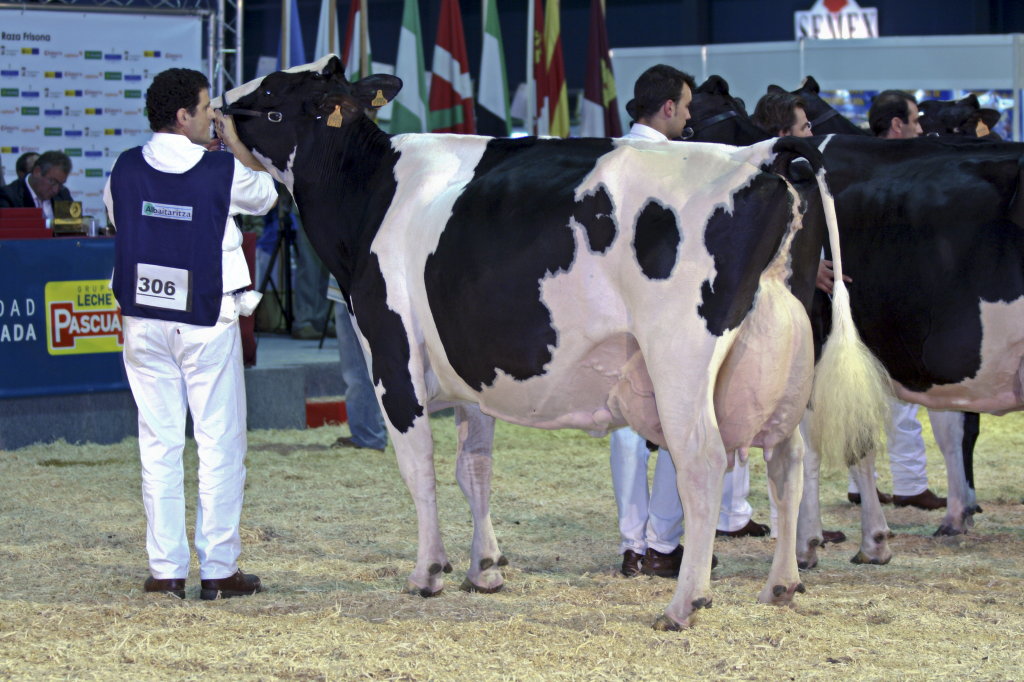
Pachecas James Gretta
3 time Spanish National Champion
Three Triangle Love Stories
It isn`t surprising to learn how many animals this Triangle Holstein breeder singles out. “There have been three special animals in Quim’s life.” He starts of with one from his youth. “Comas Novas Dibbs Inspiration was our first Champion cow when I was a teenager. She was a white dairy character cow, all quality from the head to the tail.” The next one stands out for special reasons too. “My second favorite cow is Pachecas James Greta. She was strong, with a big frame and a fantastic udder. Greta was my longest project working with a show cow and she is the one that won many shows in Spain.” The third memory maker for Quim holds a unique space for Quim.” Regiment Apple will always stand out for me. We came together many years ago, during the first time I was working in Madison for Mike Deaver who is one of the best cow men that I know. At that time Apple was 2 year old.”
![31578_1422821484608182_1599892698_n[1]](https://www.thebullvine.com/wp-content/uploads/2014/04/31578_1422821484608182_1599892698_n1.jpg)
Regiment Apple will always stand out for Quim. They came together many years ago, during the first time Quim was working in Madison for Mike Deaver, at that time Apple was 2 year old.”
Three Part Marketing Vision: Farms, Shows and Facebook
No matter where you are in the global dairy industry, you are marketing your herd with each contact you make, whether it`s face to face, in cyberspace, hard copy or in the show ring. Quim Serrabassa once again uses a multi-pronged approach. He outlines his methods. “On one hand I go every two weeks to France to select and buy commercial animals for my customers. My customers are breeders like I used to be, so I always feel very responsible for the cows I pick.” Quim never tires of searching out these animals. “I select them one by one, and this is one of the things I like the most. I walk to the field or to the barn with the intention of finding that special one. Sometimes they don’t start out looking that way. I will find one, usually dirty, with no foot trimming, never clipped … but finding her is a magic moment.” He especially likes it when a selection he makes goes on to do well. “Sometimes you can take her to the show ring. Another time you recognize her doing fine in her new home.”
The second point of Quim’s marketing is very much based on shows. “I like going to shows because it is the place where I meet my customers and I can feel the pulse of the market and hear about their needs.” Quim enjoys breeding for show cows. “My favorite sires for show cows are: Absolute-Red, Delta & Atwood.” But he doesn’t over look dairy cow sires. “For dairy cows I use Explode, Cashcoin, Carson and Deman.” His understanding of the show ring has been well developed over the years and he has gained recognition as a cattle judge. “Judging is one accomplishment I am very proud of. I never expected to have the opportunity to be an Associate Judge in Madison beside Brian Carsacadden and then later in Laussane beside Mike Deaver.” Both of these judges rank high for Quim. “In my opinion they are the best.” (Read more: CARSCADDEN: The Royal Footsteps)
Word of mouth has always been a great way for the dairy industry to market itself. Today dairy friends, peer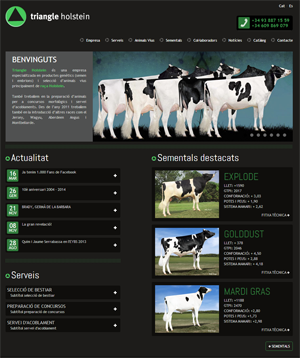
Marketing and Genomics
In today’s marketplace rapidly changing tools are having a tremendous effect. Quim looks at Genomics and how it has affected his operations. “Genomics has changed the semen market a lot. For our company it was a great opportunity to start with. Genomics provides opportunities for everyone. The market is now global no matter where the bull comes from or who the owner is.” Of course having the tool and knowing how to use it is the challenge. Quim seeks balance. “Now we have some genomic information that we can combine with cow family and traditional knowledge. It is the mix and the balance between the new information and the traditional knowledge that will move us forward in the right direction.” If there is a downside to genomics for Quim, it is related to the speed of change. “Today the genetic market moves too fast. We hardly have time to appreciate and enjoy the cow family as a group.
Work, Work, Work
Quim points out that there is a lot of hard work to make your dairy business. “You have to be satisfied about the things you do every day and try to keep yourself surround by the people that challenge you to grow.” He knows that everything isn’t always perfect. “This is a job that you have to believe in. Do not expect big things and always enjoy the small details that life gives to you.” As happy as he is with Triangle Holstein, Quim sums up his accomplishments from his own unique angle. “My biggest success is my family.” Very eloquently he points out that this is where he finds his strength. “Especially when show time is over and the bright lights are off.”
Get original “Bullvine” content sent straight to your email inbox for free.
![56250[1]](https://www.thebullvine.com/wp-content/uploads/2014/03/562501.jpg)
“Targeted Milk Production. Exceptional Show Performance”
Production attracted Anton Ender to Holsteins and it remains the highest priority. “At the outset they have to be productive.” says Thomas who outlines the Ender breeding philosophy. “We always select for productive cows that last. They don’t have to be the big time producers in their first lactation, but they do need to get better every year.” He zeroes in on how this is done. “The key to achieving this goal begins with great conformation and especially well attached udders.” Of course this has produced great looking animals and a very successful side effect in the success that they have had in the show ring. “We really like to show cows, but never bred for it. Production is the first priority.” Having said that, Thomas acknowledges that the show ring is important to the dairy operation. “The biggest part of our marketing is the participation on the Shows. With this success behind us, it is a great opening for marketing your genetics through the Internet, sales or on a private basis, because the link to the buyer has been created.”
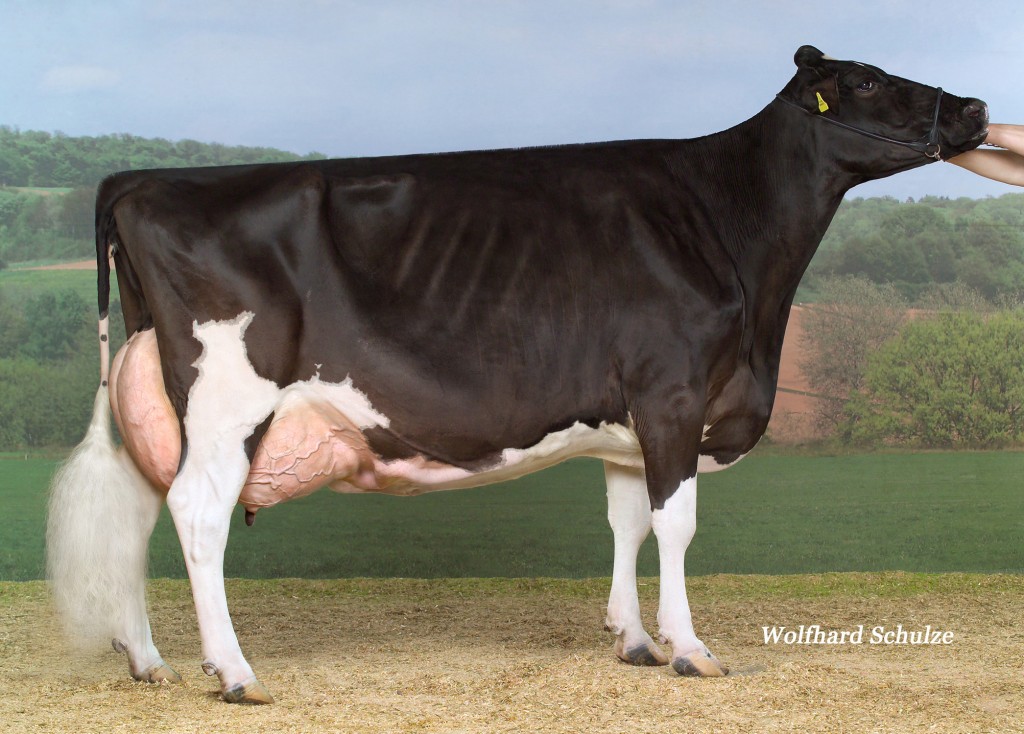
Hellender Juror Jurgolin EX-92-CH 6E 11*
Supreme Champion & Hon Ment Best Udder Brunegg ’11
1st at the Swiss Expo in ’08 and ’09 & 3rd in ’11
Dam to COLIN (s. Champion) @ Swiss Genetics! #4 Swiss ISEL Bull (12/12)
Dam to the Hon. Mention Gr. Champion Swiss Expo ’11: CALANDA
Jurgolin is in 8th lactation and already over 110.000 kg milk lifetime production!
She has 1 EX-94-2E dtr, 1 EX-94-3E dtr and 1 EX-95-3E daughter!
Picture in 7th lactation
Small Steps. Big Success Now and in the Future.
There are always special animals that rise to the top of individual breeding programs and for Hellender Holsteins it was the Jurgolin Juror cow family. “Without any doubt the greatest cow we ever had and still have the pleasure to work with is Hellender Juror Jurgolin EX-92 6E GM 13*. She keeps impressing us with her own performance as she has already produced 125000kg of milk with really high components. Furthermore she twice topped the production cow class at the renowned Swiss’Expo.” Such achievements would make any breeder proud but Jurgolin is leaving a legacy as well. “The best thing about this hard working, zero problem cow is her progeny. Already 3 of Jurgolin’s daughters are classified EX-94 and EX-95 and there will be more great young cows to come.” Adding strength on the sire side is another achievement for Jurgolin. “Her son is the former N°1 bull in Switzerland and was sold out in a record time period.” Thomas explains the decision process that led to this success. “The mating was chosen to increase the production of her dam by Dixellen Design, which had really high components. Also could she have had a tighter attached udder but had excellent feet and legs, which made Juror a great mating sire for her.”
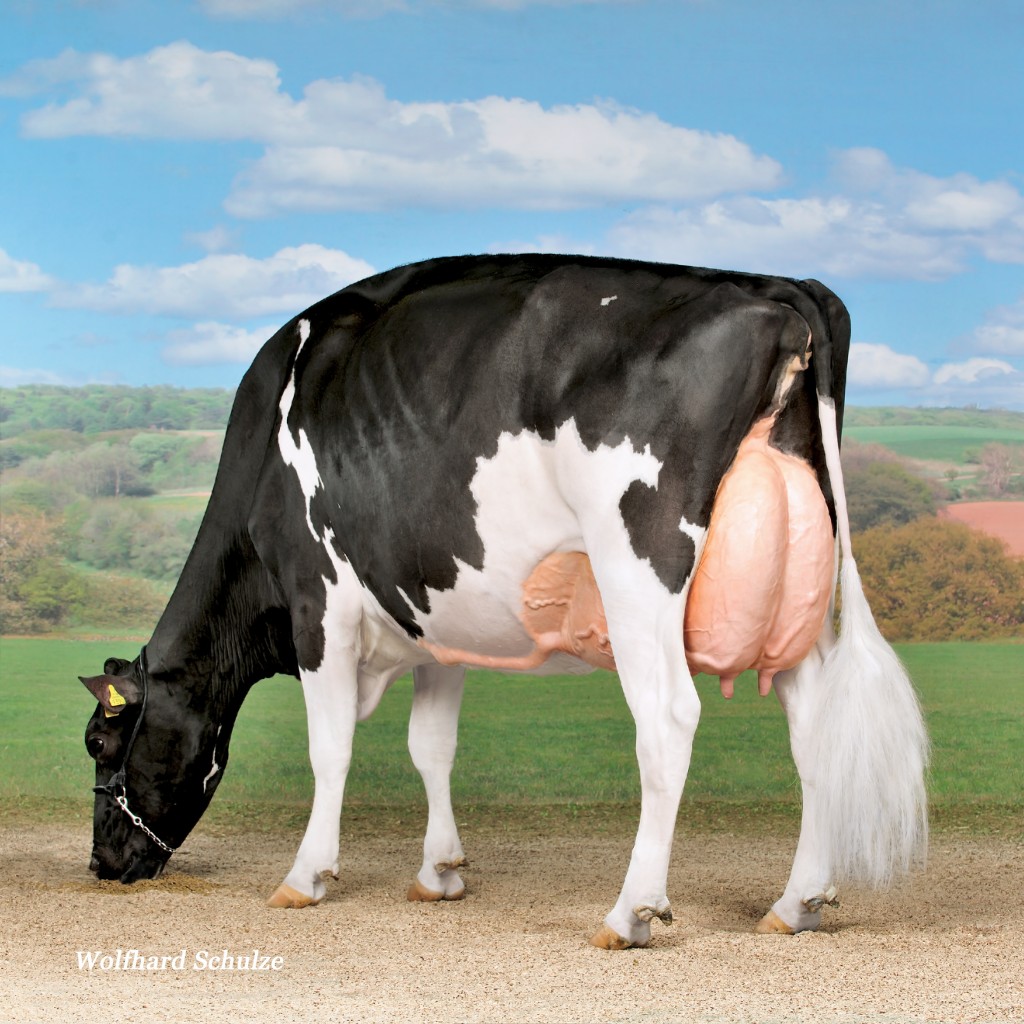
Hellender Champion Calanda EX-95-SW 3E
1st & Hon. Mention Champion Swiss Expo 2010
1st Swiss Expo Lausanne 2013
Supreme Champion Elite Show Brunegg 2010
1st National Expo Bulle 2010
Champion x Hellender Juror Jurgolin EX-92-SW 6E
Combined owned by: J. & C. Rey, P. Deru & Hellender Holsteins
From a Small Start to Grand Successes
It is quite clear to see that, despite the traumatic cause of their start into Holsteins, Hellender building an outstanding herd. Thomas outlines current breeding lines. “Right now we are still working with the foundation cow of the family, Juror Jurgolin. But we also are building through her daughters by Champion and Goldwyn. The next generation of great ones will come up through the Dempseys and a Knowledge out of the Champions and a Hvezda with RC as well as a Windbrook straight out of Jurgolin.” The shine on the future is also being fulfilled in the show ring. “We own two milking Goldwyns out of Vangoh Durham Treasure EX-96 3E that have been really successful in the showring and that are fresh with their second calves and ready to be flushed. Treasure caught my eye being late maturing and showing a perfect udder already as a young cow.” New purchases are showing possibilities too. “We just purchased the Top Seller of the Riedmuellers Holstein Complete Dispersal, Bolton Chantal VG 2y, a show winning daughter out of Champion Cresta then Durham, Encore, Cinder and Tony Rae EX-96. This bull dam has a very high production in a great mammary system and shows us lots of potential in the show ring as well. Thomas modestly identifies the Ender family’s blossoming success. “I think we consider our greatest accomplishment is that we started with a herd of 25 cows and have been able to develop a successful cow family whose progeny is doing well in France, Germany, Austria, Italy, Denmark and Belgium.”
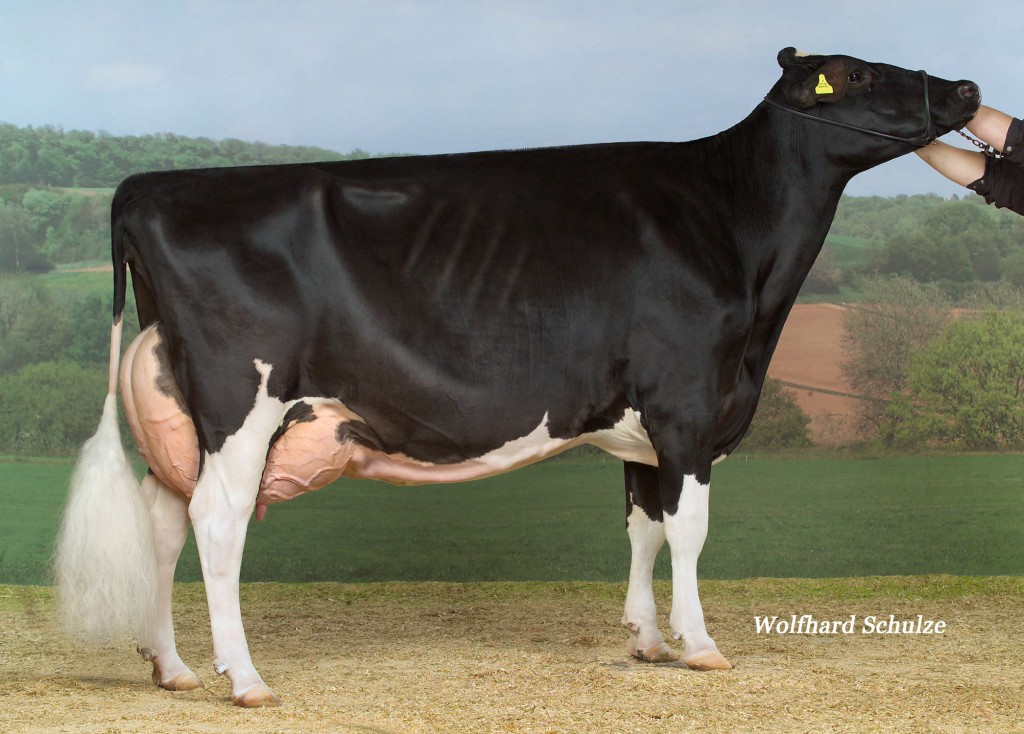
Hellender Champion Corina EX-94-SW 3E
Supreme Champion Argovie-Expo 2013
1st & Res. Champion & Best Udder Brunegg ’11
1st Expo Bulle ’09 and 3rd Expo Bulle ’11
3rd Swiss Expo Lausanne ’09 and 3rd Swiss Expo Lausanne ’13
Supreme Champoin & Best Udder Elite Show Brunegg ’09
Supreme Champion Luga Luzern ’09
1st & Res. Jr. Champion Elite Show ’08
Swiss Holsteins Cow of the Year ’14
Champion x Hellender Juror Jurgolin EX-92-SW 6E
Sire Selection
“We like security in our breeding program, so for the breeding part genomics hasn’t affected us as much.” Having said that he adds this caveat. “It is harder to sell a bull out of a great cow family if you’re not in the race.” He therefore outlines the Hellender sire selection philosophy.” The majority of the bulls we used are daughter proven because with a small herd we prefer a proof with more security and prefer not to experiment with young genomic bulls. At the moment we are using Atwood, Aftershock, Seaver, Sid, Observer, Dorcy and still Champion. On the genomic side we’ve been using Destined, Airintake and Lingo. All of these bulls transmit good milk production in great udders.”
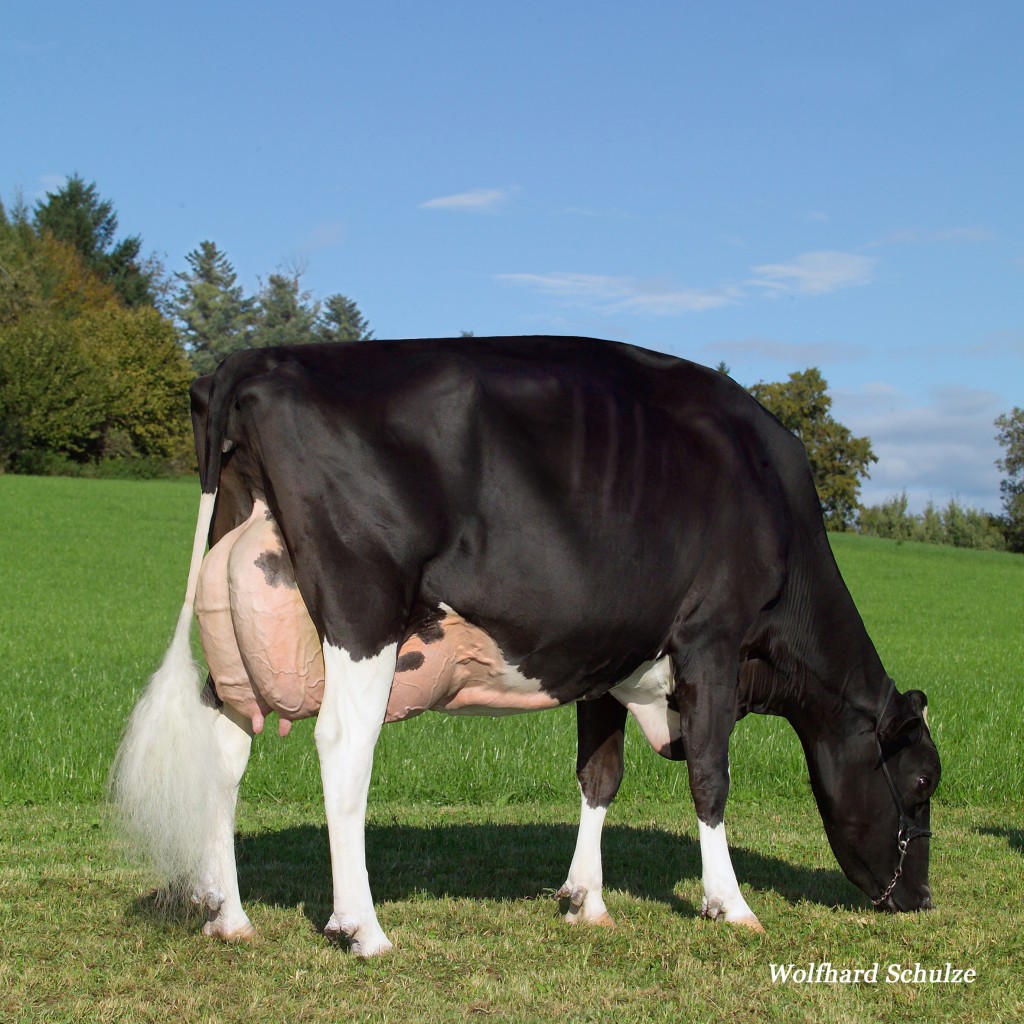
Hellender Champion Cortina EX-94-CH 2E
4th Swiss Expo ’09 & 3rd Swiss Expo ’10
4th National Expo Bulle ’10
2nd & Hon. Mention Champion & Res. Best Udder Brunegg ’09
Champion x Hellender Champion Cortina EX-94-SW 2E
“Little Things Make a Big Difference”
Perhaps the easiest way to understand the Hellender breeding philosophy is to look at in the context of their home country. Thomas agrees pointing out, “I think the biggest difference is size. Everything is smaller in Switzerland: the farms the machinery and the herds. This opens the opportunity to do a more individual mating for each animal. At the end this helps to increase the level of the average. We are really happy about the fact that size doesn’t matter as much as it used to in the past. A middle sized, well balanced cow with a great udder often gets a preference towards the big framey cow. For us this is the key to longevity. Do some wise investments in great cow families that reflect your breeding goal right at the beginning and go from there. Embryos I think are a good opportunity to acquire top genetics at reasonable prices. And be hard on the selection of your own animals, this makes you move forward with the right genetics over the years.”
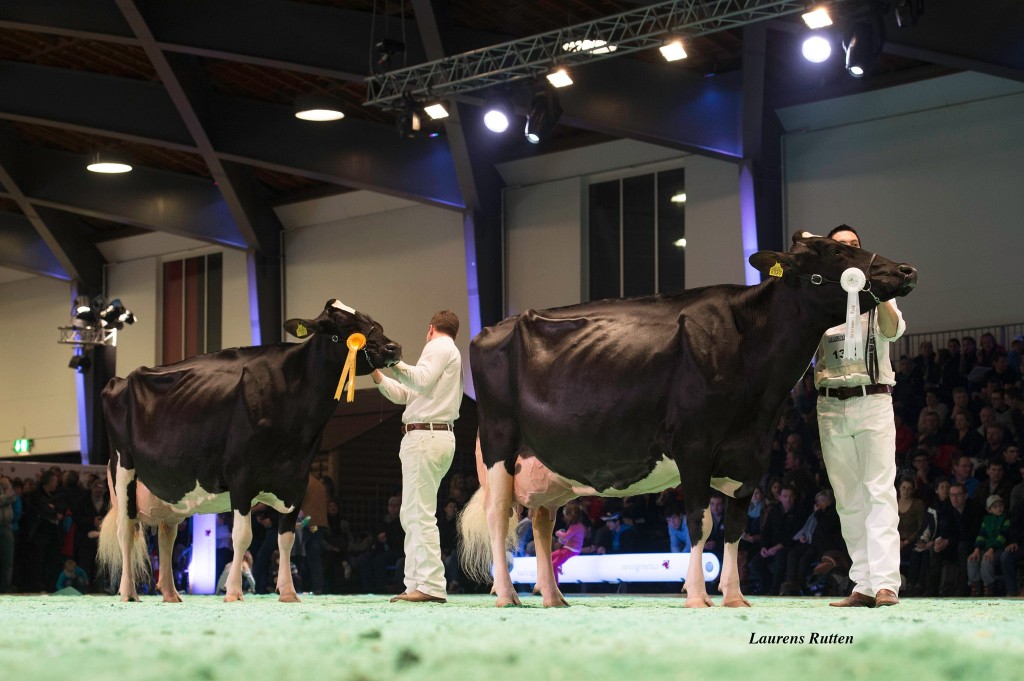
Calanda and Corina are 3rd and 4th in the production cow class at the recent Swiss Expo
“No Matter How Small You Start Out, You Should Always Dream Big”
The Enders are reaping the success of staying true to their vision. The history of this small herd attests to the success that a focused breeding philosophy can generate. In 2014 Hellender Champion Corina EX-94 was named Swiss Holstein Cow of the Year. (Read more: Hellender Champion Corina – Swiss Holstein cow of the Year!) This daughter of Hellender Juror Jurgolin has several show ring victories and has been 3 time Supreme Champion in Switzerland with multiple outings at the Swiss Expo in Lausanne. Another Jurgolin daughter, probably the most famous of them all is, Hellender Champion Calanda EX-95 3E. She was Honorable Mention Grand Champion of the 2010 Swiss ‘Expo. Of interest also, is that several sons of the Jurgolin daughters are in AI. With all this success, there are many who admire the achievements of Hellender Holsteins. In advising other breeders how to follow in their footsteps, the Enders encourage dairy breeders to stick to their goals and learn from the best. “It is important to have an open mind and always be willing to listen and learn from good cowmen.” The Hellender Herd has benefited from that mentoring and Thomas gives a personal example, “For me the person I look up to is Callum McKinven. I admire him not only as a breeder full of passion but because he made it possible for me to see new opportunities. I learned much during my stay at his place and in times with him after.”
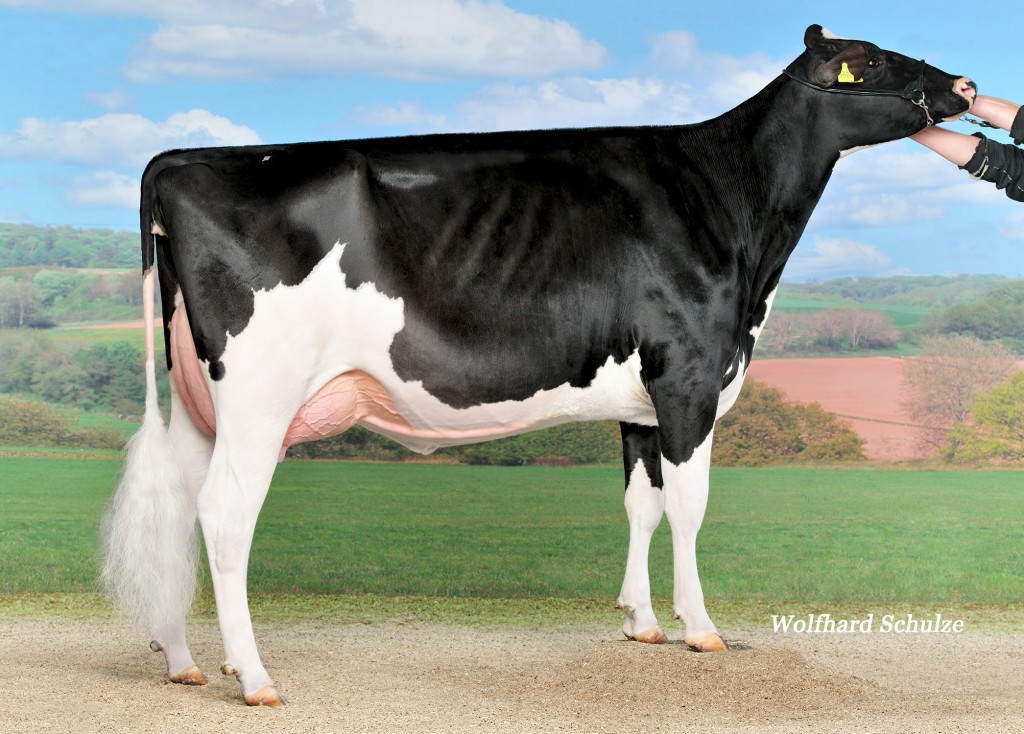
Hellender Goldwyn Griffen NC
Goldwyn x Hellender Juror Jurgolin EX-92 6E GM 13*
3rd place Swiss’Expo Lausanne 2014
4th place Swiss’Expo Lausanne 2013
2nd place and finalist Junior Expo Bulle 2012
The Bullvine Bottom Line
There are many great examples to use as role models and it isn’t surprising that many of them have gone the route of big herds, big facilities and big investments. For the Hellender herd the focus wasn’t on size and numbers. It started with strong emphasis on milk and built from there. With scrupulous selection they have certainly achieved quality in both milk production and in the show ring. Congratulations to Hellender Holsteins for being an example of how a small herd can be managed to achieve remarkable success.
Get original “Bullvine” content sent straight to your email inbox for free.

Joined in the family dairy by his four sons, Marc, Louis, Vincent, and Mathieu and their families, achieving the best is exactly what the Patenaude family has done. Master Breeder shields, All-Canadian awards, Class Extra Sires, World Record Producers, Canadian and International Cow’s of the Year, they have achieved it all. Of course this success does not happen overnight. Neither did it come easily. For Gilles Patenaude and his family, their hard work has led them to breeding one of the best dairy herds in the world.
Dr Patenaude, a dentist by trade, practiced for 40 years then retired in 1996. Becoming a dentist was a lifelong ambition for Gilles who had dreamed of it since he was 5 years old. Nevertheless becoming a dentist would not come easily for Gilles. You see he was dyslexic and that made it very challenging for him in school. Fortunately for young Gilles he was also very competitive and his desire to be the best at whatever he did would help him overcome these challenges. He was a boxer, swimmer and wrestler while attending University of Toronto. His time at University also taught him another important lesson in life. In order to become a dentist he had to make many financial sacrifices and learn the difference between merely spending and investing. This lesson has paid many dividends over his career.
The mark of an impactful life is made, not through the achievements you collect, but rather by the legacy you leave behind. For Gilles, that legacy is represented by his and Lorette’s four sons – Marc, Louis, Vincent and Mathieu. Eldest son Marc is in charge of the field crops and fieldwork and he has two boys Eric, who is heavily involved in the marketing of Ferme Gillette, and Martin. Louis, the public face of Ferme Gillette, looks after the farm’s elite genetics herd plus marketing. He has three children, Paul, Amelia and Camille, who are all very involved in the family operation. Vincent is responsible for the large commercial herd and his wife, Dr. Christie McLeod, is a veterinarian and they have two daughters, Rachel and Danielle. The youngest of the brothers is Mathieu who is responsible for machinery and accounting. With wife Adela they have two young sons, Jonathan and Stephane.
Like Gilles’ personal road to becoming a dentist, the road to success for Ferme Gillette was certainly not an easy one. In 1994 tragedy struck when the Patenaudes sustained a fire that killed 205 cows and destroyed their main free-stall barn and milking parlor plus the show barn. Fortunately a key survivor was Gillette Blackstar Christiane (VG-88-17*), who rose from the flames and ashes of the blaze to go on to win Holstein Canada’s Cow of the Year in 2000. This would be the third fire to occur at Ferme Gillette. In 1970 a fire destroyed the barn, and a second fire in 1980 killed a few head of cattle and damaged the buildings. As Dr. Gilles pointed out, they just kept on going “Because we love it”. Therefore, I was not surprised when the Marcus family of Woodstock recently lost their herd to fire, to learn that it was Dr. Gilles’ son Louis was one of the first to reach out to Clarence, and share their support and experience to help them. We are happy to report that the Marcus family is well on the way to milking again by summer.
The list of accomplishments for Dr. Gilles Patenaude and the team at Ferme Gillette is exceptional. Here are some highlights:
- 1878 Dr. Gilles Patenaude’s grandfather settles on farm at Embrun, Ont.
- 1958 Dr. Gilles Patenaude buys family farm from his father and replaces dairy herd with beef cows.
- 1960 The Patenaudes switch back to dairy cows and begin with purebred Holsteins. Dr. Patenaude joins Holstein Canada, using prefix “Gillette”. Taken from his and his wife’s first names.
- 1970 Fire at Ferme Gillette.
- 1980 Fire at Ferme Gillette.
- 1981 Farm incorporated as La Ferme Gillette Inc. Gilles and Lorette Patenaudes’ four sons – Marc, Louis, Vincent and Mathieu – become partners in the farm with them.
- 1985-86 Ferme Gillette makes purchases in Bond Haven Dispersal, Hanover Hill Dispersal, Sunnylodge Top 40 Sale, Cormdale Dispersal and Cormdale High Index Invitational Sale to enhance genetics in their herd.
- 1990 First La Ferme Gillette Sale in April sees 102 head sell for a total of $1,029,950 and an average of $10,097 making it highest herd sale for year in Canada. Startmore Merrill ET, Canada’s number one indexing cow, tops sale at $500,000 and is highest selling animal of year. At the time, she is the third highest selling milking female ever sold in Canada. The Patenaudes had purchased Merrill as a calf for $63,000 in the 1986 Cormdale High Index Invitational Sale.
- 1991 Hanoverhill TTA Roxie sets world record for protein in 365 days of 817 kg.
- 1992 Ferme Gillette partner with the recently deceased Hardy Shore to host Visions ’92 Sale in August. The sale averages $10,600 on 41 head, highest of the year. (Read more: Hardy Shore – Shormar Holstiens – Obituary)
- 1994 Fire destroys dairy barns and 205 head of cattle at Ferme Gillette on November 22nd. The Patenaude family begins to rebuild. One of the few animals to survive was the “miracle” cow, Gillette Blackstar Christiane (VG-88-17*), who would go on to win Holstein Canada’s “Cow of the Year” award in 2000. Gillette ties as leading owner of Honor List producers.
- 1996 After 40 years Dr. Gilles Patenaude retires as a dentist, giving him more time to enjoy the farm. “Dentistry was really my fulfillment in life,” he says.
- 1997 Gillette Visions ’97 Sale averages $7962 and grosses $1,337,675 on 168 head in November, making it best sale of the year. Skys-The-Limit Claire tops sale at $275,000 and is highest selling animal for the year. Gillette Carlton, son of Maeford Starbuck Chrissy (Ex-17*), becomes their first Class Extra bull. The Patenaudes will eventually breed nine Class Extra bulls, eight with the Gillette prefix, along with 22 Superior Type and 10 Superior Production bulls. The Patenaudes purchased a first choice from Gypsy Grand by “Wade” at the 1997 RockyMountain High Sale. When it came time to make their selection, however, Louis Patenaude was so taken by the “Storm” daughters from Gypsy Grand at Braedale that he asked if he could chose one of them instead. Second Cut was soon on her way to Ferme Gillette
- 1998 Three cows make Canadian champion production records – Gillette D L Bonbon, 2-year-old Total Performance and protein champion; Calbrett Valiant Ruby, 10 years & older protein champion; and Gillette Jed Pandora, yearling Total Performance champion (and briefly fat champion). Gillette is runner-up for leading owner of Honor List producers.
- 1999 Gillette Brilea Belle Fleur is Canadian champion for Total Performance, milk and protein in yearling class for Ferme Gillette and Brilea Holsteins. Belle Fleur had several sons in A.I. The most famous was Gillette Brilea F B I (Ex-94-Extra), the popular “Mtoto” son at the Semex Alliance, who in turn is the sire of Gillette Windbrook (Ex-94-Extra). Ferme Gillette is number one Production Herd in Canada. Ferme purchases Windemere-Masmill Jellybean (Ex-90- USA-GMD-DOM-6*), a “Leadman” daughter. Purchased Jellybean as a 9-year-old cow from Jim and Nancy Kemp of Ohio.
- 2000 Gillette Blackstar Christiane named “Cow of the Year” by Holstein Canada. Her son, Renaissance Triumphant, is tied as Canada’s number one conformation bull in May. Braedale Second Cut becomes number one cow for fat in Canada in November. She would achieve this distinction four more times. Windemere-Masmill Jellybean is new Canadian fat champion in 9-year-old class. Ferme Gillette is runner-up for leading breeder and owner of Honor List producers. They earn their first homebred All-Canadian award on Gillette Rubens Dolcevita. Dolcevita was one of three animals owned by Ferme Gillette to win their class at the Royal Winter Fair. In February 2000 the bull jointly bred by Ferme Gillette and Brilea Holsteins, Brilea Gille Foreman (VG-Extra), claimed Class Extra. This “Skychief” son was purchased by United Breeders/East Gen. His dam was Quietcove Star Fanta-ET (VG-88-15*), a “Blackstar” from Quietcove Valiant Fawn (Ex-95-2EUSA- GMD-DOM-10*), the “Valiant” who was Reserve All-American 4-year-old in 1987.
- 2004 Gillette-I Durham Jericho is number one LPI Cow in November. She would repeat that feat in February 2005. Gillette Blitz 2nd Wind (VG-88-26*) topped the fall edition of the Triple Crown Sale as a recently fresh 2-yearold for $30,000 to Toshiaki Yamada of T-Wave Holsteins, Hokkaido, Japan, with Ferme Gillette retaining an interest in this valuable “Blitz” daughter
- 2005 Ferme Gillette wins Master Breeder shield. Gillette Blitz 2nd Wind heads LPI Cow List in August and then in November becomes first cow in breed to surpass +4000 LPI (+4066). She will eventually lead LPI Cow List six times, as well as being first for type four times and first for milk three times. Ferme Gillette is Premier Breeder at Expo-Printemps Holstein Quebec and Ontario Summer Show. Gillette James Cabrelle is Reserve intermediate champion at the Quebec Show and intermediate champion at the Ontario show. Cabrelle tops Sale of Stars at $180,000. Gillette-I Durham Jericho is overall leader on the Honor List. “FBI” became Class Extra on his first proof in May 2005. In 2005, the Patenaudes realized another of their goals…a Master Breeder shield.
- 2006 Ferme Gillette has top five cows on August LPI Cow List –2nd Wind, Zone, S Cut, Jericho and Second Cut. Second Cut is dam of the top three. Gillette ties as leading owner of Honor List Producers. Gillette Final Cut (VGExtra) became Class Extra on his first proof in May 2006. Sired by “Inquirer”, “Final Cut”is a son of Braedale Second Cut (VG-86-23*). A homebred “Dundee” daughter from the Spottie family, Gillette Dundee Sunshine (VG-89), claimed Reserve All-Canadian as a senior calf.
- 2007 Gillette Blitz S Cut is number one for milk in February and again in January 2008. Gillette has six cows in the top 10 of May LPI Cow List and eight in the top 13 in February. Gillette Dundee Sunshine (VG-89), claimed Reserve All-Canadian as a milking yearling. A granddaughter of Jericho’s by “Morty”, Gillette Morty Jerianne (Ex-95-2E), was Honourable Mention All-Canadian junior 3-year-old.
- 2009 Gillette Shottle 2nd List, Canada’s number one LPI heifer, tops RockyMountain High Sale at $140,000 and becomes second highest selling bred heifer for all-time in this country. Ferme Gillette is Junior Premier Breeder at Kemptville Championship Show and wins both junior and reserve junior champion rosettes. Gillette S Planet 2nd Snooze (VG-86-2y) sold for $75,000 in the 2009 Sale of Stars to T-Wave. Gillette Miss Damion (VG-88), 2009 All-Canadian senior yearling.
- 2010 Ferme Gillette tops both the LPI Bull and GLPI Cow Lists in August with Gillette Jordan and Gillette Bolton 2nd Sleep, respectively. 2nd Sleep was also number one GLPI cow in April. “Jordan’s” brother, Gillette Jerrick is number seven, the first time in history identical twins, who are the result of embryo splitting, rank in top ten. In December, “Jordan” remains number one bull, while Gillette Windbrook is tied as number one bull for conformation. “Windbrook” becomes Class Extra following in the footsteps of his sire, Gillette Brilea F B I, who was Class Extra in 2005. Gillette E Smurf becomes new Canadian champion for lifetime milk production with 206,934 kg. Gillette is leading breeder and owner of Honor List producers. R-Z Baxter Caramel-ET (VG-89-2y-DOM). This “Baxter” daughter was purchased for $100,000 in the 2010 Matriarchs of the Breed Sale in Wisconsin by Ferme Gillette, Ferme Maryclerc Inc., Ste-Claire, Que., A. & R. Boulet Inc., St-Francois, Que., Olivier Leclerc, St-Patrice-de-Beaurivage, Que., and Dany-Pierre Rondeau, Fortierville, Que. She is backed by four generations of Very Good or Excellent bull mothers whose sire stack includes “Goldwyn”, “O Man”, “Durham” and “Juror“. With the introduction of Genomics Caramel would see extreme popularity as a bull mother.
- 2011 Three sons of Gillette Blitz 2nd Wind rank in top five of LPI Bull List in April, with “Windbrook” at number two and Gillette Wildthing and Gillette Willrock at number five. “Wildthing” and Willrock”, a pair of identical twin bulls from a split embryo, are the first progeny proven sires to receive identical genetic evaluations based on a pooled group of daughters.
- 2012 Gillette Blitz 2nd Wind would earn Canadian cow of the year, International cow of the year, and Bullvine’s Golden Dam honorers. ( Read more: 2012 Golden Dam: The Results are In!) Gillette Emperor Smurf EX-91 earns a Guinness Book of World Record as the most prolific milk producer in the history of dairy cows. (Read more: World Records Are Not Only Set at the Olympics) Gillette Visions 2012 sale averages $11,900 with Ralma-RH Manoman Banjo topping the sale at $131,000. (Read more: Gillette Visions 2012 Sale – Great People, Great Cattle = Great Results!)

Smurf receiving a special award from MP Grant Crack
The Bullvine Bottom Line
Life is never boring at Ferme Gillette. There are so many things happening there. But from now on the absence of Dr. Gilles will be hard for the entire team. His love for details and hands on efforts from fixing fences to keeping the farm esthetically pleasing will be sorely missed. While Dr. Gilles had stepped aside for his sons and the next generation and had moved from leading to guiding the team, he certainly left his impact on the family and, by extension, on the dairy industry as a whole. Dr. Gilles was extremely proud of the fact that “All my family is happy with what they are doing.” From the entire team here at the Bullvine, our sincere condolences go out to the Patenaude family. As a breeder, friend and family man Gilles always sought excellence and, in so doing, lived his dream. Gilles Patenaude was simply the best.
Get original “Bullvine” content sent straight to your email inbox for free.
It’s with great remorse we announce the passing of Dr. Gilles Patenaude after a battle with bone cancer at 84 years old. They say the greatest measure of a man is not the work you did but the impact on people you leave behind. Just like some of the legendary sires they produced at ferme Gillette, Dr. Gilles has left a lasting impact on the world and will be missed by all. Dr Gilles is survived by his wife Lorette and their four sons Marc, Louis, Vincent and Mathieu and their families. (Read more: Dr. Gilles Patenaude – “Simply the Best”)
The Gibson Family of Junction City, Oregon was recognized with the Community Service Award from the Oregon Dairy Farmers Association (ODFA). Amy Peters, recently retired from OSU Extension in Coos and Curry Counties, received the ODFA Distinguished Service Award at the Annual Oregon Dairy Farmers Convention in Salem on February 25.
The Gibson family has been involved in Oregon agriculture for nearly 75 years. Their local community and the industry as a whole, has benefited from their leadership. The Gibson family has made sustainability a priority. They installed the first U.S. low temperature methane digester in 2010, and since then have installed solar panels at their processing plant and at 14 Dari Mart stores. These renewable energy projects have helped the Lochmead operation reduce its carbon footprint by 15% of the average footprint of U.S. milk, while producing electricity for the greater community. They produce 85% of the feed used on their dairy farm and all of their milk is sold within a 35 mile radius.
At Lochmead, their family’s passion for local, sustainable living extends beyond the farm and plant and into their community. Together with their 45 Dari Mart stores, they have made contributions to a number of local organizations including the American Cancer Society (Relay for Life), Children’s Miracle Network, Food for Lane County, Meals on Wheels, Habitat for Humanity, Serenity Lane, Sacred Heart Riverbend and Birthing Center, and various youth programs over the years. To help ensure a thriving future for agriculture, members of the Gibson family have served on multiple committees and boards: Oregon Dairy Products Commission, Oregon Beef Council, Oregon Dairy Industries, Southern Willamette Valley Ground Water Management Program, Lane County Farm Bureau, Junction City school board and the Chamber of Commerce.
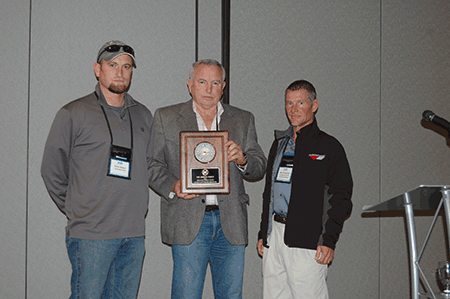
After receiving the ODFA Community Service Award, Buzz Gibson said, “Thanks on behalf of the entire Gibson family, we are pleased to be recognized for our efforts. Our family has made it a priority to be responsible with the environment, to reduce our carbon footprint and to give back to the community.”
Amy Peters received the ODFA Distinguished Service Award for her 20 plus years working with Oregon livestock producers on the South Coast and throughout Oregon. Amy has conducted one-on-one trainings and seminars including Liming on Coastal Pastures, Soil Fertility and Management, Proper Milking Procedures, Calf Management, Maximizing Forages, Grazing and more.
Mike Miranda, ODFA board member and dairy producer in Coquille was involved in nominating Amy for the award. Mike said “Amy has always been so helpful, if you ever have a question, she will do her very best for you. It could be about pastures or anything, you always knew that you could ask Amy for help and she was there for you.”
In addition to working with dairies, Amy has been a member of the Oregon Cattlemen’s Association, Oregon Sheep Growers Association, Coos County Farm Bureau and served on the Oregon State Weed Board. She is active in her community with local sports teams, even going so far as to give rides to kids for practices and games. Amy is always there to lend a hand. ODFA was very pleased to award their Distinguished Service Award to Amy Peters.

Keeping 50 cows happy and comfortable so they give more milk is an important part of Andrew Campbell’s job on the Strathroy dairy farm where he lives with his parents and own young family.
Old MacDonald had a farm. But that straw-hatted hayseed is as scarce as hen’s teeth nowadays.
The modern MacDonald could be a woman, a twenty-something or an urban escapee. Just as likely to wield a smartphone as a pitchfork, modern farmers network with the folks they feed and serve as advocates for agriculture.
“Agvocates” even pose with their critters for calendars and photos of themselves (“felfies”). And picture this: Britain just held a contest to find its sexiest male and female farmer.
Different from their predecessors, yes, but Ontario’s reinvented farmers still share common ground with that old guy in overalls.
Andrew Campbell
Keeping 50 cows happy and telling the world beyond the barn about it is all in a day’s work for Andrew Campbell.
The dairy farmer tweets, blogs, makes videos and posts regular reports on a website he started called “dinner starts here.” “People are so much more interested in knowing about food and where it comes from,” he says. “And farmers are making more effort to say, ‘this is what I did today.’ ”
Contented cows give more milk, says Campbell, noting their output is helping support three generations of one family. The 28-year-old works and lives with his parents, wife, newborn son and 2-year-old daughter on the family farm in Strathroy, just west of London.
Three-quarters of his day is devoted to his four-legged charges; they eat off ceramic tiles and sleep on comfy beds in a clean, airy barn. The rest of the time he looks after the business side of the operation, which includes 162 hectares of feed and cash crops.
With a focus on the future, Campbell pays close attention to finances.
“You have to be in it to make money or you can’t be in it,” he says of farming. Currently in a partnership with his parents, he and wife Jessica will eventually take over.
Despite growing up on a farm, Campbell never aspired to a career there. He studied journalism for three years then worked as a radio broadcaster. But the call of the cows drew him back to the farm four years ago.
It’s a great place to raise a family, he says. “And it’s a pretty cool way of making a living, between being with the animals, working the land and being your own boss.”
Lorraine Schmid and Lori Aselstine
It was love at first scent for Lorraine Schmid.
“I went to help with the chores,” she recalls of a visit to a dairy farm years ago. “I started smelling the cows, then the hay and manure, and I just fell in love with it.”
But it was a long road to full-time farming for the Toronto landscaper who only four years ago took up permanent residence at Thyme Again Gardens, the weekend home she bought in 1997 in Prince Edward County, a two-hour drive away from Toronto.
The plan was to grow plants for her business, but those barnyard aromas inspired a new goal of creating a sustainable organic farm. So she got chickens, then sheep, beef cattle, Berkshire pigs and pets.
Five years in, she met partner Lori Aselstine, a civil servant who’s retiring this year to spend more time on fencing, maintenance and animal care.
With livestock, a large organic vegetable garden and 50 hectares of pasture and feed crops, they should have had their hands full. But they expanded their operation to include a bed and breakfast, wellness services, a community shared agriculture (CSA) program for Toronto residents and annual farm days for visitors.
“One year we had 25 people who organized themselves into crews and cleaned the winter manure out of the barn,” says Aselstine. “They thought it was great fun.”
In their mid-50s, neither partner has any background in farming but both love animals and feel drawn to the land.
“We’re reverting back to the very old farm of the past, where we’re not mechanized or industrialized farmers,” says Schmid. “I’m so happy I fell into this.”
Charles Stevens
There are times when Charles Stevens calls out the big guns to protect his produce. In fact, the 60-year-old grower credits his four-metre hail cannon, which fires sound waves 40,000 feet up so positive ions can prevent hailstones from forming, with saving a $400,000 apple crop.
Stevens relies on an arsenal of high-tech tools to grow the best and most fruit possible on his apple and blueberry farm in Newcastle, less than an hour east of Toronto.
There’s the GPS-piloted tractor that communicates with 17 satellites to mow grass and plant trees in a straight line; a sonar-equipped sprayer that targets specific branches; and a self-steering, adjustable platform on wheels for picking and pruning, a task Stevens does on a ladder in the winter. On a smaller scale, farm managers carry iPhones with apps to monitor the weather.
“Risk management is huge because we’re working with Mother Nature,” he says, noting that innovation along with regulation, global warming and globalization have dramatically changed the industry.
When he started Wilmot Orchards 37 years ago, he planted 630 apple trees per hectare. Today, thanks to smaller, more prolific trees and efforts to maximum the sun’s efficiency, it’s 2,267.
Stevens and his wife, Judi, grow wholesale apples on 34 hectares. Another nine hectares are planted with blueberries for a pick-your-own operation managed by their 25-year-old daughter. At peak season, the farm employs 30 people.
Both university graduates — Judi has a master’s degree in agricultural economics — the couple says they often dispel visitors’ “misconceptions and fears” about food production.
Growing fruit isn’t all high tech. They use nature to fight nature with biological pest controls, and a falconer whose hawks scare away berry-eating birds at picking time.
Source: The Toronto Star
Vieux Saule checks off many points on what could be described as a pre-flight checklist for an excellent Cow of the Year Nominee. It all started eleven years ago. Her birth in March of 2002 put her at an ideal age for a 4-H calf in 2003 and, in that year, she took her caretaker Jimmy Perreault all the way to second place in the National 4-H show and 5th at The Royal Agricultural Winter Fair. That was just the beginning. Vieux Saule Allen Dragonfly and her progeny propelled Vieux Saule Holsteins to Master Breeder Status in 2009 and lifted them to recognition as a world supplier of elite genetics. (Read more: Vieux Saule Holstein: Rooted In Family Values)

VIEUXSAULE ALLEN DRAGONFLY EX-94-2E-CAN 14*
NOM. ALL-CANADIAN 4-H JR.1-YR 2003
2 Superior Lactations
Dragonfly’s Pedigree Gives Her Wings
Great cows like Dragonfly come from careful constructive breeding by dedicated breeders. Not only is Dragonfly’s dam Excellent, but so too were her fifth, sixth and seventh dams. These were the bookends and in between were high-classifying two year olds by Charles, Astre and Tab. A close look at Dragonfly’s dam, Vieux Saule Outside Mary Sol EX95-3E 4* reveals great performance. She classified EX95 3E and completed 4 Superior Lactations, one of which was a Super 3 Lactation. Mary Sol has a 4* Brood Cow rating. In the show ring, she was 1st Mature Cow at the 2012 Rive Nord Exposition, after having been 1st Senior Two Year old ten years earlier at Beauce. Here Dragonfly’s pedigree brings persistence and performance together. It is repeated on the sire stack side as well where Dragonfly’s sire stack is loaded with bulls that Canadian breeders hold in high regard. These bulls are Allen, Outside, Charles, Astre, Tab, Elevation and Arlinda Chief.
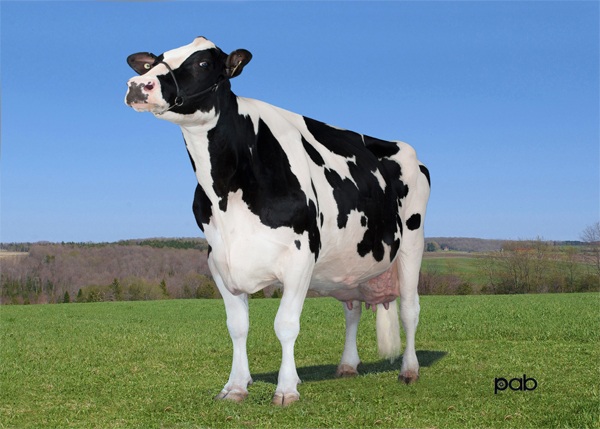
VIEUXSAULE OUTSIDE MARY SOL EX-95-3E-CAN 4*
1ST MATURE COW RIVE-NORD EXPOSITION 2012
1ST SR.2-YR BEAUCE 2002
2ND MATURE COW RIVE-NORD EXPOSITION 2007,2009
1 Super 3, 4 Superior Lactations
Dam of Dragonfly
Dragonfly’s Performance in the Barn Also Soars
As mentioned earlier, Dragonfly was a 4-H calf in 2003 and went all the way to becoming Junior Yearling. That was only the start of her high performing career.
Her classification scores are a steady progression from high to outstanding.
- July 2004 VG86-2yr
- February 2005 VG87-2yr
- October 2005 VG88-3yr
- September 2007 EX91-5yr
- January 2008 EX93-5yr
- August 2008 EX94-6yr
- August 2009 EX-2E
Dragonfly was also filling the milk pail at the same time as she was being extensively flushed.
Dragonfly’s Progeny are Flying High
Vieux Saule Allan Dragonfly has earned a 14 Star Brood Cow rating. She has 93 progeny. The majority are in Canada, with some in the US, Czechoslovakia and Germany. Dragonfly had two Excellent, three Very Good and two Good Plus Sons that have been used as private herd sires.
Thirty of her Canadian daughters, by eleven different sires, are an impressive group: 1 Excellent, 21 Very Good, 6 Good Plus and 2 Good. Their average BCAs are high and stand at 245-266-248. Five daughters have at least 1 Superior Lactation. Eighteen of Dragonfly’s daughters were Very Good as two year olds. No matter which sire Dragonfly was mated to, she produced quality daughters.
Dragonfly’s highest classifying daughter is Vieux Saule Modest Cleopatra EX90, with one Superior Lactation. Cleopatra herself as one daughter who has also earned one Superior Lactation.
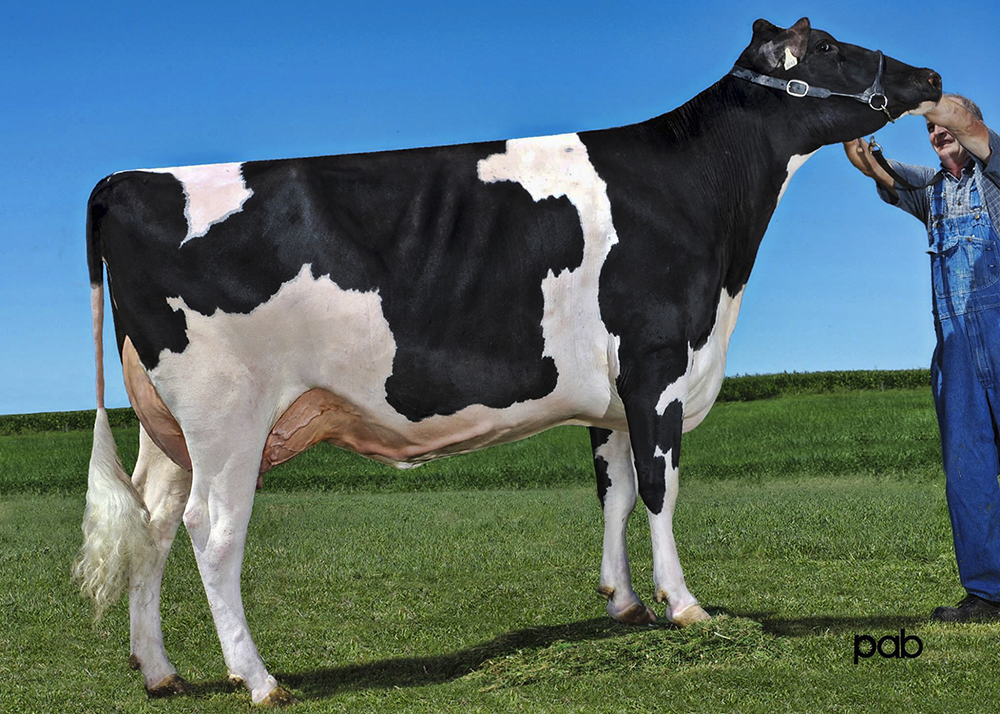
VIEUXSAULE FREDDIE FELICIA VG-2YR
GPA LPI 2973 DGV 2991 GTPI 2286
Her son Vieuxsaule Flame is the #1 GTPI Genomic Young Sire at + 2561
Dragonfly’s highest gLPI daughter is Vieux Saule Bolton Halia VG87-2yr 2*. Bolton Halia’s production record at 1-11 (305D) was 11,912 kilos of milk, 4.7% fat, 3.5% protein, with BCAs of 317-399-348. That also makes Halia Dragonfly’s highest production daughter. Halia has six very high gLPI Freddie daughters. The top Freddie is Felicia VG85 gLPI 3166. Felician has a UNO son, Vieux Saule Flame who, at one time, was the #1 gTPI genomic sire.

VIEUXSAULE BOLTON HALIA VG-87-2YR-CAN 2*
Bolton X Dragonfly
Another superior Dragonfly daughter is Vieux Saule Toystory Haley, a VG85 2yr 2*. Haley has a VG85 2yr Man O Man daughter Haydie with a gLPI 3061. Haydie’s outstanding production record is 2-03 (305D) 17,341kilos of milk, 4.5% fat and 3.3% protein with BCAs of 437-523-451 and almost unheard of BCA deviations of +202 +275 +215. These are seldom seen records.
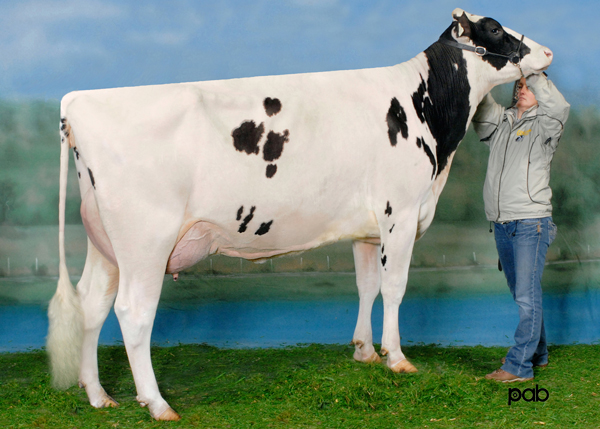
VIEUXSAULE TOYSTORY HALEY VG-87-5YR-CAN 2*
Toystory x Dragonfly
Vieux Saule Dragonfly was on an extensive flushing program and has many daughters born in 2012 and 2013 by bulls such as Goldwyn, Aftershock, Goldchip, Sid and Dempsey. She provided the takeoff for a cow family that will continue to soar high on the wings of her high achieving progeny.
The Bullvine Bottom Line
Although the Cow of the Year competition shines the spotlight on one individual, we are inspired by all of them. Each of the nominees is a winner in her own right simply for rising to this level. Over the past few days we have had the opportunity to get to know the nominees better. Obviously they are all worthy of cheering on to the finish line. Who is your pick for 2013 Cow of the Year?
Please like and share if you think Dragonfly should be the 2013 Canadian Cow of the Year!
The Cow of the Year nominee booklet which includes a resume on each finalist and a voting card will be mailed to Holstein Canada members in the February-March 2014 Info Holstein. Voting options include mailing the postage-paid, tear-off voting ballot; faxing your ballot; emailing your vote to cowoftheyear@holstein.ca; or voting online from a confidential Holstein Canada online account.
Get original “Bullvine” content sent straight to your email inbox for free.
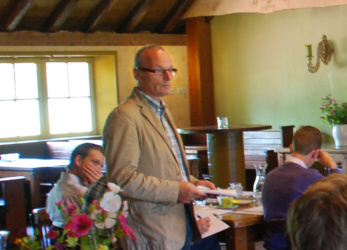
This is the early motivation that first inspired Bram Prins to look to agriculture as a career. However, three decades later he is still passionate about dairy farming and more importantly how it can continue to grow and be profitable. On February 5th he will share his enthusiasm, experience and insights as a keynote speaker at the 2nd Annual Canadian Dairy Xpo in Stratford Ontario. If you’re looking for a “day off” this is the exact place to get recharged and revitalized for the year ahead. Building on the resounding success of last year’s inaugural event, Canadian Dairy Xpo 2014 organizers have put together a tremendous diversity of products, experts and entertainment in one place at one time (Check out the full Canadian Dairy Expo program).
Bram Prins: Lifelong Learning and Worldwide Classroom
Despite his early involvement on the Groningen farm, Prins, now sixty-two, doesn’t consider himself to have an agricultural background. However he provides further explanation. “I do not have an agricultural background, but as farmer I do have a wide scope of interests.” This compelled him to lifelong formal and informal expansion of his studies. “Until last year I undertook training every year and earned minors and training at Nyenrode Businesss School.” A further source of agricultural edification came through many years of involvement with agricultural interest groups. “From 1985 till 2002 I was member of different boards, mainly feed and milk, in the agricultural sector.”
Prins Consulting
From this growing background Bram was prepared to set up a business group. “In 1990 I was the founder of European Dairy Farmers and in this position I travelled a lot around Europe and collected different data, information and knowledge.”
Twelve years later, Bram decided to leave as President of EDF and started working for Wageningen University. “I began by developing and giving training in a team of Entrepreneurship.” Since that time, he has given trainings in more than 6 different European countries in Interactive Strategic Management.” His interest in problem solving kept him busy too. “I worked also as advisor for individual farms in special topics including mediation, succession and financial management.” His growing expertise became sought out and he has expanded outside the private sector. “More and more my work includes governments in supporting or coaching farmers in special situations such as outplacement, solving difficult situations etcetera.”
Global Dairy Farmers
In 2005, this intense building of expertise was the foundation for Bram to start Global Dairy Farmers http://www.globaldairyfarmers.com. In 2004 he was joined by another colleague and started one year later GDF In 2009 Elise Bregman started working for Bram and became Manager of GDF. Prins is financially responsible for 100% of the company.” Bram is enthusiastic about the need for a business such as the one in inaugurated with Global Dairy Farmers. Here is someone who is unique in being eager to work on the problems faced by the dairy industry. “I am always looking for solutions to impossible situations and building relationships based on trust.” Bram outlines the core values of GBF. “We are focused on Global Dairy Farmers, rural development and entrepreneurship.” He points out the international growth that has taken place. “This has led to coaching farmers both inside and outside the Netherlands.”
Facing Challenges. Feeding the World.
The challenges faced by dairy producers have a special place in the heart of the President of GDF. Bram sees feeding the world as the number one challenge facing the dairy industry. At the same time, the industry itself is facing globalization. This raises the reality that today milk prices are becoming more equal worldwide. Dairy producers need to become excellent managers. After that, the biggest challenge facing the industry is the one of fulfilling the wishes of the consumer. The producers must accept and deliver what the consumer values.
Think Like An Entrepreneur
As Prins watches the changes that take place internationally, he is especially convinced that dairy producers must think more like entrepreneurs. Worldwide the influence of farmers as a political group is declining. The industry must face the reality that there is much less financial support from governments. Having said that he recognizes that farm business operation is evolving. “In some places dairy farming is just like normal business already. Especially in the new upcoming milk regions where backward integration is usual already.” Prins sees further globalization of milk production including, “in the long run in Canada.”
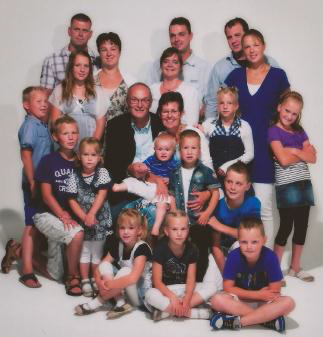
Bram Prins has 3 children and 14 grand children
The Future Marketplace
Bram’s global perspective sees new ways that will differentiate dairy producers since eventually it will no longer be by price only. He sees that culture, climate and growing conditions will have an impact on competitiveness in the dairy marketplace. Infrastructure will be of prime importance to the sustainability of the dairy industry of the future.
Best Advice for 21st Century Dairy Producer
Prins encourages dairy producers to think big and see the total picture. “You must look beyond the farm gate and be aware of what is happening worldwide in dairying and in other agricultural sectors too.” Bram has personally observed, trained and advised dairy stakeholders on the necessity of being market oriented, thinking value-added and dealing with price fluctuations. “If you look at the increasing influence of the market, I believe the next major challenge will be the creation of added value; in my eyes, the step towards sub-flows within dairy production is a logical next step.”
Always Pro-Actively Moving with the Changing Times
When confronted with the issue of globalization, many of us sit back and stress out asking “How bad are things going to be?” Bram Prins urges the dairy sector to pay attention to three evolving areas. “Dairy producers must address the issues relating to sustainability, animal welfare and pro-active communication. “The latter issue especially causes Prins to urge “It is a necessity to build bridges between producers and consumers.” Unfortunately, another of the trends of the industry one that Bram points out.”There is a lack of farmers and qualified labor.” While this is a reality, he also sees the potential solution. “We will see growth of the size of our farms with the help of automation.” Expanding further on this side Prins also sees it applied directly to cow management. “We are coming to a cow approach based on ICT in the growing herds.”
The Bullvine Bottom Line
Bram Prins is a dairy industry futurist and is dedicated to serving the dairy sector and looking for innovations, trends and new farm systems. Global Dairy Farmers is committed to identifying problems and finding solutions through discussion, research, projects and strategic studies. Bram Prins recognizes that “Developing future scenarios is one thing: implementing them is another matter.” Bram hopes to share and inspire a value-added vision of the dairy industry on Thursday, February 6th at Canadian Dairy Xpo 2014 where he will speak on the creation of Global Dairy Farmers and the top 4 insider global dairy trends that every producer needs to know. “It’s the perfect place to get leading edge feedback and encouragement about dairy perspective in the 21st Century and the challenges and opportunities that await us. Be inspired by Bram Prins at the Maizex Dairy Classroom and you could go home from your “day off” with a solution that’s “right on!”
Want to learn more about the top 5 insider global dairy trends? Bram will be presenting at Canadian Dairy Expo on February 6th.
Valedoorn Farm in British Columbia’s Fraser Valley is a family farm. Tom Hoogendoorn is proud of that designation and how it motivates their family’s business philosophy. “We put a great deal of effort into quality of life for our families and employees.”
This passionate dairy ambassador is set to share his enthusiasm and expertise as a panelist at the 2nd annual Canadian Dairy Xpo in Stratford, Ontario on Thursday, February 6th. If you’re looking for a “day off” this is the exact place to get recharged and revitalized for the year ahead. Building on the resounding success of last year’s inaugural event, Canadian Dairy Xpo 2014 organizers have put together a tremendous diversity of products, experts and entertainment in one place at one time (Check out the full Canadian Dairy Expo program).
This Family is Positive about Moving Forward
Tom and Gail Hoogendoorn own Valedoorn Farm with Tom’s brother John and his wife Lan. For the Hoogendoorn brothers it was a logical progression. “My brother and I were born into the dairy industry. Our father died while we were still in high school. At that time I was 17 and John 15 and we worked on the farm with our mother from 1979 till 1987 when we purchased it. We have slowly expanded our land base from 47 to 200 acres and rent another 110 acres making corn and grass silage and currently have 260 cows and 260 young stock. We employ 3 fulltime staff including my nephew Alex. We also have several part time staff.” The sadness that touched their family in the end has had a positive effect on how they live their dairy lifestyle. “Having our father die early made us realize that every day should be meaningful and enjoyable if possible.”
Optimal Care. Optimal Efficiency. Open Doors.
High standards are also applied to every area of the dairy operation. All of the Valedoorn cattle are registered and classified. “We optimize efficiency in every area of our farm whether it is getting heifers pregnant or getting the most out of our crops.” The benchmarks they have reached record their success at targeting measureable goals. “Currently BCA’s run between 245 to 255. Pregnancy rate runs around 30 percent year over year. We ask our cows to milk a lot of milk but try not to push the grain too hard relying on our forages to do the job.” There are many fine details of cow management that must be optimized and when it comes to herd health, they can truly be said to be aiming to put their best foot forward. “Hoof care is a huge part of our management practice. We want our cows walking comfortably and happily to the feed bunk! This is huge!”They also ask a high level of commitment from themselves and staff. The doors are open to everyone. “We have a modern dairy setup that is camera or visitor ready every day or night. This “open door” policy is opening minds too as people come to Valedoorn. “People are always very surprised on how well the animals get treated.”¦It’s a real eye opener, when they come to the farm, to see how clean it is. We’re really proud of that fact and that’s why we never turn tours away.”
Both Cows and Bulls Must Meet Strategic Performance Parameters
The philosophy of consistent improvement also applies to the dairy genetics of the Valedoorn herd. “Our breeding goals are to have every cow classify 80 pts or higher. We want average sized cows with a will to work standing on great feet and legs with pleasing udders. This has resulted in 75 percent GP or better with us having bred 5 Excellent cows in the last number of years including a Throne who just calved for the 8th time who is 5E 92 Pts. We love good cows who give us no trouble. We work with Alta and Derek Flaman who picks the parameters and chooses the bulls. All breeding is done with their breeding guide. We do use some sexed on heifers and choose bulls for health traits udders and legs. We also like dairy strength.”
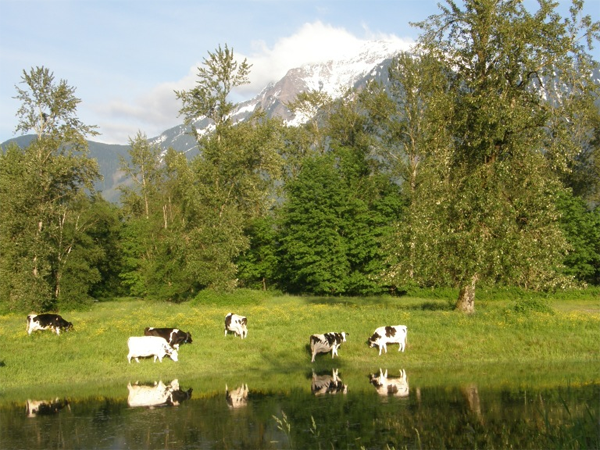
The view from Tom’s kitchen window
Canadian Dairy Farming from the Global and Local Perspectives
Tom`s interest in dairy farming spans local, national and international issues. Locally Valedoorn must always be alert to changing pressures. ““Challenges currently facing me are getting enough land in our area to farm and the start of succession planning. In Canadian terms he recognizes the unique challenges. “Dairy farming in Canada is different than other parts because of quotas. We are well organized as an industry and can affect change for our own well being. That is a two edged sword as it sometimes breeds complacency and an attitude of entitlement. We have to work hard to keep our system and be responsive to consumer demands. In the industry it’s trying to keep our Supply Management system whole and working for every farmer large and small in every region.”
RELATIONSHIPS: Run the Business. Grow the Business. Transform the Business.
The first priority and one that’s harder and harder to meet is a personal one, “For me it’s getting enough time to spend with the family.” Having said that Tom acknowledges that all the time spent is a main reason that the family farm has been in the family for 34 years. “That’s a great accomplishment arising from constantly expanding our land, cows, quota, and barns.” The family, the farm and the business is constantly changing with three main priorities. “The family working together. We are always meeting the goals we set. We continually set new goals to move us forward.”
Tom has seen many changes in the dairy industry and it has affected his approach to dairying. “Over the years the biggest change has been the size and efficiency of the farms. All our practices and methods are improving at least in the Fraser Valley where I live.” Looking back he is amazed at the progress. “There is a huge change in the quality of our cattle and the efficiency of our farms. It would have been unthinkable 30 years ago.” Once change that Valedoorn farms embraces is genomics. “Genomics for us mean better faster genetic improvement. Simple story. We are getting more info on cattle sooner and can use that for faster improvement. “
The proAction Initiative
Tom doesn’t shy away from the issues impacting the dairy industry. “We must acknowledge that the consumer and government are trying to get more involved with how we produce food in this country. We can’t ignore their questions and expect support from the broad public. People are curious about food since they are getting more and more removed from rural and farm life.” This has led to Tom becoming a spokesperson for exactly those concerns. The proAction Initiative is a way of showing our customers and consumers that we have improved the management of our farms over time. That we take responsibility for our on farm food safety, quality of milk, care of our animals, and care of the environment. We are doing things to enhance biosecurity to limit or prevent diseases from coming onto our farms. It’s going to be a way of not only telling our consumers that we are doing a good job but we will have a way of measuring and proving that claim. It will be a way of defending our best practices that we are implementing on our farms. Showing is better than just telling all the great things we as Canadian dairy farmers are doing in the area of sustainability.”
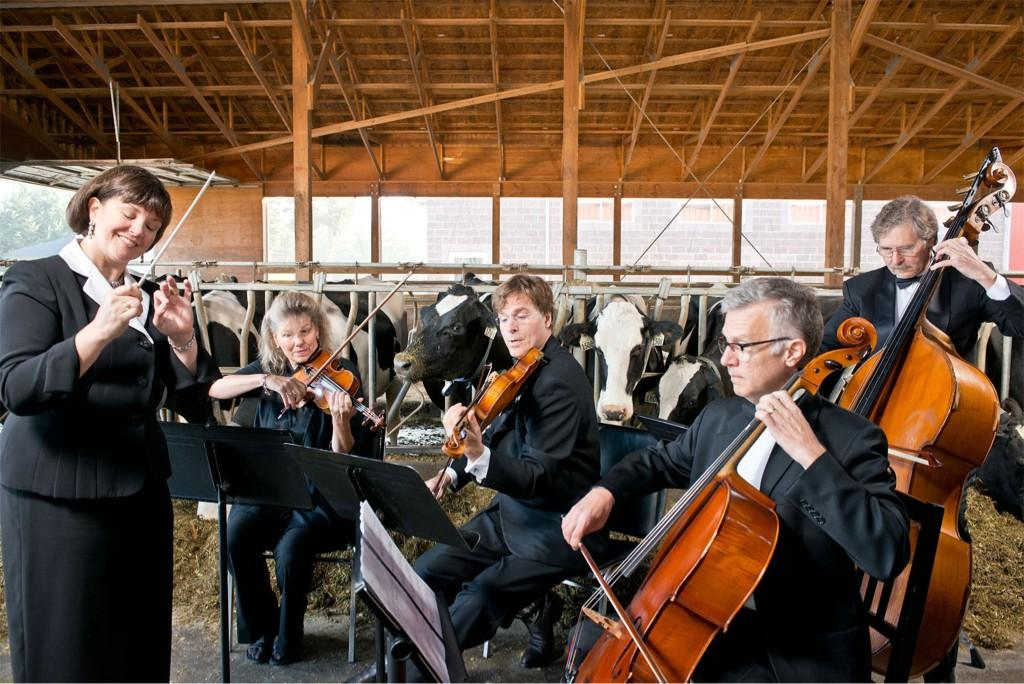
Classical music being played for the cows at Tom’s farm for the website musicmakesmoremilk.com
Opportunities Ahead. Raise Awareness. Hold office.
Tom encourages and in fact urges all farmers to get more personally involved and suggests that communication is the first step. “Farmers should be involved in social media just as they should be involved in their communities. It raises awareness and profile of our industry and hopefully creates a positive link to our consumers. Farmers can no longer sit at home thinking a few select people will move them forward. I always urge frustrated young farmers to organize and get involved and take a run at leadership in whatever form they think they may be effective or like.”
Tom endorses all forms of communication, including digital and once again doesn’t expect others to do something he doesn’t do himself. “Social media for me started as a way to connect with the running world. I run marathons and so on for a hobby and it was a good way to learn and interact. Soon I learned that it is a good tool for farmers to tell our story as long as it is done properly. While I was a Dairy Farmers of Canada board member, I started concentrating on that side of it. Social media for me has been a fun positive experience. You get out what you put in as most things in life.”
The Bullvine Bottom Line
Tom Hoogendoorn is fully aware that there are many different ways for farmers to set and meet goals whether it’s running a dairy operation or running a marathon. However, there is one characteristic that he urges everyone to embrace. “Never stop changing.” For Valedoorn Farm and the Hoogendoorn family that means working to move forward. Tom hopes your forward looking plans include Canadian Dairy Xpo. If you do nothing more than find an answer to a problem you’re working on or a make a new contact or get an onsite review of a piece of equipment, Canadian Dairy Xpo might solve or begin to solve your biggest dairy challenge and that means you will be move forward in 2014. Catch Tom Hoogendoorn`s enthusiasm and you could go home from your “day off” with a solution that`s “right on!”
Want to learn more about Toma nd the proAction Initiative? Tom will be presenting at Canadian Dairy Expo on February 6th.
![29f3b7f[1]](https://www.thebullvine.com/wp-content/uploads/2014/01/29f3b7f1.jpg)
Beauty and the Boss
Erica knows the value of setting early and focused career goals. “When I was 14 I started helping on my uncle’s commercial dairy farm.” That early experience inspired her educational choices. “I got really into it when I did my training in Italy at Castelverde Holstein for the Agriculture University at 18. With that foundation Erica risked an important new beginning in 1998, while still at University. “I started my company Livestock Show Equipment for importing show supplies. I wanted to use the products I had used in Italy and, at that time, it was hard to get these items.” Having identified the need and taking action, her future began to unfold.
Have “LIVESTOCK SHOW EQUIPMENT”. Will Travel.
Currently, Livestock Show Equipmenthas two complementary divisions. On the one hand, Erica sells show supplies throughout all of Europe and, on the other hand, she serves and inspires her business clients with clipping, showing and taking care of cattle for shows and sales. This enthusiastic, go-getter has a unique approach for aligning her goals and the marketplace. First of all, when it comes to performance she feels it’s important to have the passion to do things perfectly. “As hard as that may seem you have to be willing to work exceptionally hard.” Erica has never waited for the world to change for her. “You have to work on what you need yourself.” She gives an example of how she has taken the less chosen path and learned to accommodate to the workplace and marketplace. There are some who, when facing working in Spain and unable to speak Spanish, while co-workers and customers do not speak English, would choose an obvious solution. “They should learn to speak English.” But for Erica her reasoning was “If I want to continue working here, I should start to learn Spanish.” The second choice of taking responsibility for change has served her well.
Erica Falls on the Daring End of the Spectrum
Erica has found and encourages others to see the dairy industry as a classroom. “All the people I have worked with have had an influence on the way I am working now. From some of them I learned clipping skills. From others I learned how to pull your show team together and work things out. For my online web-shop, I have learned a lot from knowledgeable in that area.” She sums up her lifetime learning program in two sentences. “Surround yourself with people who know better than you. That is the way you grow yourself.”
There are signposts along the path of every career that mark the twists and turns of the journey and some of Erica`s are particularly memorable. “The Queen of Holland presented me with the Grand Champion Banner at the National Show in 2006.” Her journey picked up speed with “the start of clipping internationally.” As her skills took her worldwide she recalls one turning point in particular. “I remember the first time I was invited to work at World Dairy Expo.”
Plane Tickets, High Heels and Rubber Boots
Of course, the logistics of having one woman company that serves clients from around the world means that Erica has added time management to the list of her evolving skills. “I do around 40 shows and sales a year.” Having her own home to recharge from is important to this on-the-fly career woman. “I try to be home 2 days a week to organize the things for the online shop and rest of the time I am travelling around, clipping, teaching etcetera.” Erica constantly seeks to grow herself and her business and is pleased that the biggest change she has experienced is her access to rich variety of people. “It is important to work with knowledgeable people in the business. You learn from them. Again, I must emphasize that without people around you, you can’t learn and you can’t work.” Erica continuously aims to learn more about her chosen field and fearlessly sets ever higher, ever wider goals to achieve. Having said that, Erica emphasizes that others who would follow this career path must be ready to learn by actually doing the work. “Watch a lot and don’t ask too much! Use your hands to work and brain to think!” With that as a basis, Erica loves to take the responsibility of a team and see that everything from start to finish has the attention and preparation that yield exceptional results.
Erica Excels From Polished Prepping to Final Placing!
Sometimes it takes a new perspective to see and build on something that we may have overlooked before. Every fitter that prepares a cow for competition must be able to see both the flaws and the good points of the animal being worked with. When you think, about it what better training ground could there be for developing skills for judging dairy cattle? Furthermore, if you seriously consider what it takes to be a Show Judge, you can’t underestimate the value of experience on the show ring halter. Erica is fearlessly building reference points from all these perspectives. Her resume as a judge is growing. In 2011 she judged the National Showmanship and Clipping Finals in France. In March 2012 she judged the clipping section of the International Dairy Youth Championships at UK Dairy Expo. She has also officiated in Denmark, Spain, Slovenia, Germany, Holland and Ireland.
Erica Sees More Than One Ladder to Success
There is no rest stop on Erica’s career-life journey and she isn’t held back by what would be considered the normal limitations of gender, age, background or any other parameters than those she sets herself. “I hope to continue to grow my show supply sales.” and she enthusiastically looks forward to even more opportunities for showing cattle and judging them as well. Having learned so much from her mentors, Erica is focused on sharing her experiences with others. “I would like to stimulate the younger generation to start clipping and I look forward to helping them and teaching them the skills of clipping, taking care of cows and being good cowmen and women.”
The Bullvine Bottom Line
Erica’s awareness of what is important to her is the formula that has kept her engaged and productive in the dairy business as she fulfils her personal model of success. Way to go Erica and please accept the best wishes of the Bullvine and our readers for continued success on your exciting journey.
Get original “Bullvine” content sent straight to your email inbox for free.
If you’re passionate about dairy cattle, you will have seen many winning cattle pictures that record show ring success followed by the phrase, “…with Gene ‘Bambi’ Henderson on the halter.” Gene Henderson of Manchester, Iowa is a showman whose career has spanned four decades. Countless highlights from that time have been recorded for posterity with this outstanding showman standing beside outstanding animals. Sometimes Bambi is requested to take the halter on other special occasions too. Everyone enjoyed such a moment last year. Gene was requested to take the halter and it was duly recorded beneath the picture taken at The Franchise Kind Jersey Sale. “Karlie, a Jersey cow that sold for a world-record $170,000 on Monday, March 25, 2013, at an auction on Onondaga Hill, is led around the auction ring by Gene Henderson.” (Read more: Jersey cow sold in Syracuse for a record $170,000)
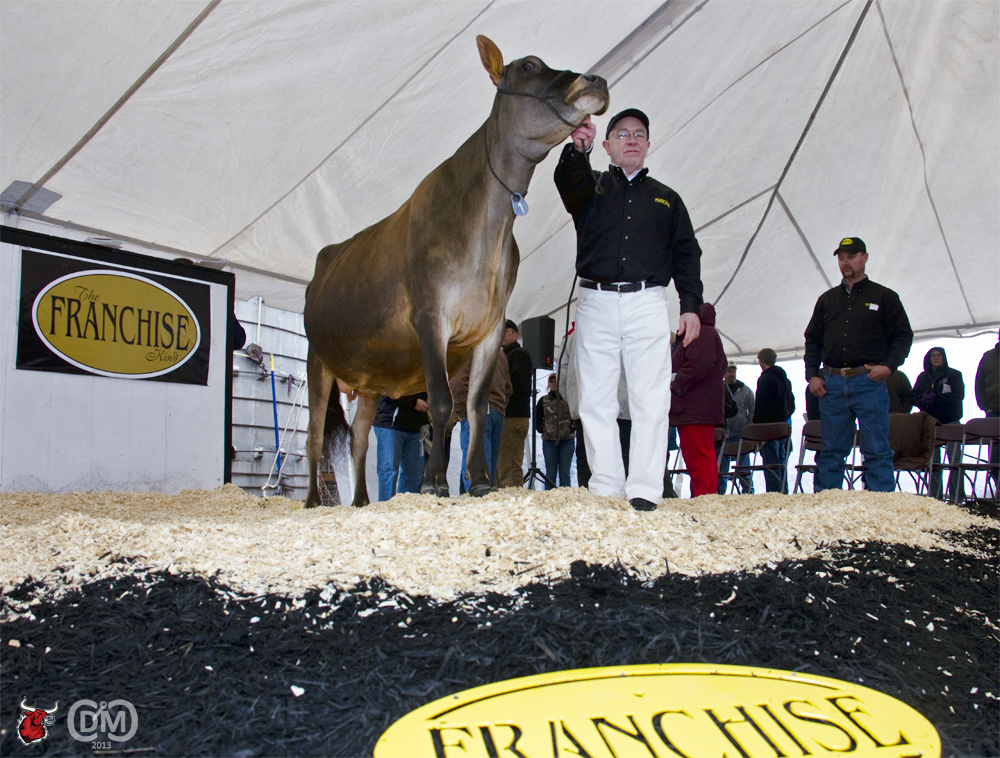
Gene Henderson leading the world record selling Page-Crest Excitation Karlie
….Four Decades and Five Different Breeds
Standing first in line is the most obvious measure of dairy cattle show ring success. Repeatedly achieving that position, over a period spanning forty years and five different cattle breeds is exceptional. For Bambi this is what makes his showring experiences special and, although not the entire story of his passion for dairy cattle, it is what makes his memories one-of-a-kind.
The following list, although not all-inclusive, provides a few of the highlights:
- Brown Swiss 1988 Bambis Jade Fantasy – 1st Winter Calf & Res. JC WDE and All-American Winter Calf
- Holstein 1996 Buggs Blackstar Buffy – WDE Champion (Carrousel)
- Brown Swiss 1996 Arnola Possibly Pricilla – Intermediate Champion WDE
- Holstein Show 1998 Mt.Glen Broker Lucy – Intermediate Champion
- R&W Holstein 1998 Stelbro Renita Ranger-Red – WDE Champion (Carrousel)
- Jersey 2005 Llolyn Jude Griffen – Louisville Grand Champion (Vail & Budjon)
- Milking Shorthorn 2013 Lands-Brook Christina – WDE Champion (Lands Brook)
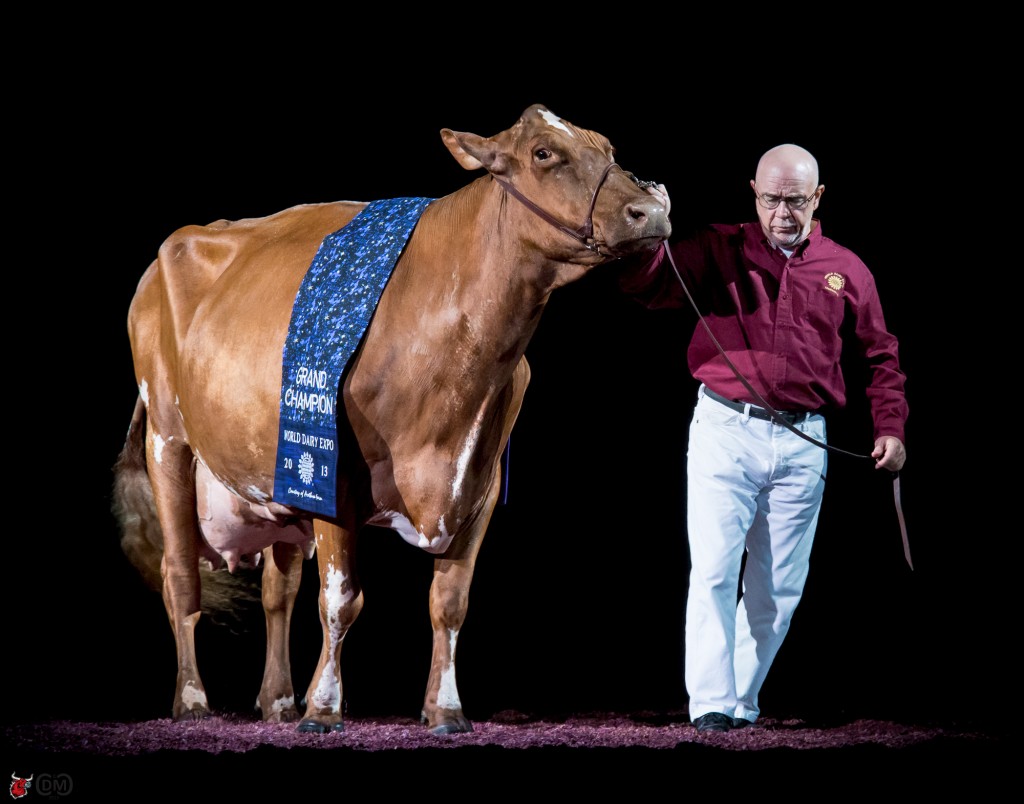
Gene Henderson leading the 2013 Milking Shorthorn Grand Champion – Lands-Brook Christina
Of course, when it gets down to true passion for dairy cattle, there are many times when the day ranks high in your memories for reasons other than winning. Bambi has enjoyed his wide-ranging showring career and points to highlights such as being the first person to show Taraley Astro Sherry as a Sr. 3 Yr. Old for Pamton and showing Sample Patrice to her first blue and Bambi’s first blue at Madison in 1981. A review of Bambi`s successes would not be complete without considering that he has successfully led his own breeding into the winners circle, including several All American winning Jerseys either bred alone or in partnership.
…..4-H marked Gene`s start in cattle showmanship
Gene Henderson and his brothers shared show ring experiences at the Iowa farm of their parents Verla and Merle Henderson. “4-H was my first start in showing dairy cattle. A grade Holstein was my first show calf at Linn County Fair. My family had a herd of Holsteins, Quality Ridge. That’s where “Hazel” was bred. So we had cattle my entire life. There are still cattle at the home farm.” Home was where Gene first felt his multi-breed passion for cattle. “Originally we had Guernseys, then Grade Holsteins and then registered.” As Gene grew up with the dairy industry his passion was further ignited. “At Iowa State University, Intercollegiate Judging, I met Norm Nabholz. I started at shows with Nabholz Farm the first summer of my Junior year. After college I got more involved with some high profile farms.” He makes it sound simple as he modestly downplays his talents. During the early years Bambi became acquainted with lifelong friend Perry Phend who also appreciated his talent and when given the opportunity Bambi was tagged to lead some of the best under Perry’s care at Lylehaven and in later years Carousel Farm. Bambi is quick to credit Perry and Bob Fitzsimmons with giving him a leg up in showing several All Americans.
…Not Simply “Chosen” but “The Best of the Best”
Over the years, Bambi has been the showman that is not simply the one that is chosen but the one who is sought out! Gene Henderson is recognized by many other exceptional showmen for his skill in this area. Norm Nabholz is emphatic about Gene’s expertise. “There is NOBODY better on the Halter than Bambi.” Norm recognizes that there is ongoing debate whenever the question of listing who is the best comes up. “You know you can argue about best judge, best cow, best bull (Before Goldwyn) best fitter, etcetera but, in this case, this gentleman is the BEST.” Nabholz closes the argument with a humble but vigorous disclaimer. “This is my opinion. But I have seen more than my share of great showmen and ladies in my lifetime. Bambi is the Best.”
….The Story Behind the Story
Sheer volume of experience in the show ring, means that Gene Henderson has a storehouse of memories to draw on. Although he’s recognized for making it look easy, sometimes this was more of a challenge then anyone could have foreseen. The story is told of the time that he was leading a cow who had been operated on for a displaced abomasums. The catheter was removed just ahead of show time. Then Gene went to work and history records that “Bambi” led Griffin to the title of Reserve Grand Champion of the Show. “Bambi has this amazing style about his showmanship. That’s why he was the logical choice to show Llolyn Jude Griffen- Ex-95 both at Madison and Louisville.”
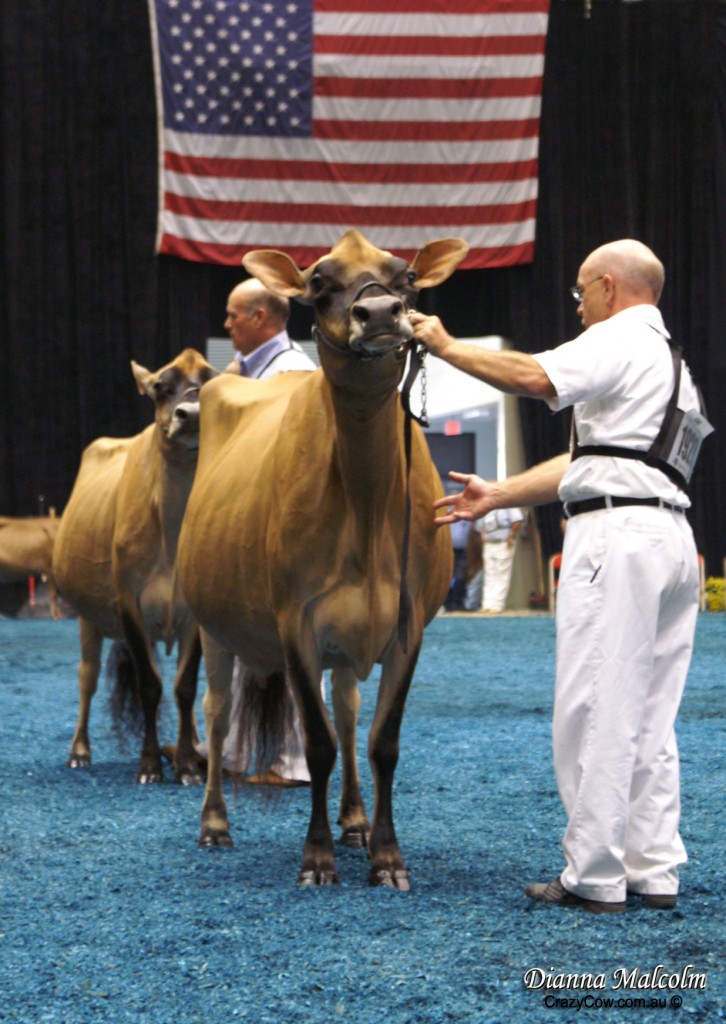
Gene Henderson leading LLOLYN JUDE GRIFFEN to 1st 4-Year-Old, Senior & Grand Champion of 2005 NORTH AMERICAN INTERNATIONAL LIVESTOCK EXPOSITION Jersey Show
Sometimes the things you learn about people are un-expected
For instance, do you know why Gene Henderson is widely known as “Bambi”? According to impeccable sources (the man himself) it is because, “In high school a coach said I ran like a deer, Thus Bambi”. Who would have foretold the eventual success of this speedy athlete? For many of his mentors, it probably hasn’t been unexpected. (Editor’s note: while this story started during Bambi’s college days it was never documented and knowing how tight Bambi is there are those that believe that a shirt was purchased at a thrift store that had the name “Bambi” on the back and the story was invented to justify the shirt). Gene credits his success, first of all to the influence of his family. He then turns to two admired gentlemen namely, Milford Nabholz and Bob Massee and, in recent years, to the Reibe Family from Wisconsin “a very humble and down to earth family” for whom Bambi has led several All Americans and in partnership bred several as well. However, it isn’t surprising that Nabholz Family holds a revered position at the top of the list of Gene’s mentors. “If I had not met Norm and his family I would never have gone on to the bigger shows.” (Read more about Norm – HALTER, PEN and GAVEL. That’s Just the Norm)
…there was one time when Gene’s greatest success was outside the showring
The showring circuit provides great memories and beyond that Gene is grateful for the whole experience. “Beyond the winning, I have enjoyed meeting remarkable people, showing some of the finest cattle and traveling throughout North America. Being a member of the Winning Intercollegiate Judging team while at also Iowa State stands out as an achievement.” However, Gene feels strongly about what has been most meaningful to him. “Personally, the biggest accomplishment for me would be my recovery from a stroke, January 18, 1999.”
…. a Gentleman who is Recognized by his Peers.
The dairy industry values those who make a difference. Sometimes that affects the way we perceive our industry and quite often those people become role models for others to follow. In 2001 Gene won the Robert Massee Sportsmanship Award given to the individual who exemplifies good sportsmanship in the show ring as well as in the cattle barn. And recently he was announced as the winner of The Max Gordon Recognition Award. This award is given annually to an exhibitor who possesses the five key elements for which the award’s namesake stood: sportsmanship, ethics, professionalism, ability and promotion of the Jersey cow. Gene Henderson is a deserving recipient of this award but no doubt feels more comfortable downplaying his own abilities. Bambi has spent many years perfecting how to put the most complimentary spotlight on the animal at the end of the halter. And that`s where he prefers the attention to be. When huge crowds are focused on the animal he is leading, that is good. When the Judge is focused there too, then he is getting the job done correctly. That is why friends, family and peers recognize him as “the Best”.
![998801_10101543580120068_487672137_n[1]](https://www.thebullvine.com/wp-content/uploads/2014/01/998801_10101543580120068_487672137_n1.jpg)
Gene Henderson was announced as the winner of The Max Gordon Recognition Award
The Bullvine Bottom Line
And so, Gene ‘Bambi’ Henderson reiterates his personal priorities. “You can be competitive in the ring and still be humble after the show. Showing cattle should be about the care of the cows 365 days a year. Not just the time in the showring.” And he concludes with advice that is not to be overlooked when developing a successful lifetime career, “Enjoy every day and laugh a lot.” Congratulations Gene Henderson, we admire you …..on the halter …. and in life.
Get original “Bullvine” content sent straight to your email inbox for free.
It has become annual tradition that Holstein Canada kicks off each new year by announcing the new class of Master Breeder recipients. This year is no exception. Holstein Canada is pleased to announce the 20 Master Breeders who will be honored at the 2014 National Holstein Convention in Sherbrooke, QC this coming April.
Of the 20 breeders who received the exciting news today, 70% (14) were first-time recipients of a Master Breeder shield, while the remaining are previous shield winners. Nine breeders were from Ontario; seven from Québec; one from Manitoba; one from British Columbia; one from Nova Scotia; and one from New Brunswick. The Master Breeders will be honored at the prestigious Master Breeder Banquet on Saturday, April 5, 2014.
Since its beginning in 1929, the Master Breeder program has become the most coveted Holstein Canada award. Only 944 Master Breeder shields have been awarded in the award’s 84-year existence. These “Master” breeders are recognized for having the mastered the art of breeding balanced cattle – high production and outstanding conformation with great reproduction, health and longevity. Congratulations to the 20 2013 Master Breeders who now join the ranks of the most elite breeders across Canada!
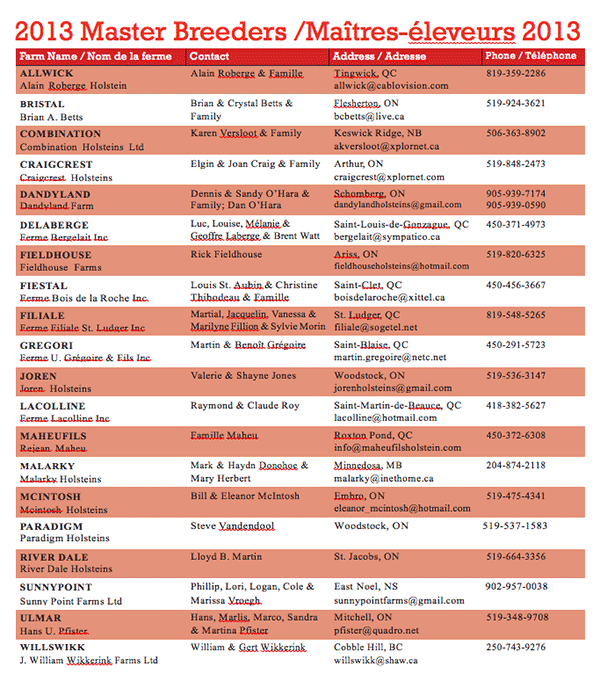
As we enjoy the NHL, football bowl championship and World Junior hockey season, it isn’t any surprise that these trained athletes can put a puck in the net or through the uprights far more often than the rest of us. For one thing, from the earliest hockey drills hand-eye coordination has been a big part of their training to score goals. Dairy breeders must likewise keep their focus on the goal. Arethusa Farm Dairy has achieved notable successes in the showring and in milk production by tightly fixing their vision on what is most important to their enterprise in Litchfield, Connecticut. Matt Senecal, Farm Manager began his employment as an intern six years ago and knows what they are aiming for. “Currently we are breeding for high type and show ring appeal but cannot lose sight of our obligation to provide milk to the processing plant.” To achieve this three-pronged success, quality must be the single over-riding focus at Arethusa.

Anthony Yurgaitis, left, and George Malkemus, both Manolo Blahnik. owners of Arethusa Farm Dairy (Photo by Christopher Capozziello for The New York Times)
The Focus on Quality is Shared by Owners and Employees
Arethusa Farm houses close to 350 head of Holsteins, Jerseys and Brown Swiss and is owned by George Malkemus and Anthony Yurgaitis. Two successful business executives who took the world by storm when their shoes, Manolo Blahniks were catapulted into the urban consciousness through the television show “Sex and the City”. Who got the passion for cows when they originally purchased the farm opposite their home to protect their view from developers. (Read more: The Dairy Built on Stiletto Heels) Just like their signature stiletto heels, the focus is always on top quality in all that they do. After successes at the 2004 World Dairy Expo, Arethusa began milking 80+ cattle out of a brand new state-of-the-art facility located just north of the original farm. Today 100% of this milk is being shipped to their processing facility, located just a few miles away in the borough of Bantam. George and Tony set high standards and the demands for excellence are even higher. This attitude also filters down to each employee and instills a work ethic like no other.” Quality cattle need quality care and Matt feels strongly about the great work done by the Arethusa staff. “Heather Lord works with the milking herd along with Joe Knapp, Shelby Crawford and Chris Cole. Heather recently joined the team and does a great job overseeing the main milking facility and making sure we are providing the plant with exactly what it needs for production.” Excellence is the priority at all times.
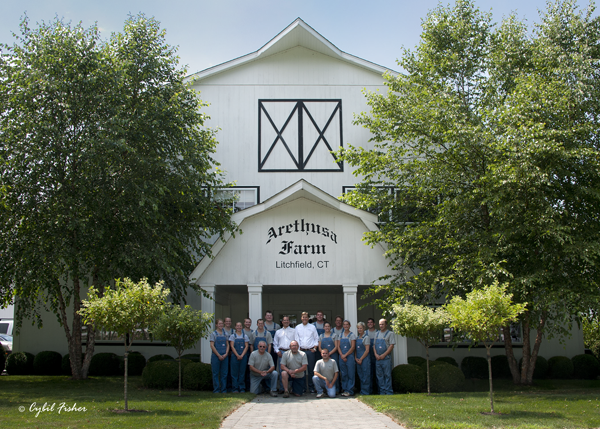
The Team at Arethusa Farm Dairy
“We Strive for Excellence 365 Days a Year”
You know a strategy works when results are achieved. In 2004 at World Dairy Expo Arethusa owned both the Supreme Champion Cow (Hillcroft Leader Melanie – Holstein) and Reserve Supreme Champion (Huronia Centurion Veronica – Jersey). Matt lists other successes. “We have been awarded numerous breeder and exhibitor banners at national shows, and have bred both Holstein and Jersey futurity winners at the World Dairy Expo.” This started with clearly defining the Arethusa goal. “We need our cattle to be true functional dairy cows so that we can then develop them into great show cows.” You can’t have one without the other.
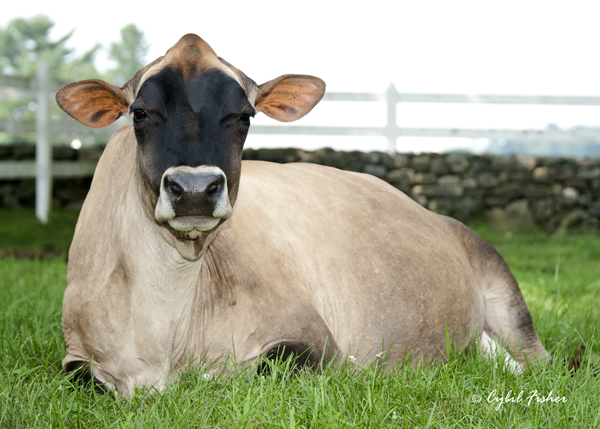
Huronia Centurion Veronica 20J EX-97-USA
Supreme Champion – World Dairy Expo 2006
Grand Champion World Dairy Expo 2004, 2005, 2006
New Benchmarks. Continued Success.
More recently Arethusa Farm Dairy entered products for the first time ever into the American Cheese Society competition held this year in Madison, Wisconsin. They were awarded second place for their Camembert in the Farmstead Cheeses-Soft-All Milks; Aged up to 60 Days-Over 50% Moisture Category. In the Cultured Milk Products made from cow’s milk category they received 3rd place for their sour cream.
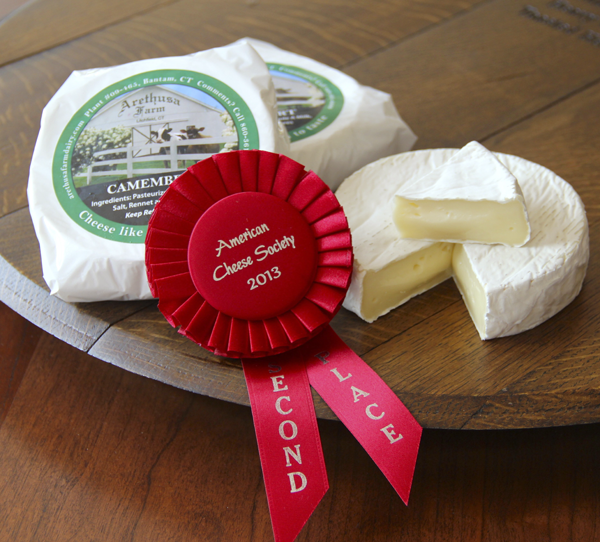
Arethusa Farm Dairy were awarded second place at the recent American Cheese Society competition held this year in Madison, Wisconsin for their Camembert in the Farmstead Cheeses-Soft-All Milks; Aged up to 60 Days-Over 50% Moisture Category.
One-on-One Attention
The milking equipment was recently updated and Arethusa Farm milks almost 20 cows out of the original tie stall barn that also features a five bay pack barn. Any cattle that are potential show prospects are housed there as well. Arethusa Farm Manager Matt Senecal expands on this aspect of their strategy. “This allows us to work much closer in a one-on-one environment individualizing for each cow’s needs.” Dan Ceresna and Katie Deslippe are a key part of the success and work mostly with the show cows. Rod Rankin is the Herdsman and has been with Arethusa for almost four years now. Rod has tremendous ability and spends a great deal of time fine tuning the show cow program. He also oversees all other areas and communicates extremely close with all employees.
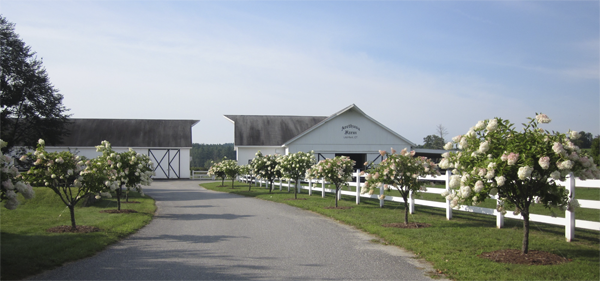
Picturesque show barn facilities at Arethusa Farm Dairy
Communication is crucial.
Producing quality products requires focus on even the smallest details. Matt explains. “There are protocols in place to keep a constant check on the quality of the milk being produced. We then meet with the products’ manager to make sure we are supplying him with a superior raw product for him to then create into outstanding Arethusa Farm fresh products. We do not have room for errors. It does not work for us to lose a tank of milk. If we don’t have milk to ship, the dairy plant is not able to make products to distribute to the numerous stores and consumers. Our brand is marketed as a single source herd…all products are produced only from milk here at Arethusa Farm. This is a huge selling point to our customers. They are able to visit the farm and see just how we take care of the cattle and facilities. When they walk into the barn and see this environment they are sold right away.”
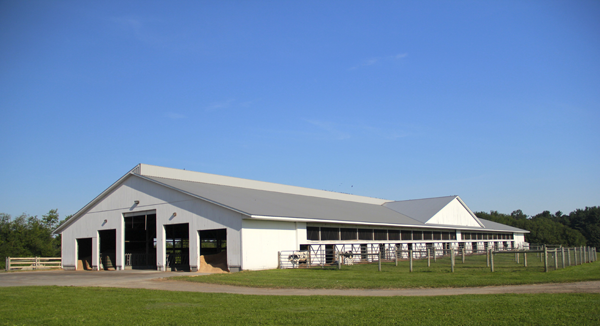
Heifer facilities at Arethusa Farm Dairy
The Arethusa Team
To achieve the level of quality they are targeting requires that the entire team achieves excellence in their assigned areas. Matt recognizes the importance of teamwork at Arethusa. “We greatly appreciate the passion each individual has for what he or she does.” He goes on to outline specific contributions. “Tom Breakell acts as the General Manager. His time is split between the farm, dairy, and many other projects that may be going on.” Regardless of the responsibility everyone targets quality. “Linda Rankin and Kazmeira Nero work closely together to raise calves in a meticulous calf program. Taylar Sherman is responsible for the heifer program. The focus is on quality for all animals including 40+ recipients that are used in our extensive ET and IVF program.”
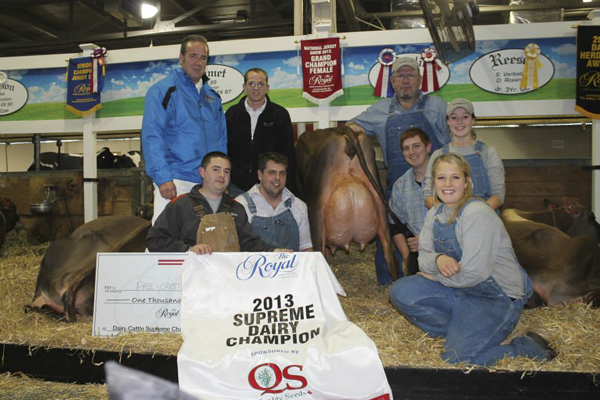
Arethusa show team at the recent Royal Winter Fair.
The Team Pulls Together Wherever They Are Needed
It is always nice to have a trophy room and to have your name in the record books for achieving results in dairy production. Behind the scenes it takes a lot of people who can step up as needed explains Matt. “Dana Chase and Bryan Colbert fill many different positions whether they are needed at the calf barn, heifer barn or cow barn. Bill Pulver spends his time at the farm when things are much quieter. He has been with us for almost two year now working the night shift making sure everyone is safe and sound. Bud Dore and Jeff Jarl are important to the farm, and they will do anything you ask. Bud is currently the longest running employee to date. Jeff runs a top notch chicken house and will paint anything and everything that may need painting.” Arethusa recognizes that there is a role for mentoring dairy industry personnel and they actively support that outreach. “Sammi Wilson is currently working with us for a year through a program called AgriVentures. She is here from the UK to learn about the many different aspects of dairy farming. We have designed a program for her to become familiar with all areas of Arethusa Farm.” Regardless of the individual tasks, Matt emphasizes how important the whole team is. “EVERYONE is important to the farm. Without one of these people, Arethusa would not operate as smoothly or be as productive as it currently is.”
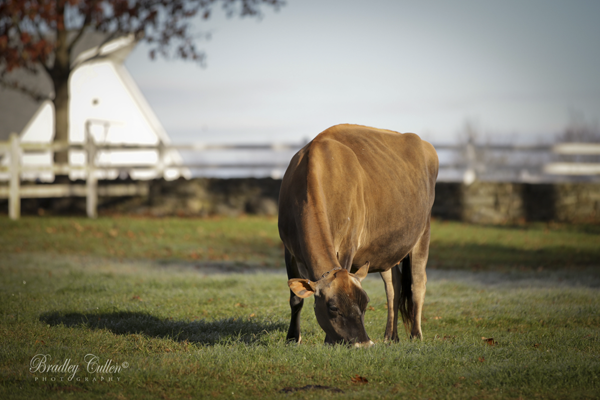
Arethusa Response Vivid EX 93
World Dairy Expo Reserve Supreme Champion 2011
Royal Winter Fair: 1st 4-yr old 2011
Sr. Champion; Grand Champion 2011
ABA Unanimous All-American 4-yr old 2011
Member ABA All-American Sr. Best 3 Females 2011
Member ABA All-American Produce of Dam 2011
All-Canadian; Champion All-Canadian Cow 2011
Arethusa and Quality Cows
Matt looks back on Arethusa’s cow story. “Arethusa has been extremely fortunate to have worked with and bred many great show cows since its inception. Of course, Huronia Centurion Veronica 20J takes the ribbon for a cow that has proven that she can show, put sons into stud, and breed the kind of cows that win (Read more: The 12 Greatest North American Colored Breed Show Cattle of All-Time). She is a remarkable cow with a personality like no other. Her daughter Arethusa Response Vivid went on to prove Veronica is not just a show cow but a brood cow, too. With all of her mother’s personality and more, Vivid gained lots of attention when she was crowned 3x Grand Champion in 2012 and Reserve Supreme Champion at the World Dairy Expo.” At Arethusa they are currently working with Crovalley Knowledge Akika VG 89, Roquet Jasmine Sanchez EX 91 and Ernest-Anthony Allure EX 92. All three have been nominated for All Canadian and /or All American in 2013. It isn’t surprising that Arethusa’s focus on excellence would earn them success in the Jersey show ring as well.
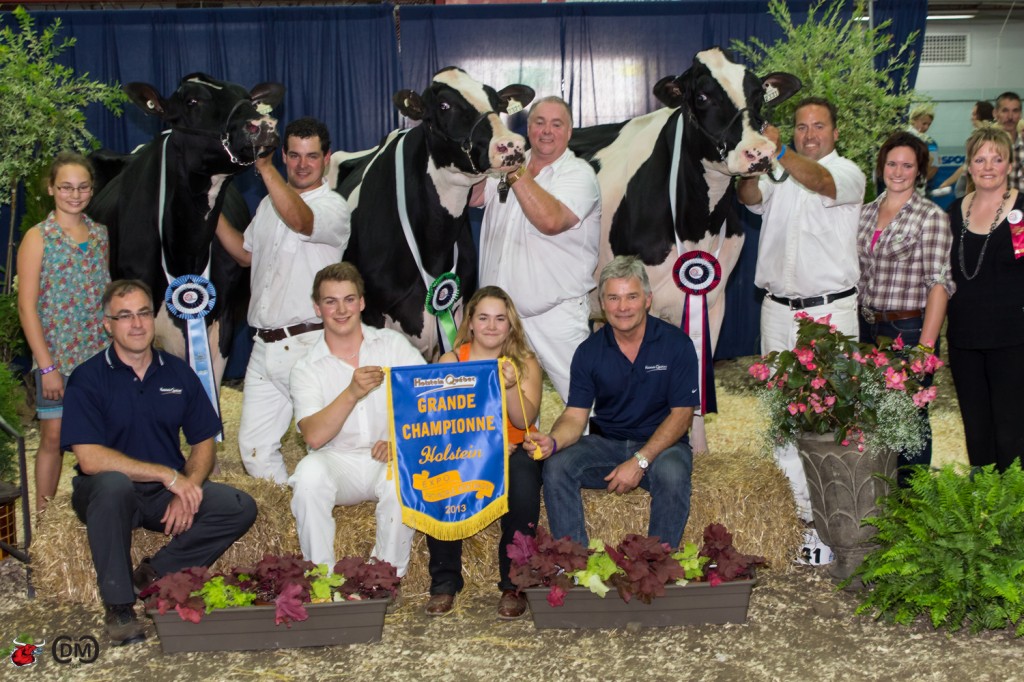
Roquet Jasmine Sanchez was Grand Champion at Expo Quebec where she was the only cow to defeat the great RF Goldwyn Hailey in over a year.

Page-Crest Excitation Karlie was purchased by Arethusa for a world record $170,000 at last springs The Franchise Kind Sale.
Arethusa and Karlie, “The True Type Jersey Cow!”
One of the interesting parts of the dairy breeding industry is learning how owners, breeders and great cows came together to build success. Matt enthusiastically recalls. “Karlie came to our attention first in 2012 when she was named Reserve Intermediate Champion at the World Dairy Expo. A month later at the Royal Winter Fair, Page-Crest Excitation Karlie went on to become the Reserve Grand Champion. Upon return from the shows, George and Tony had expressed interest in purchasing another great young jersey cow. As winter went on and many changes took place here at Arethusa, spring sale time quickly approached. Ads began to run and people began to talk about the Franchise Kind Sale, a sale that is known for quality and show ring success. I had seen Karlie was being offered as Lot 1. Not only were the owners going to offer Karlie for sale, but also a package of IVF pregnancies too. The chance presented itself to purchase not only a young show ring star but the potential for nine immediate heifer calves to begin to develop in the herd. After much discussion George and Tony expressed their interest in the purchase of Karlie. The stress built in the days to come, and when the gavel dropped, it was announced Karlie would be heading to Arethusa Farm in Litchfield, Connecticut. At that instant we knew the pressure was on. It was now in our hands to bring Karlie back to the ring just the way she left.” (Read more: Jersey cow sold in Syracuse for a record $170,000) And the rest, as they say, is history. Matt happily reports. “It was said at different times this fall during the judge’s reasons… ‘This is the true type Jersey cow!’ She is complete, she is balanced and when she is ready to work… she just gives you chills. Karlie has gained many fans this year not only in the Jersey breed, but from those that love great show cows. She has been a pleasure to work with as she too just loves every part of the competition.” (Read more: ARETHUSA FARMS TRIUMPHS IN THE 2013 INTERNATIONAL JERSEY SHOW and Royal Winter Fair Jersey Show 2013 Results)
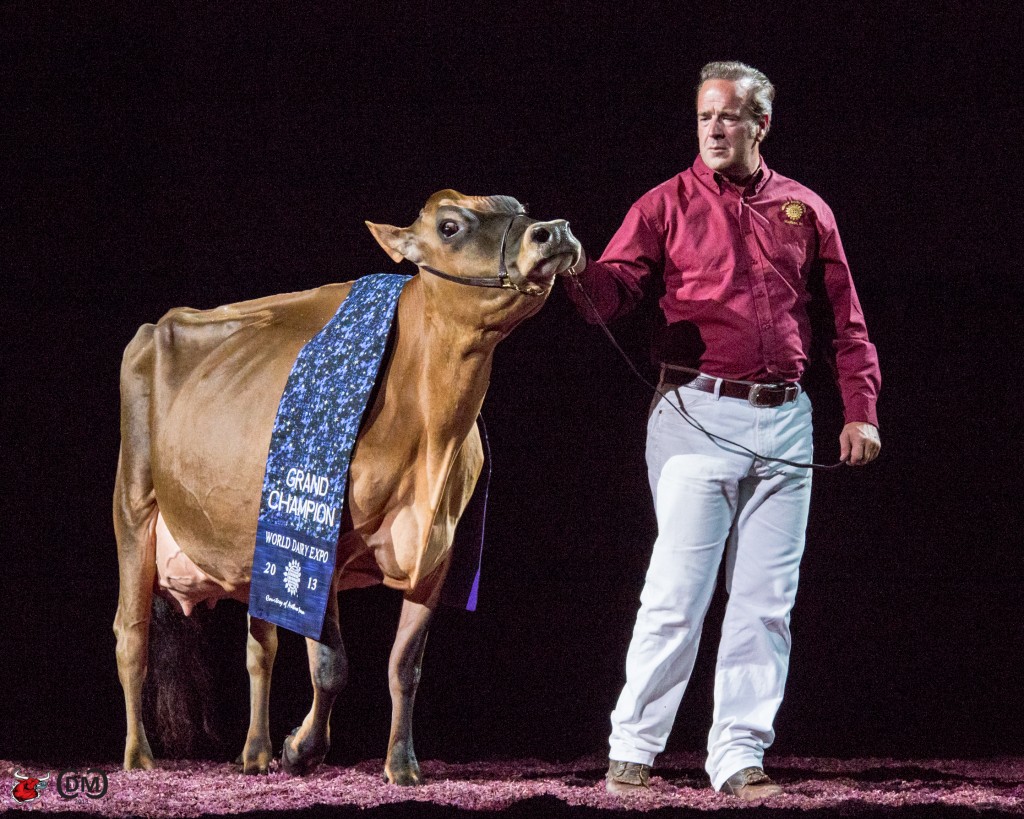
Page-Crest Excitation Karlie, owned by Arethusa Farm of Litchfield, Conn., was awarded Grand Champion honors at the 2013 International Jersey Show at World Dairy Expo
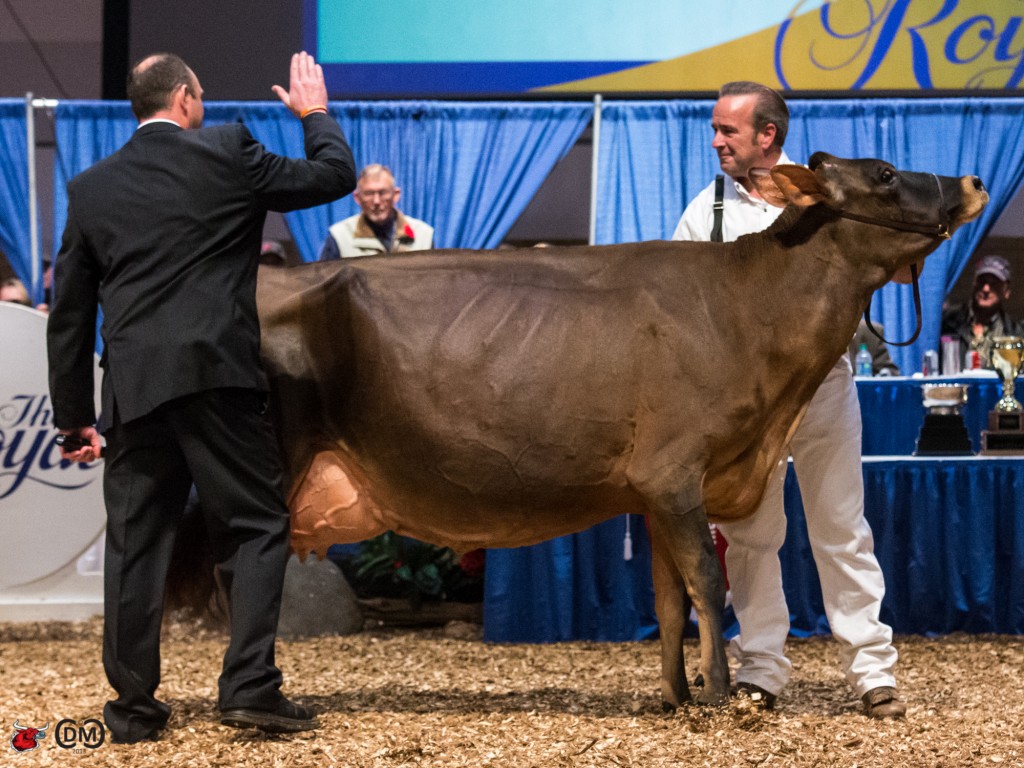
Page-Crest Excitation Karlie was also named Senior and Grand and Supreme Champion at the 2013 Royal Winter Fair
Arethusa Attracts Attention
Whether it’s sports or dairy breeding, when you achieve exceptional results, you will achieve exceptional attention. Arethusa Gold Valencia became the first home bred EX95 Holstein this year gracing the cover of the Holstein World Ring Side edition at World Dairy Expo. Matt lists other attention getting opportunities. “Arethusa has also been featured in The New York times, The Wall Street Journal, on the CBS Early Show, and many other well-known publications.
The Bullvine Bottom Line
Wayne Gretzky says it best. “You miss 100% of the shots you don’t take!” And every aspiring baseball player has been told. “If you want to hit a home run, don’t take your eye off the ball!”
While hockey and baseball analogies are perhaps overused, the lessons they provide are useful. When it comes to focus, Arethusa farm isn’t playing games but they are winning. The reason? They are maintaining laser like focus and advise others to do the same. “Make a plan that is practical for your goals. It takes a lot of hard work, dedication, and passion. Focus on what you love, and be confident in the choices you make.” At Arethusa this focus is a winning strategy!
Get original “Bullvine” content sent straight to your email inbox for free.
![103189[1]](https://www.thebullvine.com/wp-content/uploads/2013/12/1031891.jpeg)
Friends may visit at the McFarlane & Roberts Funeral Home, 2240 Wharncliffe Road, South, Lambeth, ON, on Tuesday, December 31, 2013 from 11 – 2 pm, then to Christ Anglican Church, Glanworth, ON where the celebration of Hardy’s life will follow at 3:00 pm. Canon Marian Haggerty officiating. Cremation with private family interment Christ Church Cemetery, Glanworth.
Donations to the Men’s Mission Services of London, 415 Hamilton Road, London, ON N5Z 9Z9 gratefully acknowledged. On-line condolences are available through www.mcfarlane-roberts.ca.
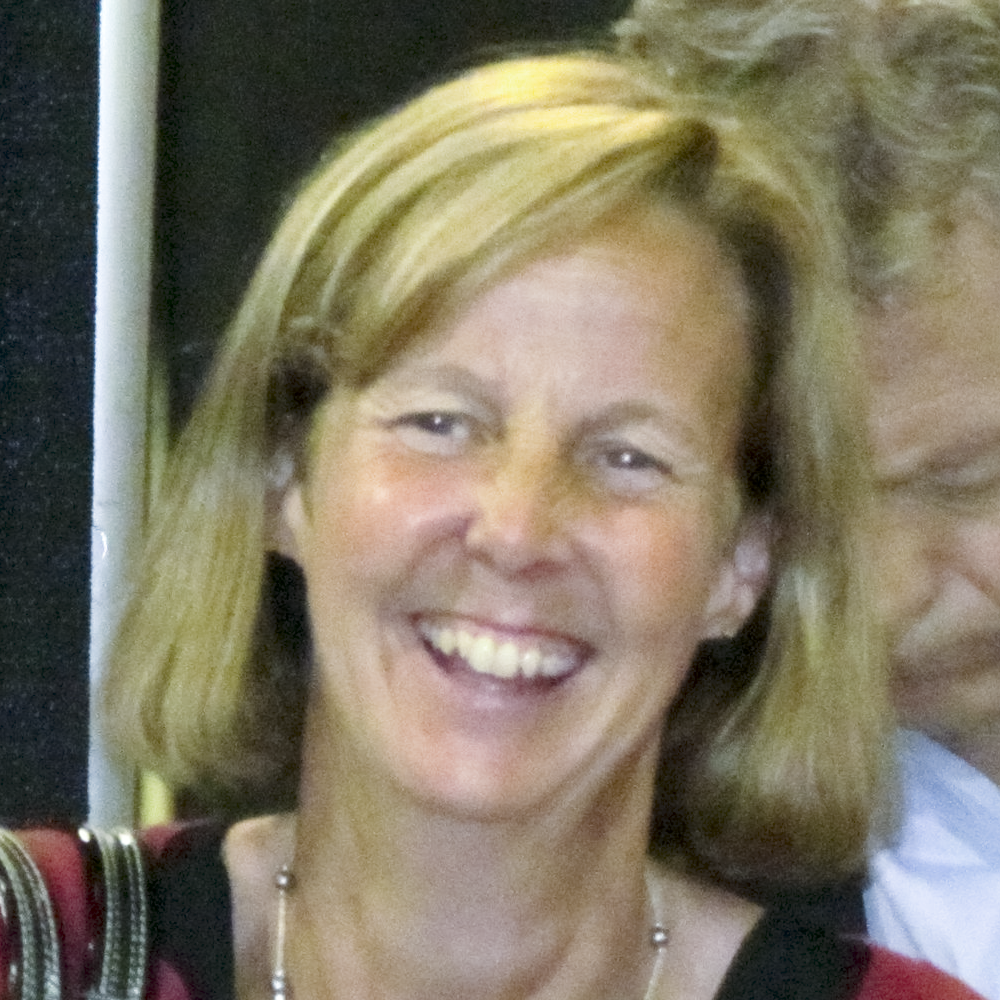
Sue Brown, Farm Manager of Lylehaven
Sometimes we laugh. Sometimes we cry. Both emotions rise easily to the surface when Sue Brown, Farm Manager of Lylehaven, looks ahead to May 23, 2014 and the “Celebration of Lylehaven” final sale. Her ready laughter punctuates the stories and at times her memories bring a tear to your eye and put a lump in your throat.
Surrounded by Positive Mentors
Sue has been at Lylehaven almost twenty years. Previously she worked for ten years for the Briggs family (Brigeen Farms Inc.) “They taught me a lot about cow families”. Her friends and mentors had an impact on her career. “I was good friends with Mike Wilson (Wilsondale Holsteins, Maine). Basketball and his daughters drew us together and at times I helped the girls do chores. Mike instilled lessons that had a big impact. “Mike felt that ‘Timing is everything.’ And we were taught a good work ethic which is more important than anybody ever realizes. He would say, ‘Do a job and do it well!’” These were lessons well learned by a multi-tasking farm manager who, after getting soaking wet on a rainy day while feeding seventeen calves nonchalantly provides insights and stories about Lylehaven. “I always knew that I wanted to work with animals. After I graduated from University of Maine in Dairy Science, Bob Fitzimmons hired me.” Sue succeeded Bob when the day came that Bob went on to focus on being General Manager of Carousel Holsteins.
Lylehaven Loyalty
The Lylehaven farm is located in East Montpelier, Vermont and has inspired years of loyalty from those who work there. Susan points out the commitment of the staff.” There are six staff in total and together they represent 125 years of dedication to Lylehaven. “Three others have worked more than 20 years each.” Sue has high praise for this loyal team. “They treat Lylehaven like their own. Any time day or night!” Sue herself is a 24/7 365 day a year manager and is always connected in some way to Lylehaven and cows. “Facebook is a great source of information. I really like it!” She points out and notes that it is a great way for her and Jerry Rappaport, the owner of Lylehaven, to keep in touch. “Jerry spends the majority of his time in Florida so we communicate by cell phone, emails and Facebook. He “follows” me. It’s a good way for him to keep in touch with grand kids and great grandkids too.”
Cattle Breeding is About Developing Full Potential
Conversations with Sue easily move between cattle breeding and the showring however she quickly points out. “Cattle showing is not the be-all-and-end-all of my life! There is a lot of stress. It is not an easy job! ” Indeed Sue Brown’s dedication has all the passion of the show ring enthusiast but is focused in a slightly different direction. “I really enjoy developing cows. For me that is a bigger thrill than buying a show cow and winning with it.” Having said that, Sue has developed her cattle searching techniques along with the Lylehaven herd. “Today I go to dairybulls.com and search for bulls to use. I used to go to shows and sales in Quebec and around the US. I would study the show book and see what was winning. That was how I used to breed the cattle here at Lylehaven.” Sue once told a reporter that she had one goal when breeding cattle,
“I want to hear the vet say, ‘She’s pregnant!’”
She points out that at the end of the day “Even if they’re showing they’ve got to breed back for the next year!” This focused attitude covers all areas of Sue’s cattle breeding philosophy. “I have never really been interested in getting bulls into studs. I want a barn full of great cows. We work at that every day and I wouldn’t trade any part of this work. You take what you can use and walk away from the rest.” She applies that measurement to new technologies such as genomics too which she feels complement her strategy for building cow families. “Albert Cormier four or five years ago told me that when you have a cow family, you have genomics. It’s there. A cow family that transmits is going to have genomics.” Susan has the optimism and persistence it takes to make the plans and wait for the results.
Finding Lili Foretells the Lila Z Future
Enthusiasm followed by patience is the story of Sue’s favorite cow Thiersant Lili Starbuck-ET 5E 94. “I bought Lili. It was Jerry’s 70th birthday. Julian Chabot called from a show in Quebec about a just fresh two year old that I needed to see. We went up and I bought her that day. I grew up in an era when Starbuck was very popular. She was not a hard sell and I liked the pedigree behind her. I don’t know if she had ever won at a show. Then she was just a fresh junior two year old.” The compelling story continues. “After 30 or 40 days she had not bred back so in December I decided to flush her. That’s what prompted the Formation flush. Julian made the mating. The credit goes to him.” She sums it up with the give and take dynamic that had been established. “Julian knew we were looking. We trusted Julian. There was a big trust factor”.
![thiersant-lili-starbuck[1]](https://www.thebullvine.com/wp-content/uploads/2013/12/thiersant-lili-starbuck1.jpg)
THIERSANT LILI STARBUCK EX-94-5E-USA 3*
Starbuck Lili “This is a Great Brood Cow!”
Once at Lylehaven, Lili’s story was about to unfold. “Lili was only flushed twice as a two year old and we didn’t flush again till she was four or five. She has had several matings and we never really had a bad one.” Looking back at 18 years with Lili, Sue knows what the development process takes. “It’s called patience. I’m not sure with today’s fast pace that we have it any more!” Lili’s story certainly needed patience before seeing the momentum build. “Lili was six or seven when the Formations started to calve in and we said, ‘Hey! This is a great brood cow!” Not only did she breed well but her offspring show well too!
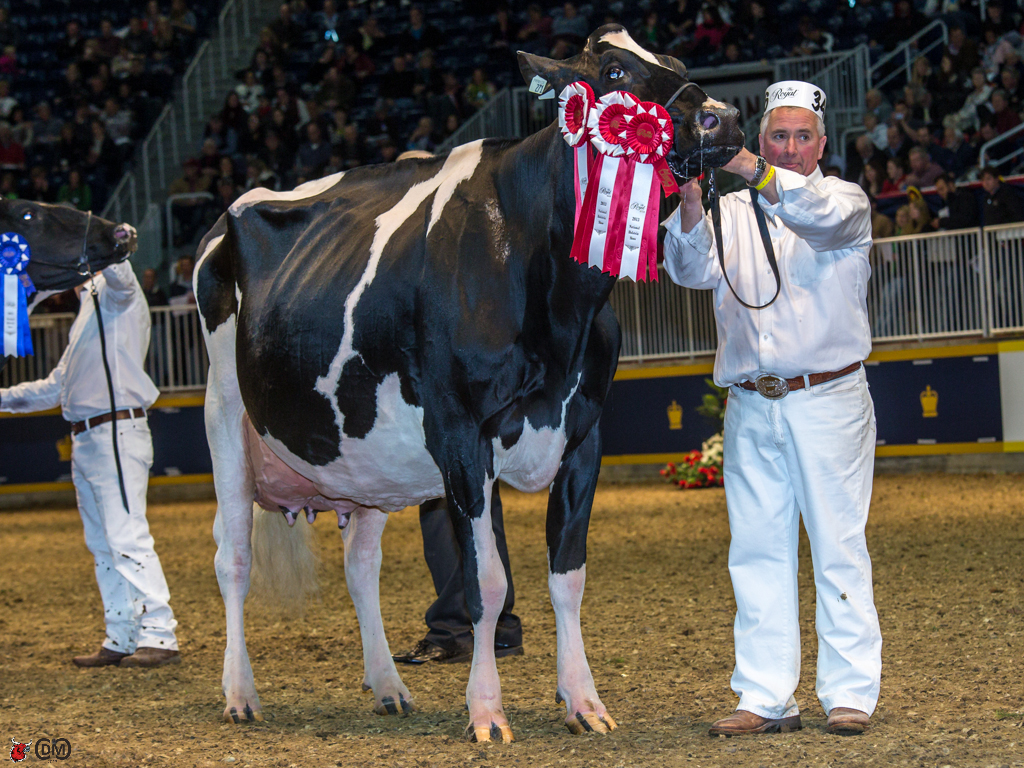
CALBRETT GOLDWYN LAYLA EX-95-CAN EX-92-5YR-USA
NOM. ALL-CANADIAN 4-YR 2011
1ST MATURE COW ROYAL 2013
GRAND ON SUMMER 2013
“No other cow family has had three first place winners at the Royal in one year.”
In 2013 there were three Lili family members in first place! Sue enjoyed the excitement of all three winners having Lili as their third dam. “When I saw the Lili’s winning at the Royal, I knew the families and how they got the daughters. First came the Senior Calf winner, Comestar Larion Goldwyn and then the 2 year old, Belfast Goldwyn Lasenza. Then Calbrett Goldwyn Layla won Mature Cow!” No other cow family has had three first place winners at the Royal in one year!
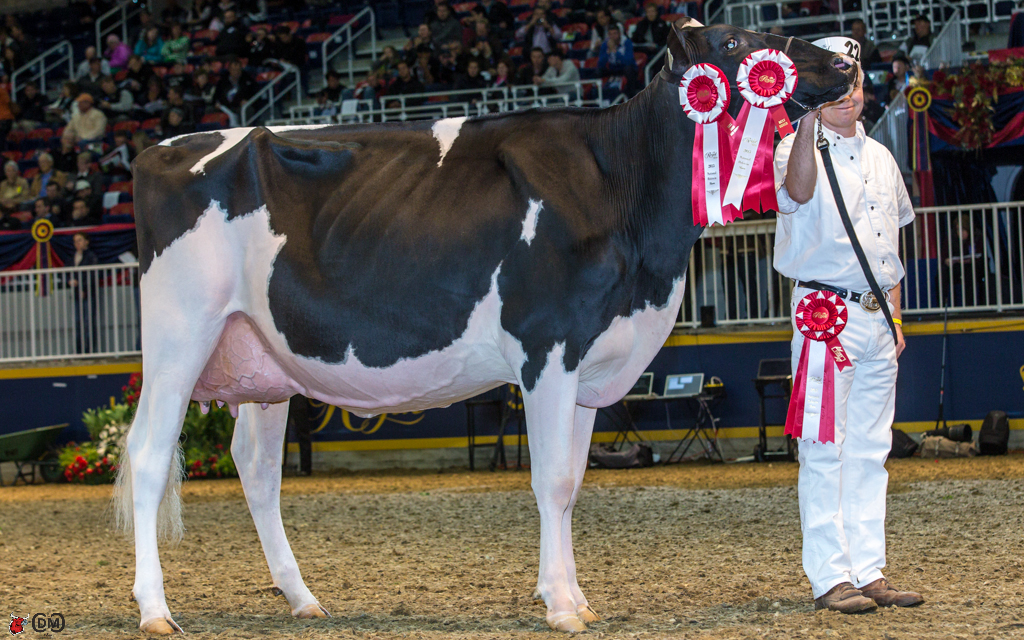
BELFAST GOLDWYN LASENZA VG-89-2YR-CAN
RES. ALL-CANADIAN SUM.1-YR 2012
RES. ALL-ONTARIO SUM.1-YR 2012
1ST JR.2-YR ROYAL 2013
1ST JR.2-YR MADISON 2013
Love for a Cow Family
With all those years together and the growing list of successful offspring, it isn’t surprising that the greatest love of all for Sue Brown was for Lili. Unfortunately, all those years came to a sudden heart-wrenching end. Sue recalls her day-to-day admiration for Lili. ”I could place four hands in between her eyes!” The relationship with Lili had been more than just manager for one of the cows in her care. ”She was in the same stall her whole life. Never ever was Lili in a different pen. The day she went down I was at a football game.” Not being able to see her on her last day was hard to say the least. That empty space when I got home at 11 o’clock was a shock. “When I got back to Lylehaven Hal said. ‘Sue, it’s better that you weren’t here. She went down and you always told us not to let her suffer.’” Sue speaks from the heart. “That was the hardest thing I’ve had to go through in a long time.” And so that space will always echo the one in Sue’s heart as Lylehaven and Lili’s legacy continue. But her love for the process lifts her up. “We must have six Lili’s milking right now. ” After Lili’s passing each new Lili calving took on a new feeling. “When they were born and Lili wasn’t here it was bittersweet!” The past and the future… not quite together.
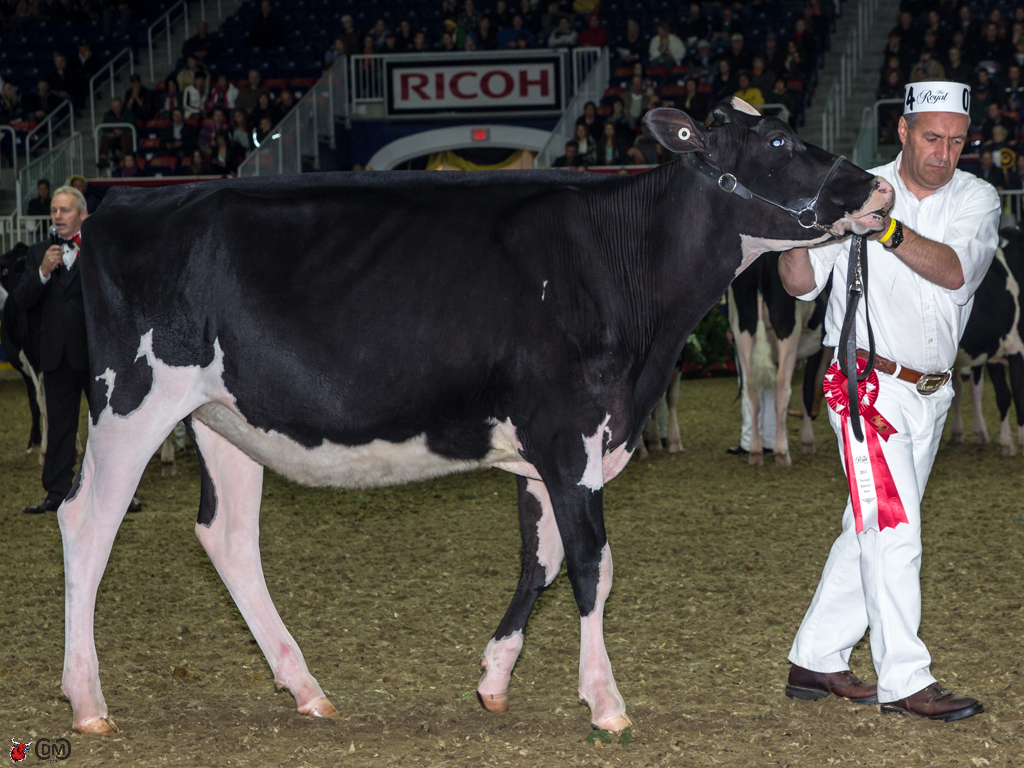
COMESTAR LARION GOLDWYN
RES.JR. ROYAL 2013
RES.JR. QC INTERNATIONAL 2013
1ST SR.CALF ROYAL 2013
1ST SR.CALF QC INTERNATIONAL 2013
Families Who Love Cow Families
As with cow families, Sue feels dairy breeding families are extra special as well and puts one family very high on the list. “It would have to be the Chabot family. They each have their strengths. They are always willing to help and promote the breed. They’ve always been by my side.” Sue knew Julian Chabot as a sire analyst before she went to Lylehaven. “We are only an hour from Quebec. I have such admiration for this family. They are still real breeders. They still have the passion.” It is this passion that brings people together in the extended dairy family. Sue has many there as well. ““I like talking to real dairymen. It gives you back your perspective. “She appreciates Don Bennink of North Florida Holsteins and includes him in the ‘real breeder’ category. They shared their Raidar stories, “Loved them but couldn’t get her bred back!”
Of course her years at Lylehaven have been touched by another gentleman who loves cattle, cow families and people. “Jerry Rappaport is a great family man. That is one of the reasons he still has this farm. It’s part of his family. Jerry never saw it as a burden but as a passion. What first started as a retreat from Boston … and then discovered to be fun. He absorbs a lot and he is really smart.” You really never know when dairy cattle breeding fever will hit and there is irony in Sue Brown’s own dairy history. Although she doesn’t herself come from a dairy breeder family, her twin sister is a Holstein Consultant for Holstein USA in Pennsylvania and Maryland. With her trademark laugh in full swing, Sue reports that her Mother who lives in Massachusetts thinks it’s interesting. “Although Mother grew up on a dairy farm, she wonders how the oldest two got the cow bug.” Maybe Mom always knew that dairy-love requires 365 days of taking care of the cows and probably wishes her girls had more time for visiting!
At Lylehaven the Price is Always Right!
For Sue Brown time for visiting usually has a lot to do with buying and selling and then developing great cows. Believing that every cow should be priced Sue says, “We will always sell one!” She has always held true to this philosophy. It led to the selling of Lila Z. “When asked for a price on Lila Z she priced her at $20,000. She was a baby March calf and I probably though it might have kept her at the farm. But you never back away from a cheque. You do what you say you’re going to do and live with it.” And sometimes everything works out perfectly. “Steve Briggs phoned after the 2013 Royal and said Lylehaven didn’t even have to spend one dime on advertising. Three family members won at the Royal! It was the right place at the right time.” (Read more: Lylehaven Lila Z : Was She Really Worth $1.15 Million?)
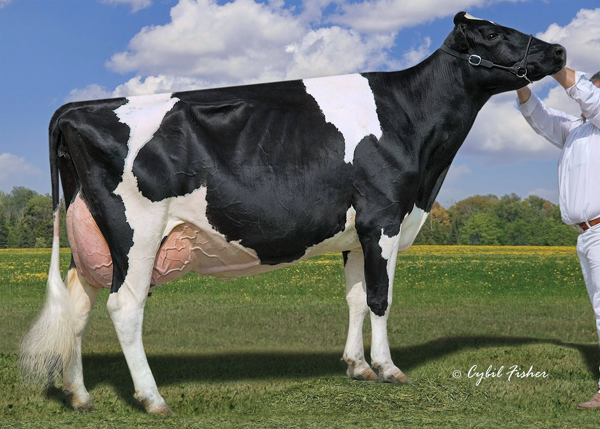
LYLEHAVEN LILA Z EX-94-CAN 16*
ALL-CANADIAN JR.2-YR,JR.1-YR
HM. ALL-CANADIAN 5-YR,4-YR
HM.INT. ROYAL 2004
1ST JR.2-YR ROYAL 2004
The Celebration of Lylehaven Sale
And now the sale becomes the right next step. “And so it is good to have a sale.” says Sue. “It is the final accomplishment for Jerry.” Looking ahead to May 23 Sue sees the numbers shaping up. “We will be selling about 120. There will be closer to 140 in sale. There will be some guest consignments out of the Lili family. People have been great to us.” We’ve flushed an Atwood (two Jr 3 91) to Bradnick and Numero Uno. We will have nine or ten of her daughters in the sale.”
The Dream of Lili Continues
The legacy of Lili’s descendants will keep rising as her offspring continue to take centre stage. “I think the best Lili is still here. The Atwood – junior three year old scored 91 points. She was just fresh three and a half weeks.” Julian Chabot saw her and exclaimed. “Formation Laura with a chine!” As a dairy industry supporter Sue sees the importance of the next generation being as important as the next cattle generation. “There will always be young people. When I think of the people who cultivated me, I wonder if I’ve given back enough so that young people see the passion and dedication this calling inspires. That is part of the excitement. Young people are the future of the dairy industry. We must give them a chance.”
The Bullvine Bottom Line
Sue sums it up. “Everything changes. That’s the beauty of our industry.”
While in some ways the dream is departing for Jerry Rappaport, Lylehaven and Sue Brown, the legacy of cows, cow families and great dairy memories will carry the legacy they have developed far into the future.
Thank you for showing us that to achieve your goals you have to develop your dreams.
Get original “Bullvine” content sent straight to your email inbox for free.
Have you ever heard someone describing something that they thought was truly magical? For Ysabel Jacobs the description sounds like this: “You dream about it all your life. You work for it. And then it happens. It’s like the world has stopped turning just to see one cow.” Such was a magical experience for Ferme Jacobs Inc. of Cap–Santé Quebec when Bonnaccueil Maya Goldwyn EX-95-2E was named Supreme Champion of World Dairy Expo. (Read more: World Dairy Expo 2013 Holstein Show Results and World Dairy Expo 2013 – Memories to last a Lifetime) Standing in the spotlight, she had fulfilled Ysabel and Yan Jacobs’ vision. “We bought Maya with Tyler Doiron and Ferme Drolie as a 2 year old because we thought she had the potential to one day to be a great cow. After working with her for many years it was an amazing accomplishment to see her make it all the way to World Dairy Expo Supreme Champion!” For us to achieve this goal was especially exciting. From the beginning we knew what we were looking for. We love a good balanced cow with a tremendous udder. To develop a cow to this level and see one of ours in the middle of the Supreme Champion Parade was a proud moment for us!”
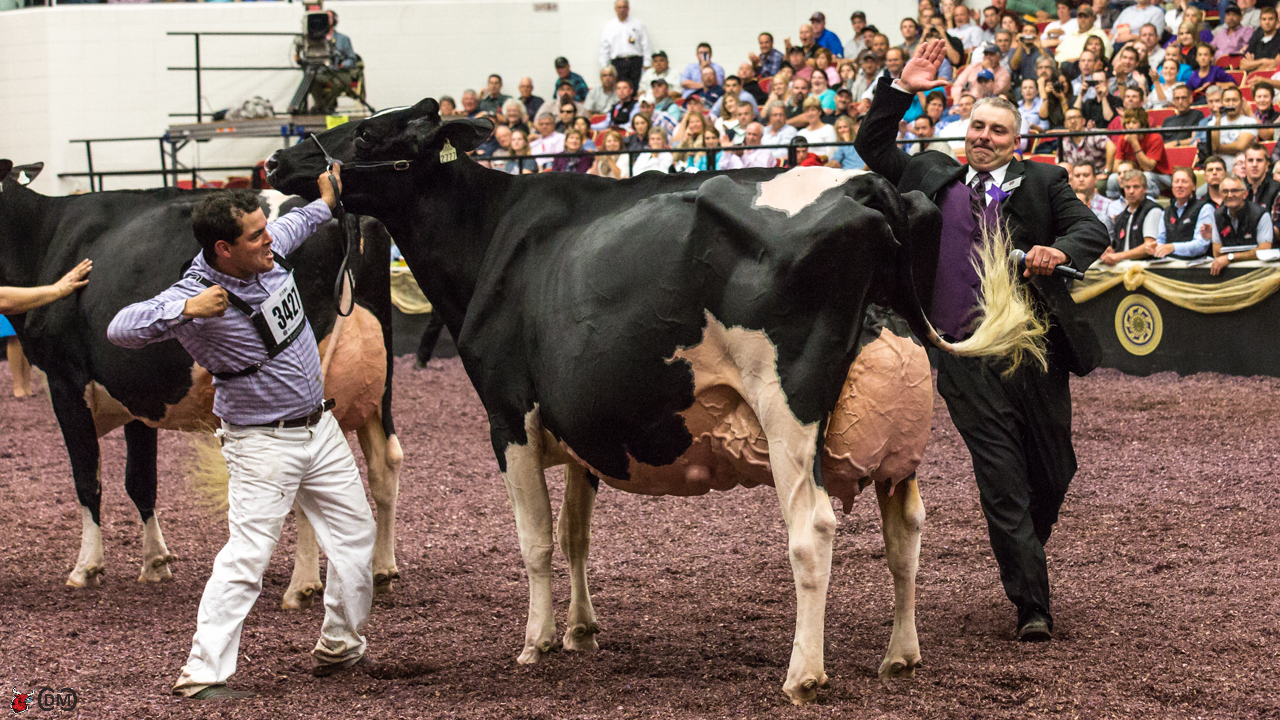
Bonnaccueil Maya Goldwyn EX-95-2E
Supreme Champion of World Dairy Expo
“Magic Can’t Be a One Time Thing”
You might be tempted to say that Christmas came early for these Canadian breeders. However this outstanding success in 2013 wasn’t confined only to October. Or only to the showring. In March Ferme Jacobs received their third Master Breeder Shield. This represents three shields in three generations and, according to the Jacobs, teamwork earns the credit. “We are very proud to be on a team that goes on from generation to generation. Now we are looking forward and striving to have our 4th one someday. As long as the passion for good cows is there, the success will follow.” Ysabel & Yan have the experience to admit. “There is no such thing as overnight success when you are developing cattle from the time they are born to the time they show.” Obviously, there are a lot of years of work behind the success and this year set two new benchmarks. “This was the first time Ferme Jacobs won Premier Breeder and Best 3 females at the 6 major shows we went to. This also was the year we had 3 cows out of 4 in the Bred and Owned Championship at World Dairy Expo and won the Exhibitor award at the Royal with bred cows and heifers!” In somewhat of an understatement they sum it up modestly. “All together these wins made it a big year for us. The best we have ever had!”
“It takes Working Together and It Takes Focus”
Ysabel describes what is needed. “It takes lots of people around us to make this happen but mainly, Dad, Mom, Yan and Veronic and Tyler and I. Dad is a “perfectionist”. Everything has to get done on time and in a perfect way whether it’s in the barn or in the field. Mom is the greatest mom you can have. She is a hard worker that supports her kids and grand kids all the time.”Ysabel feels strongly about her brother’s impact on Ferme Jacobs. “Yan has a grand passion for true type Holstein cattle. He is always in the barn working with cows to have them look the best they can.” The dialogue between Ysabel and Yan is frequent and that’s why it works. “One of our keys to success is that we must call and text each other 25 times a day. All this even though we live right next to each other and work together!!!” We also have the support of our sister Laurie, who attends university and Kevin who has started a new farm with his wife Stephanie.
“There is a Secret Formula that Always Works for Ferme Jacobs!”
It is human nature to want to know the “secret” behind the magic that inspires us. For Ysabel and her husband Tyler Dorion it always comes down to “family” (Read more: Success is All in the Family at Ferme Jacobs). With such a big show season the family support is vital to their success says Ysabel. “At home, Dad and Mom are there full time when we are at the show. They will arrive at the show half way after the heifer show starts. Usually they arrive with all the kids and Yan’s wife Veronic. They always do chores and make sure everything is fine at home. Brother Yan will be there the night before or early that morning. Tyler usually comes the night before too! That’s the way that works best and is the way we’ve done it for a long time.”
“The Show Magic Depends on Hard Working Teams!”
When you’re on the outside looking in, it often appears that showring success comes easily. We forget that, in reality, there is a tremendous amount that goes on behind the scenes and it requires teamwork both on the farm and at the shows. Ysabel & Yan outline what is involved. “When Ysabel leaves for the shows, she often goes with her sister Laurie, her cousin Sam Drolet and her cousin Sonia Laganiere. The night man has an important job on the show crew. It takes somebody reliable and dedicated to do this job like Jason Agnew. We also have two clippers that work together. This year they were Pier-Olivier Lehoux and Mathieu Jalbert who has joined our team lately. We also work on show day with our past fitters for many years, Jonathan Lemay and Grabriel Richard (Cachou). On show day many other people like Kevin Jacobs, Xavier Lemay, Sylvain Cabonneau and Joelle Saucier who help make this team stronger year after year. As well we have a trainee every year who helps at the show and looks after the show cattle at the farm. This year Phillipps Whatman from Australia worked with us for nine months and went with us to almost every show. Of course, what makes it work so well is that we have a team at the farm that also believes in what we do at shows. The secret of the team is they all want to win, so everyone will have done their part to make the animals look their best on the show day.” She sums up the results realistically, “After that it’s the judge’s opinion.”
“There Must be a Method to Mastering Seven Shows On the Road”
The logistics of Ferme Jacobs show season are huge. “We go to 7 shows a year. Quebec Spring Show (17 head), Trois-Rivieres (18), Portneuf (8) (Local show), Quebec Provincial Show (22), WDE (18), EIHQ (20) and the Royal (15).” Ysabel feels that decision-making is working well. “To know who is going to the shows is simple. We bring out the one we like. Sometimes we try a new one or we hope for one, but as the show day comes, we know if we were right or wrong. We always have a few heifers on the show program and before the show we look at them on the walk and if we like them we take them. They usually skip a milking in the morning and around 1pm we look at them full of milk, and once again we bring out the one we like or we try a new one and see.
The Most Important Achievement for Ferme Jacobs is Always “The Next One!”
For breeders who have tasted showring success there never comes a time when they feel they have done it all and that it’s time to stop! “When you have a good year, the market is really good. So far we have had good year every year since 2008. Marketing embryos is there for those cow families. We flush for what we believe can be good for us and we always keep a few for export at the same time. This year, we feel that we needed extra help for marketing embryos and so we had Frederic Fillion join our team. On the cow side we have had a good market for good pedigree cows for a few years. We have a lot of cows that are good enough for breeding from and to start a good flush program for a new farm.” For Ferme Jacobs there are some that they are watching to produce some more magic. “Jacobs Goldwyn Valana will be calving out as a 5 Year-Old. We also have two 4 Yr Olds calving, Blondin Alexander Armana and Jacobs Atwood Melody, that look really good.” With modest understatement, she sums up the future. “We are hoping that we can find some more heifers to show and that we can calve new cows to show to everyone one more time!” Voila!
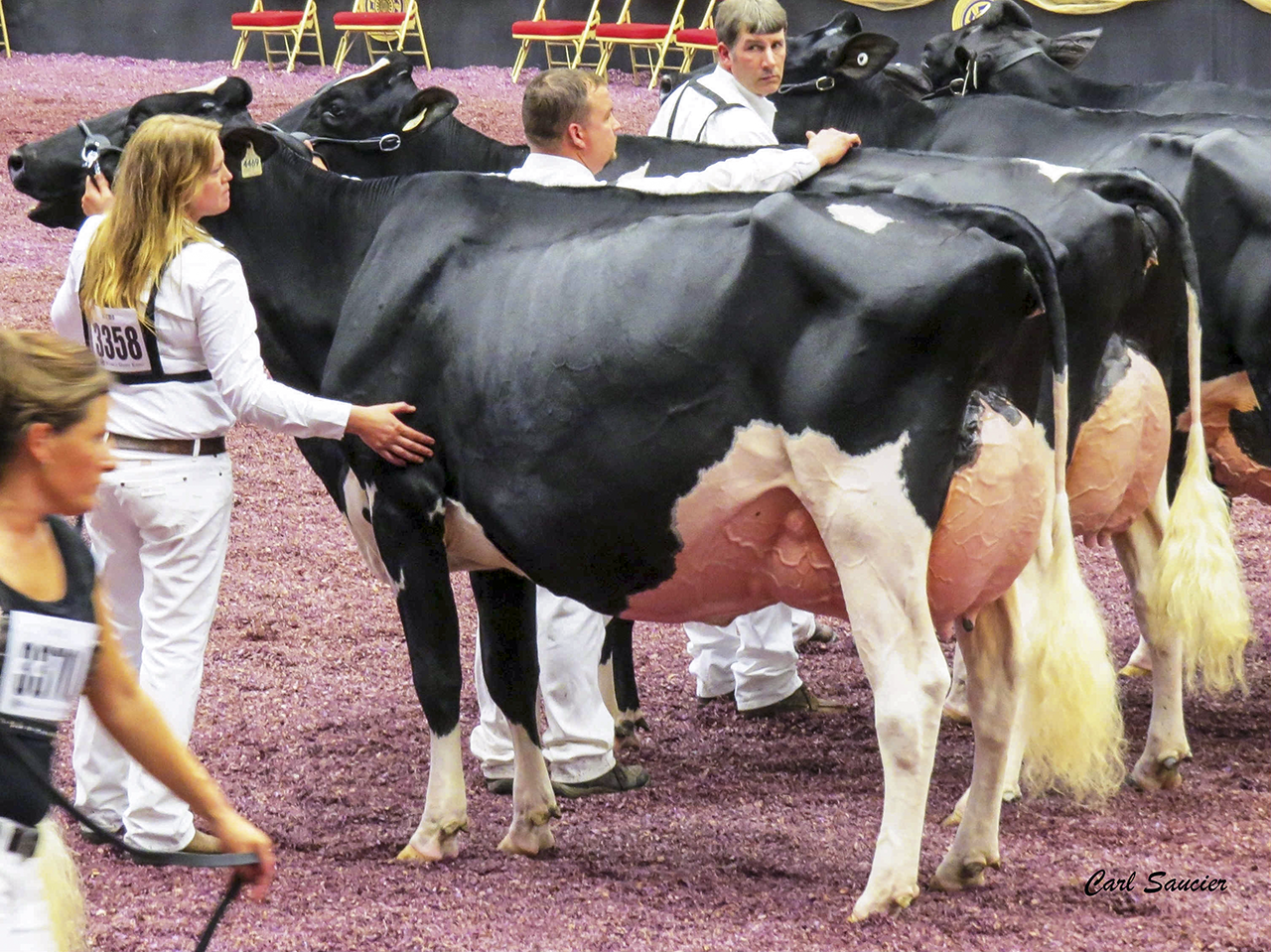
Jacobs Goldwyn Valana
“Ferme Jacobs Stays Connected and Shares Their Passion”
“Winning the breeder banner for the first time at WDE in 2011 opened the market up for us! World Dairy Expo is the best marketing show that you can have. You have the time, the place and enthusiastic people from all around the world looking at your cattle.” Ferme Jacobs also uses technology to keep in touch with the dairy marketplace worldwide. “We use Facebook and the Internet. You can reach so many people. Quite often it is simple news bits that raise the interest of other breeders who are as passionate as we are about cattle. It’s fast news and it’s quick and easy. All you have to do is “LIKE” Jacobs Facebook page if you haven’t done it already!” She says laughing before getting more serious about the effectiveness of the internet. “Our small videos that we’ve done on different ideas are followed by a lot of people. Some of our videos have been seen more than 10 000 times.” She enthuses about why this method is good for everybody. “Those videos give everybody the chance to see great images of the cattle, of the farm, from shows… etc and by using FACEBOOK to promote them, it’s perfect. Fast news once more. Remember people are busy. Especially farmers. So we have to provide small news. Videos are perfect when you are tired and you just want to look without reading.” Magical!
“They Stand Out Because They Never Give Up!”
Ysabel is quite realistic about show results. “There is little difference between a 1st to a 5th place and it’s usually decided in the first six seconds that the judge looks at you.” She does not find this discouraging. “To be between 2nd and 5th just gives you more reason to come back stronger next show or next year… We are hard workers and never give up when we believe in something… We will do the extra hour of work 365 days a year to make those cows look better on one day. That’s why our kids know all the show cows and they’ve been heard yelling their names at the show! For them they are cheering on the best of the best!
The Bullvine Bottom Line
Not everyone can have the kind of year that Ferme Jacobs has experienced in 2013 but many can appreciate the passion it takes to aim for it. Ysabel sums up what reaching the pinnacle of success at World Dairy Expo meant to Ferme Jacobs “There is a magic energy around that show ring that you cannot find anywhere else.”
The Bullvine congratulates Ferme Jacobs on capturing both the magic and the mastery in 2013! That’s SUPREME!
Get original “Bullvine” content sent straight to your email inbox for free.
The story of Ferme Blondin is partly the history of a family farm and partly the story of dedication to a dream of showing and selling exceptional dairy cattle. Simon Lalande speaks of how both have had an impact on him and the St. Placide Quebec dairy operation. “I am the 7th generation on the farm and when I was young, the herd was entirely grade cows. I always enjoyed looking in the magazines and, seeing all those great cows, I hoped to have those same kind of cows in our barn one day!” That day has come for Simon and his partner Kim Côté.
Shared Passion Inspires New Directions at Blondin
Successful dairy operations always tell you that they have invested in the cattle and people they feel most passionate about. Many times that passion is caught from other people in the dairy industry, as Simon Lalande confirms. “When I was a teenager, I had couple friends that were passionate about cows. My parents were sending me to some sales in Western Ontario with my good friend François Paiement (Ferme Mystique) where I had a specific amount I was allowed to spend on one or two cows, depending on how much I was spending on the first cow.” Simon appreciates his parents for opportunities such as that one. “I am very thankful to my parents for the trust they put in me since from a very young age.” From that first responsibility Simon continued to travel to learn about, talk about and buy cattle. “I always enjoyed going on the road and meet with other breeders and that’s what brought me into the cattle sales business.” Because Simon loved to get together at auctions, in barns and in the show ring, it was a natural next step to develop Ferme Blondin into an elite cattle sales and show operation. “Today Ferme Blondin has 90 cows milking and the herd has a total of 550 head including dry cows, replacement heifers, recips and baby calves.” The new direction has impacted the financial picture as well says Simon. “More than 75% of our income comes from cattle and embryo sales and the rest from our 118 kg of quota and cash crop.”
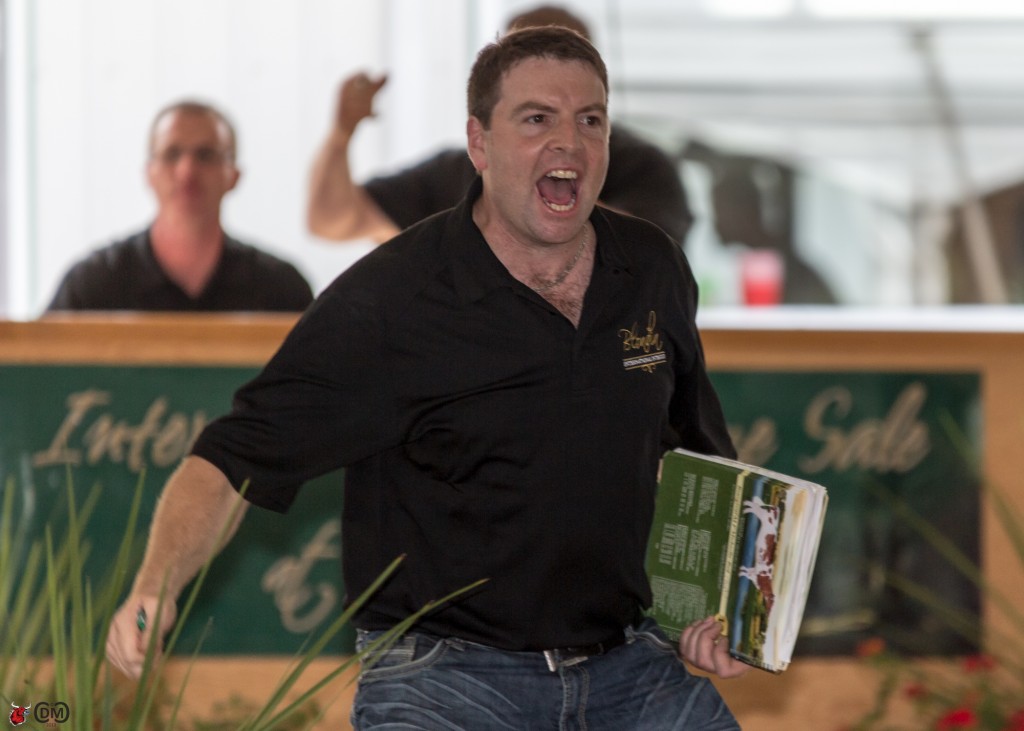
Simon Lalande’s passion and excitement for great dairy cattle is 2nd to none.
Great Blondin Teamwork in the Show Ring and Behind the Scenes
With such an evolving business, the team members at Blondin also have a variety of skills that keep the multi-faceted business running smoothly. “I am in charge of all the management decisions, cattle sales and purchases.” says Simon as he outlines how everyone pulls together. “Kim does all the paperwork which involves not only accounting but also registering calves, import & exports, genomics and bull sales.” Simon emphasizes what a challenging job this is.
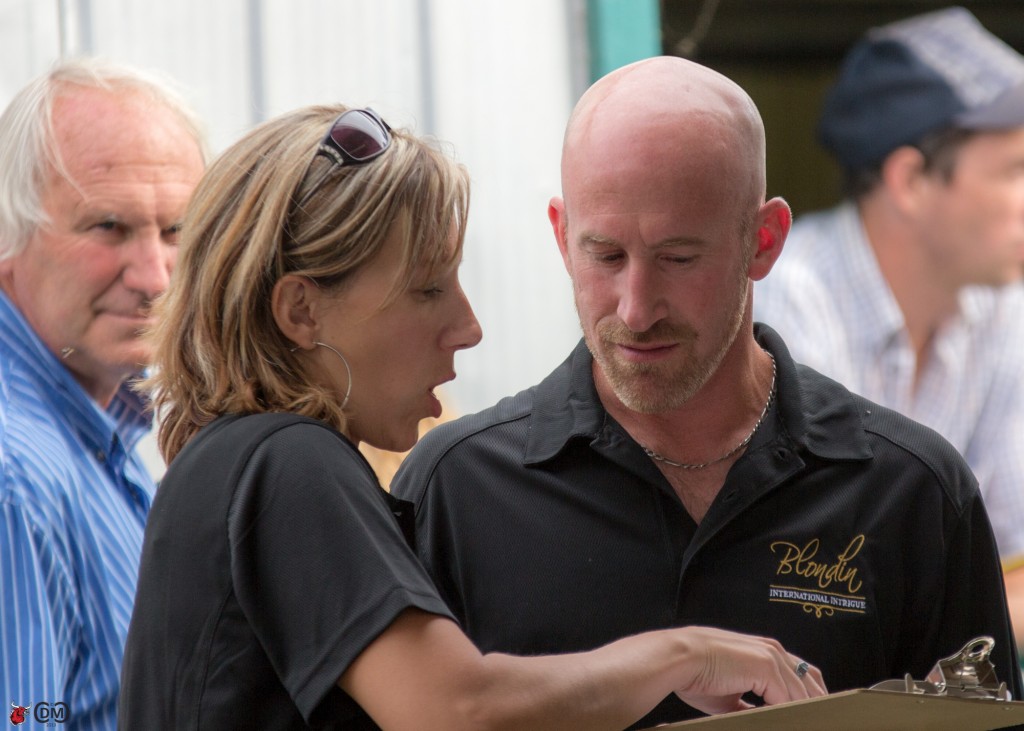
Kim Côté is a big part of the success. She and Simon make the perfect team. They are extremely passionate, hard working and committed to achieving success.
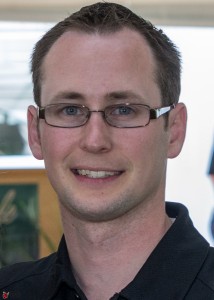
Dann T. Brady is the Sales and Marketing Manager for Ferme Blondin
“Accounting is a big challenge at the farm as we have more than 225 animals owned in partnership!” He goes on. “Dann Brady is in charge of all the marketing and embryo sales and we also have Jenny Henchoz part time that updates the website and assists Kim & Dann when necessary. “ On a day to day basis there is a lot of work to do acknowledges Simon. “I have very good help with Richard Villeneuve (our herdsman for 10 years) that manages all the barn crew and the herd, and Marc Ringuette (that works with us for over 20 years) who manages the field work and keeps the machineries and buildings in good shape. We also have Chris (from Belgium) that assists Richard and Marc, Tommy (from Japan) and Jonatan & Moris (from Guatemala) that are helping with chores and cattle care. My father (Louis), Kim’s father (Guy) and my uncle Rosaire are helping part time with fixing the machineries and for the crops.” Blondin family rounds out the team. “My sons, Olivier & Nicolas, are also working with us. Nicolas is working part time at the farm and is studying at the college and Olivier is finishing his third year at McDonald College and will be with us full time early this summer!” Five year old twins, Thomas and Anthony are the youngest team members and no doubt represent a lively part of the Blondin’s love for cows, farm and family!!
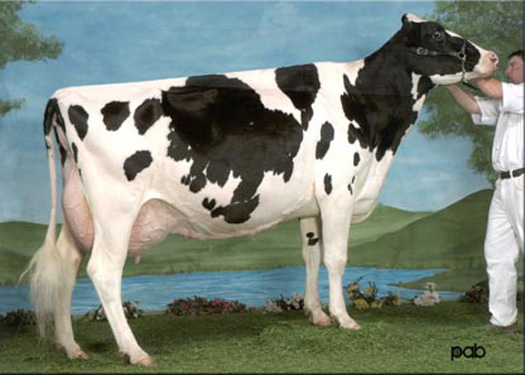
Blondin Skychief Supra EX-93 3E 24*
Cattle Families are Important to Ferme Blondin as Well
A dairy operation such as Ferme Blondin is built on the ability to breed cows that milk, reproduce and show. Simon talks about one particular favorite. “The greatest cow I ever bred is Blondin Skychief Supra EX-93 3E 24*. She comes from one of the first purebred heifer that my father purchased as a gift for me at the 100th Anniversary of Holstein Canada Sale in 1984. Her dam is a Starbuck and for me at that time, Starbuck daughters had very good legs but average udders and Skychief had average legs with awesome udders. Ten years after this mating, Supra became the foundation cow of the Blondin herd.” Blondin success has also been impacted by cows that have been purchased “The greatest cow I ever owned is Rockymountain Talent Licorice EX-95. I bought her at the WDE in 2010 as a fresh Sr 3Y Old. I fell in love with that cow at first sight. For me, she was a total package: Red carrier from a world famous cow family (same as Lotto, Lynley and Lustre), amazing sire stack and one of the best cows I had ever seen (tremendous udder, good legs and impressing dairy strength)!!!”
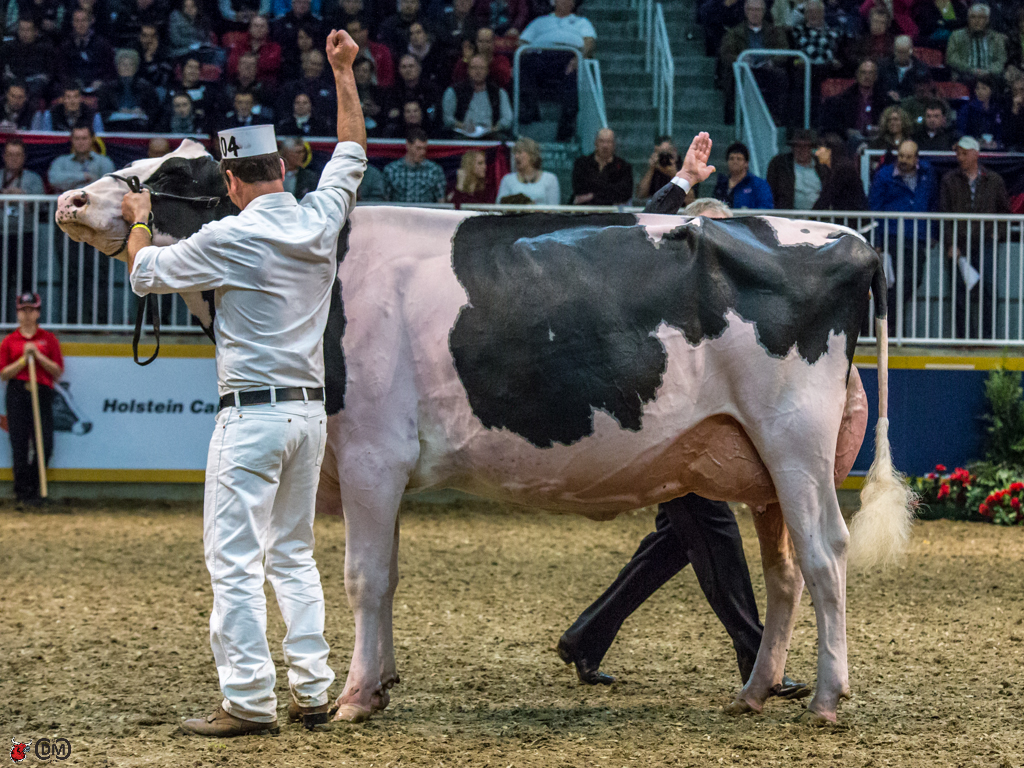
Aingers Advent Bambi *RDC EX-91
Intermediate Champion Royal Winter Fair 2013,and EIHQ 2013
Best Barbie Forward
Every passionate dairyman loves to talk about cow families and the difference developing a strong female line can make to developing a strong herd that is attractive to buyers and herd builders. “I always have been a big fan of the Barbie family, that’s why I bought with François Paiement a full sister to Chassity: Regancrest S Celebrity EX-94-9. She is one of the most popular cows in the barn when we have international visitors as she catches the eye with her impressive dairy strength and udder. We are also working with Blondin Talent Salena-Red EX-93, which is a maternal sister of the famous Blondin Redman Seisme EX-96 and her Destry daughter, Blondin Destry Sally TB-87 2Y Old (owned with Dupasquier). She was 2nd Sr 2Y Old at the Royal and 4th at WDE in the R&W. We have a lot of expectations for this young cow in the future! One of our best cows right now is Aingers Advent Bambi *RDC EX-91 3rd calf, 3Y Old (one of the youngest cow to classify EX in Canada). She was Intermediate Champion at the Qc Fall show and the Royal! She will be flushed this winter and already has many embryos sold but we are also excited to make some calves out of her!”
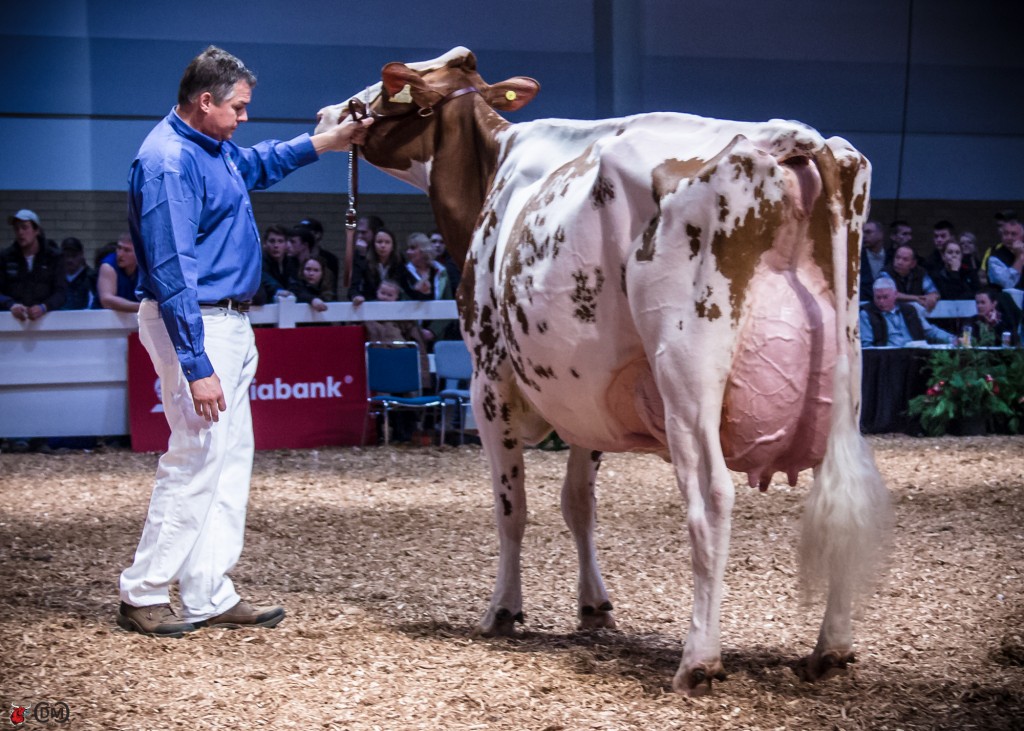
Blondin Redman Seisme EX-96
Grand Champion R&W Royal 2012
Res. Supreme Champion Royal 2011
Grand Champion R&W WDE, Madison 2010 & 2012
Supreme Champion Royal 2010
Going Once … Going Twice … Going for Many Years
We all love the excitement of the auction ring and the show ring but having success in the spotlight must be built on breeding success in the barn. “We want to breed good balanced type cows that can produce a lot of milk for many years because we think this is what every dairy producer wants to have in their barn every day.” Simon talks about his philosophy on sire selection. “When possible, we are still using Goldwyn a much as we can. He is the best bull that the breed ever had and we still can see it in the show ring and everyone barns… The only problem we have is that we already have a lot of Goldwyn daughters or granddaughters!!! We are also using Windbrook, Aftershock, Sid and Cancun as proven sires and some of the best genomic bulls available (different ones every month) on our genomic cattle. “
Blondin Marketing Stands Out Inside the Show Ring
One of the unique strategies used by Ferme Blondin is that they see the showring as a marketing tool. “For us, one of the best ways to market our herd is the shows. This is the best way to show everyone what you have special in your herd type wise. We like to consign some high caliber animals in some sales (which gives a lot of visibility to the farm). We are also very active on Facebook and it is important for us to keep our website updated weekly. We advertise in the most popular magazines in Canada and United States but also like to advertise in other countries.” Regardless of the method, Blondin wants their customers to get lasting value.
Expert Advisors for Everyday Challenges
It’s hard to point to a single person or event that has had the most impact on growing this great dairy or sales operation. Simon feels fortunate to have several role models that have influenced him. “François Paiement, my brother-in-law (Ferme Mystique) was AI technician and was coming at the farm when I was a young teenager. He transmitted his passion every time he was coming to breed a cow by talking to me about the bulls and cow families. Charles Ménard (Ferme Rubis) taught me what a good young cow was and how the udder and dairyness were the most important parts of the cows. When I was 17 years old, I went to learn my English at Don Johnston (Cherry Crest Holsteins). He taught me a lot on cow families, how to keep your cows and how important it is to enjoy what you do every day. These three good friends are still very close to me and if I need any advice, I still contact them to have their opinions.”
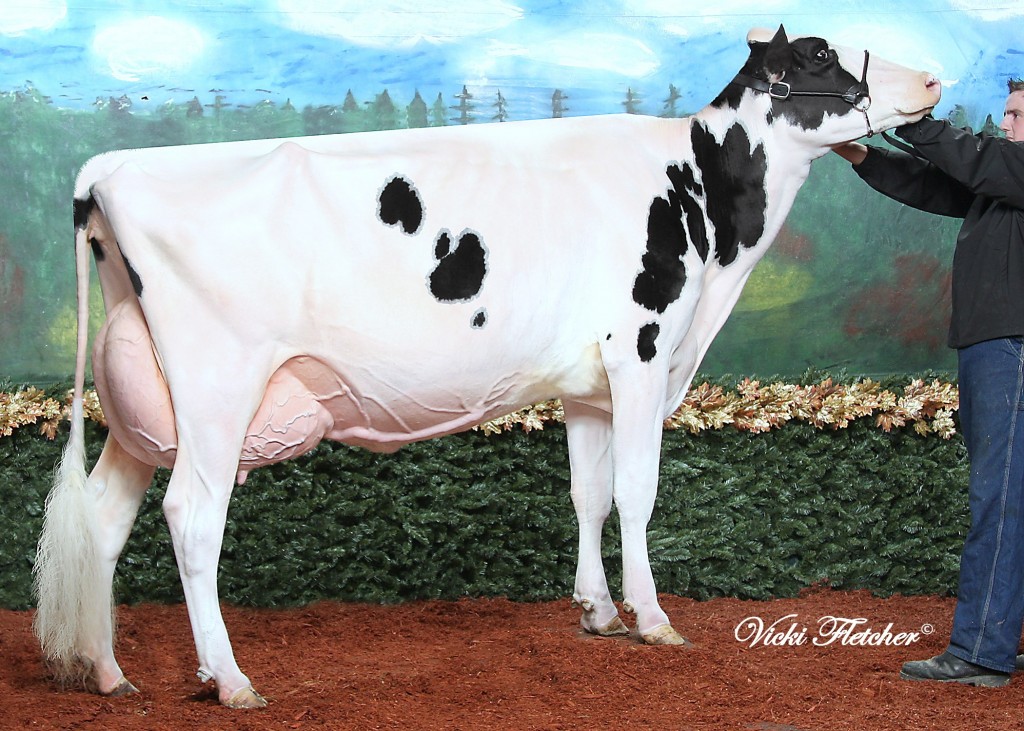
Blondin Lyster Beauty EX-93
Intermediate Champion The Royal Winter Fair 2007
Success is Golden for Blondin
Many of us in the Canadian dairy industry are familiar with the growing achievements of Ferme Blondin. Kim and Simon are justifiably proud of their progress toward the goals. “Two of the best successes are the Master Breeder Shield we won in 2002 and Canada’s cow of the year in 2009 with Blondin Skychief Supra because this is a breeder’s dream. I am also very proud of the 6 Premier Exhibitor title won at the Royal and/or the WDE and the three Intermediate Champions at the Royal in the last 7 years with Blondin Lyster Beauty EX-93 in 2007 (as a Jr 2Y Old), Rockymountain Talent Licorice EX-95 in 2010 and Aingers Advent Bambi EX-91-3Y in 2013.”
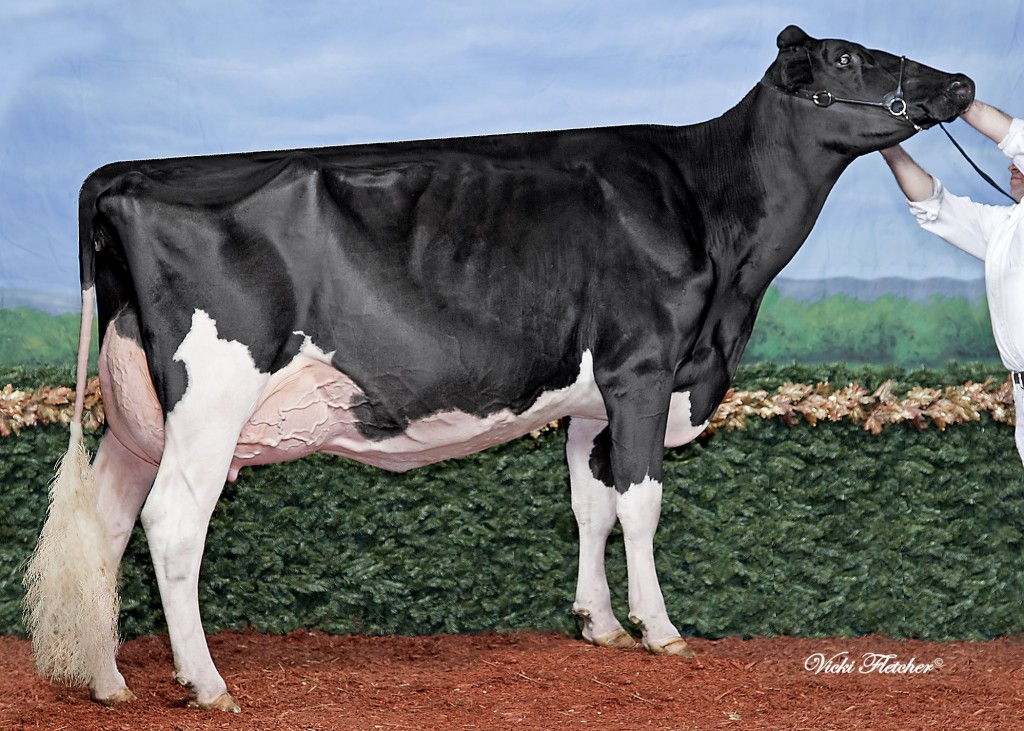
Rockymountain Talent Licorice EX-95
Intermediate Champion The Royal in 2010
Growing with Goldwyn and Genomics
Of course as the years add up, so do the changes that affect the dairy industry. “The biggest change I have seen since the last 10 years is the dairyness and the udder qualities of the cows. For sure, a bull like Goldwyn helped a lot for that!” Change has also been affected by technology such as genomics and Ferme Blondin has moved quickly with those changes too! “We have decided to invest in the genomic cattle because we think this will help us to breed better cows for the dairy producers to work with every day (lower ccs, temperament, fertility, calving ease…). This is also a good marketing tool for us as there is a good market for these animals and their embryos but cow families have to be there first.”
Facing Future Challenges
Today Ferme Blondin is comfortable at the leading edge and always seeks to share that passion with others who dream the dairy dream. It isn’t without its challenges admits Simon. With herds that are getting bigger and bigger, we will have to breed cows that will be able to live in big groups. That’s why we think health traits will be more and more important in the next few years. Although, we think there will still be a market for exceptional individuals (genomics, show or cow families).”
The Bullvine Bottom Line
Simon is proud of previous generations and he and Kim are working hard to shape how the future will unfold at Blondin. At the Bullvine we wish Ferme Blondin all the best as they continue to leave their legacy on the dairy industry by using the philosophy that Simon and Kim share. “Success is built on three simple things: passion, hard work and perseverance!!”
Check out the details of their upcoming Vente Blondin-Sicard sale on February 20th.
Get original “Bullvine” content sent straight to your email inbox for free.
Sometimes when a person is presented with an award in the name of an industry icon, your mind just goes “click” with the realization that he is the perfect fit for what was intended. Such was the case when Alberta Holstein Director, Orville Schmidt, announced the 2013 winner of the Curtis Clarke Achievement Award. “Jeff Nurse of Monteith Holsteins.” (Read more: Jeff Nurse named 2013 Curtis Clark Achievement Winner) As this quiet dairyman from Georgetown, Ontario took his place as the 27th recipient of the award, the crowd roared their approval.
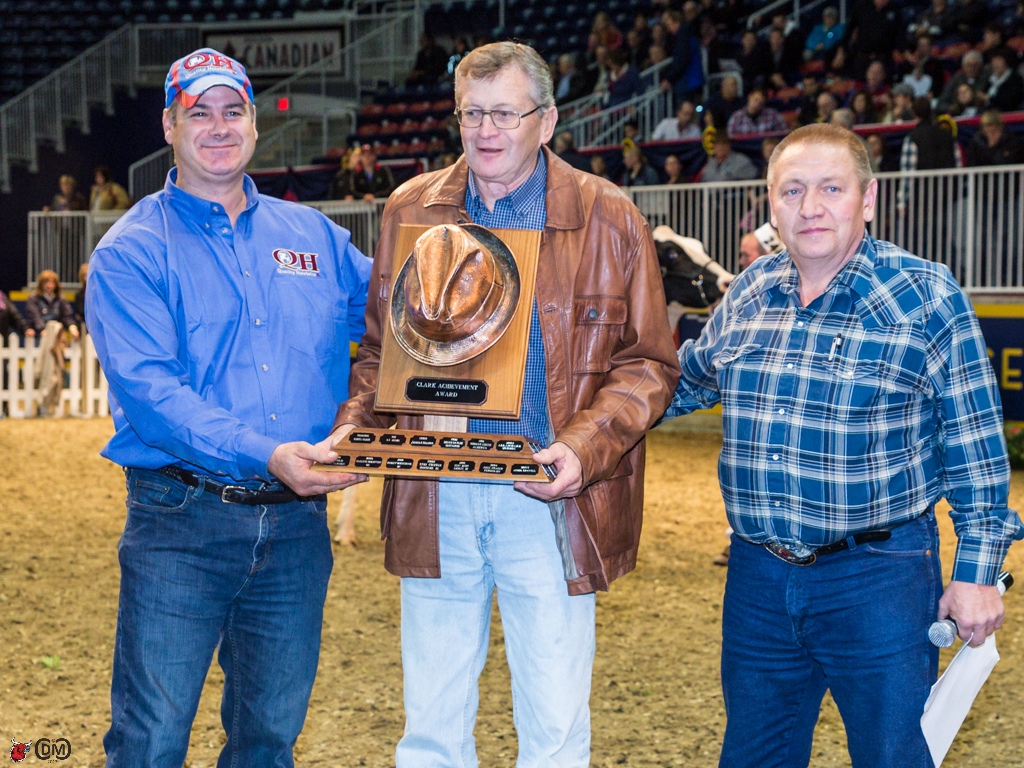
Jeff Nurse receiving the 2013 Curtis Clark Achievement Award from 2012 Winner Don Schwartz and Orville Schmidt.
Jeff is A Man of Few Words and Many Talents
Although Curtis Clarke was an entertaining story teller, like Jeff Nurse, he preferred to talk about cows, friends and family much more than updated the list of awards and achievements that hard work has earned him. The Curtis Clarke Achievement Award seeks out those dairymen who possess “the ability, sportsmanship and character necessary to be respected by fellow breeders and showmen.” It was pretty emotional at The Royal. I really didn’t expect to be considered so I was kind of in shock. I had a world of respect for Curtis Clark and for the group of men who made the selection so it made the Award really special.” In addition to having his name added to the distinctive Clark trophy which bears a bronzed version of one of Curtis Clark’s hats, Nurse also received a gold belt buckle as a personal keepsake of the honour.
Nurse Appreciates a Great Lineup
Whether it’s Holsteins, Ayrshires, Brown Swiss or Jerseys, Jeff has enthusiastically milked, shown and judged them. In fact, his interest in the Royal Brown Swiss Show on November 8th definitely increased the difficulty his family had in getting him to Holstein ringside for the award presentation. Once focused on where he was expected to be, Jeff probably saw moments of his Holstein history playing in his memory. “I grew up with Jerseys and was reluctant to get into Holsteins at first. There were a lot of really great Jersey people in our county at that time. When Kenda and I married, she brought a few Ayrshires with her but I always admired things about Brown Swiss so was interested in working with them too.” Having said that, Jeff saves a special place for the black and white breed. “I’ve never found anything to outshine the Holstein Breed.”
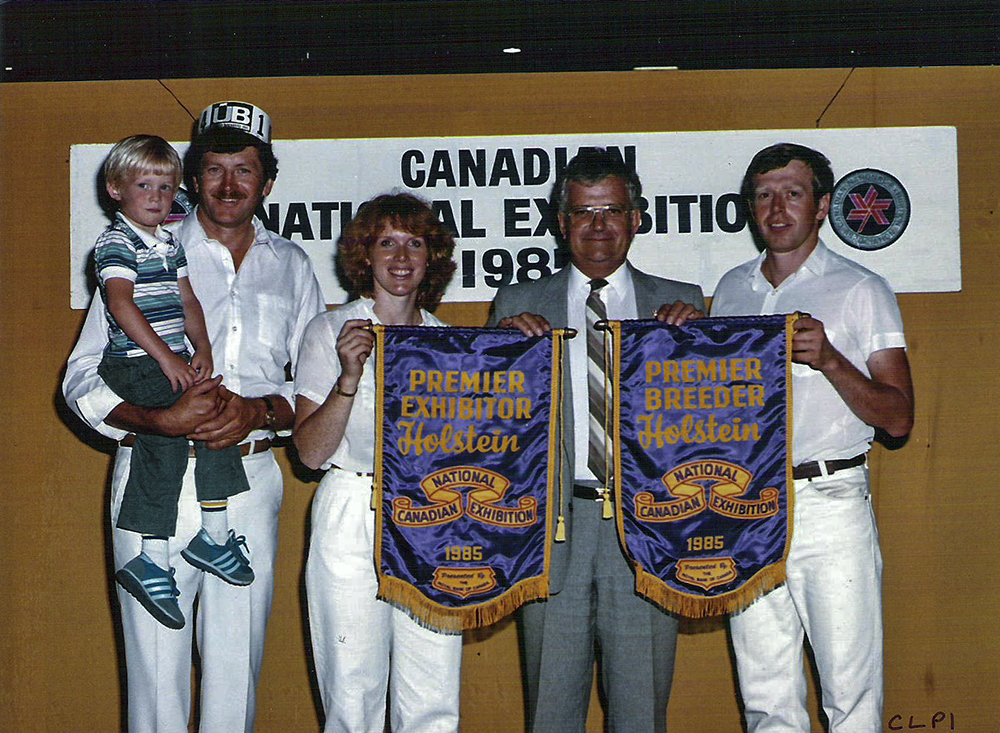
Jeff and wife Kenda and son Lee accepting the 1985 Premier Exhibitor award at the Canadian National Exhibition from Joe Snyder. Peter Christie won the Premier Breeder Banner.
Nurse Family Legacy from Rural Roots to Urban Setting
My father gave me the pick of a pen of Nurseland heifer calves when I was 16 to start my own herd and prefix. Five decades later he milks 40 Holsteins and 4 Brown Swiss and is farming with his own son, Lee. Monteith owns 150 acres and rents another 150 to grow corn, soybeans and wheat. The circle of farm life may see further turns in the future. The time is coming when they hope to relocate to another farm further from urbanization where they can expand and grow their herd and land holdings. Nurse has bred many Excellent and Very Good cows and in 1994 was recognized with a Master Breeder Award from Holstein Canada.
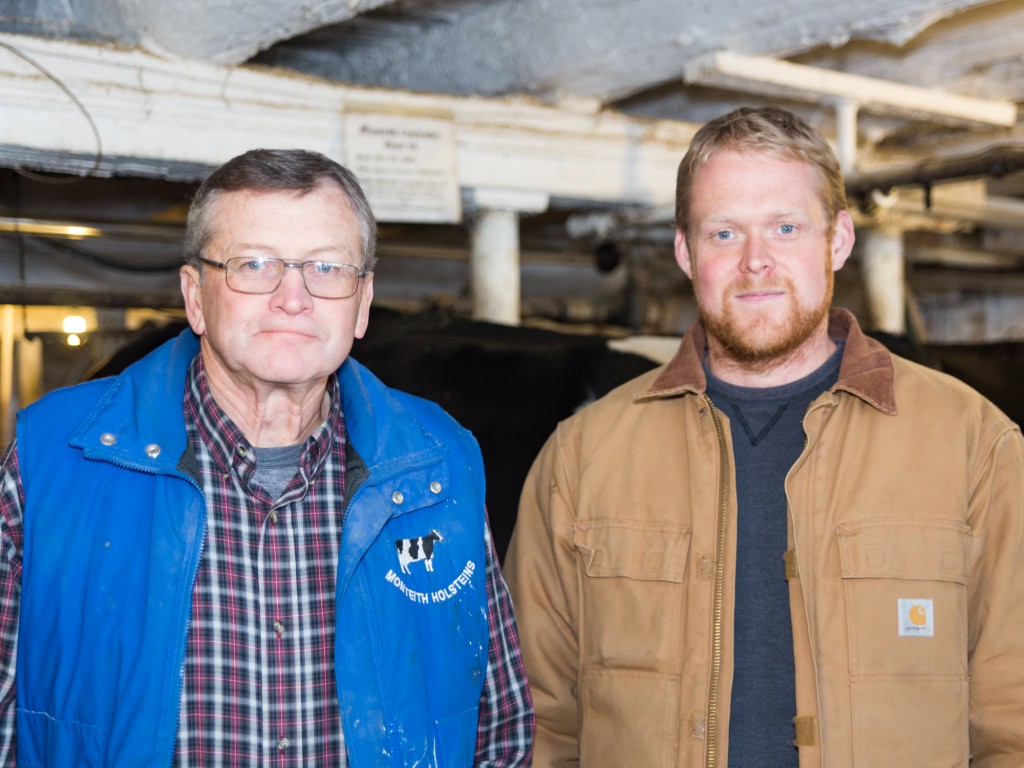
Jeff Nurse and his son Lee farm on 300 acres south of Georgetown Ontario.
“They Have a Good Mother”
Jeff and Kenda have also grown their family. “We have four great kids that I`m really proud of.” says Jeff, who can talk much more comfortably about the achievements of Lee, Jodey, Cristy and Troy and two granddaughters then he can about himself. Of course he credits each one with exceptional talents individually but also knows it takes more than that. In fact he points out, “Number one! They have a good mother.” From the outside looking it is also fairly obvious that both parents encourage and empowerment and utilized their unique talents to achieve their own goals. (Read more: Cristy Nurse: From Show Ring Beauty to World Class Rower and Cristy Nurse – Standing Tall) In talking together after Jeff achieved the Curtis Clarke Award, Kenda reports that some of Jeff’s reminiscences were somewhat unexpected. “He surprised even me and we have been married 33 years!” Together they make a great team with a shared philosophy on child-rearing. “We have tried to give them all a chance to try a lot of different things and support them but not do it for them.”
Jeff is a Man of Many Hats
The iconic Curtis Clarke was recognized everywhere for his hat. Jeff Nurse also stands above the crowd with his quiet presence. However, he prefers to wear many hats figuratively speaking. “I enjoy a variety of jobs – not in the barn all the time and not in the field for days on end.” He has seen many changes over the years and sees many of them as good. “Round up ready soybeans have been great! We can have a totally clean crop with just one spraying. We used to plow everything – now minimum tillage on some land works well. On the dairy Theracalcium treatment for fresh cows has worked miracles!!” Jeff knows that each generation faces challenges and knows that the future will have them too. “I hope the next dairy generation can enjoy working with cattle as much as I have – only in a more efficient way. It may not be efficient but the way Jeff supports and gives back to dairy youth is definitely encouraging. Gives 110% of time effort and farm and calf resources to assist 4-Hers both farm and nonfarm as a leader and role model. This puts him at ringside at numerous fairs which he professes to be “my idea of a great holiday!
Monteith Shows Their True Colors
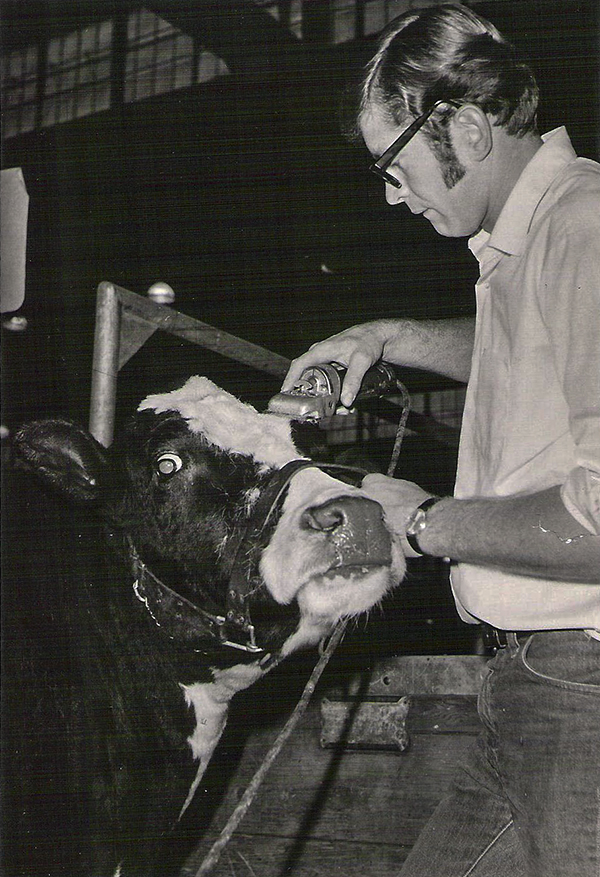
Jeff Nurse clipping Nurseland Texal Rose Marie
at The CNE 1971
Nurse, 67, has shown cattle locally, regionally and at the Royal Winter Fair and World Dairy Expo. My mother and father were great help in getting started. My father would borrow my Uncle’s truck to get our cows to the local fairs before I started hiring a commercial trucker, goose necks were not invented at that time. Monteith Model Lana was a favorite for a lot of reasons. Shown in 71-72, she was a big bodied cow with a great udder, terrific temperament and could really milk with a high test. She was second at The Royal and Reserve All Canadian. I sold a Rowntree Northern Prince daughter to England for $10,000 (a lot of money at the time) that bred really well for David Alford; leaving one of the top bulls in England in Whipton Landlord. Unfortunately, Lana developed a problem in her reproductive tract that prevented a third calf. Nurse was an Official Judge for many years and in 1987 judged the Royal Winter Fair Holstein Show. In addition to judging many shows across Canada, he has judged internationally in Mexico, the United States, Scotland, Brazil, Colombia and Argentina. Many things – the level of professional preparation at the cattle shows and the quality of cattle right down to the bottom of the classes…the mixing of the different breeds within the rows….the greater expense of showing cows at the major shows. In 1983, he and his family showed the Grand Champion Ayrshire at the Canadian National Exhibition and today they have a few Brown Swiss animals in the herd, one of which was exhibited at the recent Royal.
Nurses are Always Ready with a Warm Welcome
Whether it’s the cattle business, 4-H, Christmas trees or heavy horses, there are always numerous activities taking place at Monteith and you can always be sure of a warm welcome. This generous spirit was also a character trait of Curtis Clarke who lived large, laughed often and opened his heart and his home without reservation. If there was any chance you had not yet been bitten by a passion for dairy cattle and Holsteins, Curtis made certain that the oversight was corrected before your visit ended. Jeff Nurse is also obliging and generous with his time, feeling that he benefits the most. “It is really enjoyable because we get to work with a great group of young people. Unlike school, 4-H members are in clubs because they want to be. Their interest and enthusiasm make it fun.” No doubt the interest and enthusiasm that is reflected back from this caring and extremely hard working leader is an inspiration as well. Jeff happily shares advice learned over his career. “Try to find a good balance between getting away and seeing new systems, management styles and different philosophies; and getting things done at home! Some people are on the road too much and others don’t “get away enough”. Jeff is an observer and urges others to keep an open-mind and “Try to reference successful operations whether for nutrition, breeding philosophy or whatever management you need to improve.”
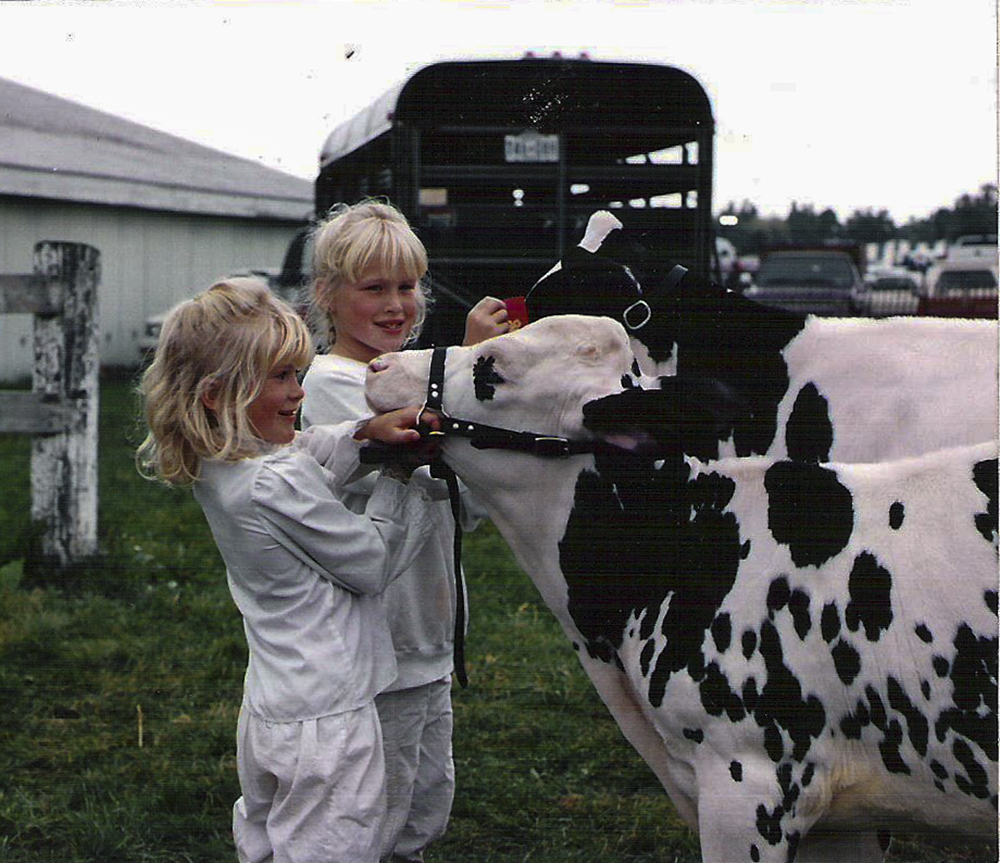
Exhibiting livestock has certainly been a big part of Jeff Nurses life, and he passed that passion on to his children. Daughters Cristy and Jodey (seen here) and son Lee showed their animals at many local and national shows.
Great Role Models inspired Jeff’s Enthusiasm for Cattle
Of course every excellent role model will tell you that they had excellent people to learn from as well. “Joe Snyder and Henry Stanley were probably the biggest influence on my ideas about cattle. Joe Snyder was an outstanding fieldman for Holstein Canada and I was fortunate to spend quite a bit of time with him on herd visits in our county, then Judging schools, and later Holstein shows. Joe was a terrific person and a wonderful role model in many ways. Henry Stanley was an exceptional Agricultural Representative in Halton County for many years. He came from Eastern Ontario and had a dairy background but was interested and knowledgeable in all types of livestock. Henry coached The Halton Judging Team when we won at The Royal and I was High Individual. Many other individuals come to mind including staff with The Holstein Association, many Holstein Directors and former Canadian President, Ross Segsworth. I was fortunate to be a neighbor of Claude Picket’s and Claude gave me a chance to show some outstanding cattle and meet a lot of Holstein people.”
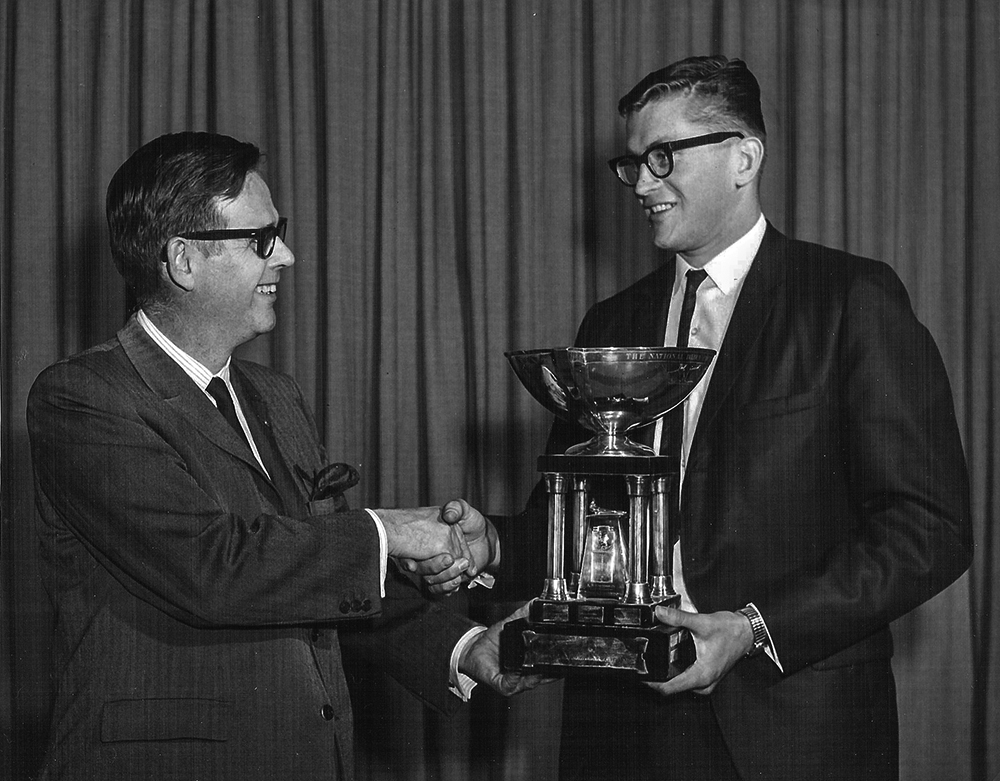
Jeff Nurse winning High Individual at The Royal Judging Contest in 1967
Family Man – Gentleman – Man of the World
Forty years ago Curtis Clarke welcomed Murray and I to his farm and home in Carstairs Alberta. To say he left an impression on both of us would be an understatement. Like Jeff Nurse, if you meet him once, you feel you have known him all your life. The Nurse family shares this hospitable nature with many tours for schools and other groups at their farm and have willingly participated in agricultural education days, loaning animals for displays. “It’s been a lot of fun!” acknowledges Jeff who neatly sidesteps all the hard work that makes such fun possible. The Christmas tree operation is another connection point with dairy and non-dairy friends and neighbors. “People enjoy the animals we have on display- the wagon rides to the field- the bon fires.” It isn’t the least bit surprising that his well mannered gentleman is happy with the response he and his family earn. “We get a lot of ‘Thank yous’. Sharing his passion for dairying is something that comes easily to Jeff whether at home working on numerous dairy committees or visiting or judging in other countries. It is only slightly surprising that this quiet but respected man has a somewhat unspoken goal.” I would like to learn to speak Spanish. I often wished I could speak to all the breeders when traveling in Mexico and South America judging shows and visiting farms. It’s a beautiful language.” Jeff has happily fulfilled many roles in the dairy industry and sees the future in a positive light. “I hope our family can stay healthy – be more progressive; but most of all I hope they enjoy what they do.”
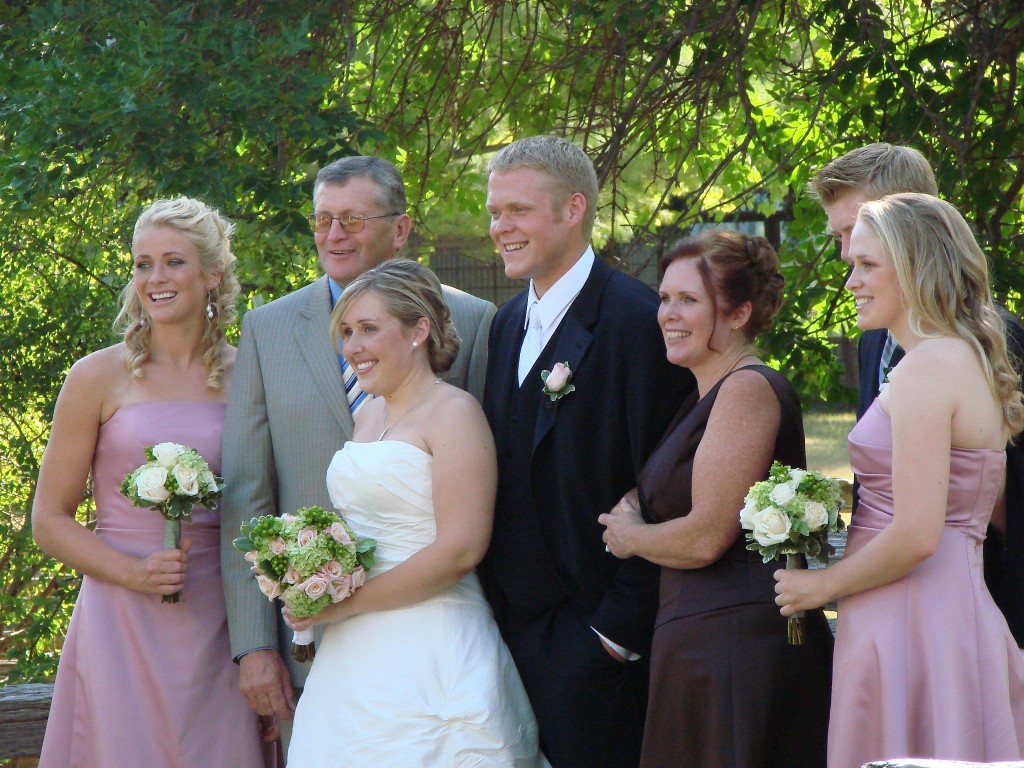
Jeff and his amazing family at son Lee’s wedding.
The Bullvine Bottom Line
Men like Curtis Clarke or Jeff Nurse are men whose actions as they say “speak louder than words”. They are positive ambassadors wherever they go. Congratulations Jeff Nurse on becoming the 2013 Curtis Clarke Award Achievement winner. Thank you for walking the talk and leaving a country gentleman’s trail for others to follow.
Get original “Bullvine” content sent straight to your email inbox for free.
Jeff Nurse of Monteith Holsteins, Georgetown, Ont., received the 2013 Curtis Clark Achievement Award at the Royal Agricultural Winter Fair in Toronto, Ont., on November 8th. He is the 27th recipient of this coveted award which was established in 1988 by the Alberta Holstein Branch to honour the lifelong contributions of the late Curtis Clark of Acme Holsteins, a highly respected Alberta Holstein breeder and showman. The award is presented annually to the dairy cattle exhibitor who possesses the ability, sportsmanship and character necessary to be respected by his fellow breeders and showmen. Selection of the winner is made by former winners of the award.
A modest man of high integrity, Jeff Nurse grew up on his family’s Nurseland farm which originally had Jerseys and later switched to Holsteins. He won many awards as a 4-H member for his judging and showmanship talents, including being the top judge and member of the winning Halton County 4-H team at the Inter-County Judging Competition at the Royal Winter Fair. As a young man, he was highly sought after for his clipping and fitting skills at shows and sales. After graduating with a Diploma in Agriculture from Kemptville Agricultural College, Nurse returned to the family farm. The Nurseland herd was dispersed a few years later and Jeff then established his own Monteith prefix and herd. Thames Crest Romeo Bertha (Ex), who was reserve grand champion at the Halton County Show in 1970-71, was a key foundation animal. Nurse has bred many Excellent and Very Good cows and in 1994 was recognized with a Master Breeder award from Holstein Canada. Currently Jeff farms together with his son Lee and they milk 40 cows. Lee recently assumed and registered his first calf using the farm’s original Nurseland prefix. In the near future, the family hopes to relocate to another farm further from urbanization where they can expand and grow their herd and land holdings.
Nurse, 67, has shown cattle locally, regionally and at the Royal Winter Fair and World Dairy Expo. In 1972, Monteith Model Lana (VG) was Reserve All-Canadian 3-year-old. In 1991, Monteith Miss Kansas (Ex-4E) was first 5-year-old at the Royal and went on to be All-Canadian for Nurse and partner Phyllis MacMaster. One of the most notable animals the Nurses have bred is Nurseland Pre Vicky (Ex-1*), a three-time All-Canadian who was junior champion at the Royal and World Dairy Expo in 1980 and reserve grand champion at the Royal in 1983 and 1986. Nurse appreciates a great cow of any breed. In 1983, he and his family showed the grand champion Ayrshire at the Canadian National Exhibition and today they have a few Brown Swiss animals in the herd, one of which was exhibited at the recent Royal. A true gentleman, Nurse’s passion for dairy cattle have always been more important to him than a ribbon or his name in a news story.
Nurse was an Official Judge for many years and in 1987 judged the Royal Winter Fair Holstein Show. In addition to judging many shows across Canada, he has judged internationally in Mexico, the United States, Scotland, Brazil, Colombia and Argentina.
Nurse has been a role model and mentor to many young people through his more than 35 years as a 4-H leader. He loans many 4-H calves to non-farm 4-H members and generously donates his time, money and resources to transport animals and youth to numerous fairs. “It is my idea of a great holiday,” he says of these journeys. Nurse has been part of many farm organizations. He is a past president of the Halton County Holstein Club, Halton Milk Committee, Halton 4-H Association and Georgetown Agricultural Society, and is a member of the Halton Agricultural Advisory Committee.
Jeff and his wife Kenda are the proud parents of four children – Lee, Jodey, Cristy and Troy – and two granddaughters. The family has hosted many tours for schools and other groups at their farm and have willingly participated in agricultural education days, loaning animals for displays.
A heartfelt Jeff Nurse says, “To get an award from a group of men who are as respected for what they have done, and they way they have done it, makes receiving the Clark Award really special to me.” In addition to having his name added to the distinctive Clark trophy which bears a bronzed version of one of Curtis Clark’s hats, Nurse also received a gold belt buckle as a personal keepsake of the honour.
For additional information, contact: Bonnie Cooper, secretary, Curtis Clark Achievement Award Committee, c/o Holstein Journal, 301 – 9040 Leslie Street, Richmond Hill, ON L4B 3M4, tel: 905-886-4222; fax: 905-886-0037; e-mail: bonnie@holsteinjournal.com
![1044772_138370643033411_538080046_n[1]](https://www.thebullvine.com/wp-content/uploads/2013/10/1044772_138370643033411_538080046_n1-300x300.jpg)
“The Without Compromise Kueffner Countdown”
Here’s the Kueffner Top 4 Countdown: FOUR Royal Champions in THREE Different Breeds; TWO World Dairy Expo Supremes in 2 Breeds and ONE All-Time All- American 4-year old. He looks back and urges simplicity. “Some people ask for advice from too many sources, and then they collect it all and don’t know where to go with it. Decide what kind of cattle you like and stick with it. Know the traits that are most important to you and don’t compromise when you are making mating decisions!” This particular focus has been the foundation Kueffner counts on, builds from and wins with!
“Good Ring Sense From Good Cow Sense”
If you`re thinking of ways to either start showing cattle or how to improve, Ernie has some advice derived from his observations. “I do think there are a couple things to watch. Rear udders have become extremely important – maybe too much so. I feel that fore udder attachments and teat placement play a bigger role in the longevity of a cow. And the emphasis on big rear udders in the show ring has increased the pressure to get the udders extremely full. As you watch the great cow classes at our major shows, you see many that have lost the definition of crease and the quality of their mammary. It is not attractive.” Having shared his thoughts about udders, he goes on to other areas that shouldn’t be overlooked. “Feet and legs is the other area I am concerned about. This is not always emphasized as much as I think it should be which may be related to the focus on rear udders. In reality, feet and legs will have much more effect on a cow’s longevity.”
“They’re Always Seeing Stars!”
Having developed superior Holsteins and Jerseys, it isn’t surprising that more than one have won special places in Ernie and Terri’s hearts. For Ernie there are three in particular. “They are – Tri-Day Ashlyn-ET, KHW Regiment Apple-Red-ET and Huronia Centurion Veronica. (Read more KHW Regiment Apple-Red – Beauty, performance, and even more record accomplishments, Great Show Cows: Can they pass it on? and The 12 Greatest North American Colored Breed Show Cattle of All-Time) All three are great cows – all have been Grand Champion at World Dairy Expo – two have been Supreme Champion at Expo – and all three have been voted World Champion within their breed.” As glorious as their show records are, what they have accomplished through their offspring (both sons AND daughters) for multiple generations makes them special in Kueffner’s eyes. “It continues on and on – it is amazing to me. You can talk about the best show cows in the world, but we all know that very few of them became respected brood cows. Some of the greats produced a good son or a couple nice daughters, but it is rare to have a cow transmit superior genetics to her sons and her daughters. Ashlyn, Apple and Veronica have distinguished themselves through what they have done both inside and outside the show ring. And they aren’t done yet – they continue to raise the bar.”
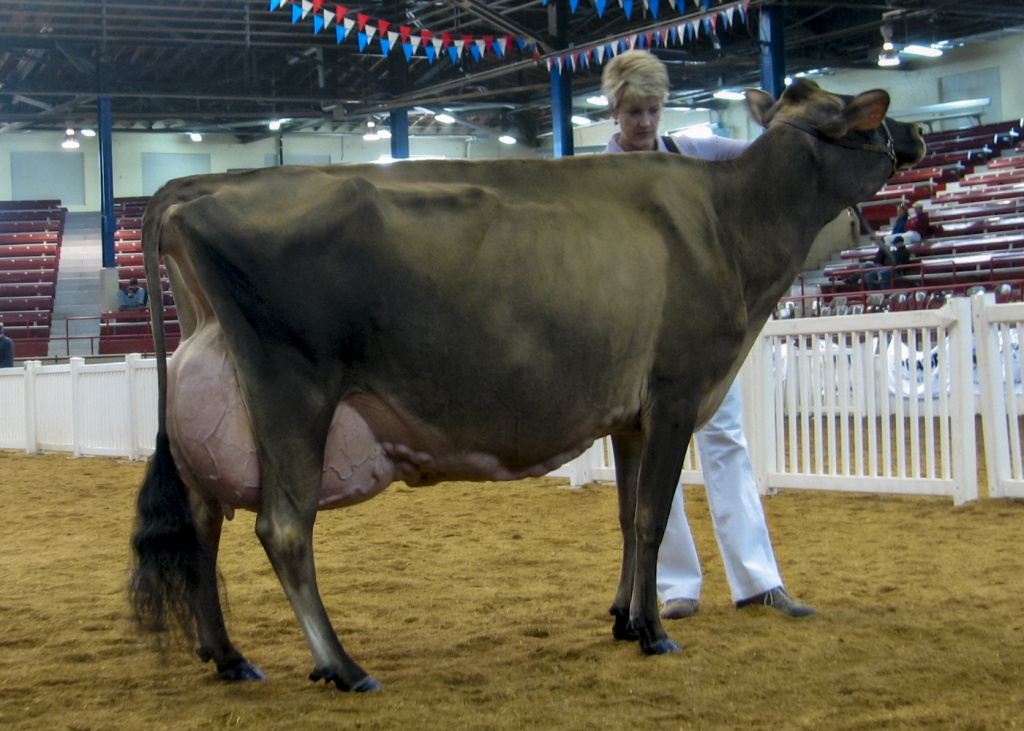
Huronia Centurion Veronica at 10 years old. Photo take by Karen Knutsen at NY Spring Show
Teamwork “Running Rings Around the Best”
Ernie and Terri express their feeling for their cattle in the sign which has hung in more than one of their barns, “Every cow in this barn is a lady, please treat her as such.” Perhaps this respect sums up the “Ladies’ First” achievements that their girls have delighted them with. “It was a great thrill to have Supreme Champion & Reserve Supreme Champion at 2004 WDE from the same string – two cows that we purchased for the owners, then developed and managed.” As well there have been four Grand Champions at The Royal in three different breeds. There is justifiable pride in other career highlights which include purchasing a Holstein 2-yr old who stood 14 at Expo and then developing her into the All-Time, All-American 4 year old. They earned the WDE Premier Breeder banner in two breeds during the time they managed Arethusa Farm and in 2009 had the All-American Produce of Dam for both Holsteins and Jerseys. Oh yes and both of the dams were past Supreme Champions at World Dairy Expo. Impossible feats are simply expected successes for Ernie and Terri.
“I’m Seeing Barbara From A New Perspective”
First impressions sometimes disappoint later but, in all respects, Butz-Butler Gold Barbara was everything she appeared to be when Ernie saw her in Madison in 2012. “Barbara is one of the few cows, in any breed, that offers a complete package. She is an outstanding show cow with a great pedigree, and that combination gives her worldwide marketing appeal – which makes the financial investment worthwhile. All of this makes her special.” With such obviously strong inclinations toward owning this cow, it isn’t surprising that great partners could be convinced to share his enthusiasm. “When I heard that she was for sale in August, I made a trip to Illinois. She looked outstanding but was recently fresh. I thought waiting a few weeks would help me to make the proper decision. The package price for Barbara and 10 offspring made it difficult to purchase her alone. Tim Abbott joined me on the return trip to Butlerview. After they paraded her at milking time, it was an easy decision….we agreed that it was time to own another Barbara.” Then another opportunity presented itself. “Hearing about my trip, our friend and veterinarian, Dr. Matt Iager, mentioned that he would like to invest in a great young cow if we would take care of her. Shortly thereafter, the representative from River Valley contacted us expressing their interest in investing in a Holstein. Tim and I agreed that the four potential partners all had something to offer – each brought a unique talent/skill to the partnership.” (Read more SOLD – All-Canadian & Unanimous All-American Senior 2 Year Old to Kueffner, St. Jacobs, and Dr. Matt Iager UPDATE: River Valley now a partner) Beyond Ernie’s first instincts and the impact she’s making through her offspring, Barbara continues to surprise. “Now we have worked around the cow for six weeks. And we’ve learned that Barbara is special in other ways – her attitude, appetite, great willingness to milk, and the way she responds to attention make you look forward to going to the barn.”
“Your Reputation is Your Marketing Brand. Share it on Social Media”
Ernie and Terri know that good business starts with the trust people have for the work you do and the cattle you promote. Ernie points out how important that can be. “In this business, you must build a reputation for marketing your best. We always sell cattle with deep pedigrees that the buyer can build on. And we always want to see buyers do well.” For eleven years they have used their website as a marketing tool, but recently launched a Facebook page. Terri is enthusiastic. “I am amazed at the interest this generates. It helps us grow the “brand” and allows people to feel a connection to our business, no matter where they are located around the world. Now we use Facebook to get news out quickly – whether information about a consignment, show winnings or new photos – and this leads people back to our website. I feel that combining the immediacy of social media and the substance of a good website works together to successfully promote our herd.”
“Mother Knows Best”
Terri Packard looks back to her parents, Richard and Marilyn, for life lessons that led to cows she worked with becoming well-known successes. “My mother taught me about preparing an animal for a show and she was tough! She had a winning calf at the National Show in Chicago as a teenager. She paid attention to every detail – something she learned from her father. I have clear memories of pulling all the dead (brown) winter hair off the heifers in the days before body-clipping; washing animals with bluing and putting them in the sun to whiten; having to rewash animals because she found dander; using a piece of glass to smooth the hooves; and more. But my mother felt that everyone was on an equal playing field when it came to fitting and showing. It didn’t matter how good your calf was. If you used soap and “elbow grease” and put in the time, you would be competitive.”
“Change is Good. Natural is Better”
Along with collecting numerous awards, Ernie Kueffner has witnessed changes in the show ring. “The biggest change for me has been the appearance of the cattle. Cows have much more dairy character, angularity and style. Ashlyn was a great cow, but when we look at her pictures from 2001 and compare them to cows competing today….the changes are obvious. Many cows today have a flatter, cleaner bone. They may not have as much strength and depth as in the past, but there is more style and more milk. More emphasis has been placed on breeding/buying cows with outstanding mammaries now that the major shows have been cleaned-up. And cows are going to the ring with their udders full of milk. This has been a positive change. Being somewhat familiar with what goes on at WDE, I find it a great compliment to the cattle people that they have weaned themselves from the udder tampering that went on in past decades. Almost 100% of the cattle are natural now.”
“With a Heart for Cows and a Head for Business”
For Ernie the family farm was the ultimate training ground for the business man he would become. He outlines the process. “After high school, I went to auctioneer school in Billings, Montana. Eventually, I joined my father (Ernie Sr.) as a partner in the cattle and auction businesses. In my mid-20’s I purchased my father’s share of the sale barn. I really enjoyed this business because I could travel to several states, and Ontario, purchase cattle and resell them to my customers in Wisconsin. I was very particular about what I purchased and sold, so I established an excellent customer base that appreciated what I offered. As time went by, I expanded into different businesses including a real estate company (owned with my brother) while continuing to help my father with his auction business.” With a growing resume under his belt, Ernie was ready to focus on what was closest to his heart. “At the age of 34, I sold the sale barn and moved to North Carolina to work for Arlen Buttke. We were partners on some cattle and I also helped manage his operation.”
“Talk, Look and Listen”
Both Terri and Ernie had their love of dairy cattle inspired by their parents. Terri recalls her parents’ influence. “My father enjoyed the breeding side of the business and loved to “talk cows” (or bulls) with anyone else that shared his passion.” It was similar for Ernie. “When the sale barn opened I was 10 years old. After school and on weekends, I would travel with my father to different farms to look at cattle to purchase or sell on consignment. As soon as I got my drivers’ license at 16, my father put me on the road to buy cattle. I was given a lot of responsibility and the opportunity to take it as far as I wanted.” Kueffner was introduced early to exceptional cattle buyers and sellers. “My first experiences were with four Jewish cattle dealers in Wisconsin and Illinois. They were very wise and I enjoyed listening to them. One of the dealers had many sayings that I still quote to this day. My favorite example is – ‘the good deals never quit winning and the bad deals never quit losing.’ For me, this applies to cattle, business and dealing with people on an everyday basis.”
“The ‘Glamour Purse’ Sets a Shining Example
Having been an eager student of cattle dealing, Ernie was always destined to become involved in that side of the dairy business. He fondly recalls one sale that still ranks high as a personal-best achievement. “Global Glamour (2008) was a huge undertaking and a resounding success with an average over $96,000 on 40 lots and the money was real. We co-managed the sale with Isaac Lancaster and Dan Donor of ADI and wanted it to have an international appeal.” He offers these insights into what it took then and now to build the success of the sale. “A lot of effort went into providing an “experience” for those that attended – from organizing a pre-sale trip to New York City, to the cattle presentation and the atmosphere before, during and after the sale. GG set a standard for high-focus sales in our industry and you see a lot of those ideas used today. “
The Bullvine Bottom Line
Success in the Show Ring. Success in the Sales Ring. Achieving either one is admirable. Achieving outstanding success in both areas is a mark of exceptional focus and commitment. Teamwork over the past 16 years has earned a lineup of awards second to none …and still growing! It only seems impossible until we watch Ernie Kueffner and Terri Packard doing it! Congratulations!
Get original “Bullvine” content sent straight to your email inbox for free.






















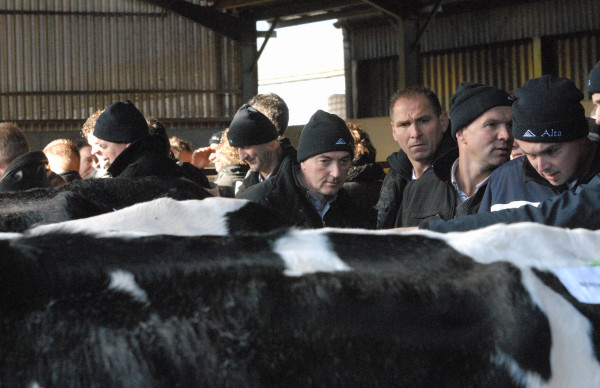
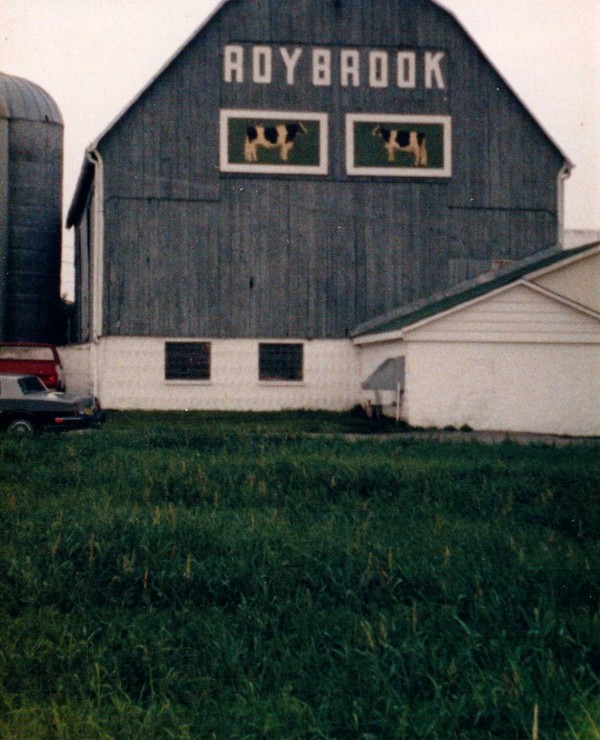
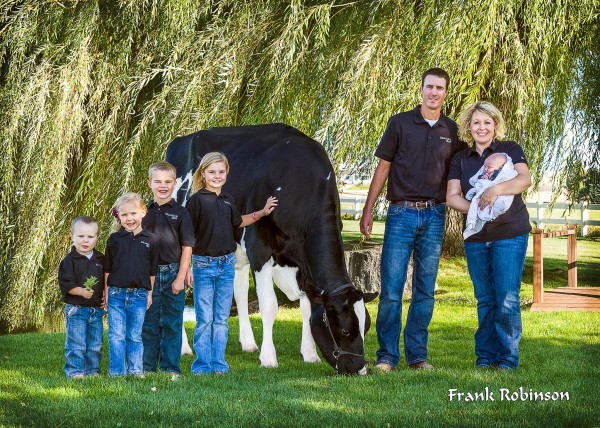
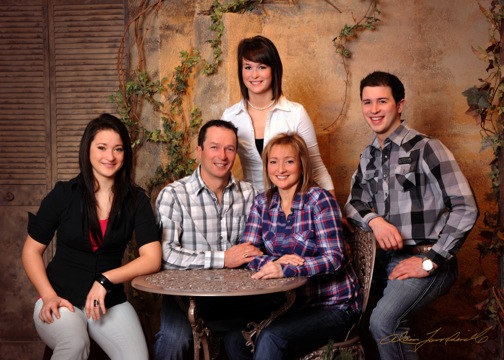
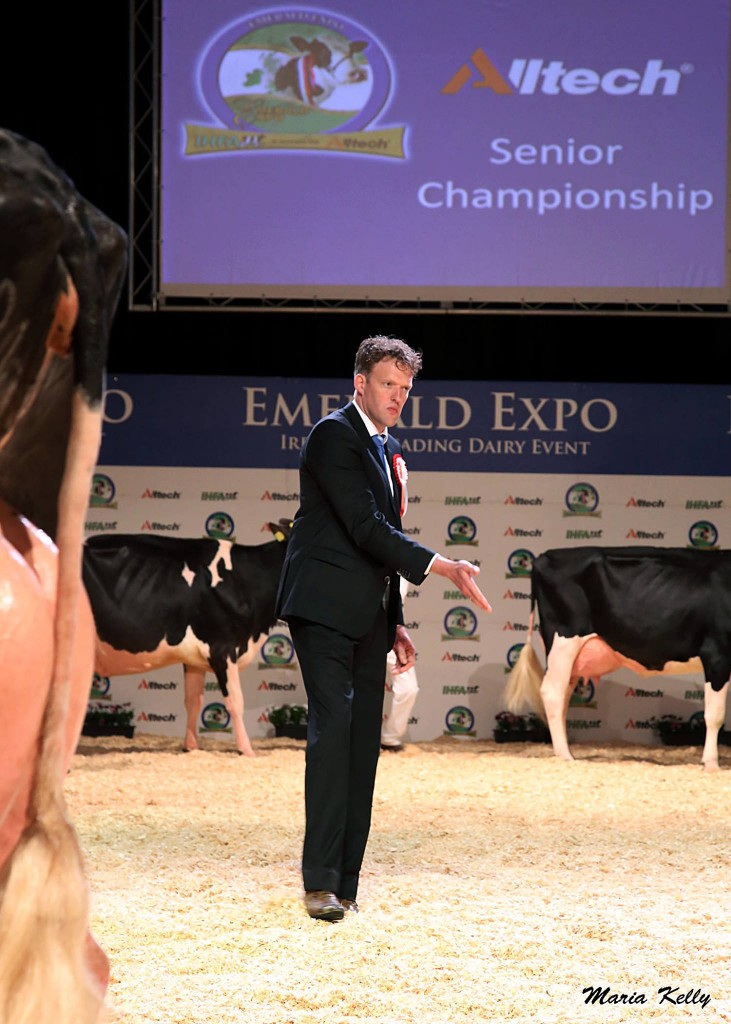 Here comes the Judge
Here comes the Judge




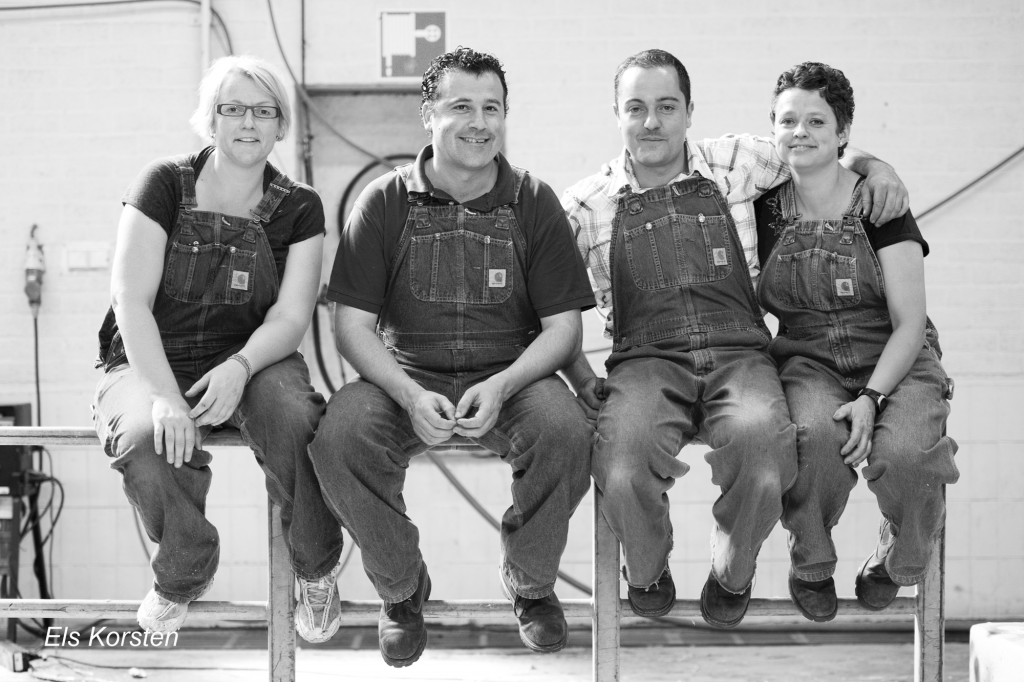
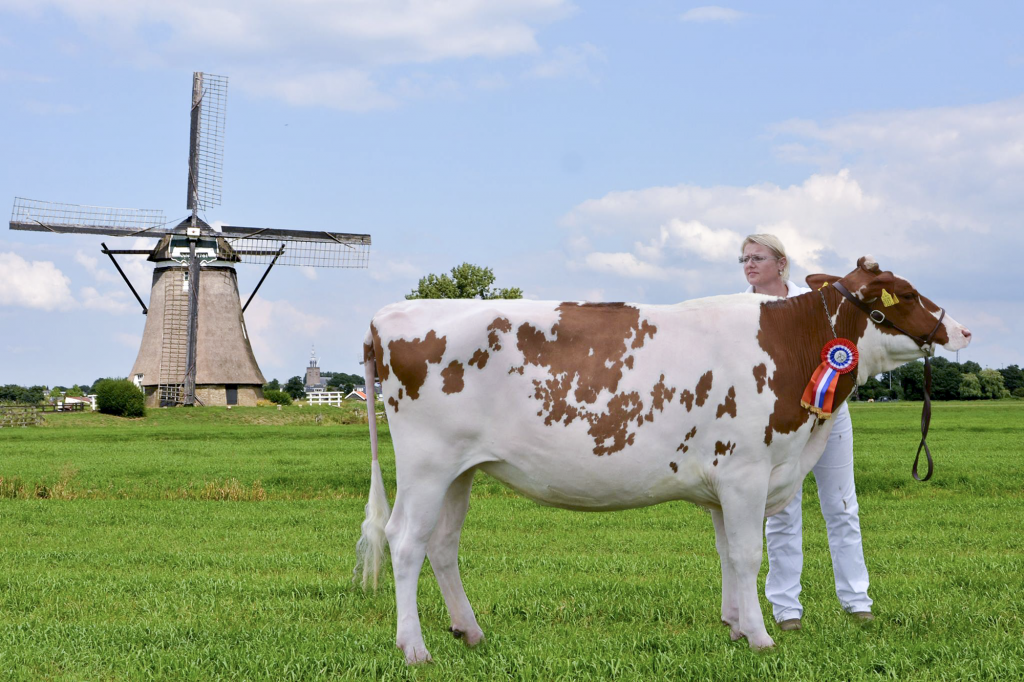
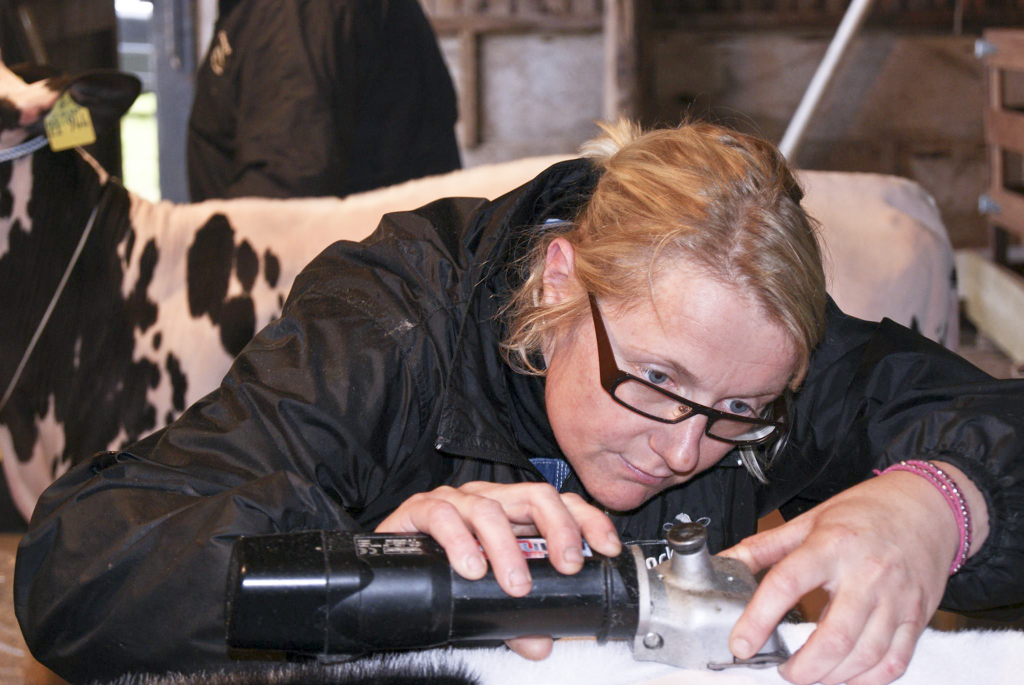

![1398731_439003446210533_116605505_o[1]](https://www.thebullvine.com/wp-content/uploads/2014/01/1398731_439003446210533_116605505_o1-1024x577.jpg)

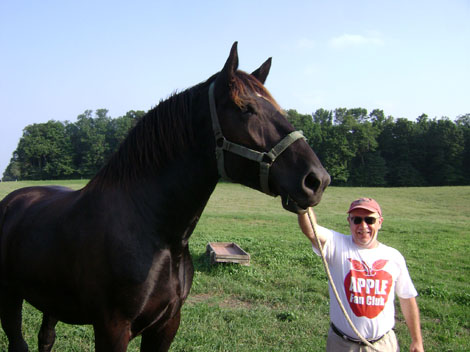

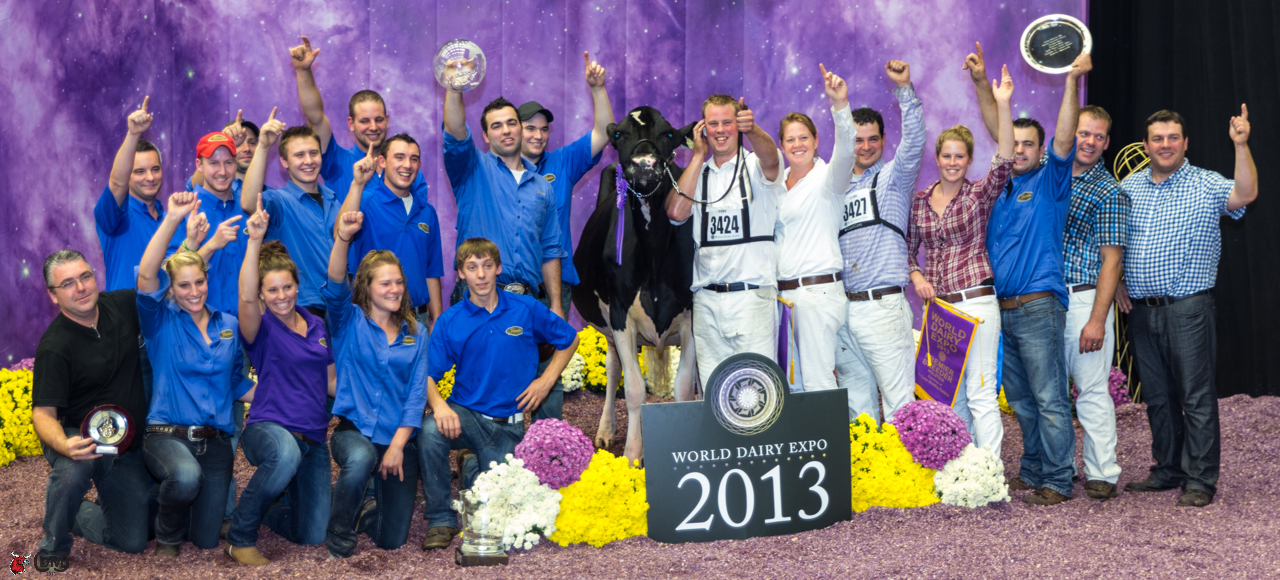

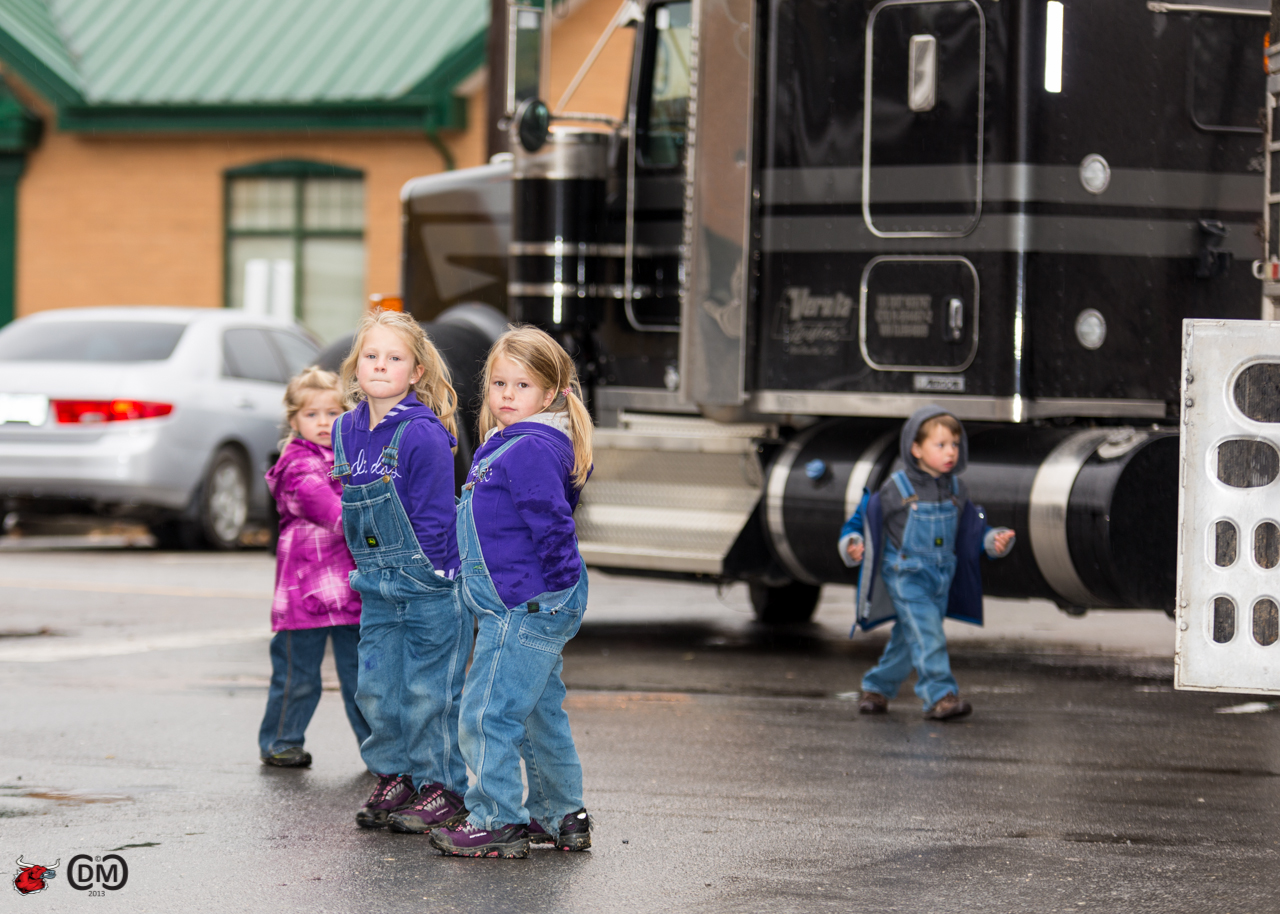
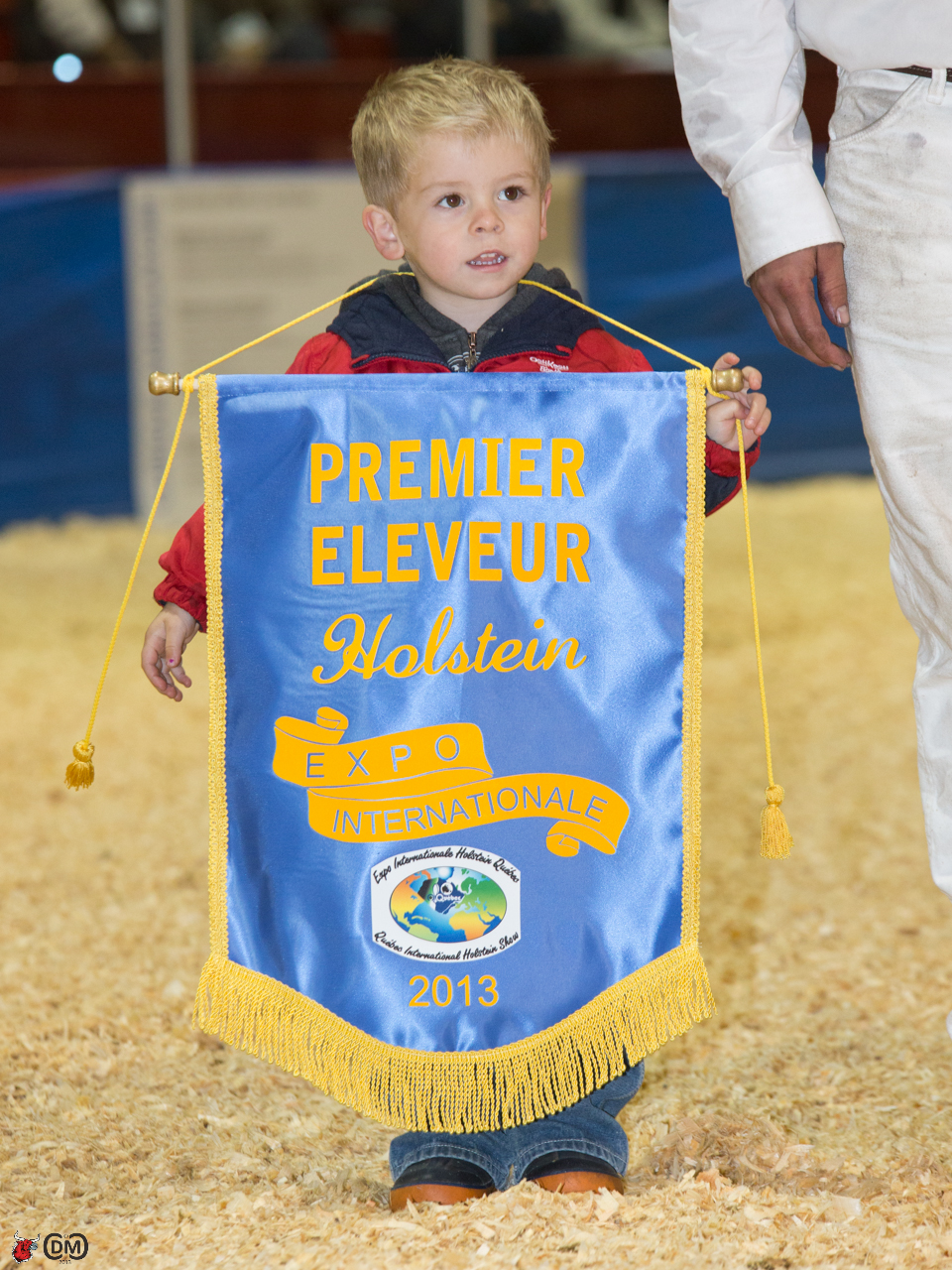
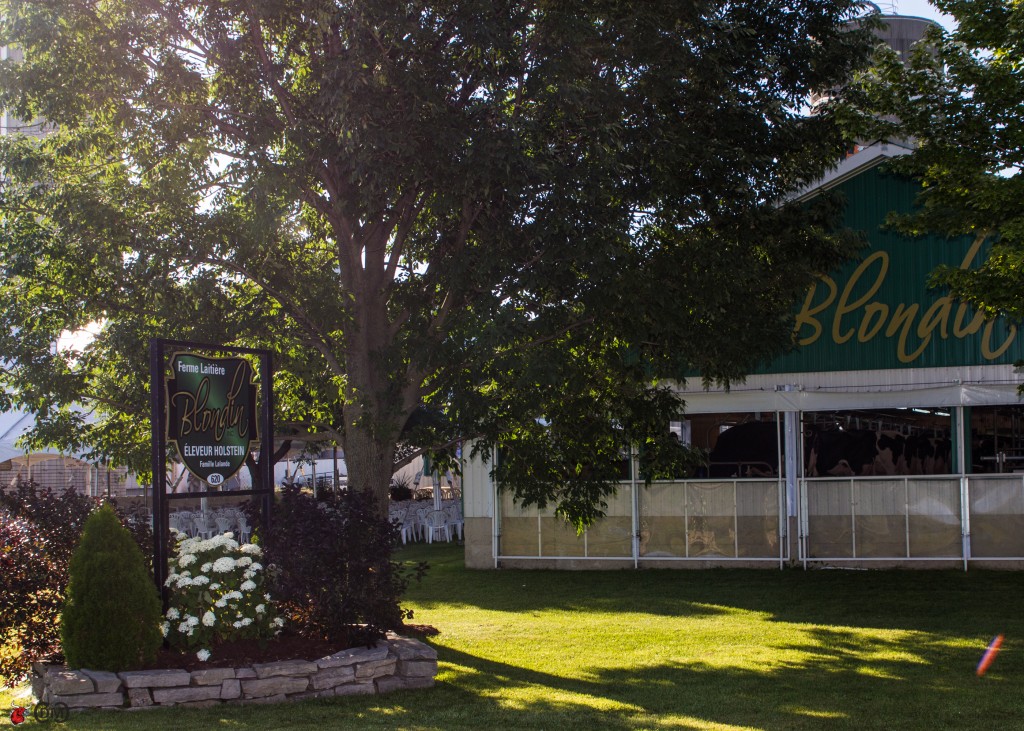
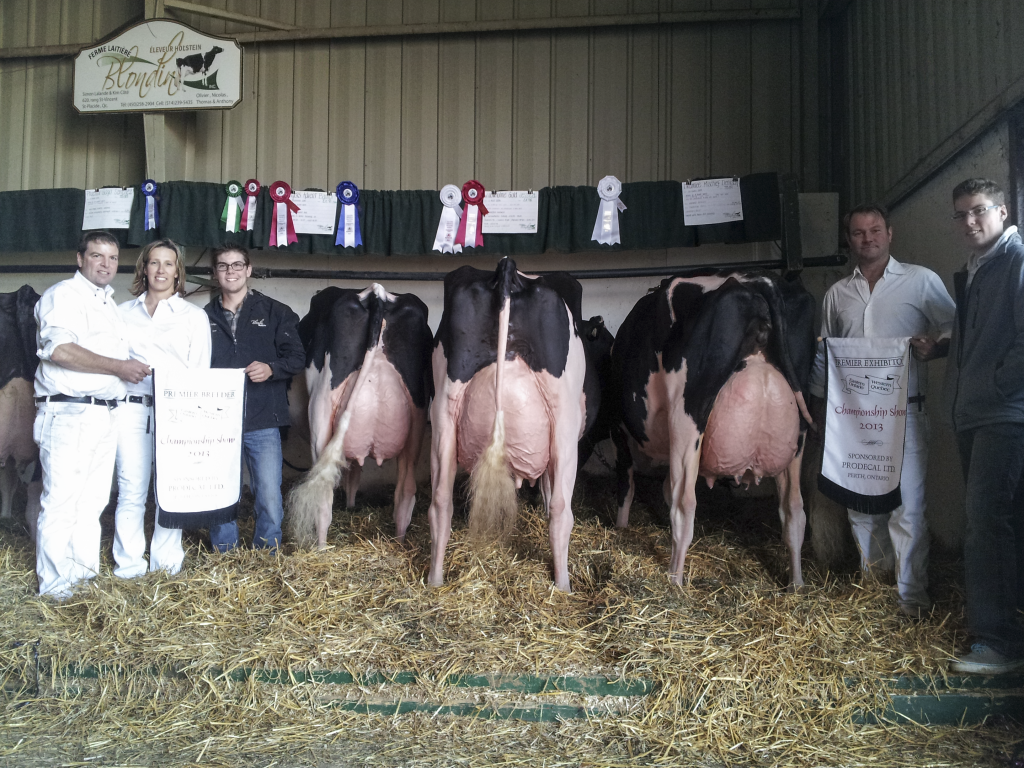
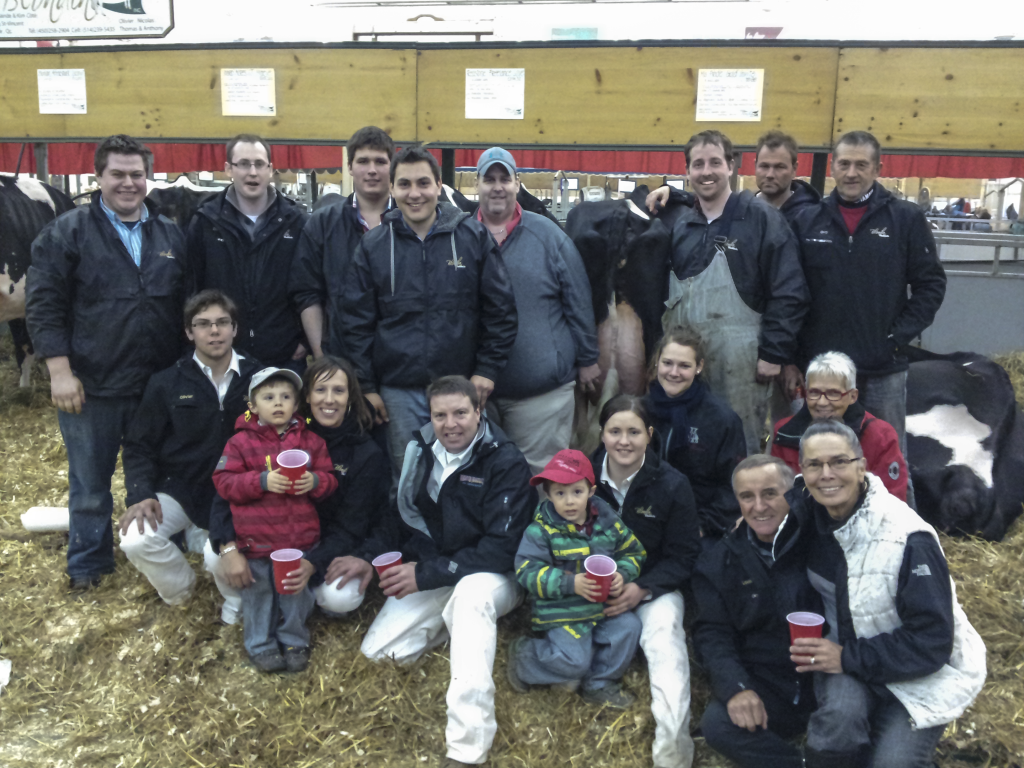
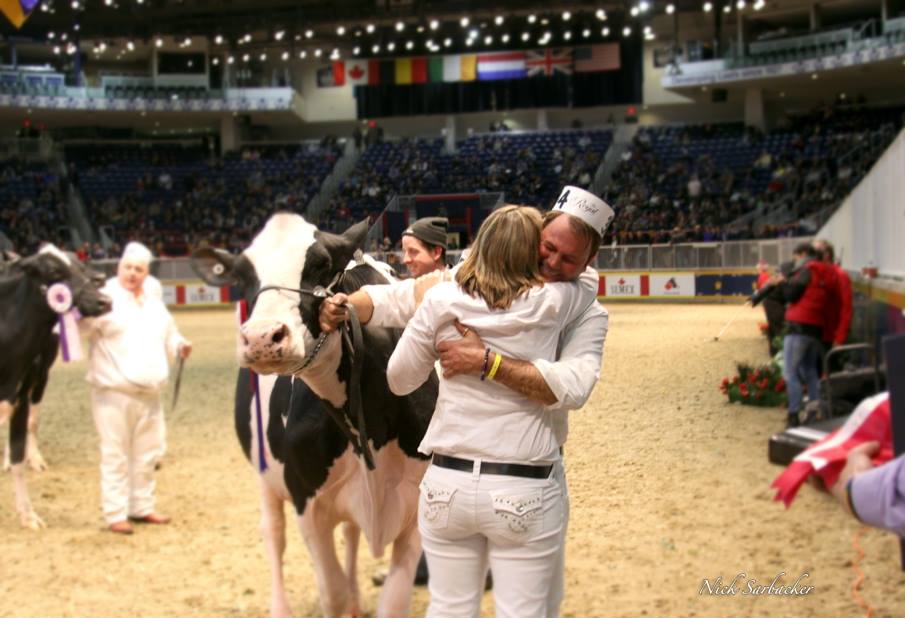
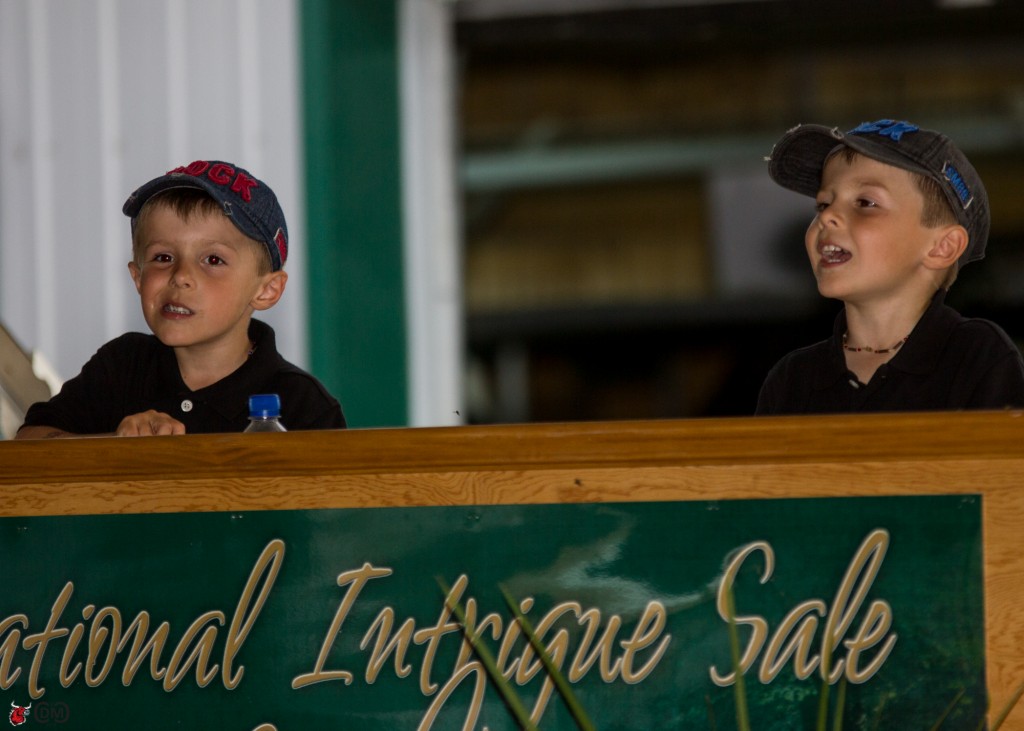
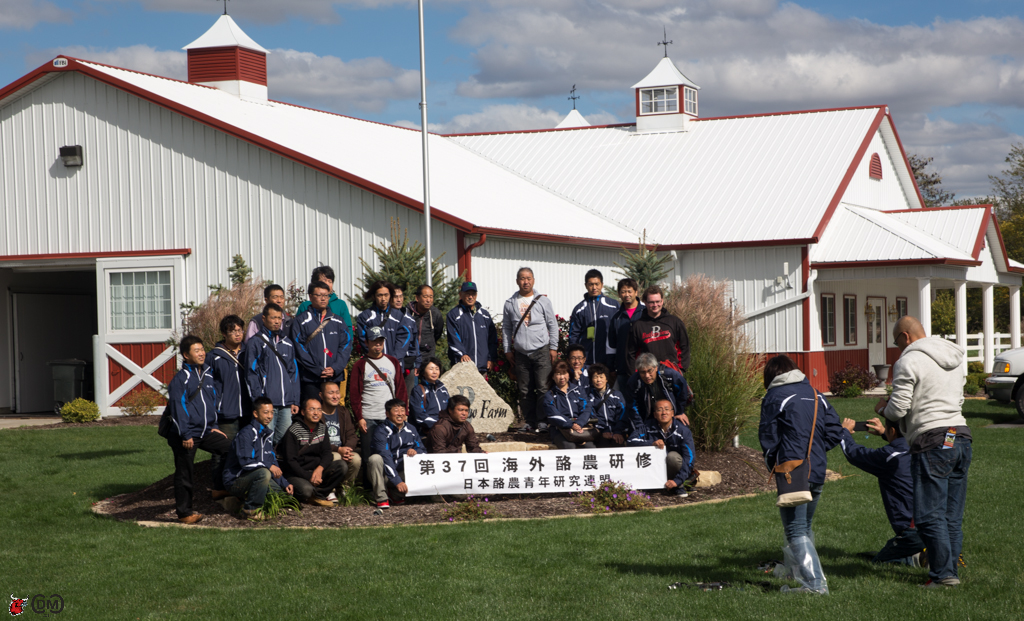
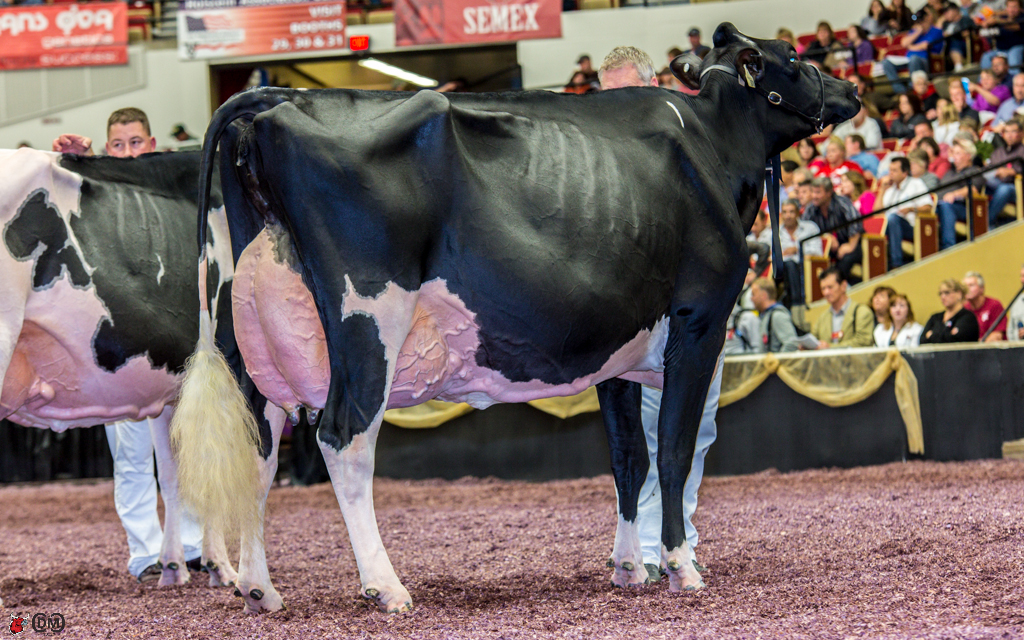
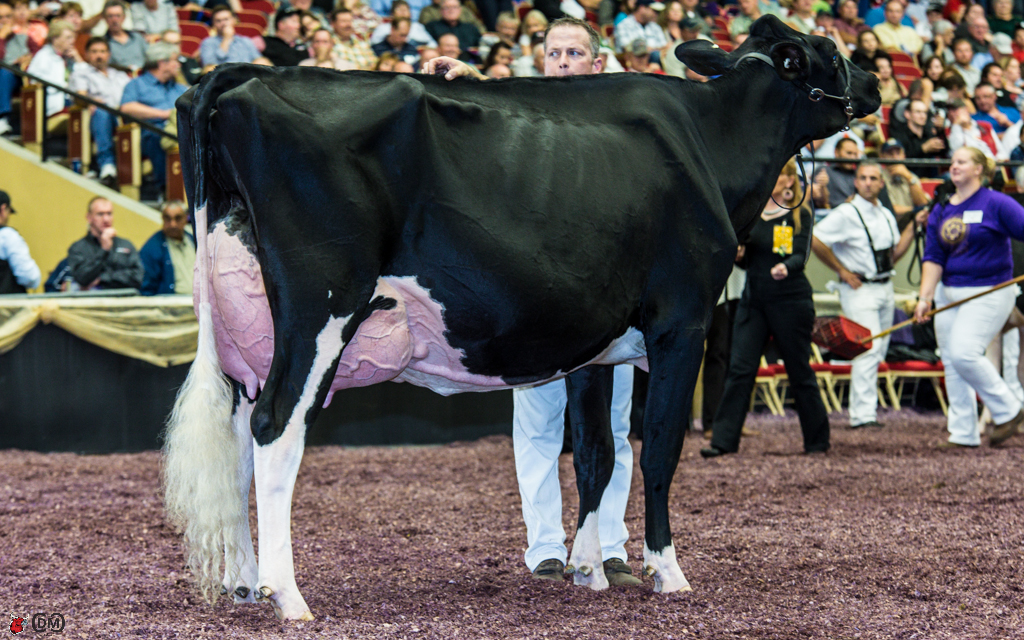

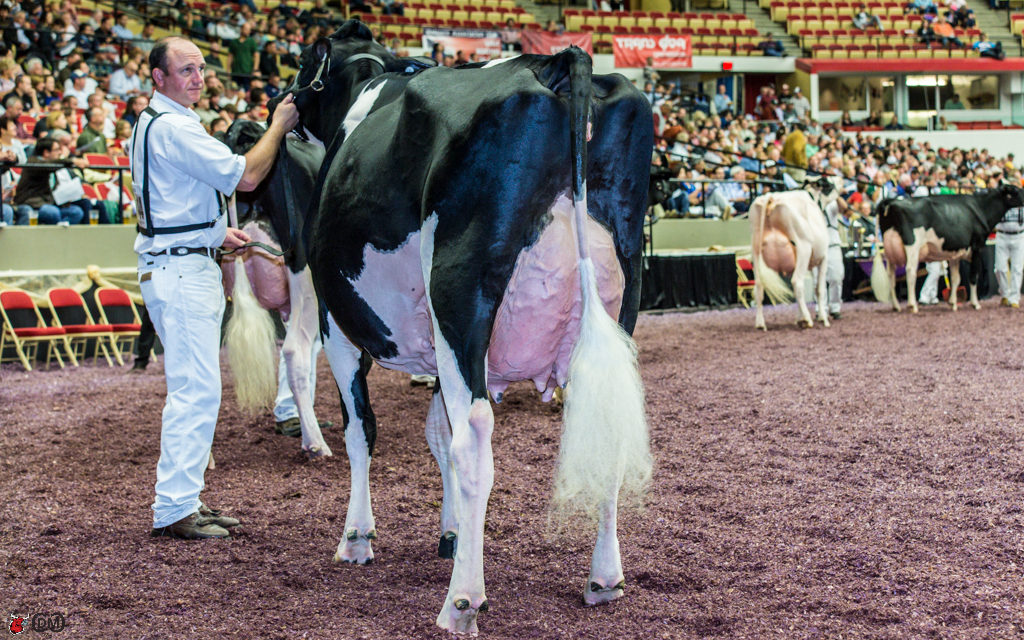
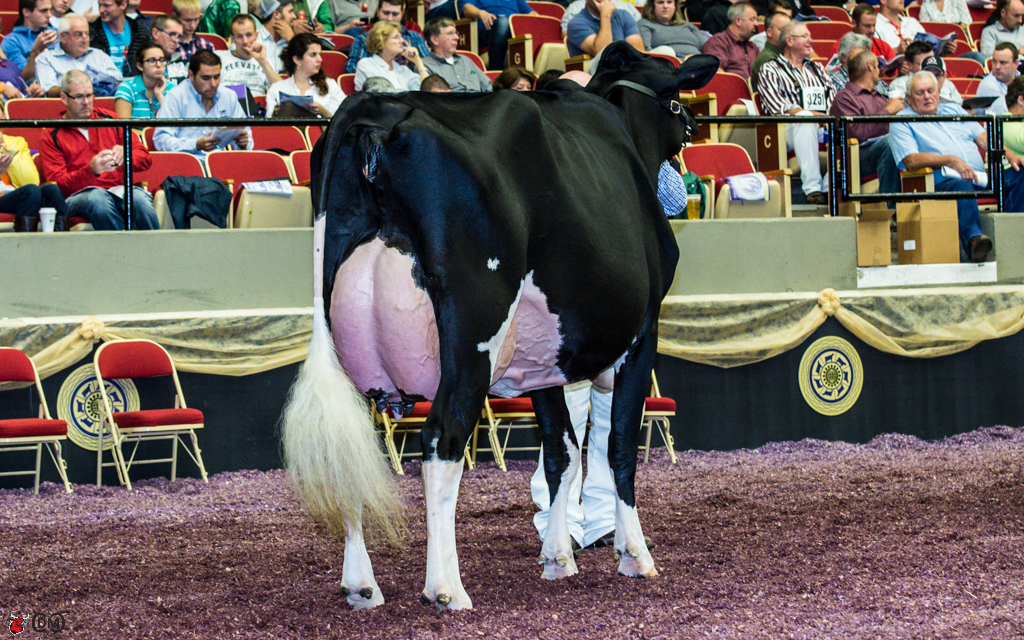
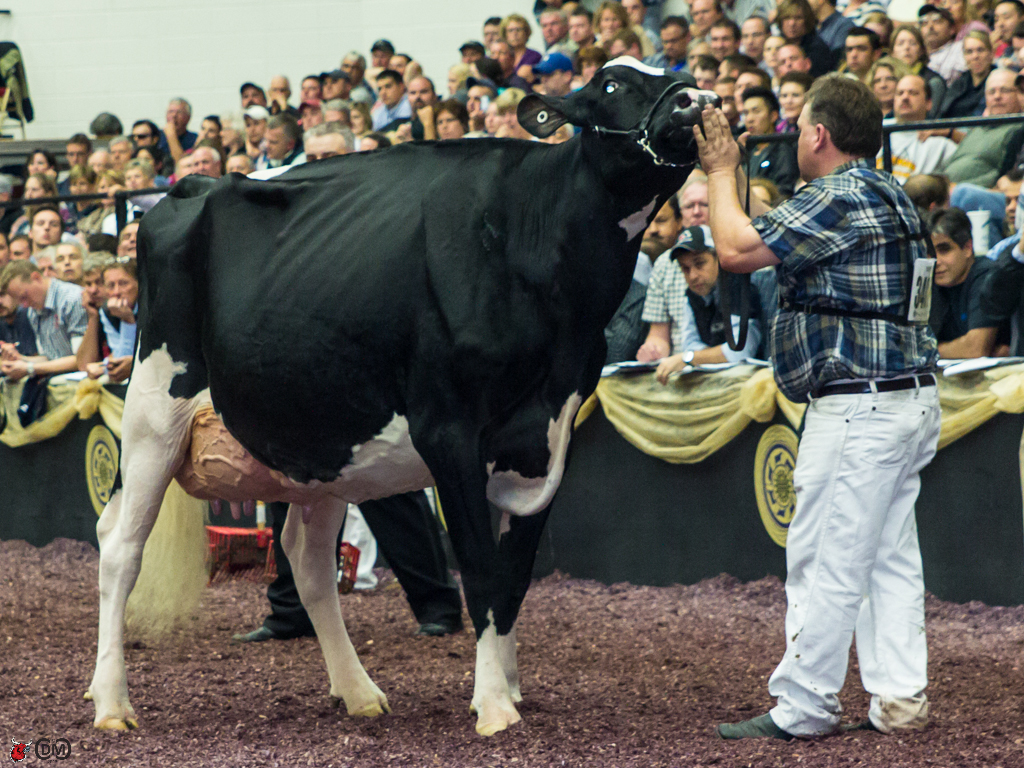


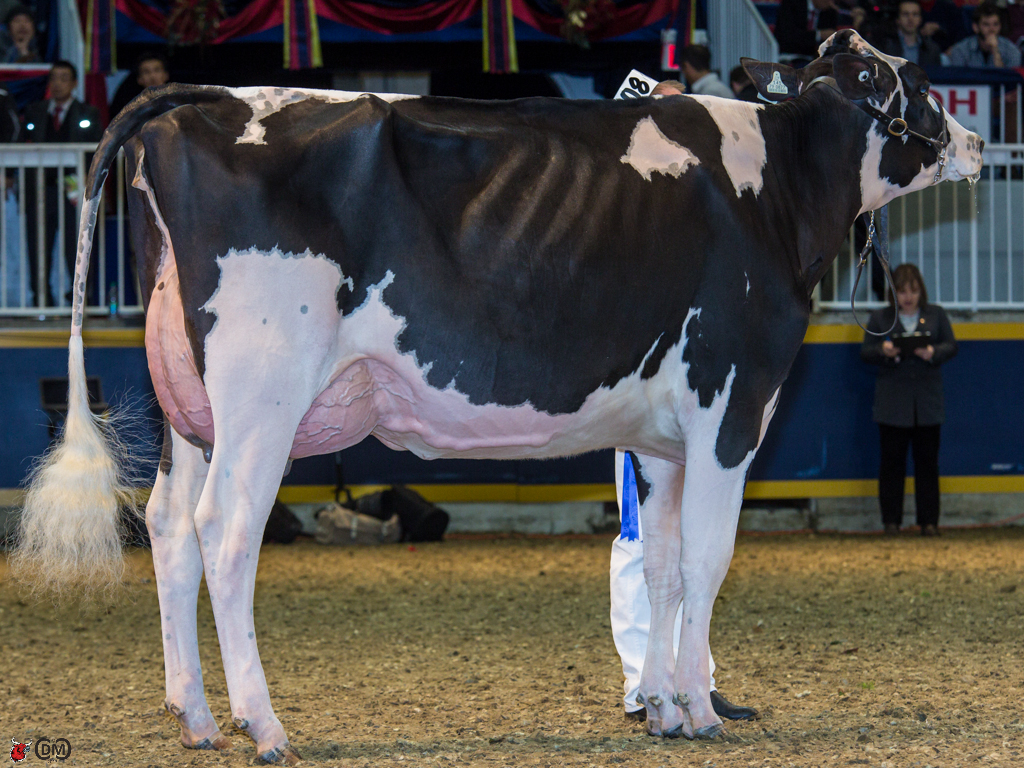
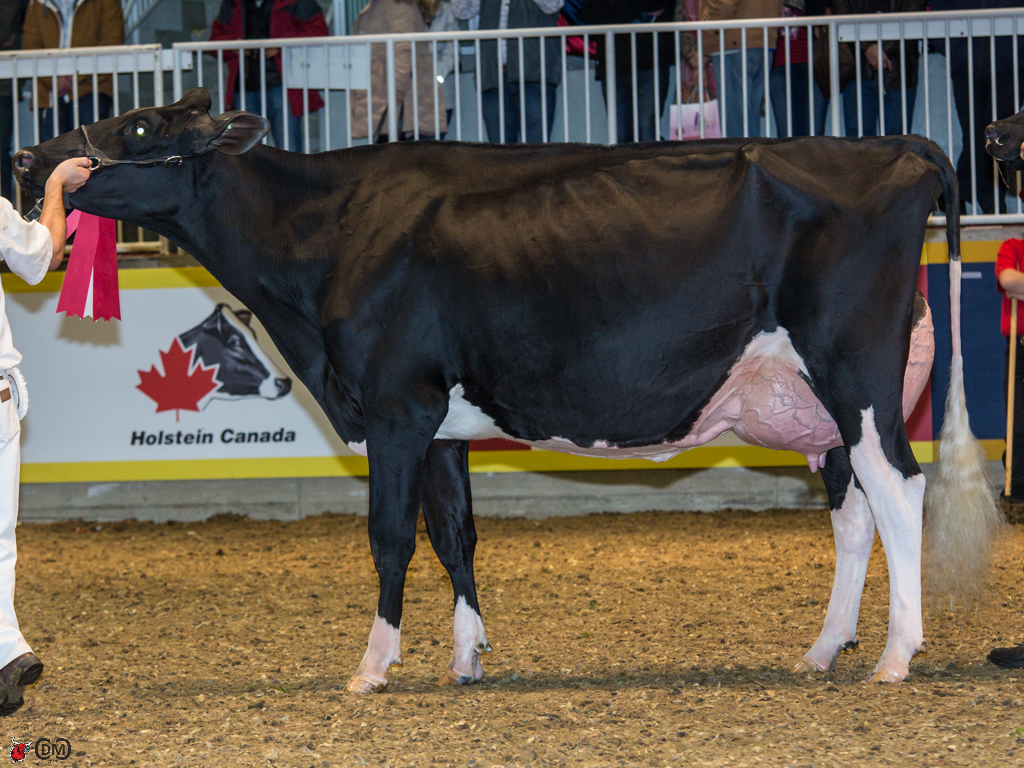
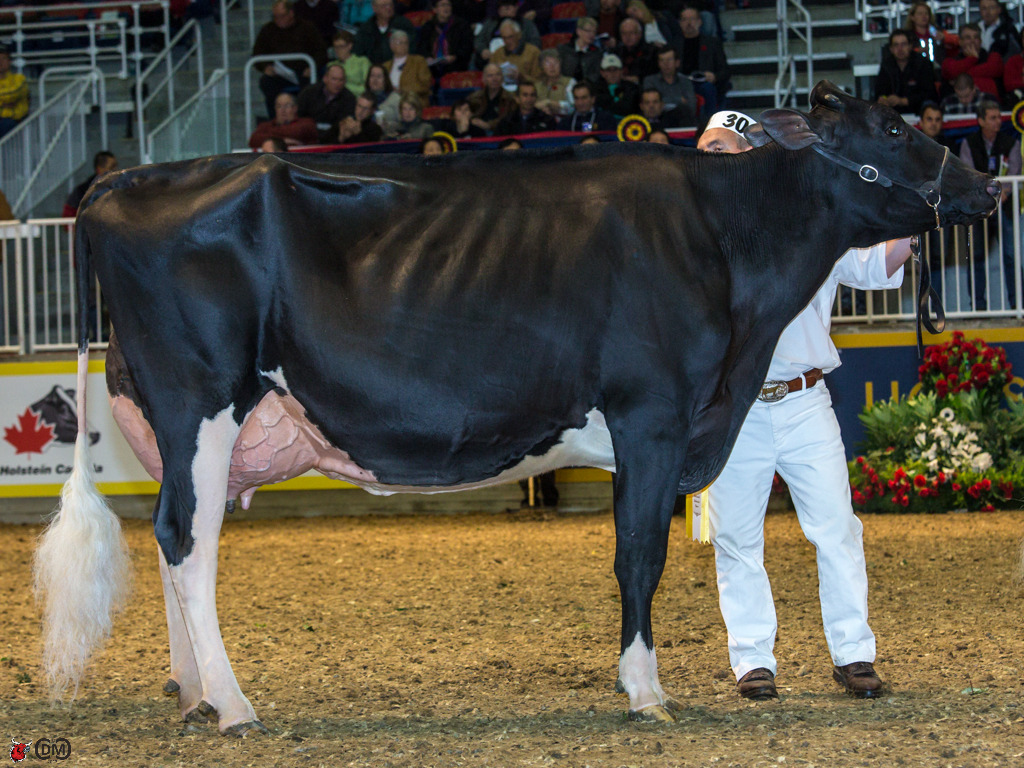
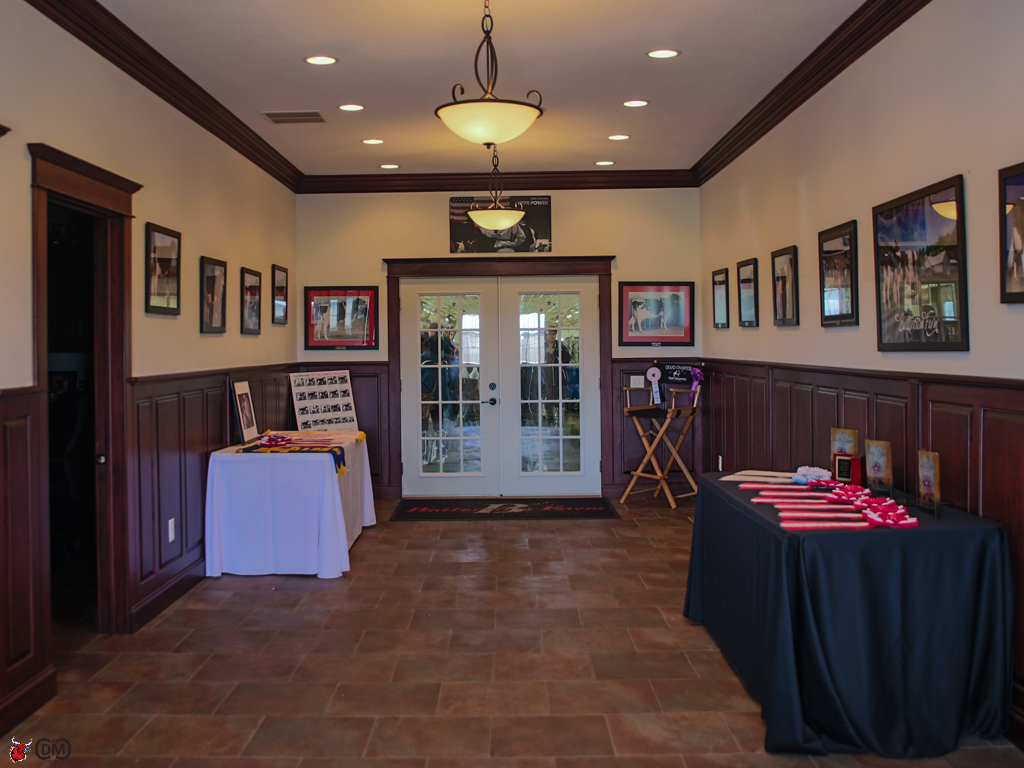
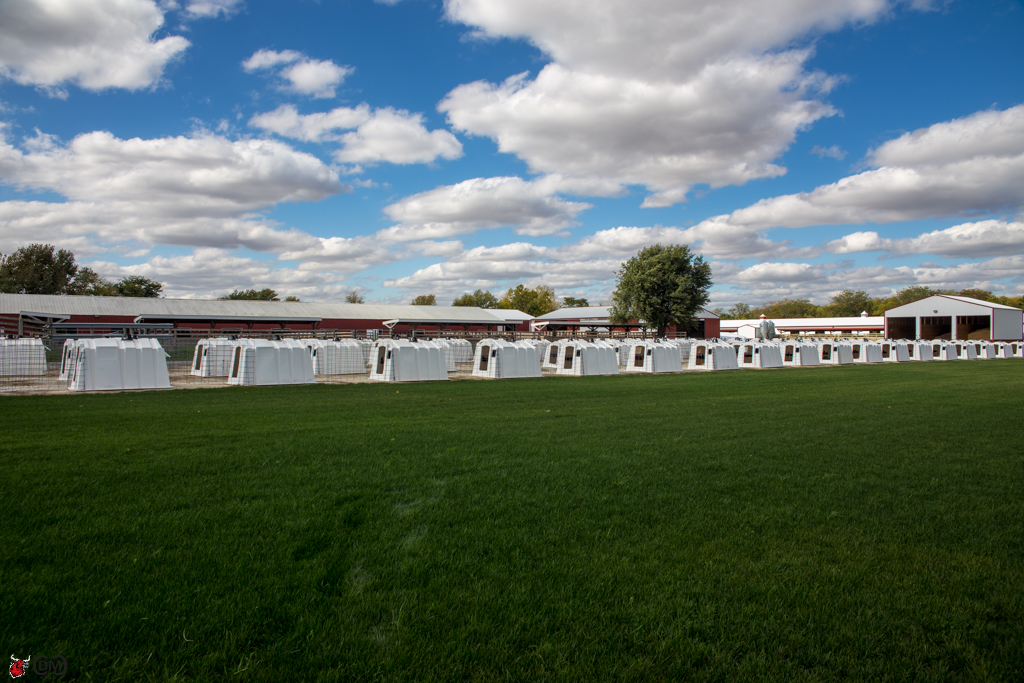
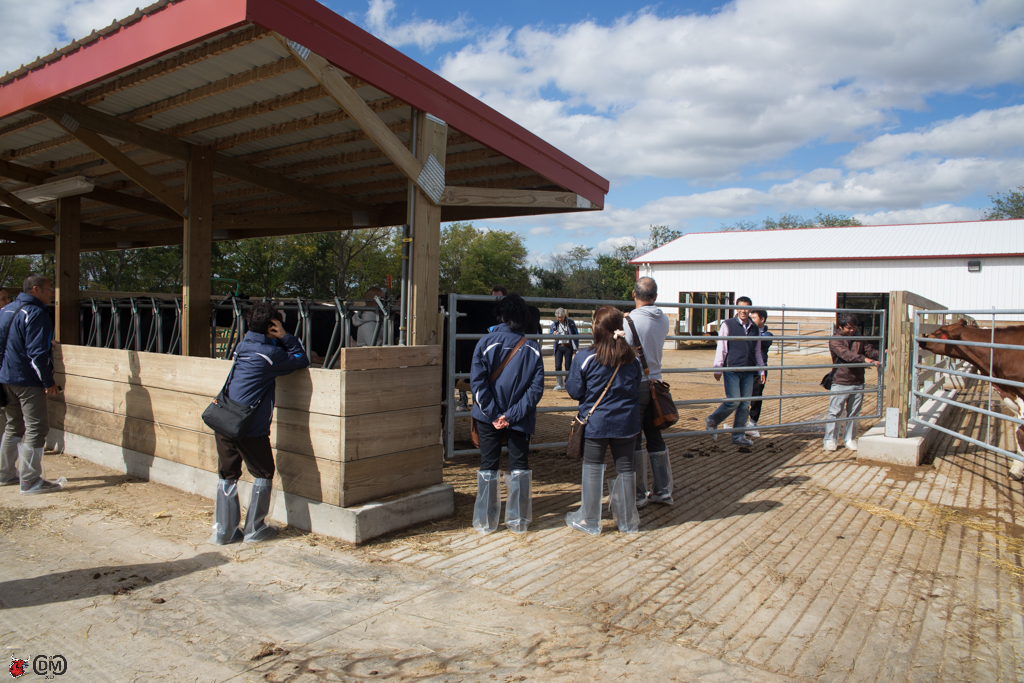
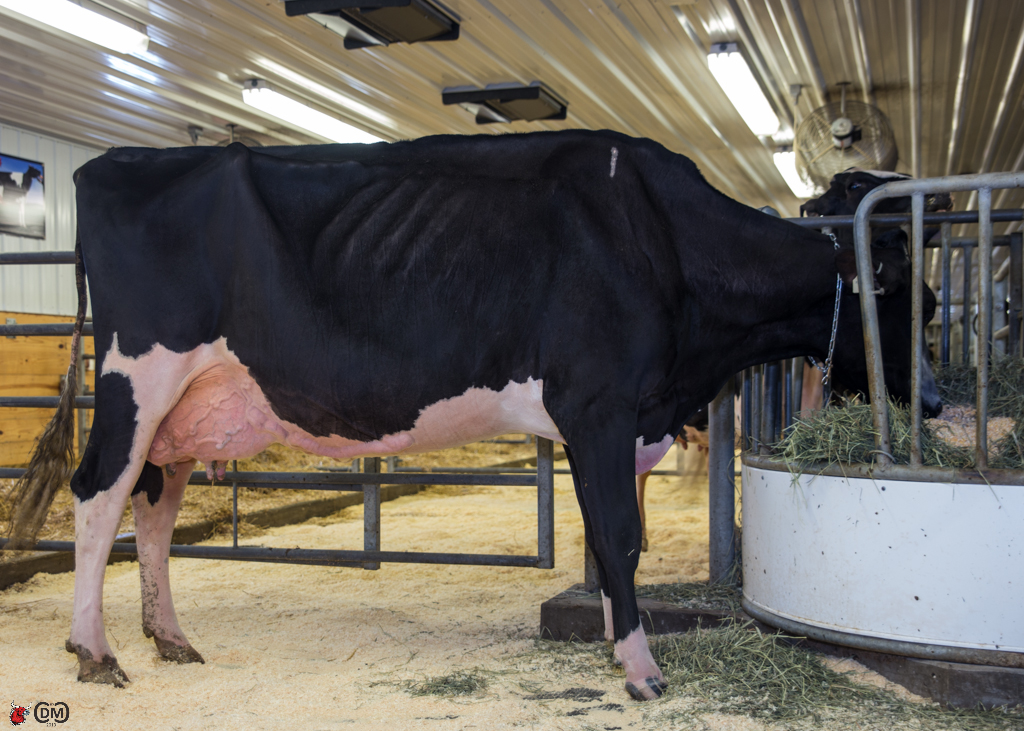

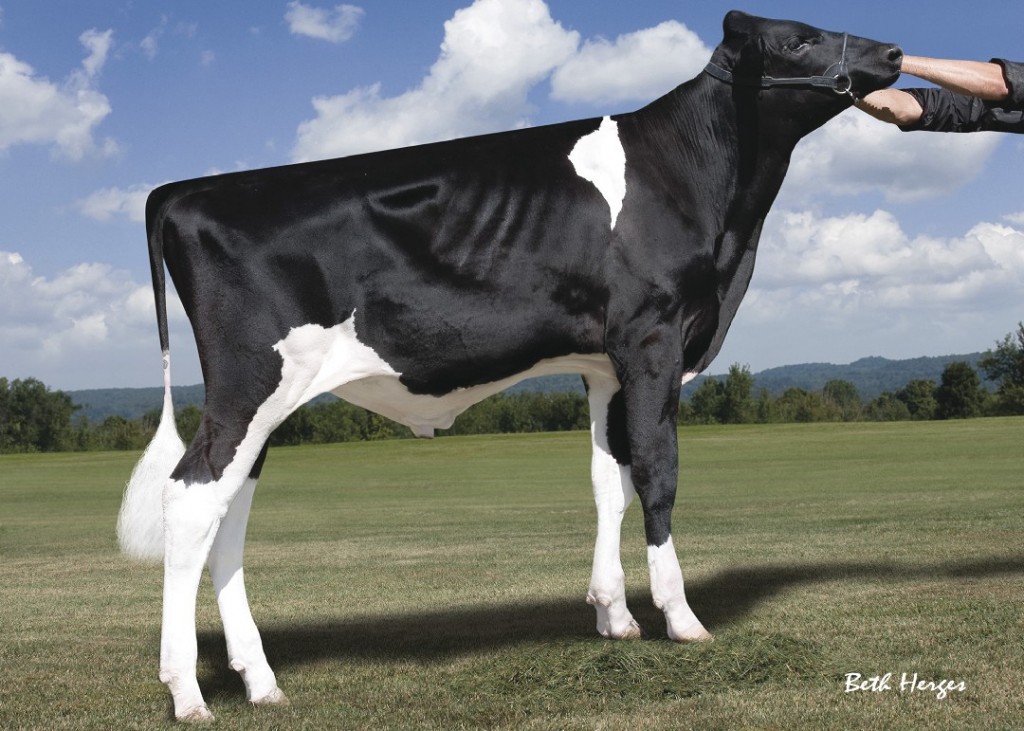

![1377185_170896726447469_1347065838_n[1]](https://www.thebullvine.com/wp-content/uploads/2013/10/1377185_170896726447469_1347065838_n1.jpg)
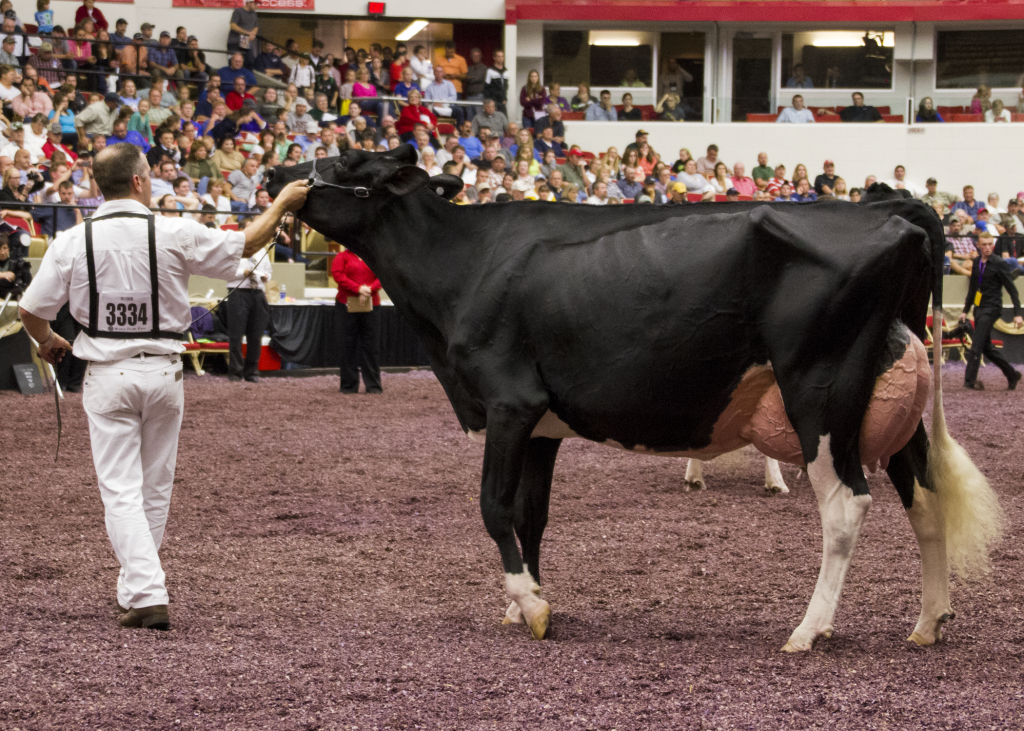

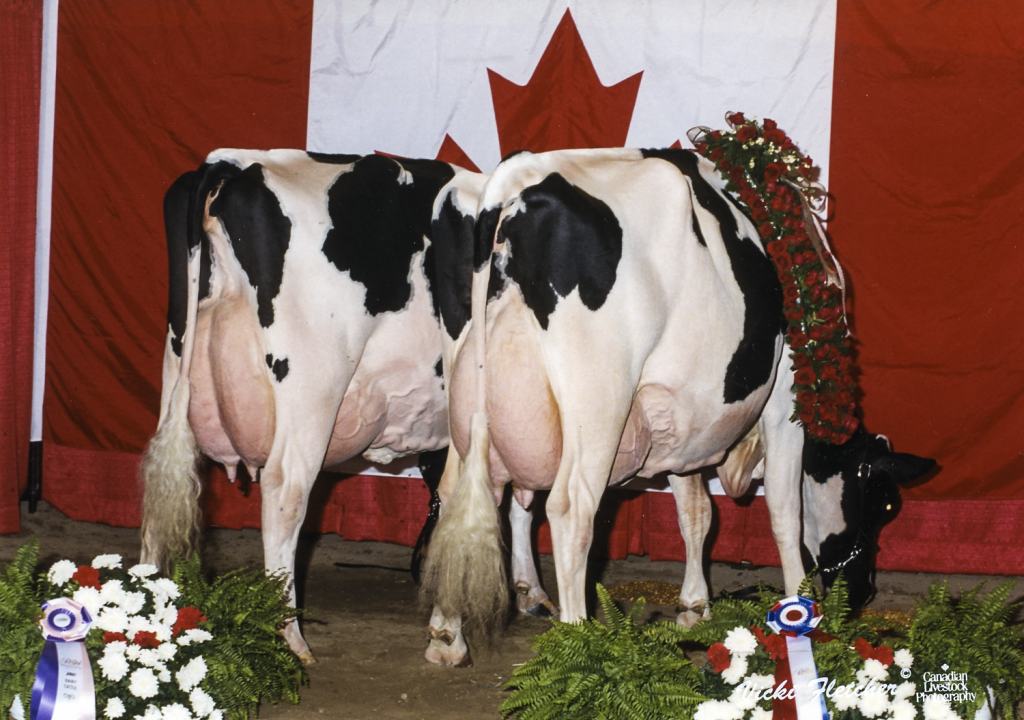
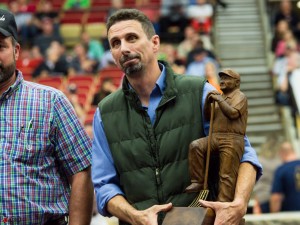 No one is ever truly prepared for massive peer recognition such as that experienced by Richard Caverly when his name was announced at the 2013 recipient of the Klussendorf-Mackenzie Award at The 47th World Dairy Expo. (Read more:
No one is ever truly prepared for massive peer recognition such as that experienced by Richard Caverly when his name was announced at the 2013 recipient of the Klussendorf-Mackenzie Award at The 47th World Dairy Expo. (Read more: 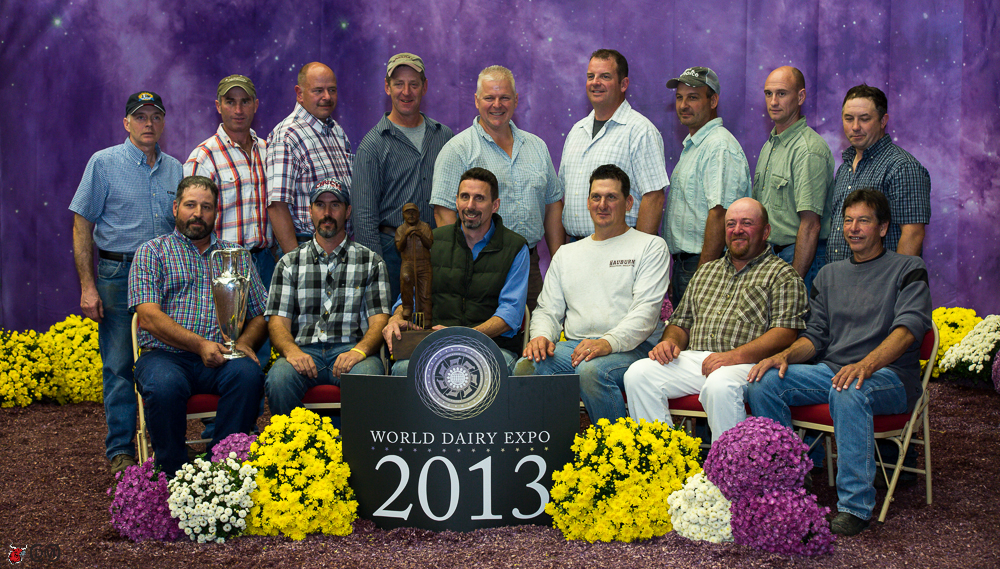
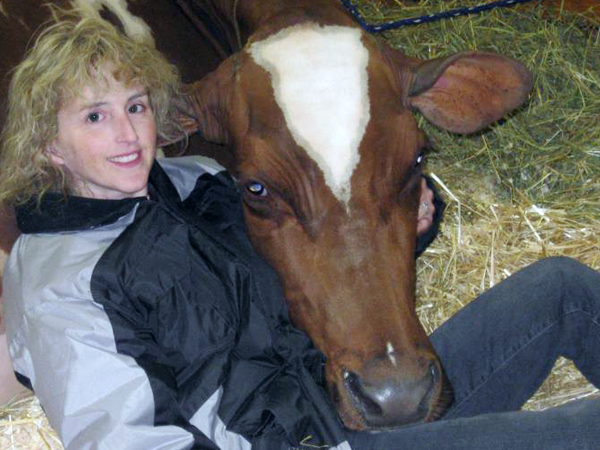 “Of everyone in my life, my wife Beverly Donovan is my biggest hero.”
“Of everyone in my life, my wife Beverly Donovan is my biggest hero.” 